Allison Collection Photos
June, 1944
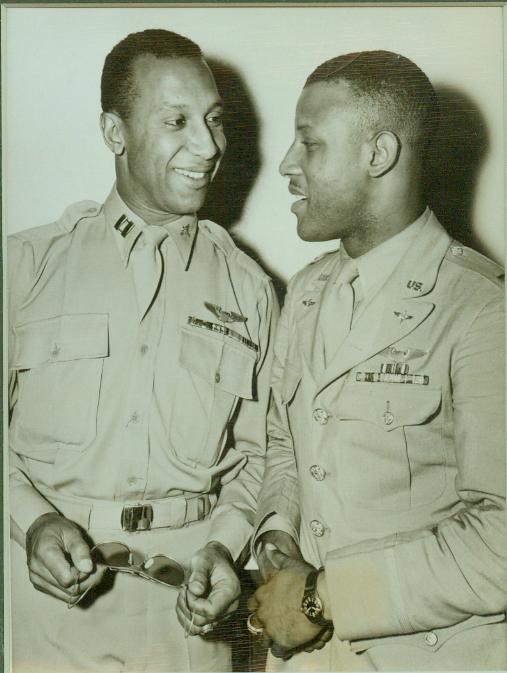
Air Heroes Hold Press Interview, 6/24/1944. NEW YORK - Home on leave after flying with the 99th Fighter Squadron, famed all-negro flying group, Capts Charles R. Hall (right) of Brazil, Ind., and Lemuel R. Custis, Hartford, Conn., are devoting their furloughs to the sale of war bonds. Both pilots have flown in the Mediterranean Theater, and Capt. Hall has been awarded the Distinguished Flying Cross. Through the two flyers, the National Association for the Advancement of Colored People has purchased $40,000 in war bonds during the fifth war loan drive.;

Normandy Casualties Arrive, 6/29/1944. New York – Thirteen soldiers and one Navy Seabee, all casualties of the Battle of Normandy, arrived in New York by hospital plane from England, Mitchel Field officials revealed today. The hero liberators were taken to the base hospital for a check-up before their removal to other hospitals. Pvt. George W. James, 21, of Clarksburg, W. Va., one of the returned soldiers, as a paratrooper landed behind enemy lines the night before D-Day. He shows part of the ‘chute that brought him to France to Cpl. Anna Marie Santon, Philadelphia, Pa. James was wounded by mortar fire. Credit: (ACME);

Where Fifth Army Marched Through Italy, 6/2/1944. Italy – Taken by Charles Seawood, ACME News Pictures War Pool Correspondent, these pictures show some of the towns, former battlefields, through which the Fifth Army has marched and fought in the current offensive in Italy. The Pontine Marshes, flooded by the Germans in an attempt to impede the Allied march, are also seen in photos which were taken from an artillery observation plane. Pictures have been passed by censor. New York Bureau Gutted homes are all that remain of the town of Cisterna. Beachhead forces faced bitter resistance here. Credit-WP-(ACME Photo by Charles Seawood, War Pool Correspondent);
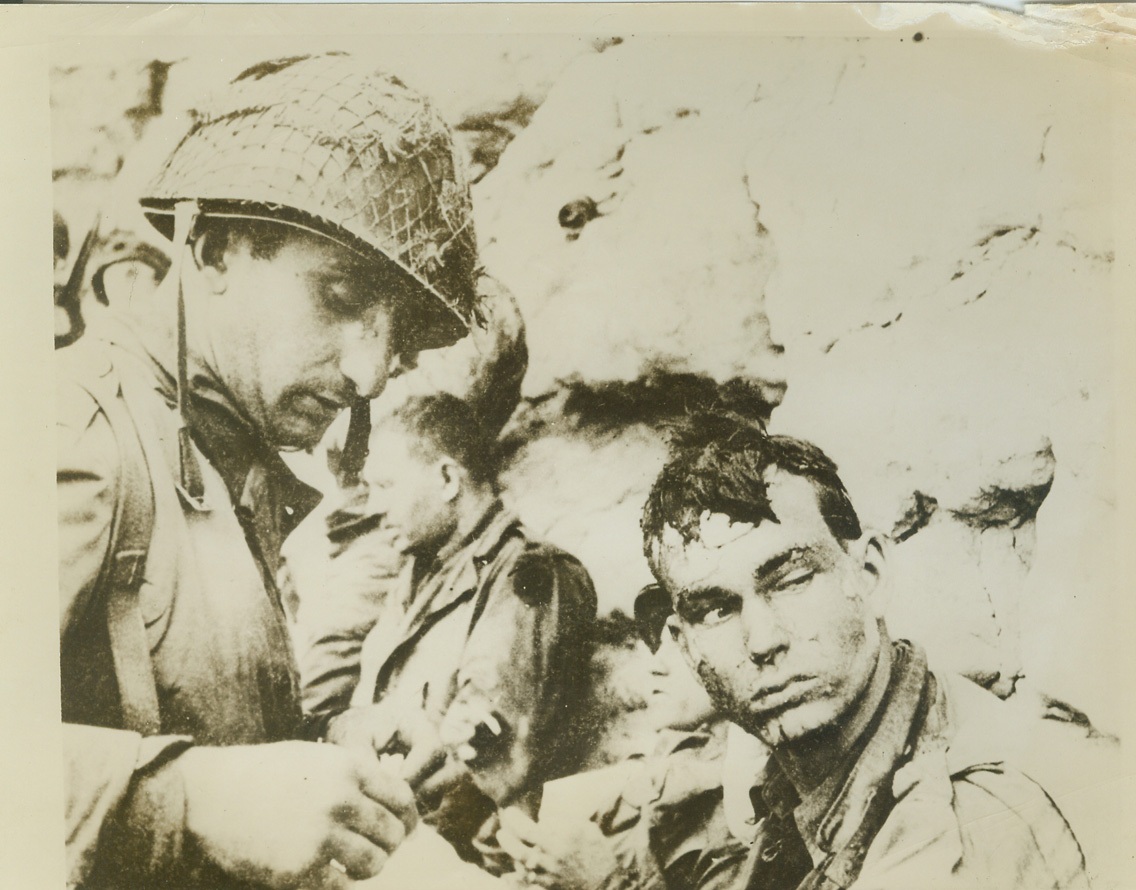
U.S. Invasion Casualty, 6/13/1944. France – His head battered, his face streaked with sweat and dirt, and his eyes mirroring the horror he has seen, an American soldier (right), keeps watching the battle down the beach as his hand is bandaged by a medical corpsman. He was one of the U.S. casualties during the early landings along the coast of France. Credit: (ACME);

FUTURE ADMIRALS FOLLOW TRADITION, 6/7/1944. ANNAPOLIS, MD – The largest class of midshipmen in the history of the United States Naval Academy graduated June 7th. Following tradition, their hats fly into the air as they cheer following the distribution of diplomas. Credit: ACME;
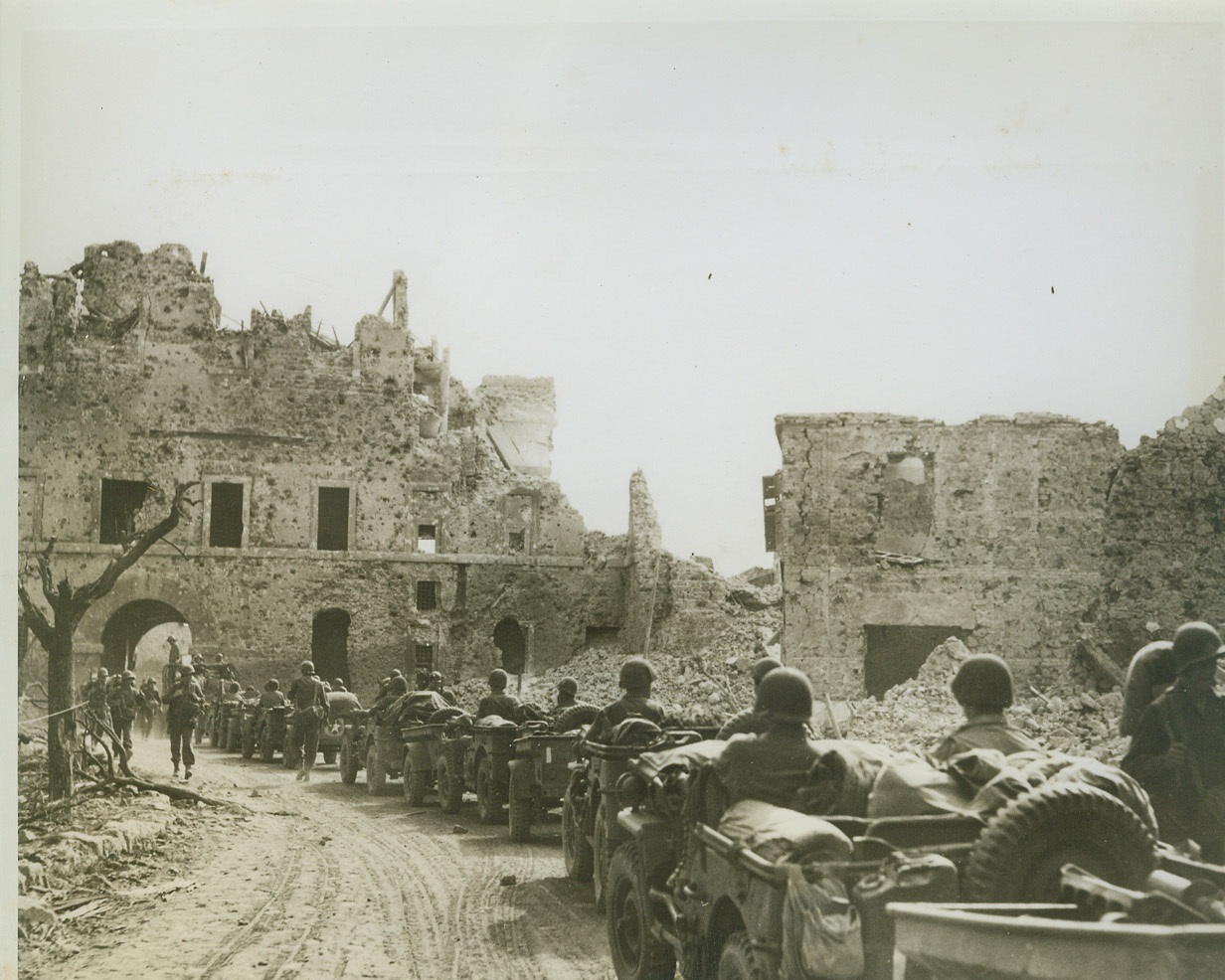
Parade of Jeeps through Cisterna Castle, 6/9/1944. Italy – A long line of Jeeps, American cavalry, winds through the ruins of what was once a proud castle in Cisterna, Italy. Troops are in pursuit of the Germans who had used the castle for a fortress. This town was taken by Anzio forces of the Allied Fifth Army in the early stages of the drive on Rome. Credit-WP-(ACME);
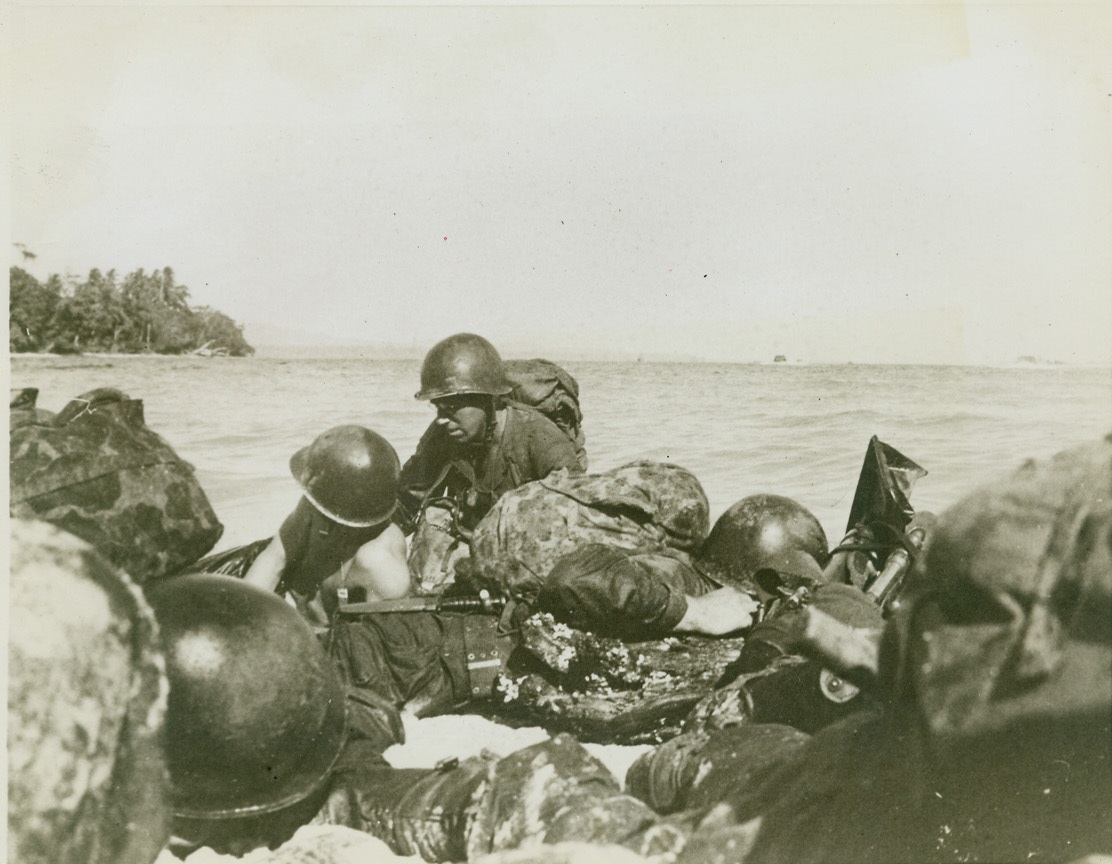
FIRST AID FOR AN INVADER – 3, 6/1/1944. WAKE ISLAND – Fire from Jap machine gun nests and pillboxes streams hotly from the shore, but first aid treatment for the wounded man, who was dragged to this point by his comrades, continues. Fighting man in center has ripped the shirt from his buddy’s back, and begins to dress the wound. Credit: Photo by Lt. Sidney Simon from ACME;

FIRST AID FOR AN INVADER –2, 6/1/1944. WAKE ISLAND – Tense and determined, our infantrymen hug the wet sand as they move through the surf, rifles in hand and full packs strapped to their backs. In center one of the invaders hurries to the assistance of his fallen buddy, stealing a hurried glance toward shore at the same time. Credit: Photo by Lt. Sidney Simon from ACME;
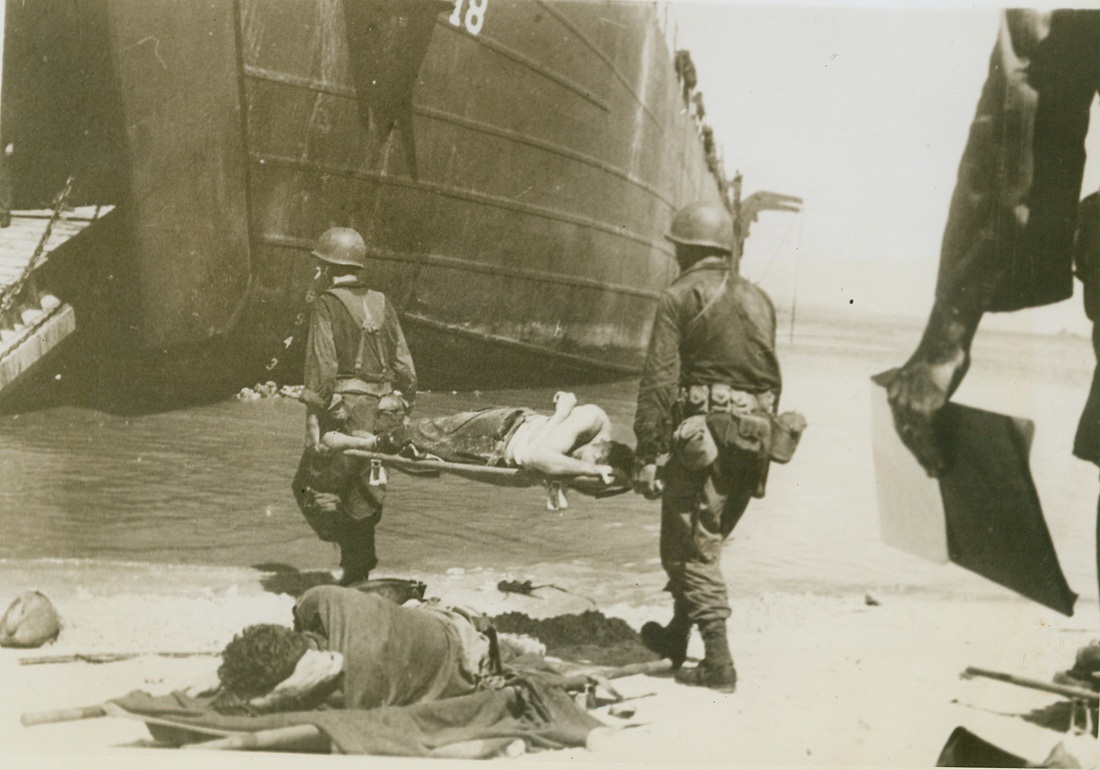
FIRST AID FOR AN INVADER – 5, 6/1/1944. WAKDE ISLAND – The menacing Japanese fire has been silenced now, and medical corps litter bearers have come ashore to collect and evacuate the wounded. The fighting man whose first aid treatment was rendered swiftly and efficiently at the water’s edge lies weakly on the stretcher as it is carried toward the big landing vessel at left. Another felled warrior lies in foreground. Credit: Photo by Lt. Sidney Simon from ACME;
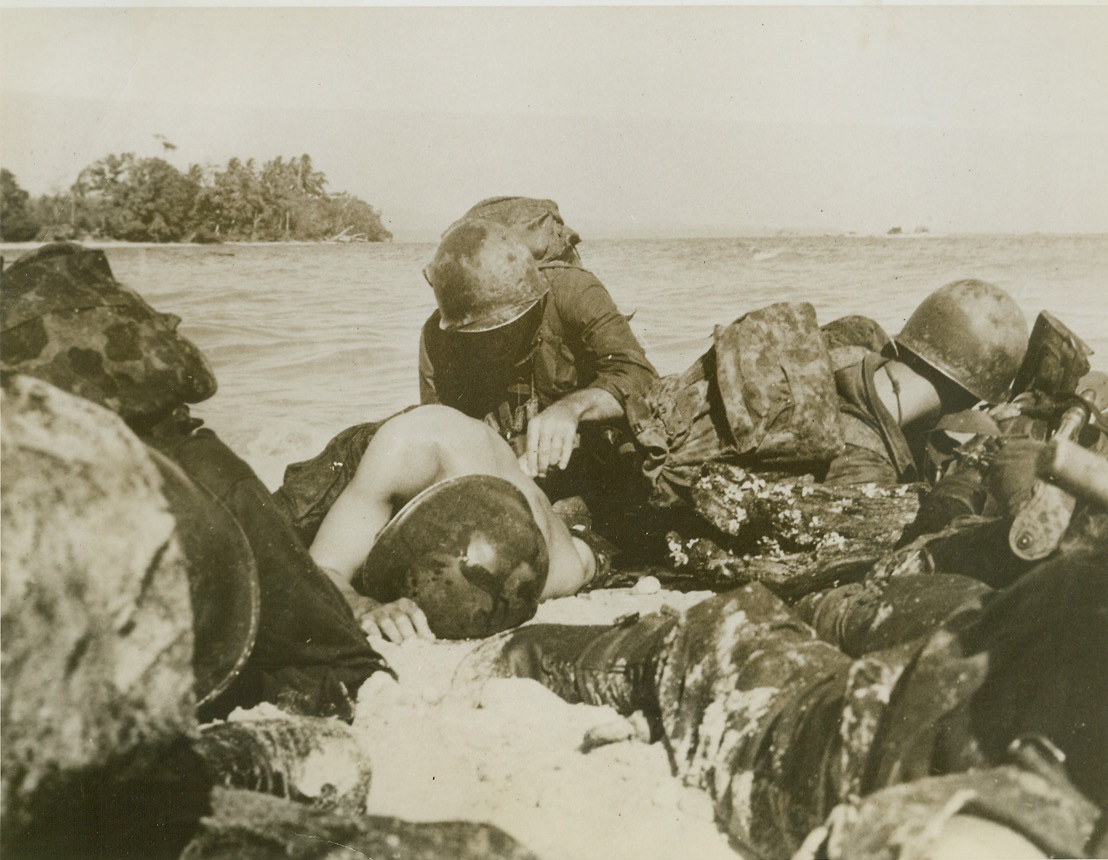
FIRST AID FOR AN INVADER – 4, 6/1/1944. WAKE ISLAND – The wounded fighter has dropped his head to the wet sand, lying there weakly as the bullet holes in his back are cleansed and dressed. Except for the mercy worker, all fighters keep their heads low to avoid the murderous fire from enemy pillboxes and machine gun nests that streams out over the water. Credit: Photo by Lt. Sidney Simon from ACME;
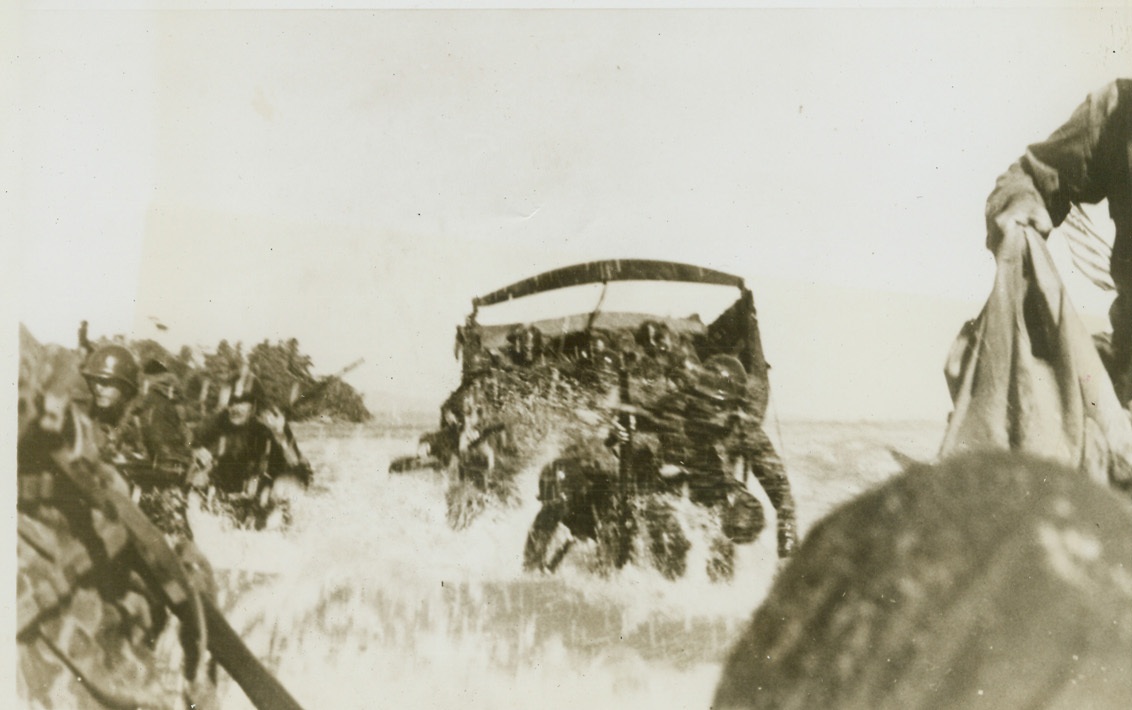
FIRST AID FOR AN INVADER – 1, 6/1/1944. WAKDE ISLAND – As the second wave of infantrymen charge ashore in the assault on Wakde Island, one of the invaders slips to his knees in the surf, hit by Jap machine gun fire. This unusual series showing on-the-spot first aid for a fighting man was made by 1st Lt. Sidney Simon, who was in on the Wakde Island invasion as an observer for the U.S. Army Engineers. Under enemy fire every moment, Lt. Simon’s camera recorded the heroic mercy treatment rendered a fallen comrade in the midst of landing operations. Credit: Photo by Lt. Sidney Simon from ACME;
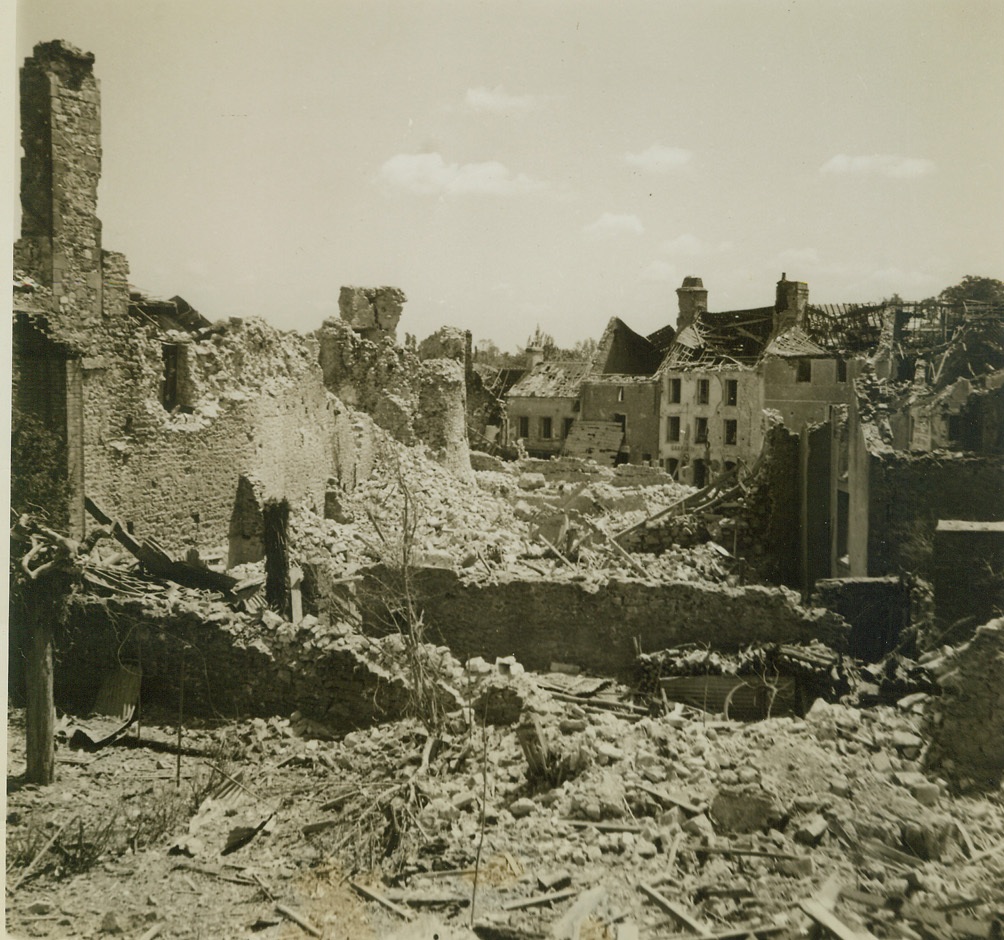
Once a City, 6/23/1944. St. Sauveur, France – All that remains of St. Sauveur is a mass of rubble and fragments of buildings left standing after the Germans fled from the town. Civilians who evacuated their homes returned to find only a wall or two left, and often members of their families lay dead in the ruins. Credit (ACME Photo by Andrew Lopez, War Pool Correspondent);
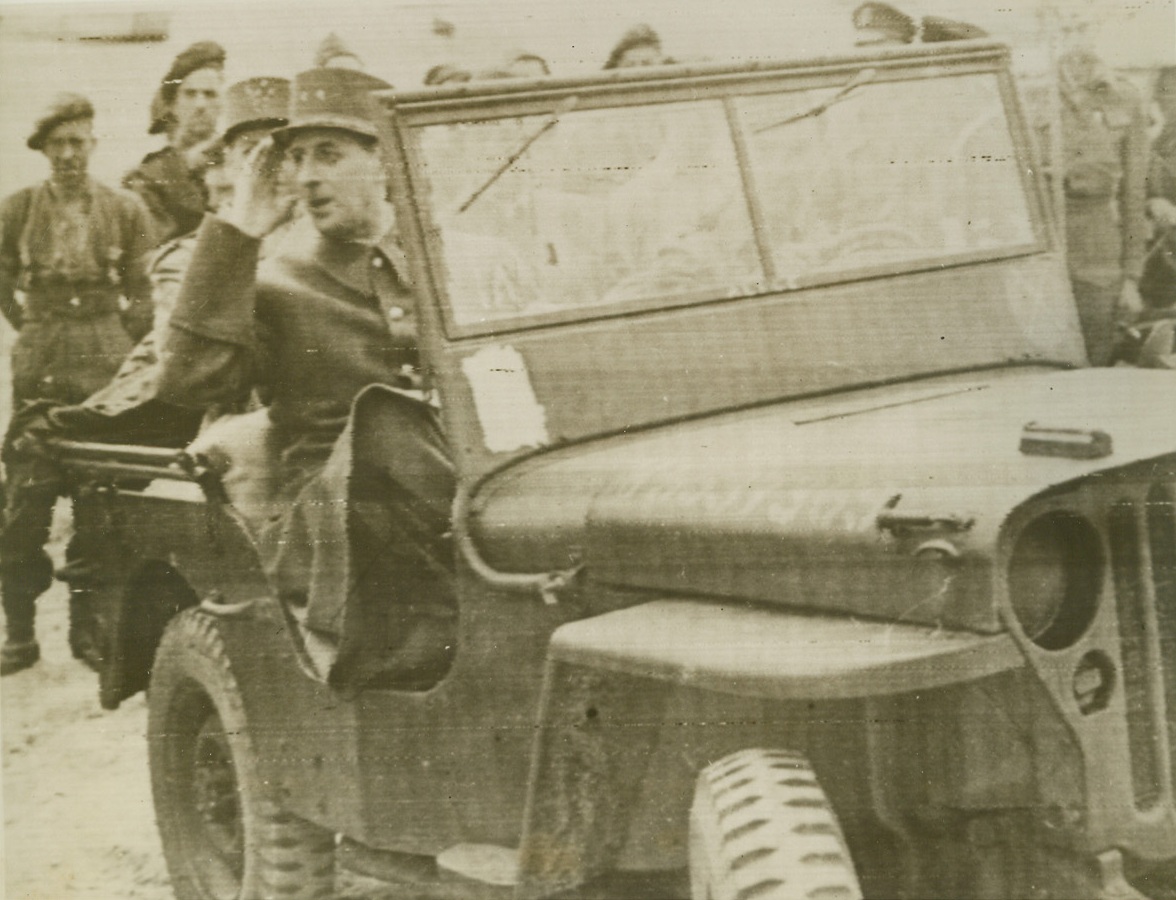
A Frenchman Returns Home, 6/14/1944. FRANCE—Returning to the country that he left almost four years ago, General Charles DeGaulle( saluting), head of the French Committee of National Liberation, rides in a Jeep on tour of inspection of the Allies’ “ Liberation Beachhead” along the Norman coast. Credit: British War Office Radiotelephoto ACME;
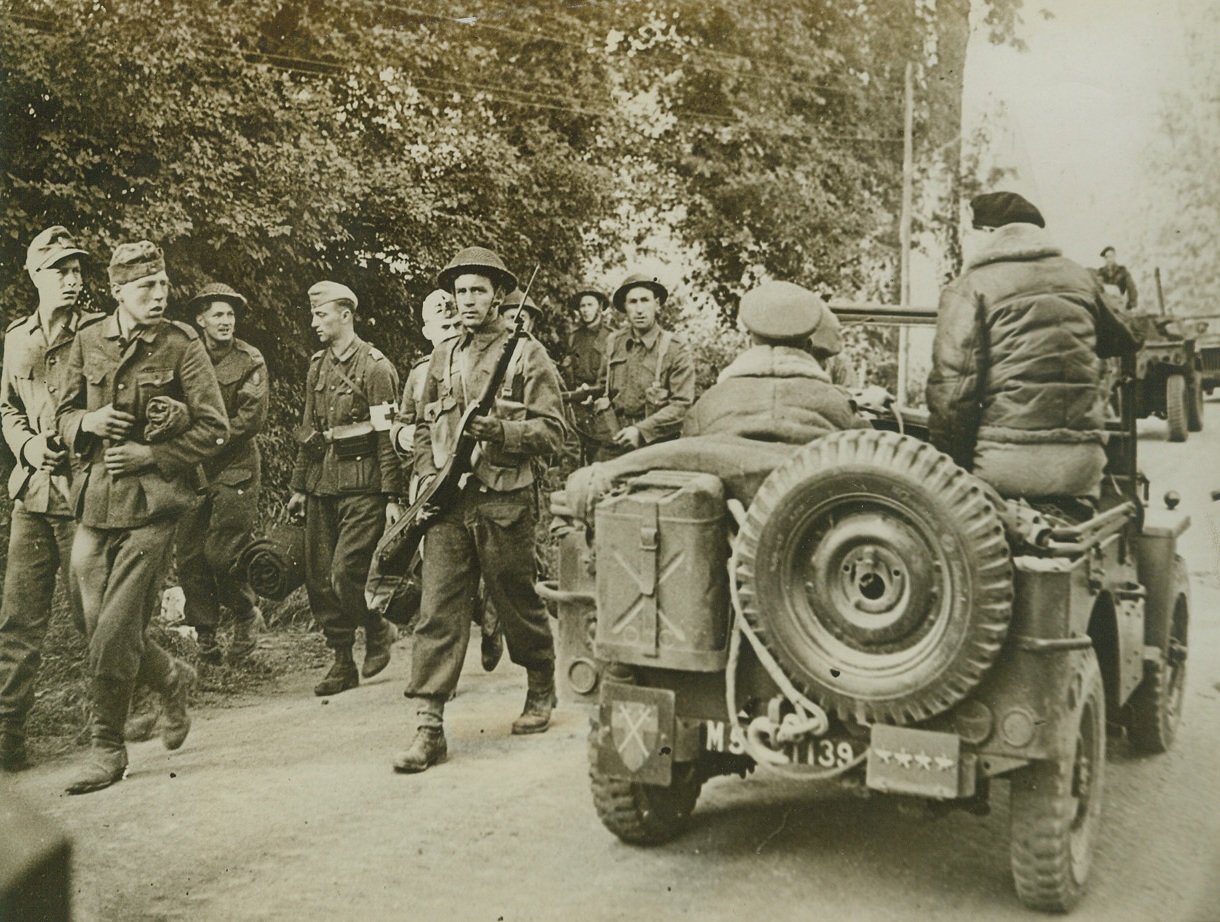
“Achtung—Montgomery”, 6/13/1944. SOMEWHERE IN FRANCE—Awestricken, German prisoners gape at the sight os eneral Sir Bernard Montgomery perched in a Jeep in the first stages of the Allied invasion. The Nazies are being marched back by British “Tommies” to the Allied beachhead prior to English PW camps.Credit ACME;
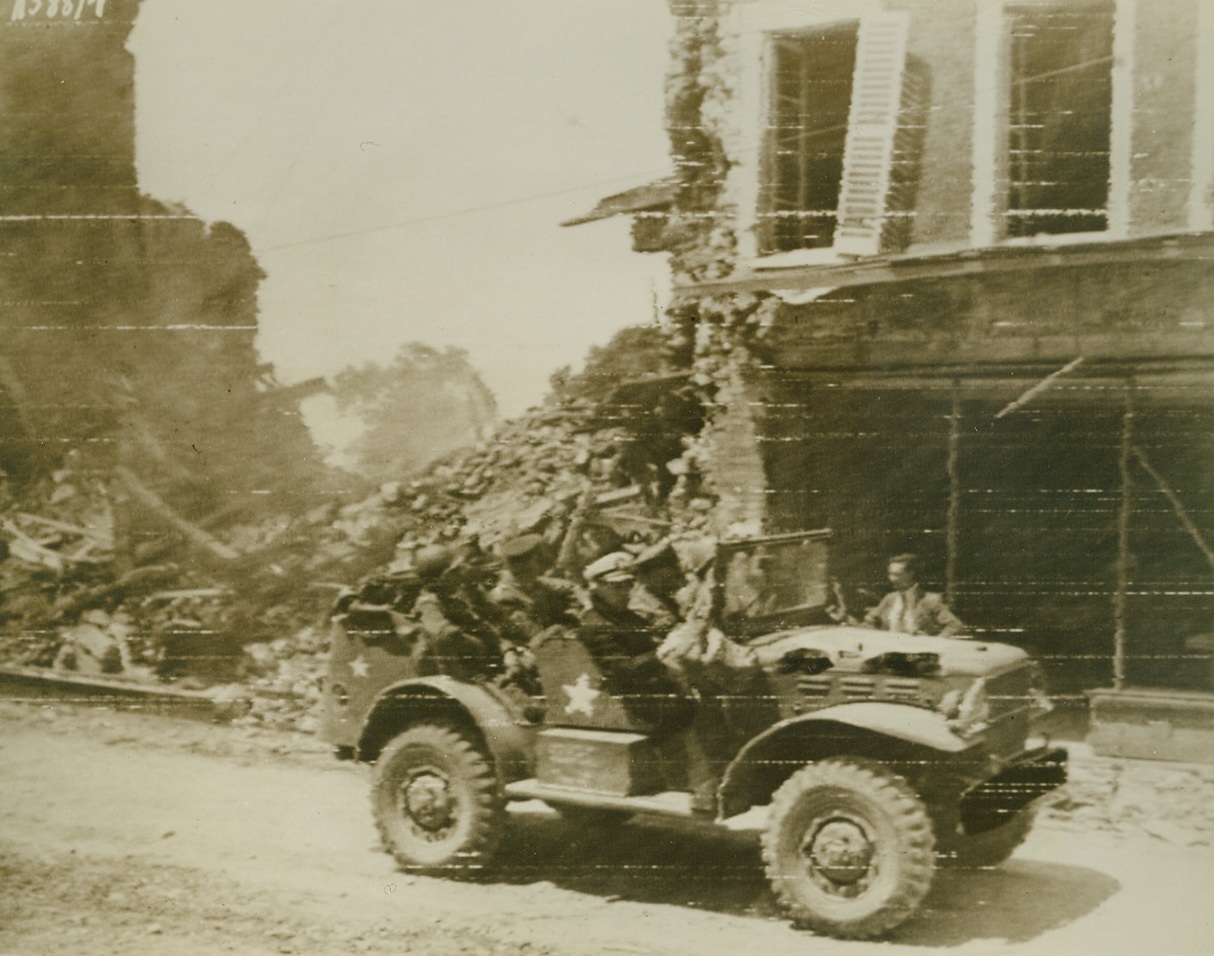
U.S. Chiefs inspect Invasion Beachhead, 6/13/1944. FRANCE—This Photo, flashed to the U. S. by Radiotelephoto today, shows American Army and Navy chiefs as they ride through a ruined town on the Allied Beachhead in France on a tour of inspection. In the combat car are Gen. George C. Marshall, U.S. Army Chief of Staff; Gen. Dwight D. Eisenhower, USA Supreme Allied Commander in Europe; Admiral Earnest J. King, admiral of the US Fleet; and Gen. Henrey H. Arnold Chief of the USAAF. Passed by censors. Credit: U.S. Signal Corps Radiotelephoto;
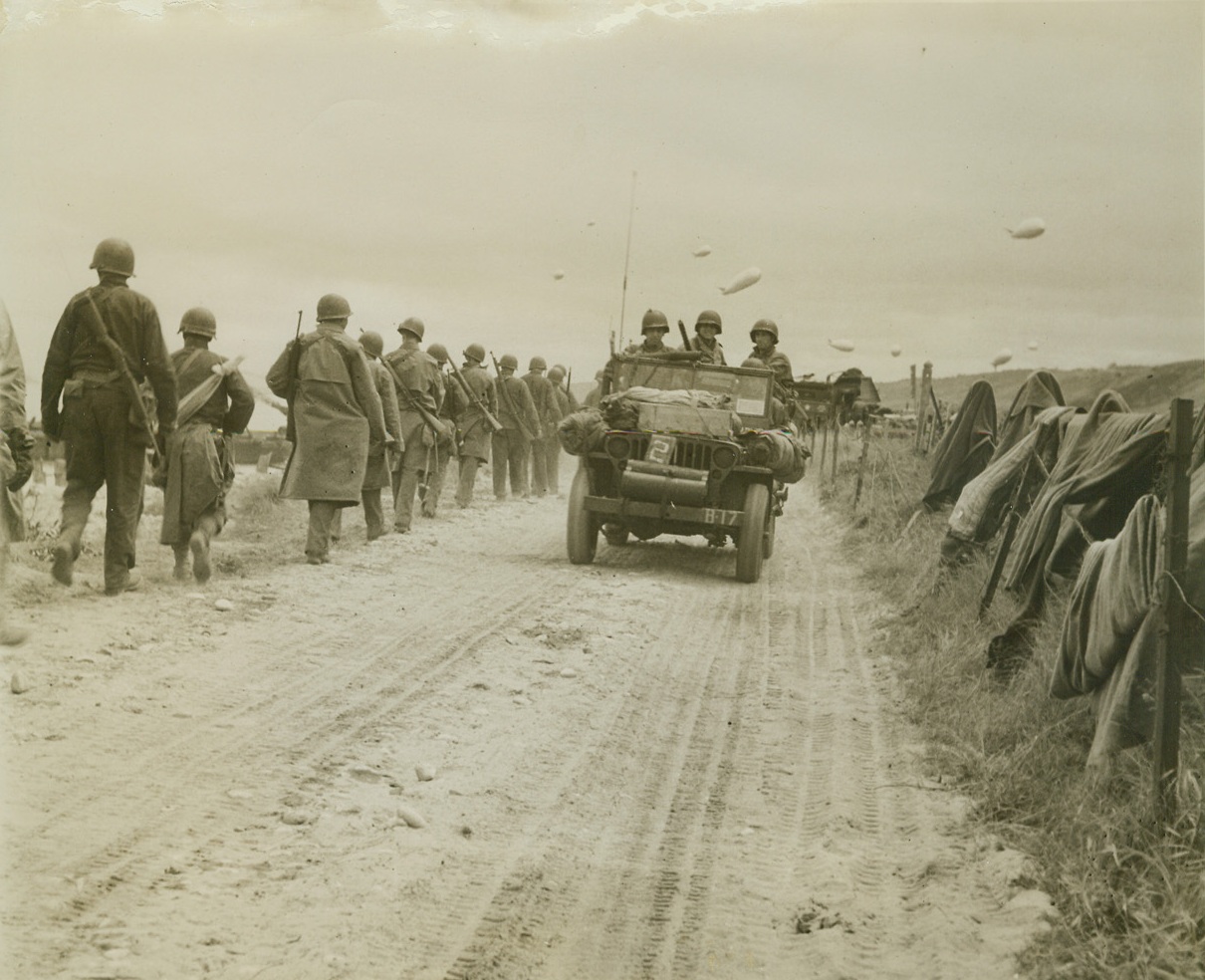
Yanks Headed For Action, 6/13/1944. FRANCE—in single file, American troops march down a narrow French Road on their way from (illegible)…Invasion Beachhead to engage the (illegible)……Note Barrage Balloons, (right,) (illegible)…..(Note: Some of the left side of the description of this image has been torn away)Credit: Bert Brandt;
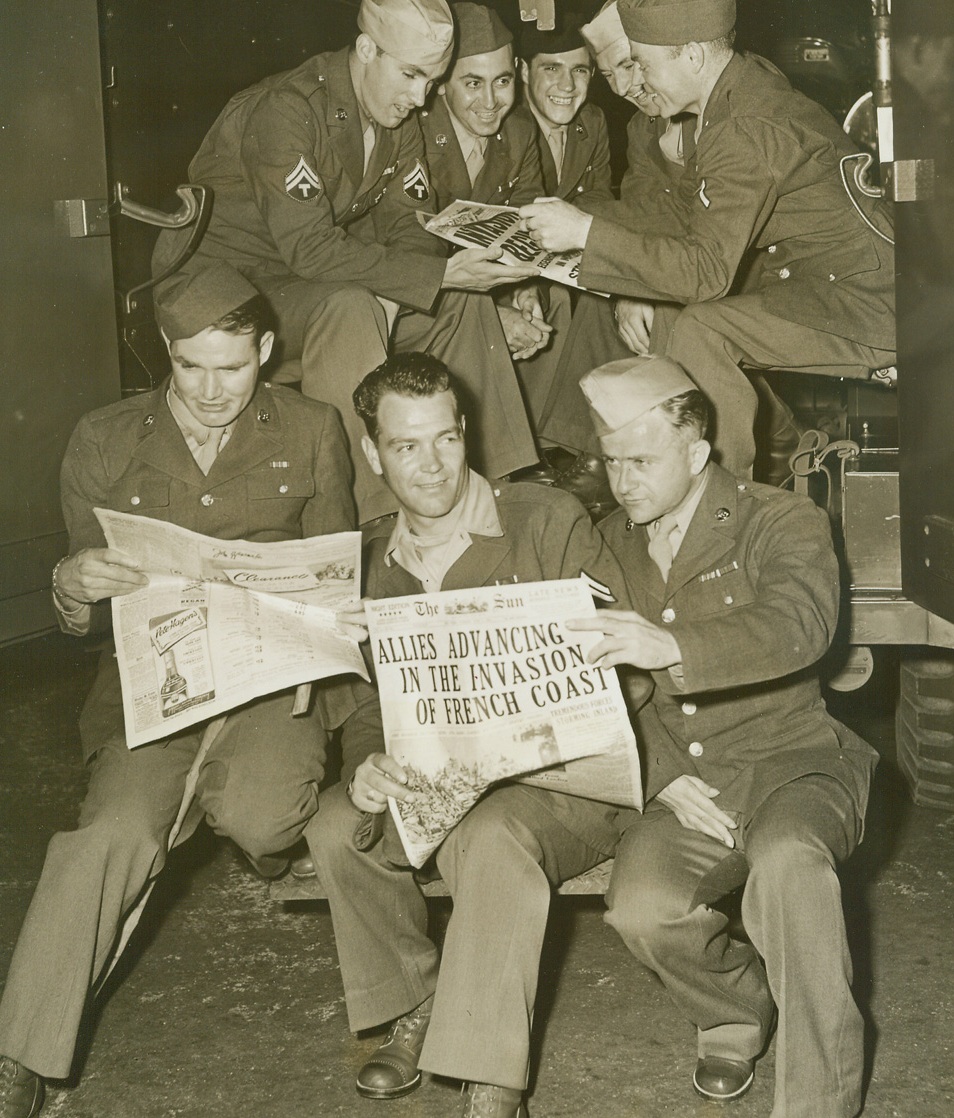
Good News for Gripsholm Arrivals, 6/6/1944. JERSEY CITY N.J.—The first of a group of 51 wounded or ill American soldiers, who arrived I Jersey City this afternoon aboard the exchange liner Gripsholm, read the news of the invasion of western Europe, in the ambulance just before leaving for Halloran General hospital on Staten Island. The Gripsholm making it’s fourth exchange voyage between Europe and the U. S. also carried 37 Canadian soldiers and 35 civilians.Credit: ACME;
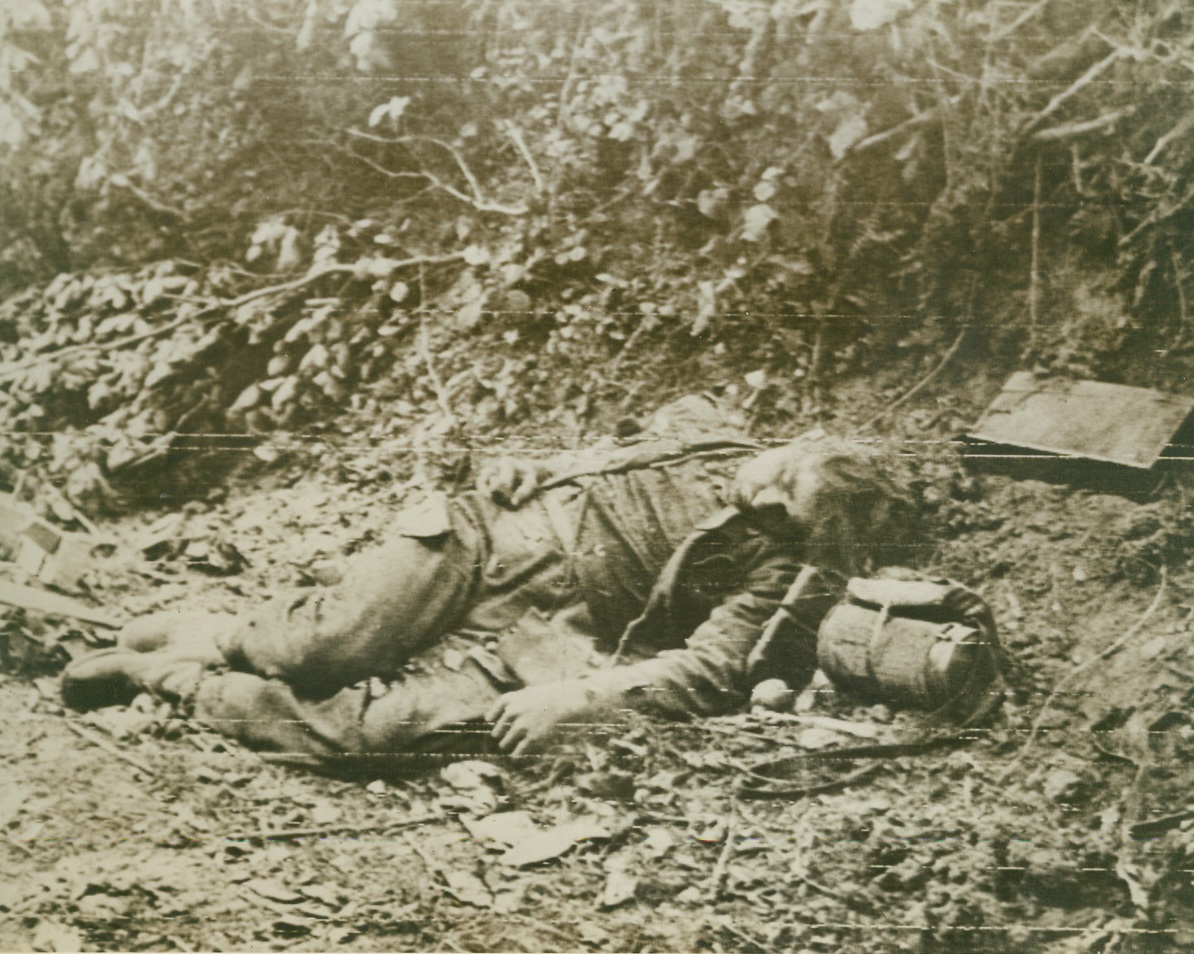
Fallen Nazi, 6/25/1944. SOMEWHERE IN FRANCE – Pushing ahead through the outer defenses of Vital Cherbourg in their rapid advance on the key French Port, American troops came upon this fallen Nazi. Losing his battle before his fellow Germans admitted defeat in the fight for Cherbourg, the Nazi lies dead in a ditch.Credit: ACME, photo by Bert Brandt for the War Picture Pool;
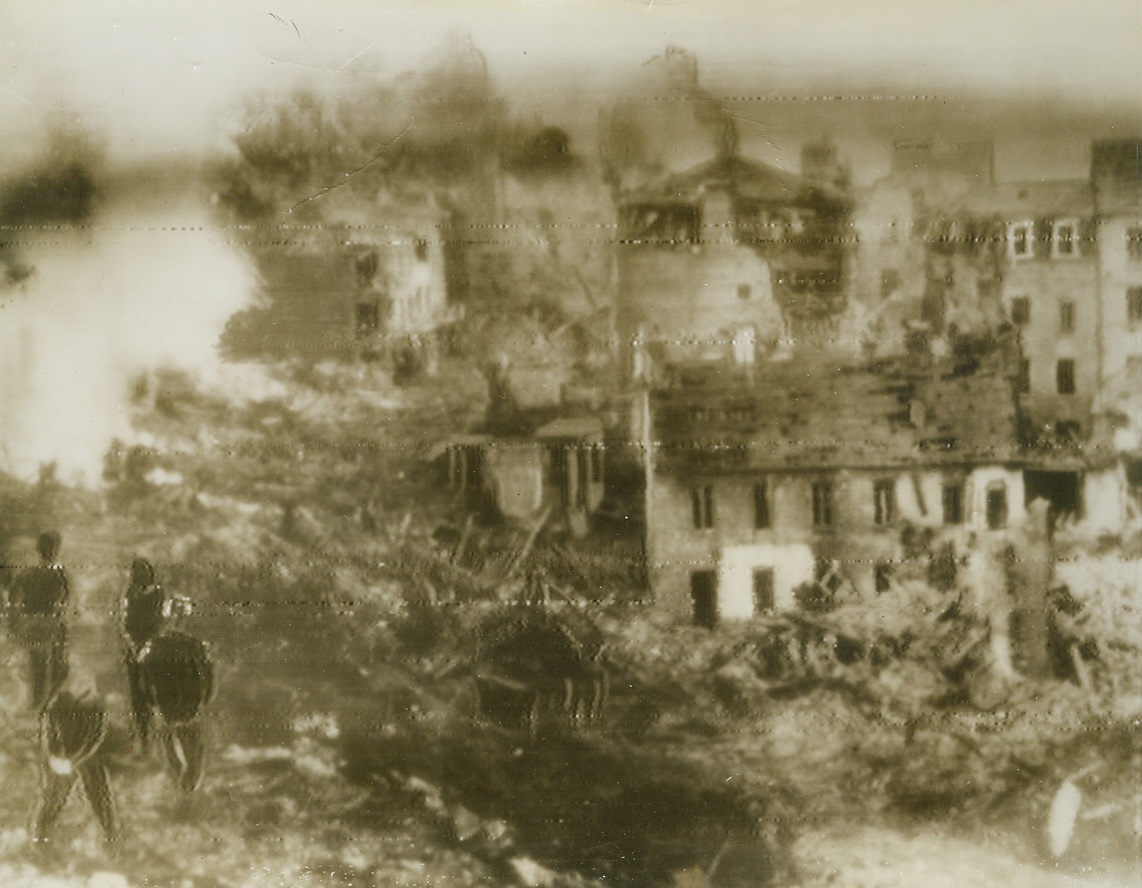
St. Lo Battered By Allies Say Nazis, 6/14/1944. Received in this country through a neutral source, this photo, made by the Germans, is described as showing the French town of St. Lo after heavy bombardment by the Allies. Gutted homes and smoke from still smouldering debris mark this desolate scene. Credit: ACME radiotelephoto.;
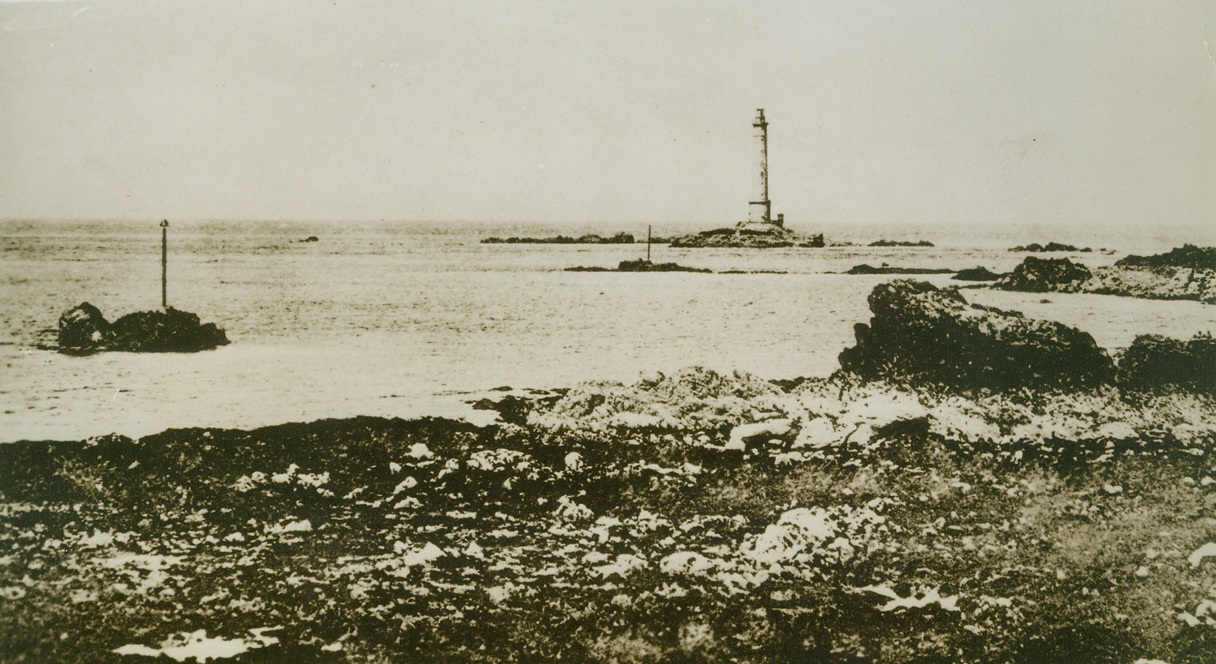
Another Cap Bon For Germans?, 6/21/1944. A view of the bleak, desolate stretch of Channel Coast at Cap de la Hague at the extreme northwestern tip of the Cherbourg Peninsula, to which beaten German troop from Cherbourg, are retreating. With American troops in hand-to-hand battle with Nazi “suicide” rear guards in the streets of the French deep-water port, the entire pressure of the American advance, is forcing the remaining Germans (approximately two divisions) toward Cap de la Hague. This bit of seacoast may be another Cap Bon, where the Allies ground out the last of the Nazi resistance in North Africa. Credit: ACME.;

French Mayors Discuss Food, 6/21/1944. In this photo, flashed to the U.S. today by radiotelephoto, the mayors of six liberated towns in France as they met to discuss problems of food storage and distribution with officials of the Allied military government. Credit: Army radiotelephoto from ACME.;
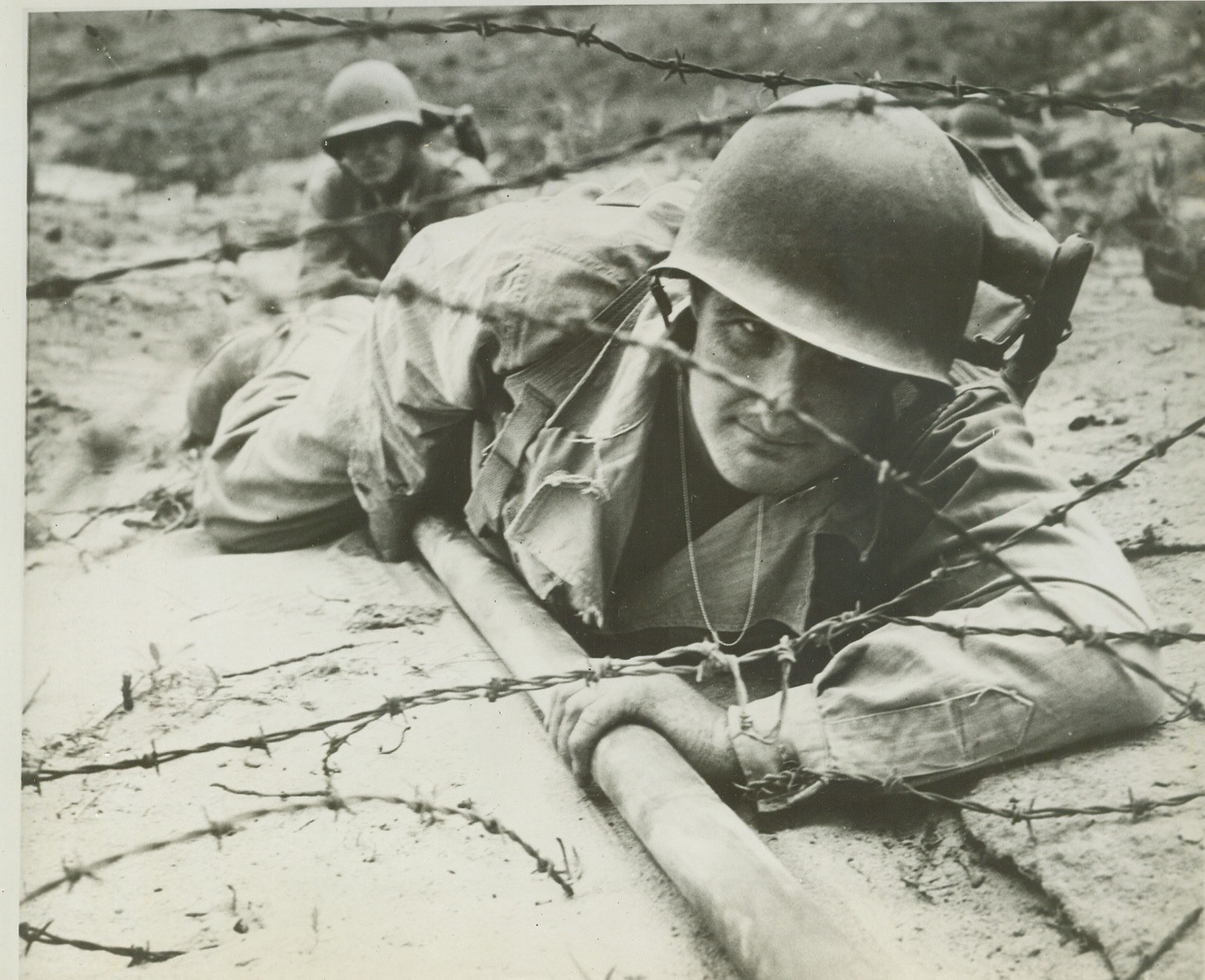
The Infantry School's "West Wall", 6/4/1944. Ft. Benning, Ga. – Newest assault course at Fort Benning is the infantry school’s authentic exterior replica of a section of Germany’s famed West Wall, a series of pillboxes and blockhouses, which extends along the coastline from France to Norway and which our invasion troops must reduce from beachheads before they can drive inland to strike at the heart of the Nazi-dom. Constructed after study from Allied photographs, the course covers 1,000 square yards and is used by the infantry school in the training of officers and officer candidates. Infantry school demonstration troops, some of whom are shown in these photos, carry out “assaults” for the benefit of each new class. Live ammunition is used and every three weeks the concrete pillboxes and blockhouses must be largely rebuilt and barbed wire torn by Bangalore torpedoes must be restrung by engineer troops assigned to the school. PHOTO NO. 1: First step in the reduction of a pillbox or blockhouse, as taught by the infantry school, is the blasting of a path though barbed wire. This is accomplished by use of the British-invented Bangalore torpedo, which opens the way for the flame-thrower. Here demonstration troops place the long torpedo under the wire. Credit Exclusive “ACME” Photo;

Lone Fascist Wages Own War, 6/24/1944. ROME, ITALY—When American Forces entered Rome; they were greeted by an unseen enemy. One lone fascist sniper opened fire on the soldiers from the window of an apartment house, but he was quickly nabbed by the Yanks. Here, a crowd of Italian civilians scurry for shelter from the sniper’s fire. Credit: Canadian Official Photo from ACME.;
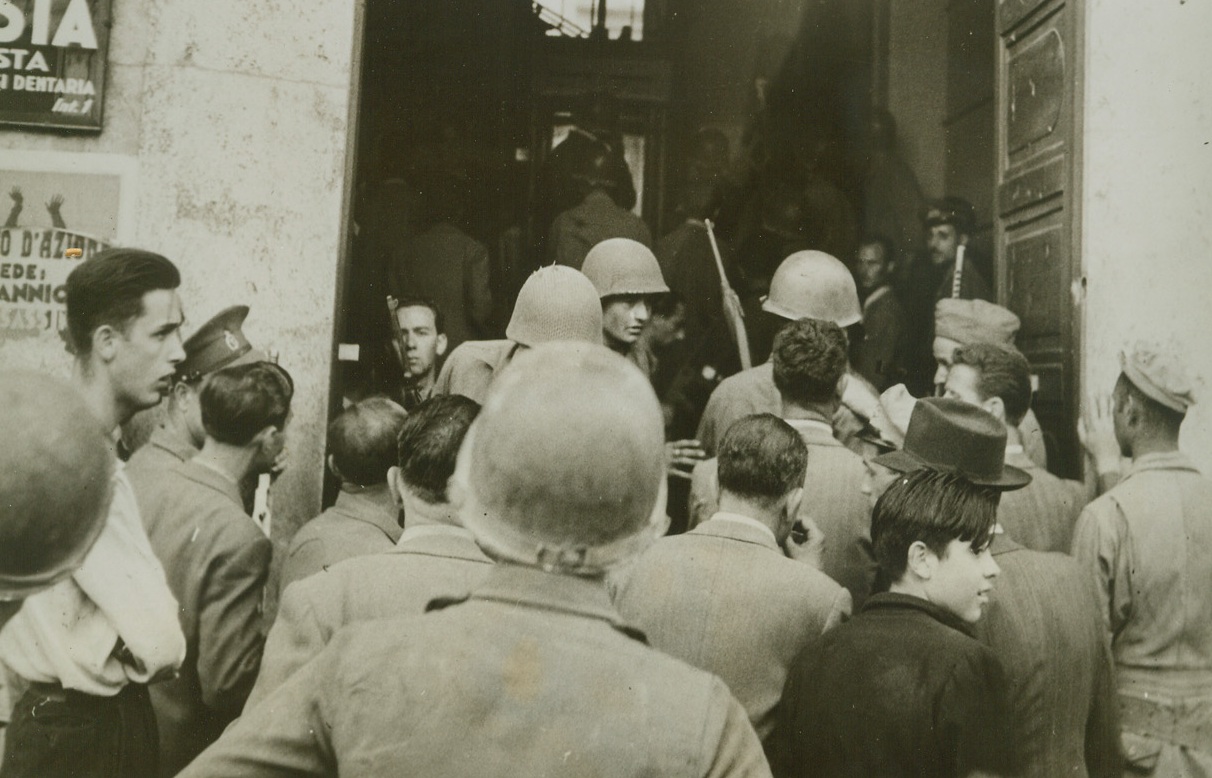
Lone Fascist Wages Own War, 6/24/1944. ROME, ITALY—When the American forces entered Rome, they were greeted by an unseen enemy. One lone fascist sniper opened fire on the soldiers from the window of an apartment house, but he was quickly nabbed by the Yanks. Here American soldiers force their way through a crowd of curious civilians into the lobby of the apartment house from which the sniper fired on the soldiers from an upper window. Credit: Canadian Official Photo from ACME.;
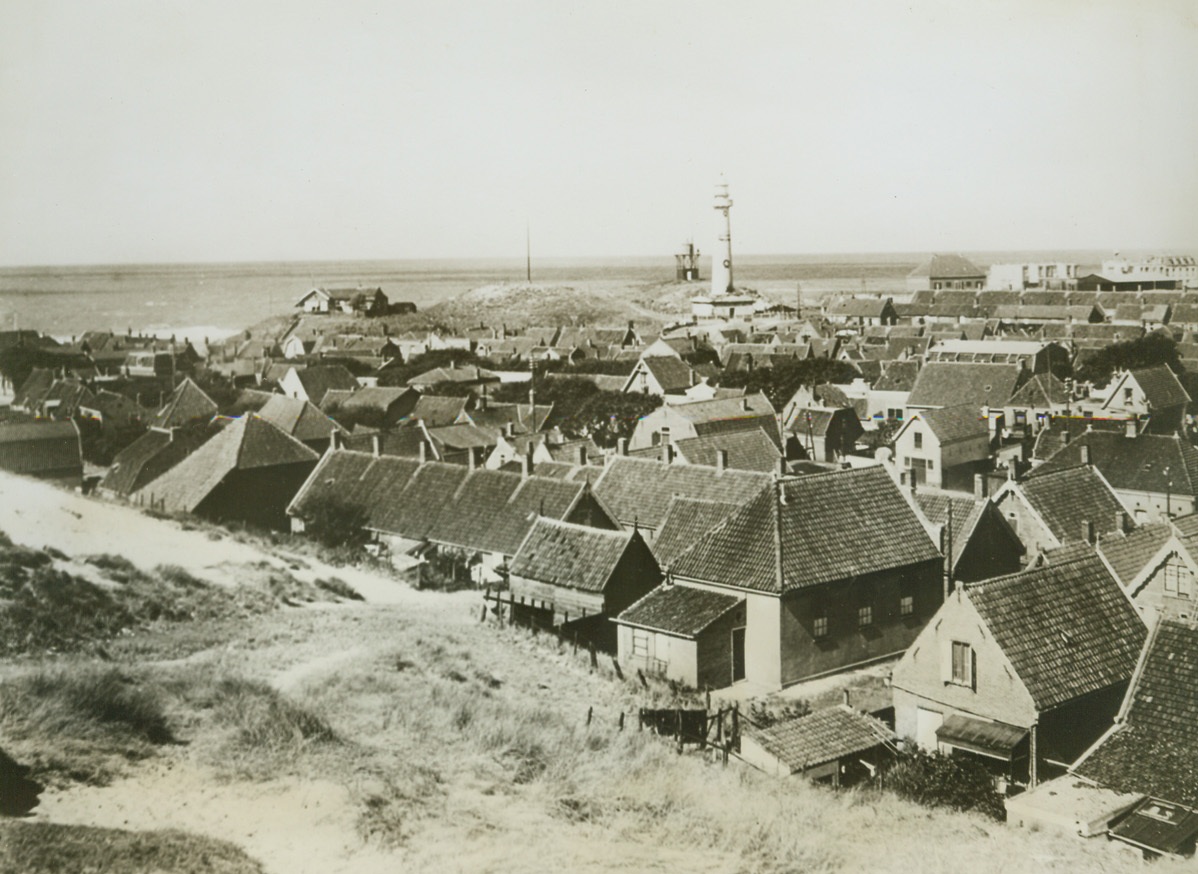
DUTCH ADVISED TO LEAVE, 6/5/1944. Shortly after the German Radio Reported that invasion operations on the French Coast had begun, BBC carried an urgent message to the people of Holland from the Allied High Command. All people living within 18 miles of the Dutch Coast were advised to leave their homes—Homes such as those shown in photo—immediately, and to keep off roads, railways and bridges. This is a scene at Egmond Aan Zee on the north seacoast of Holland, with the North Sea on the horizon in background. Credit: ACME PHOTO FROM NETHERLANDS INFORMATION BUREAU;
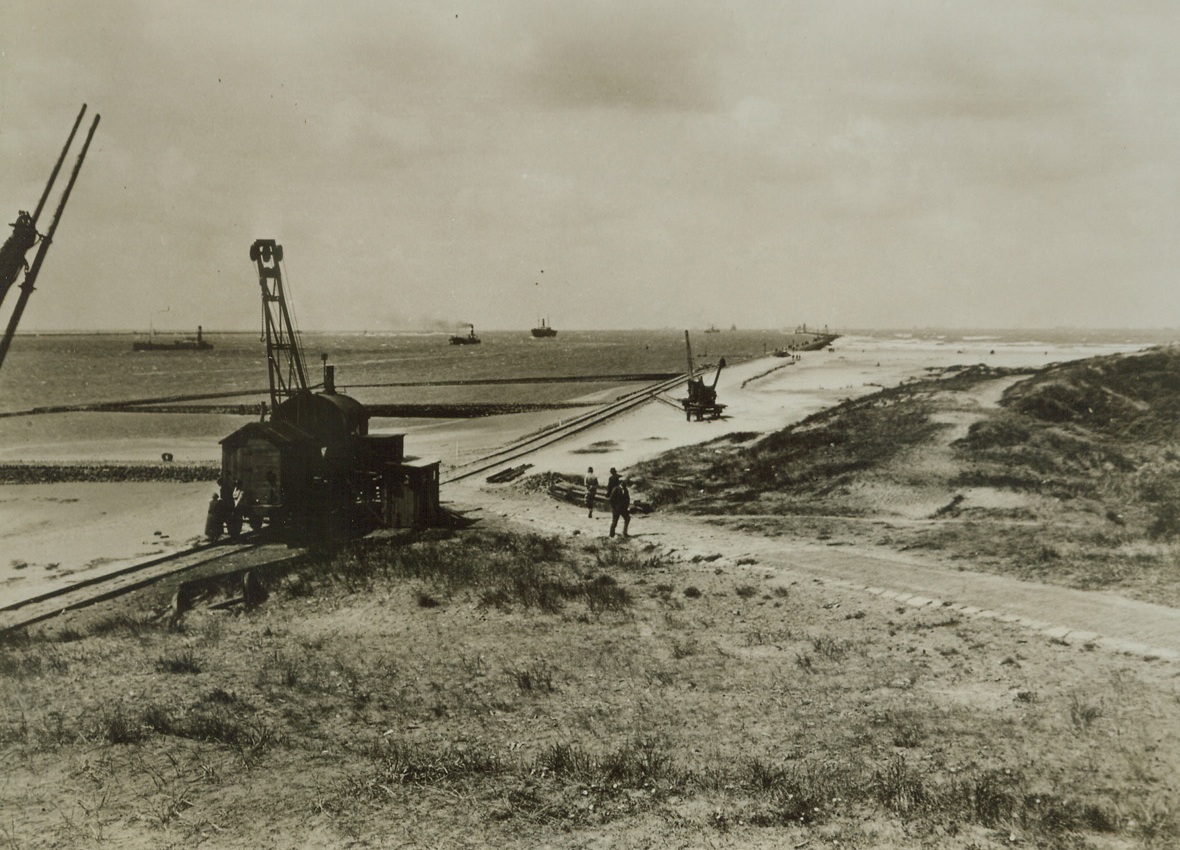
Leave your Homes, 6/5/1944. Broadcasting urgent instructions from the Allied High Command, BBC carried a message to the people of Holland, urging all residents living with 35 kilometers (about 18 miles) of the Dutch Coast to leave their homes immediately and also keep off roads, railways and bridges. Here is a scene at Hook of Holland, a coastal village on the North Sea, at the entrance of the water way that leads to Rotterman. Photo shows the entrance piers to the ocean harbor, the beach and the sand dunes. Credit: ACME PHOTO FROM NETHERLANDS INFORMATION BUREAU.;
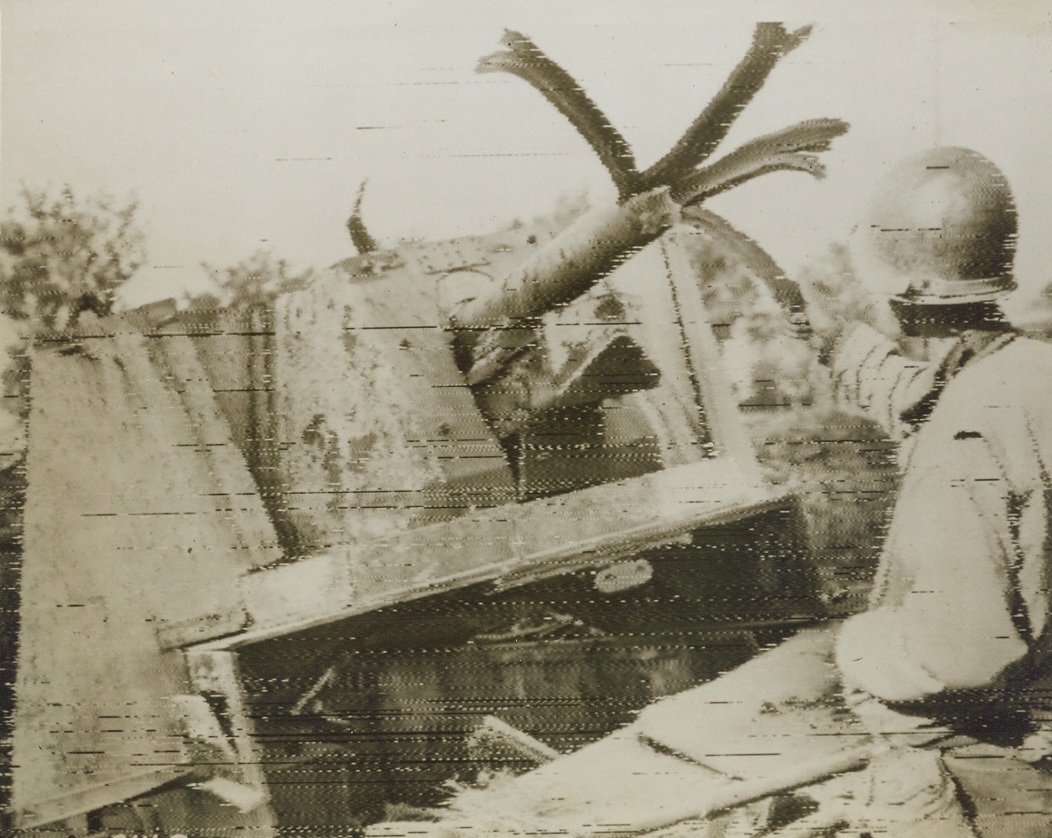
Knocked-Out Nazi Gun, 6/5/1944. ROME—Curiously, a Yank examines the shredded barrel of a large German gun, which was destroyed by fleeing Nazis on the outskirts of Rome so that the equipment would be useless to Allied troops who followed hot on their heels. The town steel through which Nazi shells once poured out at our fighters blew out in strips, making the gun’s nose look like a bedraggled palm tree. Credit: U.S. SIGNAL CORPS RADIOTELEPHOTO-ACME.;
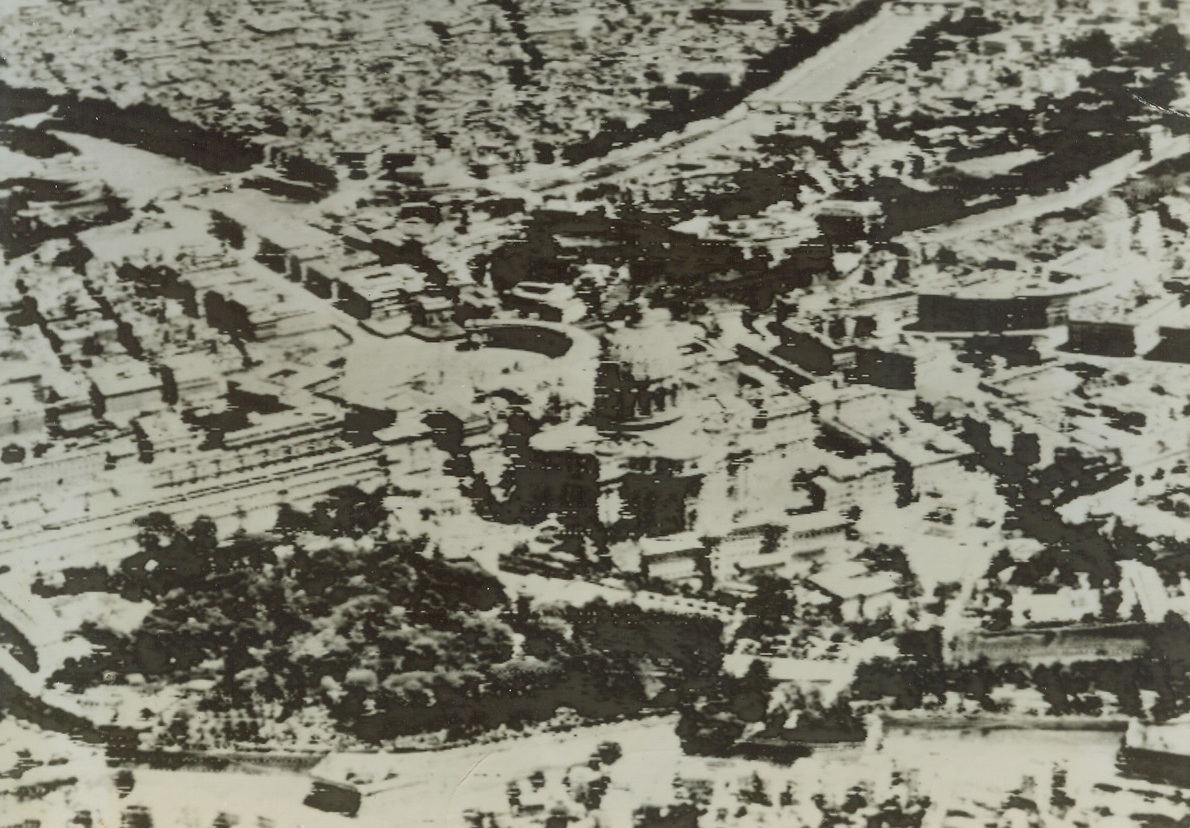
Rome - As Allies Reached Its Gates, 6/4/1944. ROME-Allied Fifth Army troops were hammering at the gates of Rome as this photo was made from a B-26 medium bomber by ACME photographer Charles Seawood for the War Picture pool. Vatican City lies in center of photo, with the familiar dome of St. Peter’s Cathedral clearly shown. The Tiber River, spanned by numerous bridges, winds in background. Credit: ACME photo by Charles Seawood, transmitted via U.S. SIGNAL CORPS RADIOTELEPHOTO.;

British Elite Troops – Say Germans, 6/13/1944. NEW YORK CITY—This German photo flashed by radio from neutral Stockholm to New York says that these soldiers are “Prisonered Elite British troops taken during invasion.” Allied captured, killed and wounded are far less than had been anticipated in advance of the Normandy invasion. Credit: ACME RADIOPHOTO.;

Jubilant Romans Cheer Allies, 6/5/1944. ROME—Wildly cheering throngs, gathered in Mussolini Square to celebrate the fall of Rome to the Allies, swarm around a sound truck (in foreground), while an Allied tank is hemmed in by crowds in background. The city was in a carnival mood as victorious Allied troops entered. Credit: SIGNAL CORPS RADIOTELEPHOTO FROM ACME.;
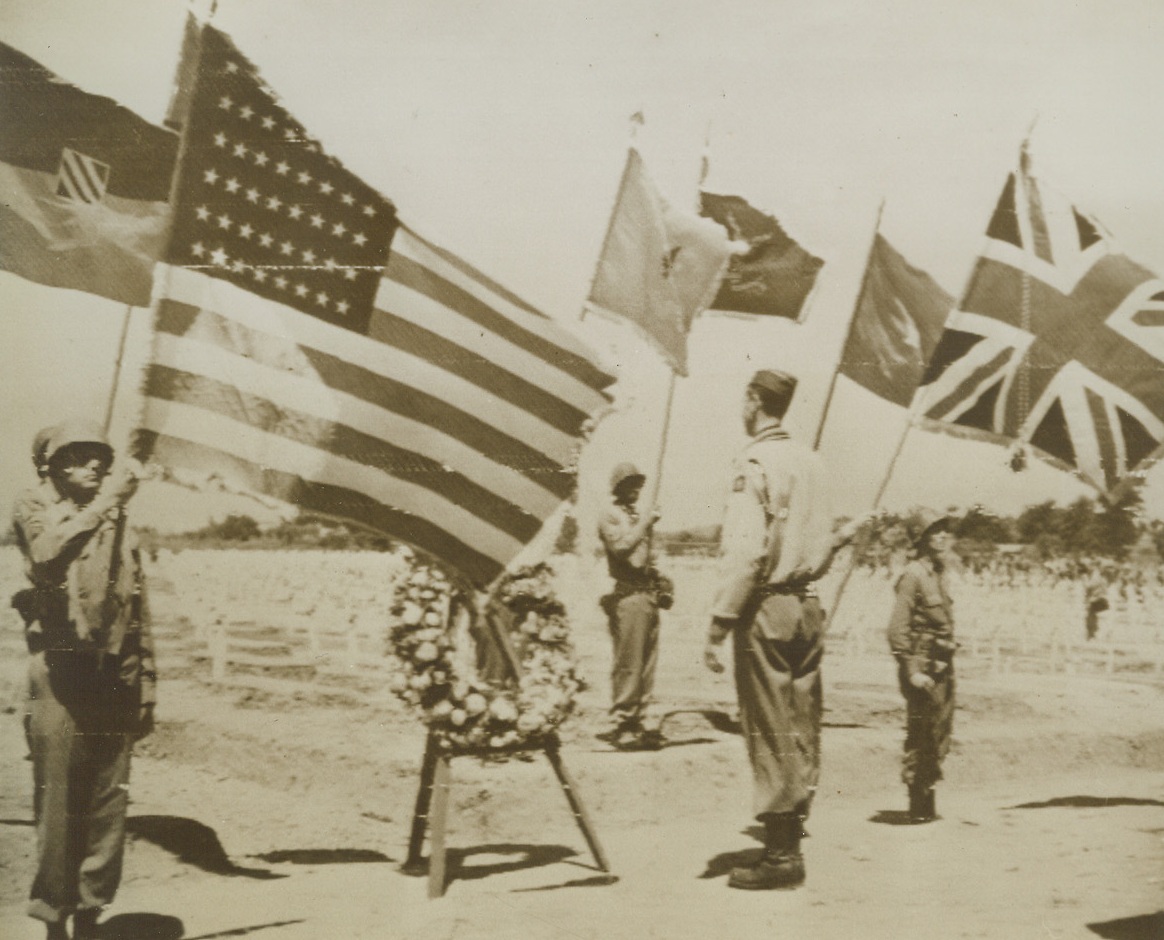
Italian War Dead Honored, 6/1/1944. ITALY—Flanked by Allied flags, Lt. Gen. Mark W. Clark stands at attention before an easel on which he placed a memorial wreath honoring the Allied fighters who died fighting in Italy. General Clark pledged “To those men who lie before us that the Fifth Army shall continue to fight where they left off, with their spirit as our guide, till victory is ours.” Credit: U.S. ARMY Radiotelephoto from ACME.;
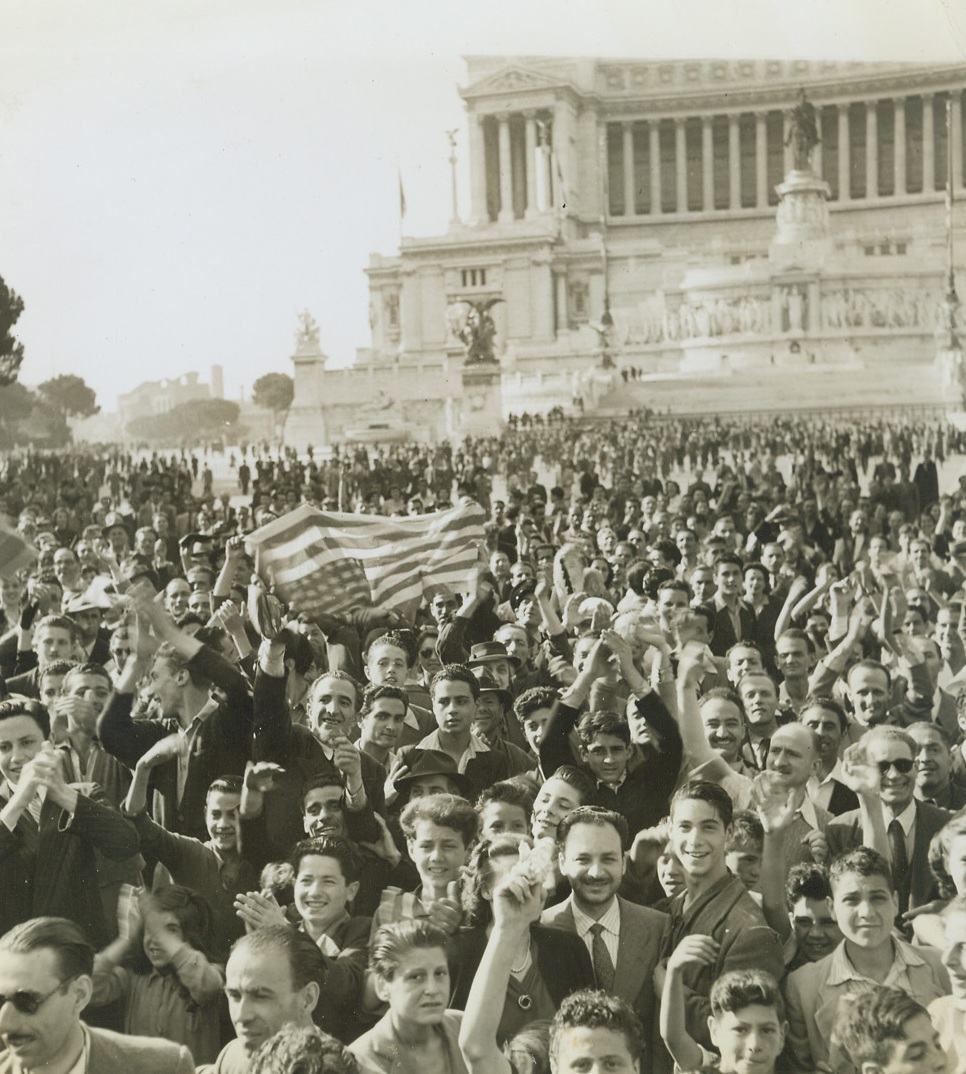
Hallelujah Day, 6/10/1944. ROME, ITALY—With the entrance of the conquering American troops into their city, Italian civilians realized that the day of Rome’s liberation was at hand. Filling the air with their cheers and cries of joy, they massed in the streets to pay honor to the Yanks. Here a crowd in front of the Victor Emmanuel Monument lifts aloft the stars and stripes as they hail the conquering heroes. Credit: ACME photo by Charles Seawood, War Pool Correspondent;
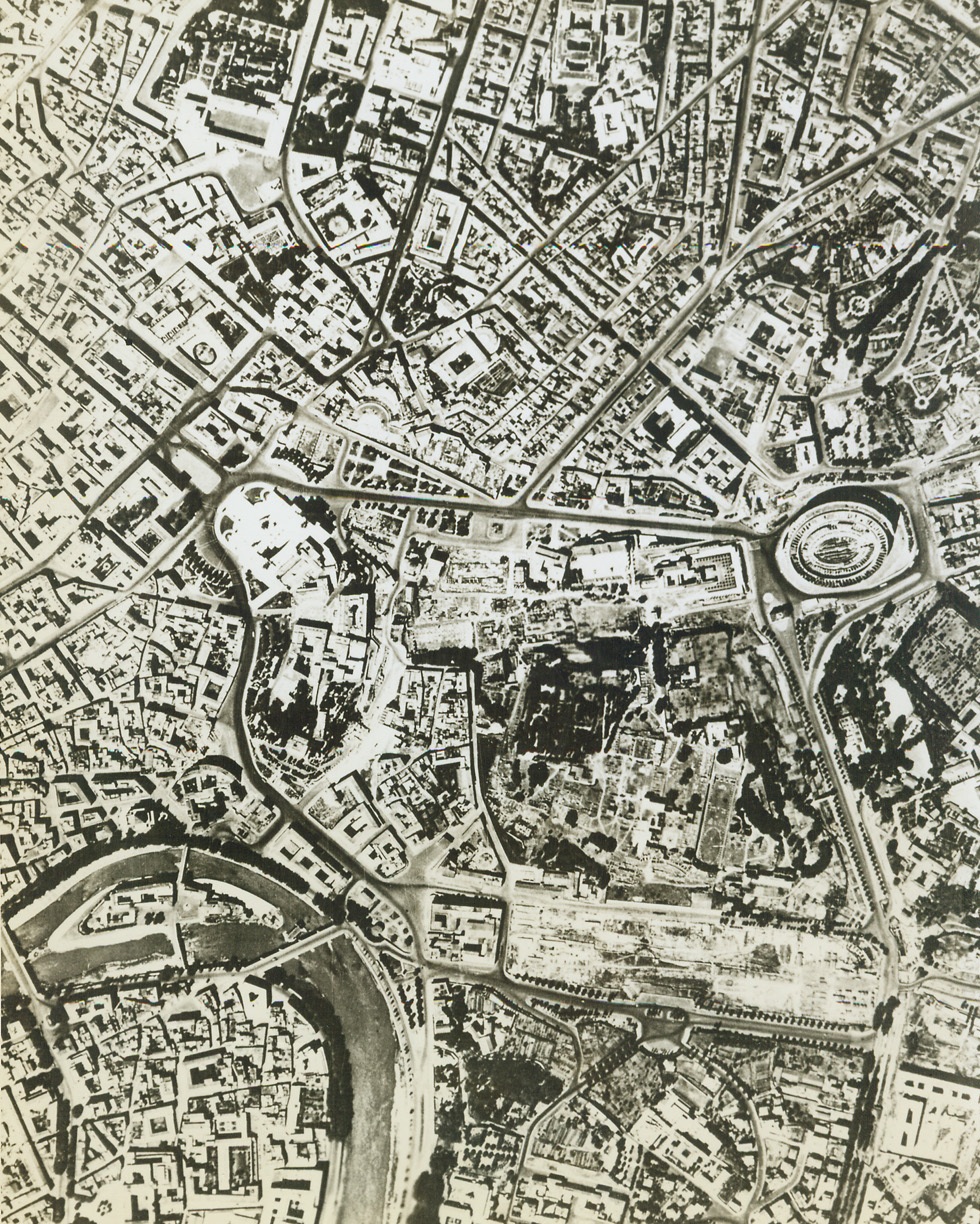
Rome from the Air, 6/4/1944. This aerial view of Rome shows the Colosseum (extreme left, halfway down) with the Via Dell Impero running across from it to the Piazza Venetin (extreme right of the large white building, which is the Victor Emmanuel Monument. Today (June 4) the Allies entered the outskirts of Rome under fierce enemy resistance. Reports say that hand-to-hand street fighting is in progress. Credit: ACME.;
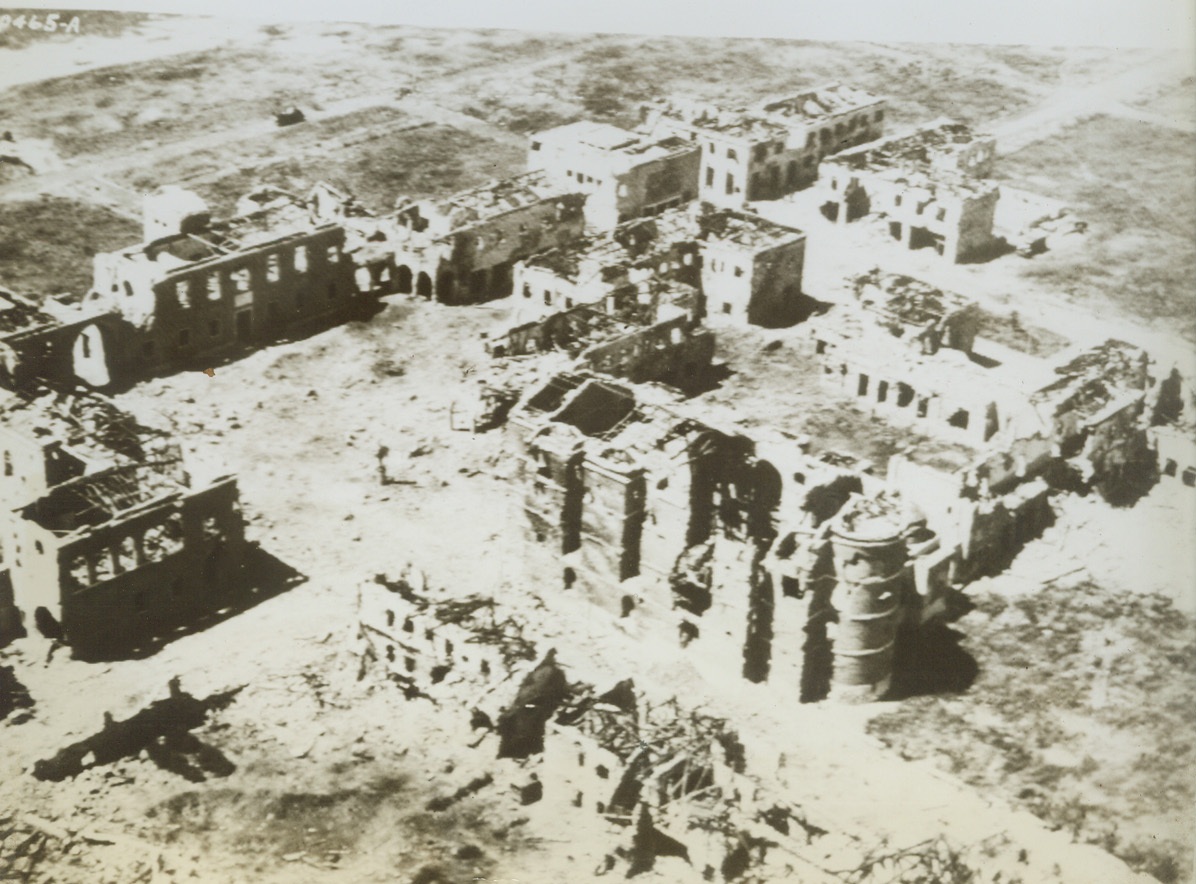
The Scars of Battle are Vivid, 6/2/1944. ITALY—Only gutted buildings remain in the Aprilla, Italy “factory” area where bitter fighting raged between the Allies and the Germans. An unforgettable landmark to the beachhead forces, this photo of the settlement was made from an observation plane. Credit: U.S. ARMY RADIOTELEPHOTO FROM ACME.;
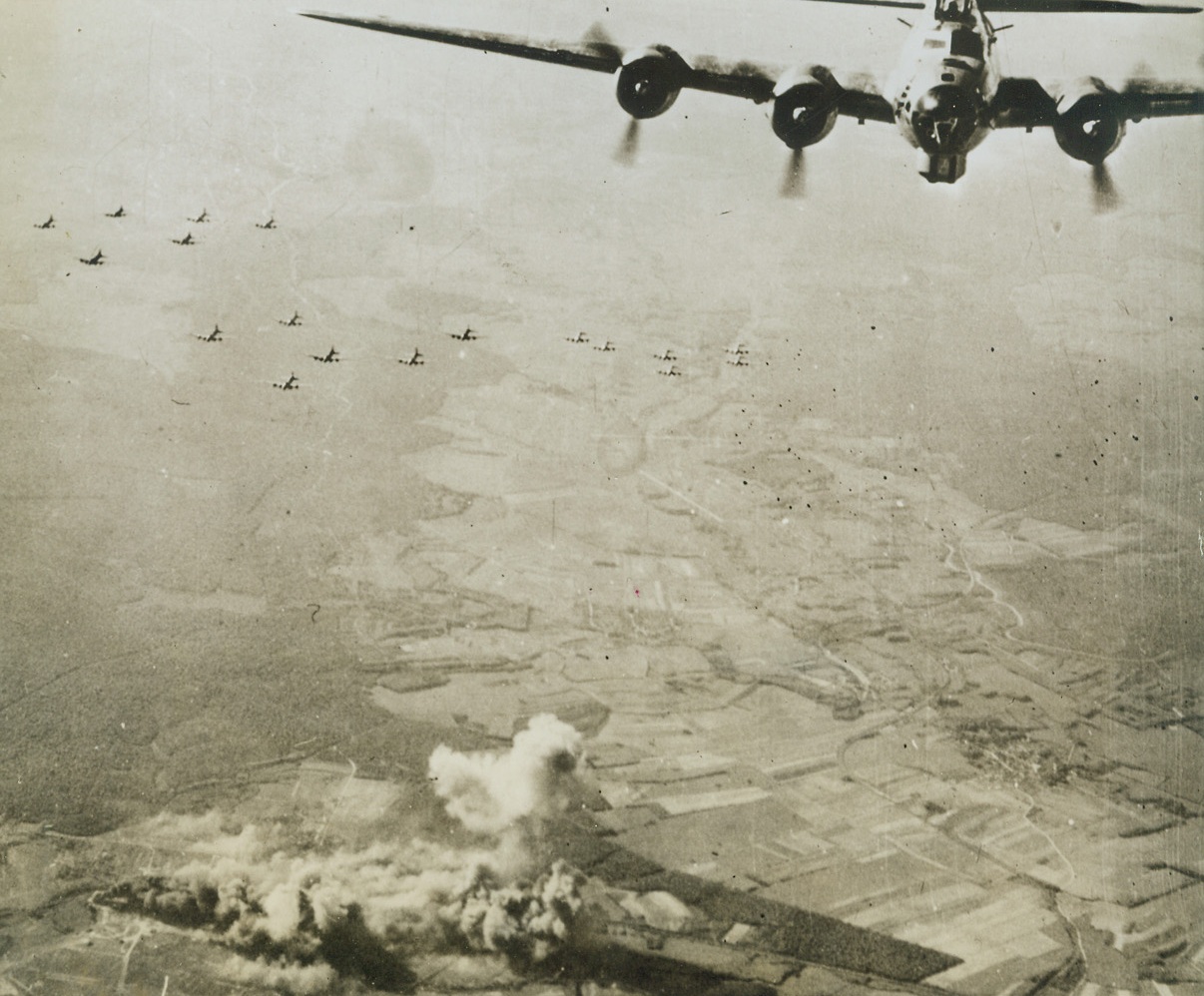
Nazi Airfield Blasted, 6/2/1944. FRANCE—Flying Fortresses of the U.S. Army 8th Air Force head for home, leaving the Nazi airfield at St. Dizier, near Reims, burning. Hits were registered on hangars and fuel storage sheds. Today our air forces continued the pre-invasion pounding of the invasion coast in attacks on Northern France, in Belgium and Holland. Credit: USAAF photo from ACME.;
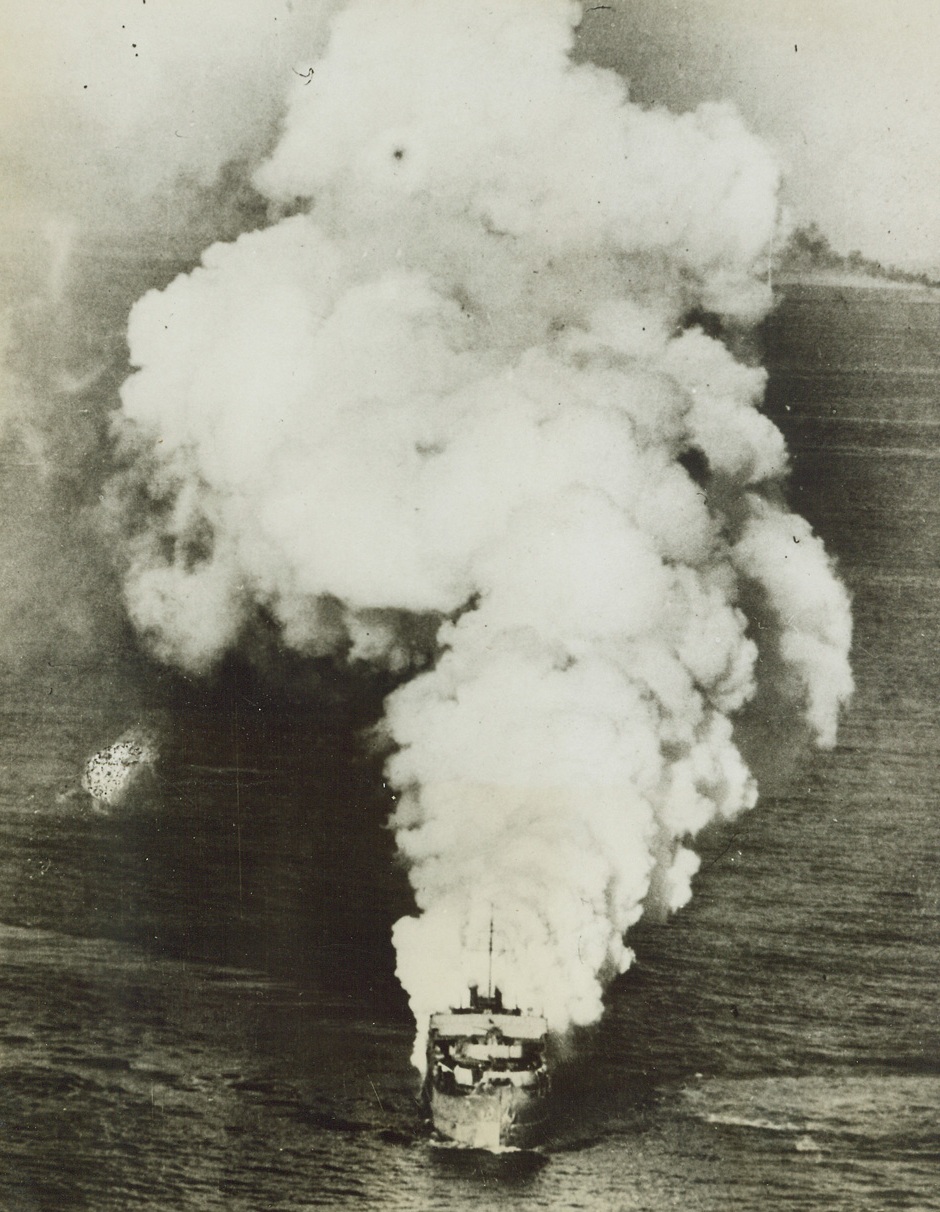
A Kill for Rocket Beaufighters, 6/27/1944. An armed merchantman, part of a large German convoy in the Aegean Sea, burns furiously from stem to stern after being blasted by rocket-carrying Beaufighters of the RAF, recently. This new RAF weapon has been used very effectively against enemy shipping and this is one of the first photos of its use against German surface craft. Credit: BRITISH OFFICIAL PHOTO FROM ACME.;

Work of Nazi Arsonists, 6/30/1944. COPENHAGEN, DENMARK—Flames lick at the buildings of the world-renowned Tivoli Amusement Park in Copenhagen, which was set afire by the Nazi Schalburg Corps on Friday night (June 23rd). The concert house is in foreground. This EXCLUSIVE ACME photo, obtained through the Free Danish Press Service, was radioed to New York, June 30th, 1944. Credit: ACME RADIOPHOTO.;

Americans All, 6/1/1944. ITALY—Japanese-American infantrymen of a Fifth Army Division move up to the front to tackle another town on the road to Rome. These Japanese, Americans all, have played a notable role in the spectacular offensive in Italy. Credit: U.S. ARMY RADIOTELEPHOTO FROM ACME.;
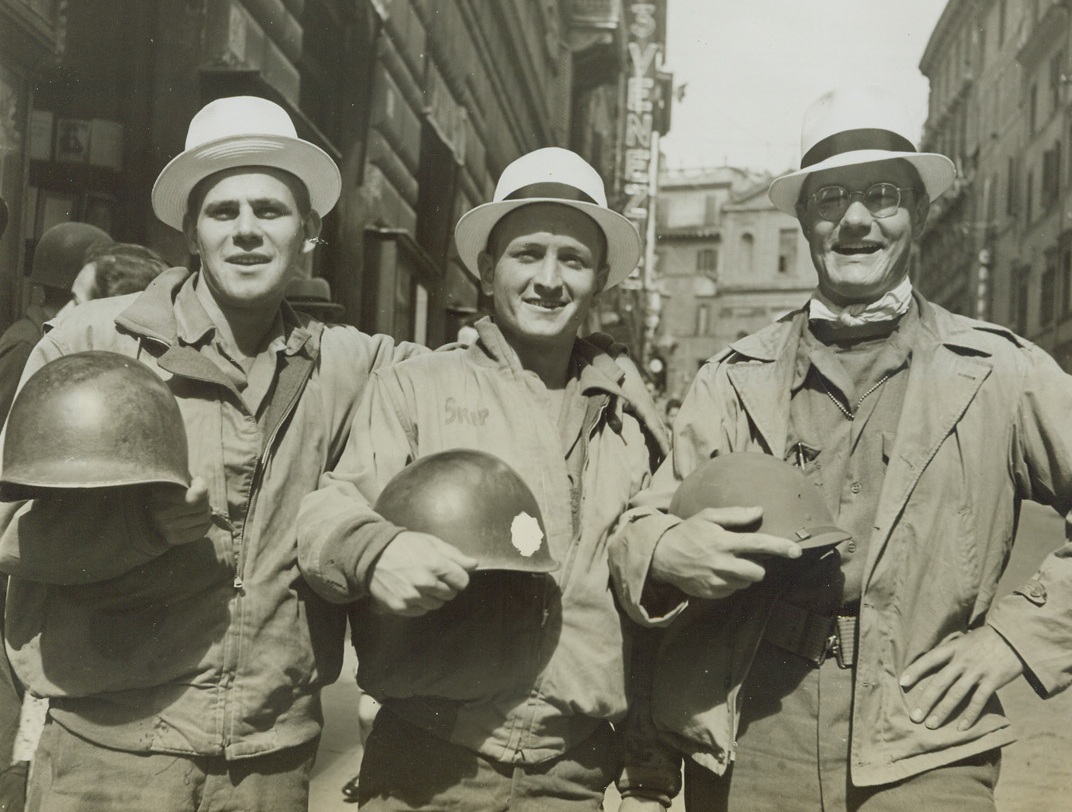
SPRING HATS FOR G.I.’S, 6/13/1944. ROME, ITALY—Carting their tin helmets in true Gay Nineties style, Pfc. Albert Roblewski, Bronx, N.Y. (left); Pfc. Rudy Valek, Allentown, Pa. (center); and Cpl. Philip Smith, York, Pa. don the summer Panama hats they bought in Rome. Very nice, boys, but what would your C.O. say?Credit: Acme photo by Charles Seawood, War Pool Correspondent;
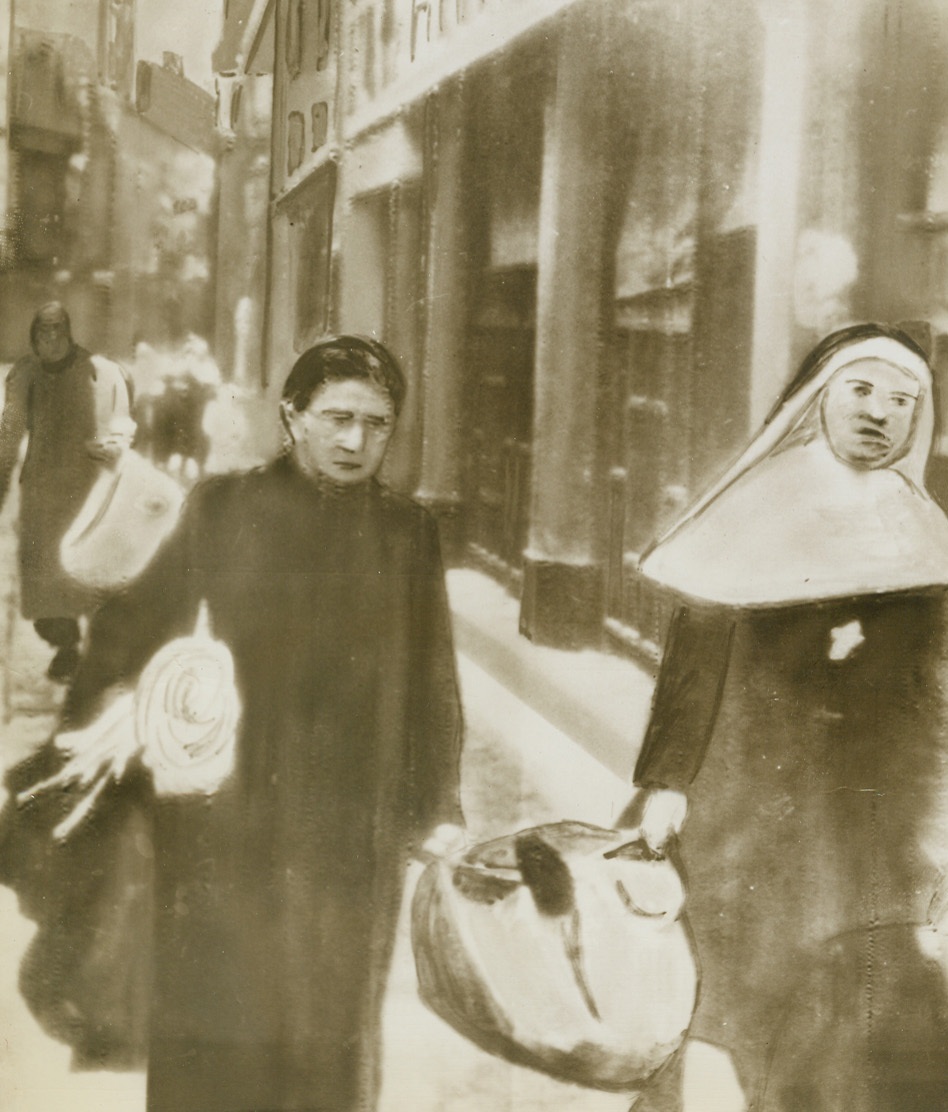
REFUGEES FLEE FROM INVASION, 6/13/1944. STOCKHOLM—The German caption accompanying this photo, radioed from Stockholm today (June 13), states that these are refugees fleeing from the invasion. The locality of the photo was unidentified. It seems unbelievable that a member of a religious order should be fleeing in the direction of the country from which all religion had been driven.Credit: Acme Radiophoto;

ITALIANS CHEER IN SHADOW OF CHURCH, 6/5/1944. VATICAN CITY—Jubilant Italians, gathering before historic old St. Peter’s Cathedral in Vatican City, wave and cheer wildly as Allied troops move triumphantly through the streets of Rome. Photo was made from an Army vehicle, which was completely hemmed in by joyous throngs.;

“RHINO FERRY” FOR INVASION FORCES, 6/6/1944. The most difficult phase of the initial operation against the European Continent—that of bridging the last few hundred yards between vessels and the beach—is being accomplished to a large degree through the use of the U.S. Navy’s modern pontoon gear. Made up of hollow boxes of welded metal, in two sizes, a huge, self-propelled barge, called the “rhino ferry” can be put together aboard ship. When the objective is reached, sections of the raft can be lowered over the side, fastened into the whole with bolt, nuts, links, and angles. The, the “ferry” is ready to float vehicles and supplies ashore. The new style pontoons—or tanks—are built in two sizes, five by seven by five feet deep, and the other, seven by seven by five with one edge curved to serve as the prow of a barge. These rafts as a whole—or in sections—can be filled with water and used as piers or docks. Designed by Capt. John N. Laycock, Civil Engineer Corps, USN, Washing, D.C., these pontoons have been used previously in invasions of Attu, Africa, Sicily, and Italy. I this series of photos, the “rhino ferry” is shown being assembled and put to use. NEW YORK BUREAU Here, the “rhino ferry” gets under way after being assembled. Two powerful Chrysler marine outboard motors at either side of the stern, developing 143 horsepower each, can push the barge along at a little more than four knots. Having a draft less than LSTs, the “ferry” are ideal for the long, shallow beaches of Europe. Credit: U.S. Navy photo from Acm;
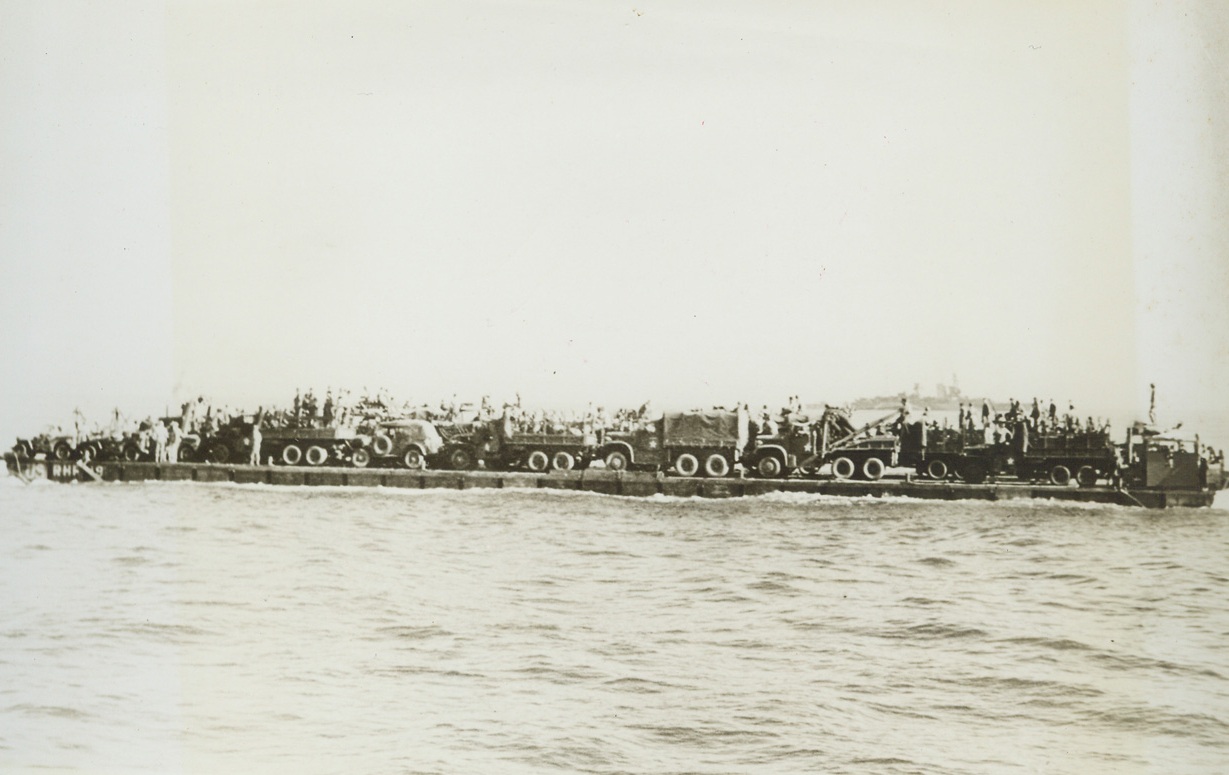
“RHINO FERRY” FOR INVASION FORCES, 6/6/1944. The most difficult phase of the initial operation against the European Continent—that of bridging the last few hundred yards between vessels and the beach—is being accomplished to a large degree through the use of the U.S. Navy’s modern pontoon gear. Made up of hollow boxes of welded metal, in two sizes, a huge, self-propelled barge, called the “rhino ferry” can be put together aboard ship. When the objective is reached, sections of the raft can be lowered over the side, fastened into the whole with bolt, nuts, links, and angles. The, the “ferry” is ready to float vehicles and supplies ashore. The new style pontoons—or tanks—are built in two sizes, five by seven by five feet deep, and the other, seven by seven by five with one edge curved to serve as the prow of a barge. These rafts as a whole—or in sections—can be filled with water and used as piers or docks. Designed by Capt. John N. Laycock, Civil Engineer Corps, USN, Washing, D.C., these pontoons have been used previously in invasions of Attu, Africa, Sicily, and Italy. I this series of photos, the “rhino ferry” is shown being assembled and put to use. NEW YORK BUREAU Loaded with motor vehicles, the “rhino ferry” heads for the beach from a transport. Credit: U.S. Navy photo from Acm;
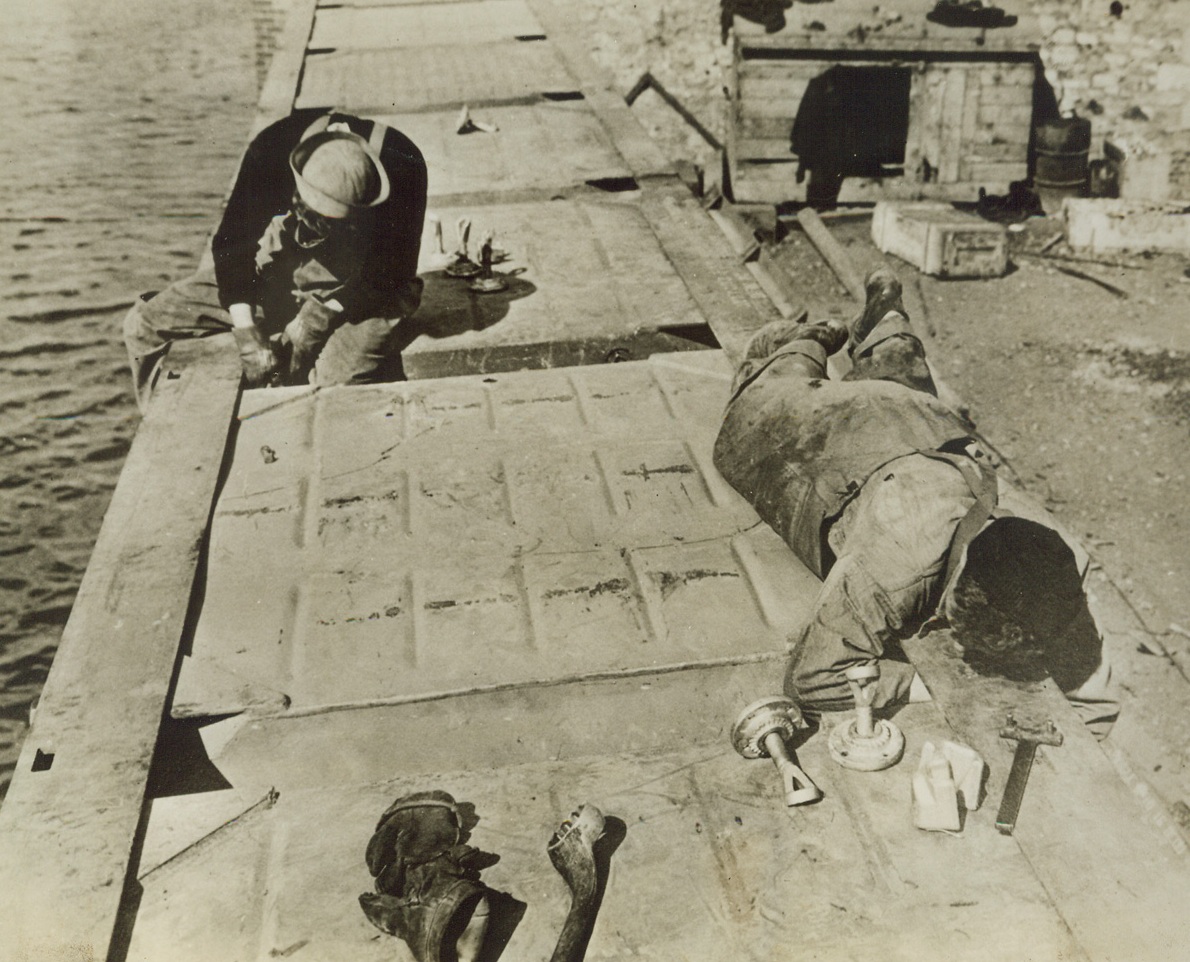
“RHINO FERRY” FOR INVASION FORCES, 6/6/1944. The most difficult phase of the initial operation against the European Continent—that of bridging the last few hundred yards between vessels and the beach—is being accomplished to a large degree through the use of the U.S. Navy’s modern pontoon gear. Made up of hollow boxes of welded metal, in two sizes, a huge, self-propelled barge, called the “rhino ferry” can be put together aboard ship. When the objective is reached, sections of the raft can be lowered over the side, fastened into the whole with bolt, nuts, links, and angles. The, the “ferry” is ready to float vehicles and supplies ashore. The new style pontoons—or tanks—are built in two sizes, five by seven by five feet deep, and the other, seven by seven by five with one edge curved to serve as the prow of a barge. These rafts as a whole—or in sections—can be filled with water and used as piers or docks. Designed by Capt. John N. Laycock, Civil Engineer Corps, USN, Washing, D.C., these pontoons have been used previously in invasions of Attu, Africa, Sicily, and Italy. I this series of photos, the “rhino ferry” is shown being assembled and put to use. NEW YORK BUREAU Here, two sailors join pontoons together to form the “ferry”. Seabees are given long hours of drill on this assembly until the process becomes almost second nature to them. Credit: U.S. Navy photo from Acm;
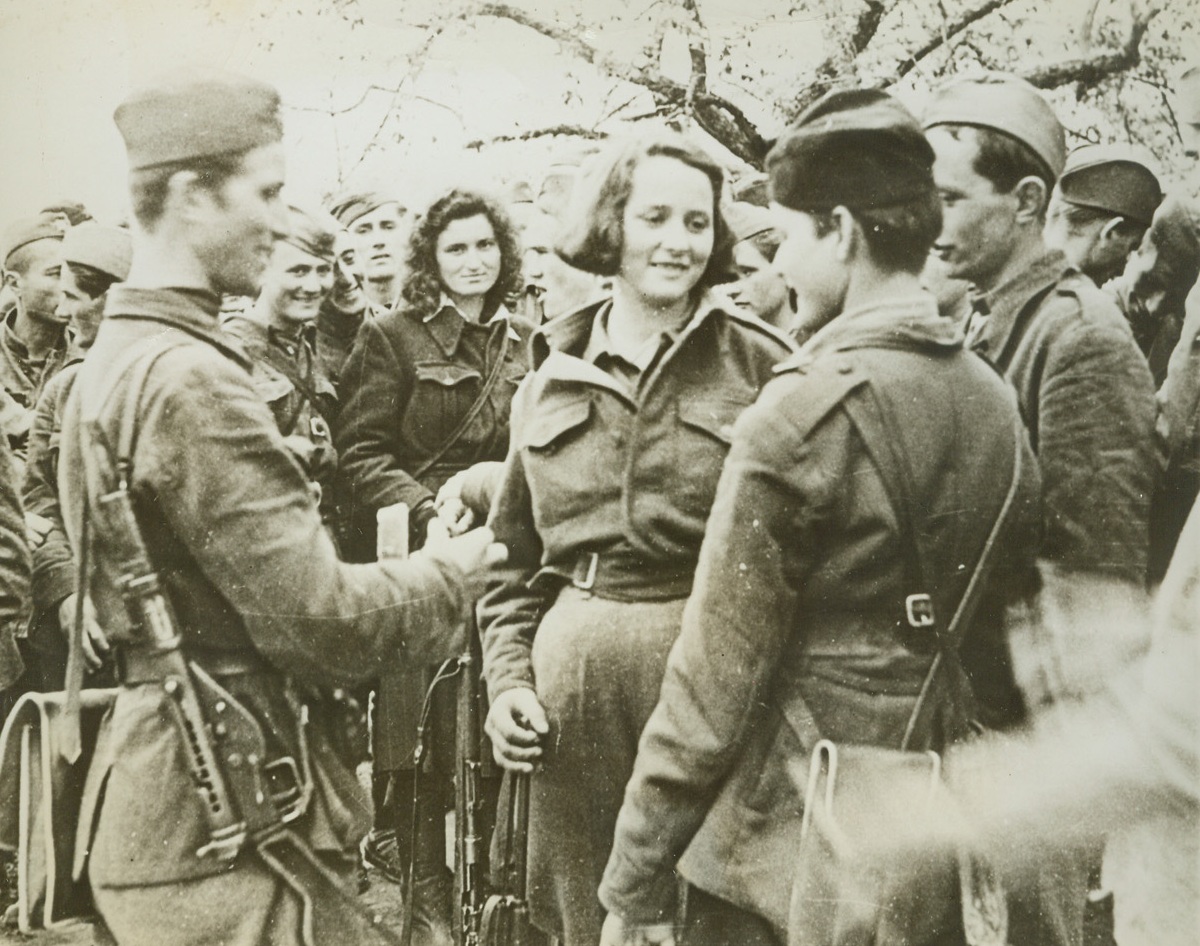
THE SPIRIT OF YUGOSLAVIA, 6/7/1944. YUGOSLAVIA—The second Anti-Fascist Youth Congress of Marshal Tito’s national army of liberation has just concluded and these delegates from the province of Montenegro prepare to make their return journey of about thirty days through enemy territory. It took them thirty days to reach the conference, battling the enemy most of the way. Leader of the party is a young girl, Stana Tomashevitch (center), 21, who has been fighting Nazis for three years, and has been wounded twice. On arrival she was made chairman of the congress. Before the war she was a school teacher and is now a member of the parliament of Montenegro. Credit: Acme;
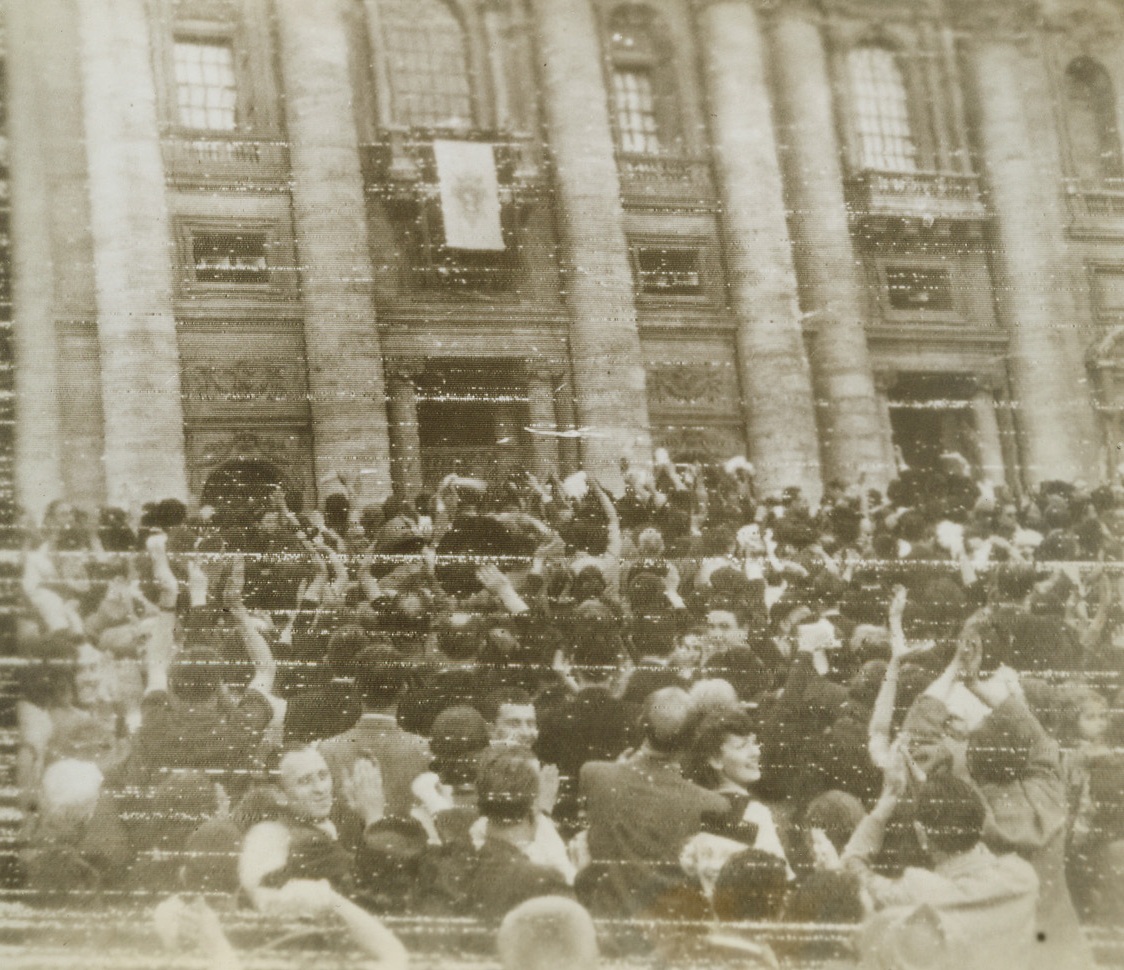
LIBERATED ROMANS GET POPE’S BLESSING, 6/7/1944. ROME—Wildly cheering crowd, celebrating the liberation of Rome from the Germans, gather in St. Peter’s Square to receive Papal blessing. The Pope can be seen on the flag bedecked balcony. Credit: OWI Radiophoto from Acme;
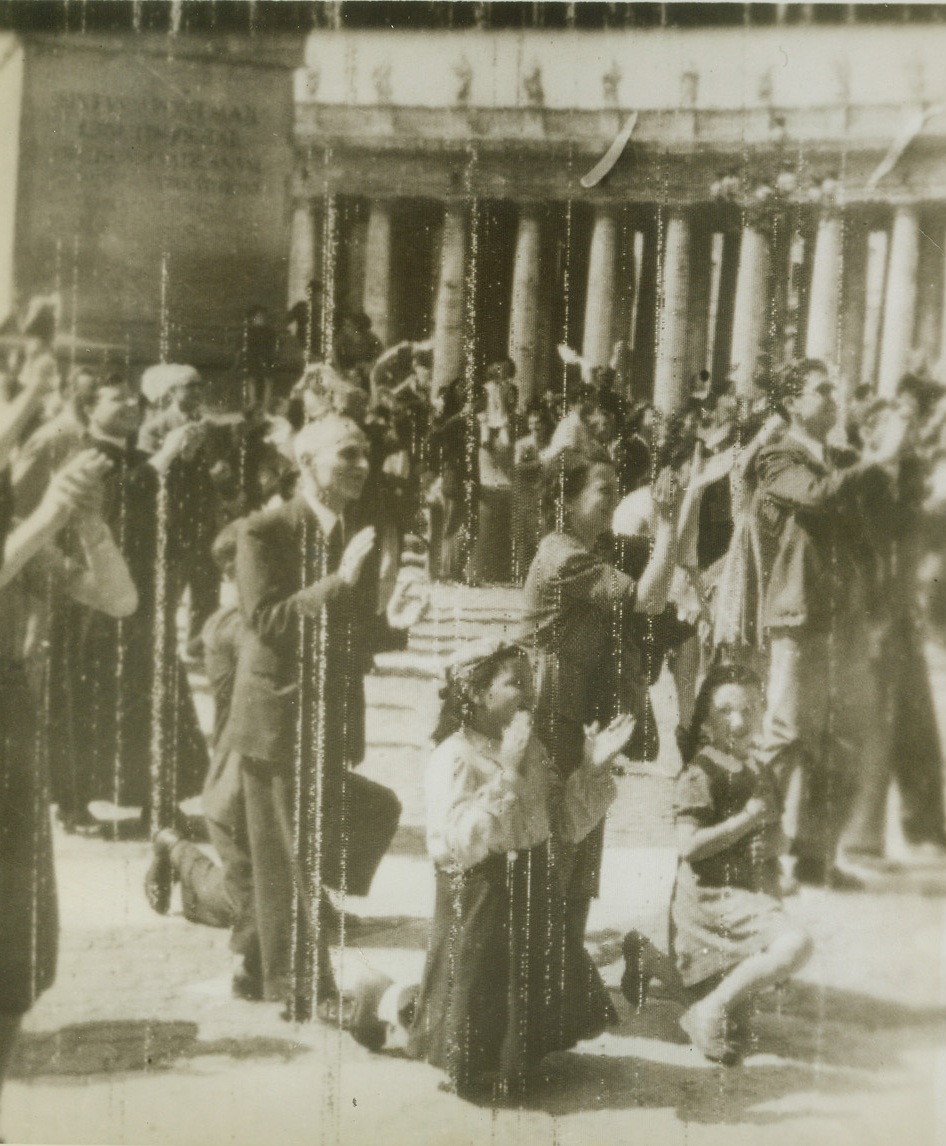
/ROMANS GIVE THANKS FOR LIBERATION, 6/7/1944. ROME—Hands clasped in prayer, these Romans give thanks for their liberation from Nazi overlords. They are crowded in St. Peter’s Square awaiting the Pope’s appearance to lead them in their thanksgiving. Credit: OWI Radiophoto from Acme;

CAPTURED NAZIS IN ITALY, 6/7/1944. ITALY—A group of German prisoners line up against a wall before being questioned. The Nazi soldiers were taken with the Allied occupation of the Italian town of Terracina. Credit: Acme;
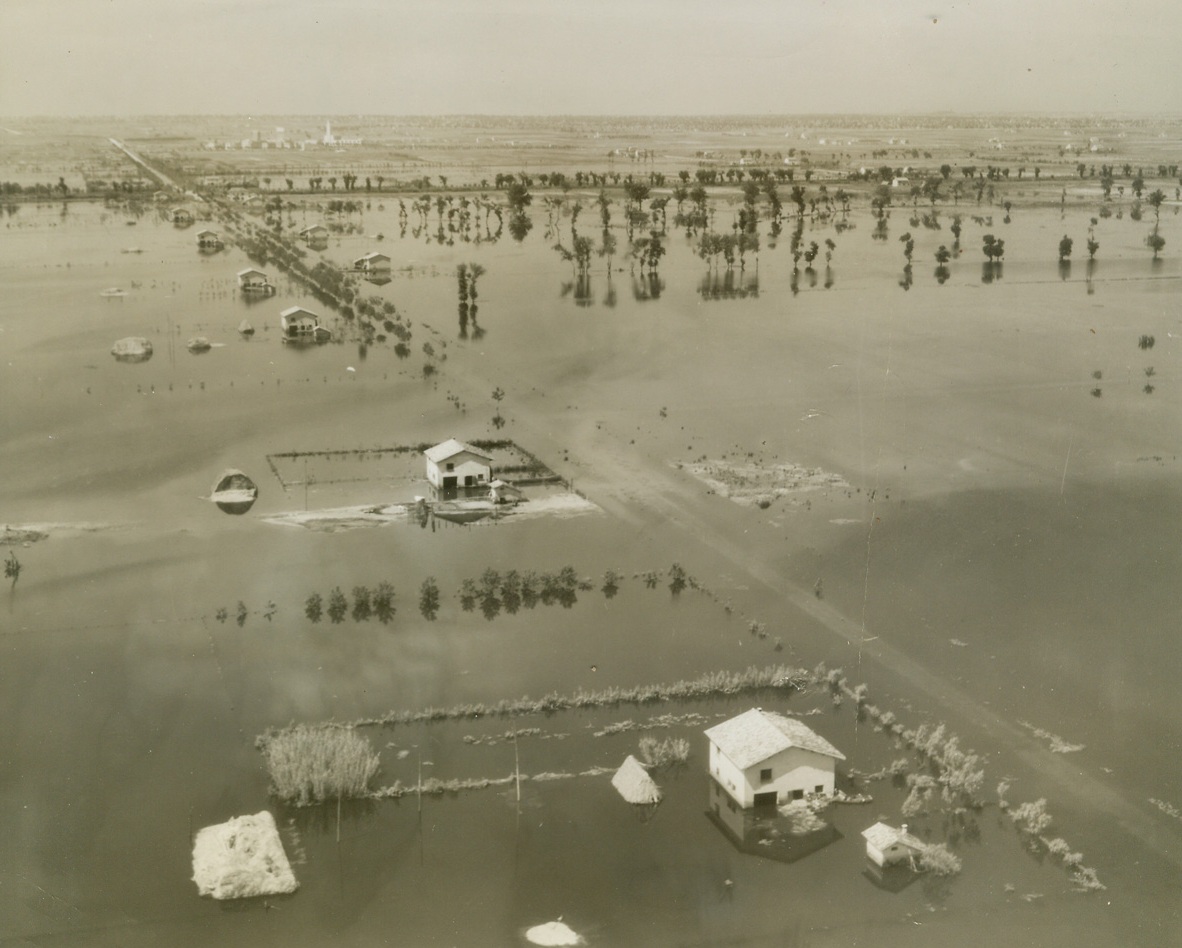
Where Fifth Army Marched Through Italy, 6/2/1944. ITALY -- Taken by Charles Seawood, Acme Newspictures War Pool Correspondent, these pictures show some of the towns, former battlefields, through which the Fifth Army has marched and fought in the current offensive in Italy. The Pontine Marshes, flooded by the Germans in an attempt to impede the Allied march, are also seen in photos which were taken from an artillery observation plane. New York Bureau The Pontine Marshes, flooded by the enemy in an attempt to impede the Allied offensive, stretch to the horizon in this photo. Partially submerged Italian farms dot the line where a road once was. This photo is the original of a radiophoto previously serviced. Credit - WP - (ACME Photo by Charles Seawood, War Pool Correspondent);
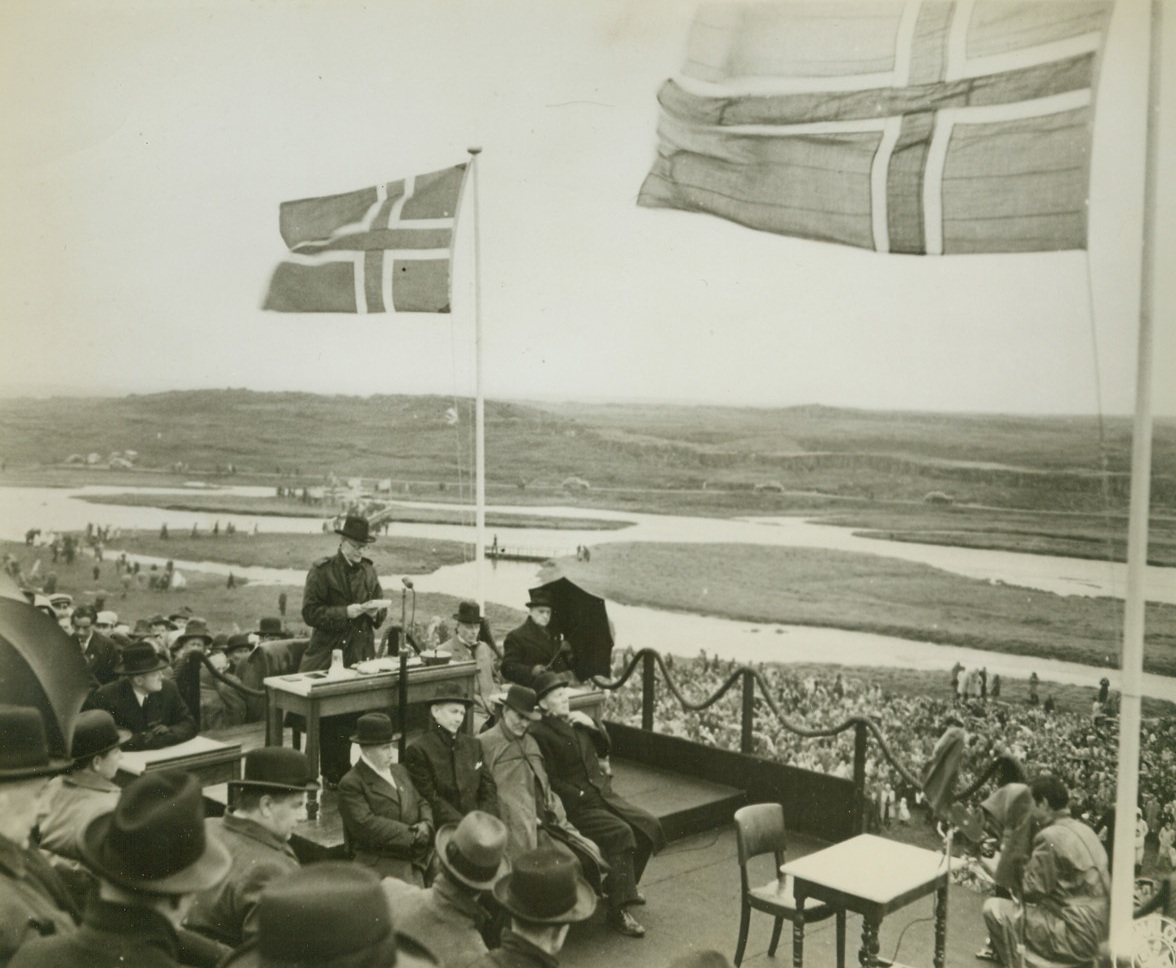
Proclaims Iceland a Republic, 6/27/1944. REYKJAVIK, ICELAND – A tribute to the wisdom of the people of Iceland, was the complete change of the status of their nation to an independent republic, recently. In solemn ceremonies in the open air held on the Parliament Plains (the Thingvellir), Iceland’s thousand-year-old Althing (Parliament) passed the law making the change, after it has been demanded by Icelanders. Here, (standing, left), Gisli Sveinsson (CQ), speaker of the combined houses of Althing, proclaims the Republic formally established and the new constitution effective.Credit: (U.S. Signal Corps Photo from ACME);
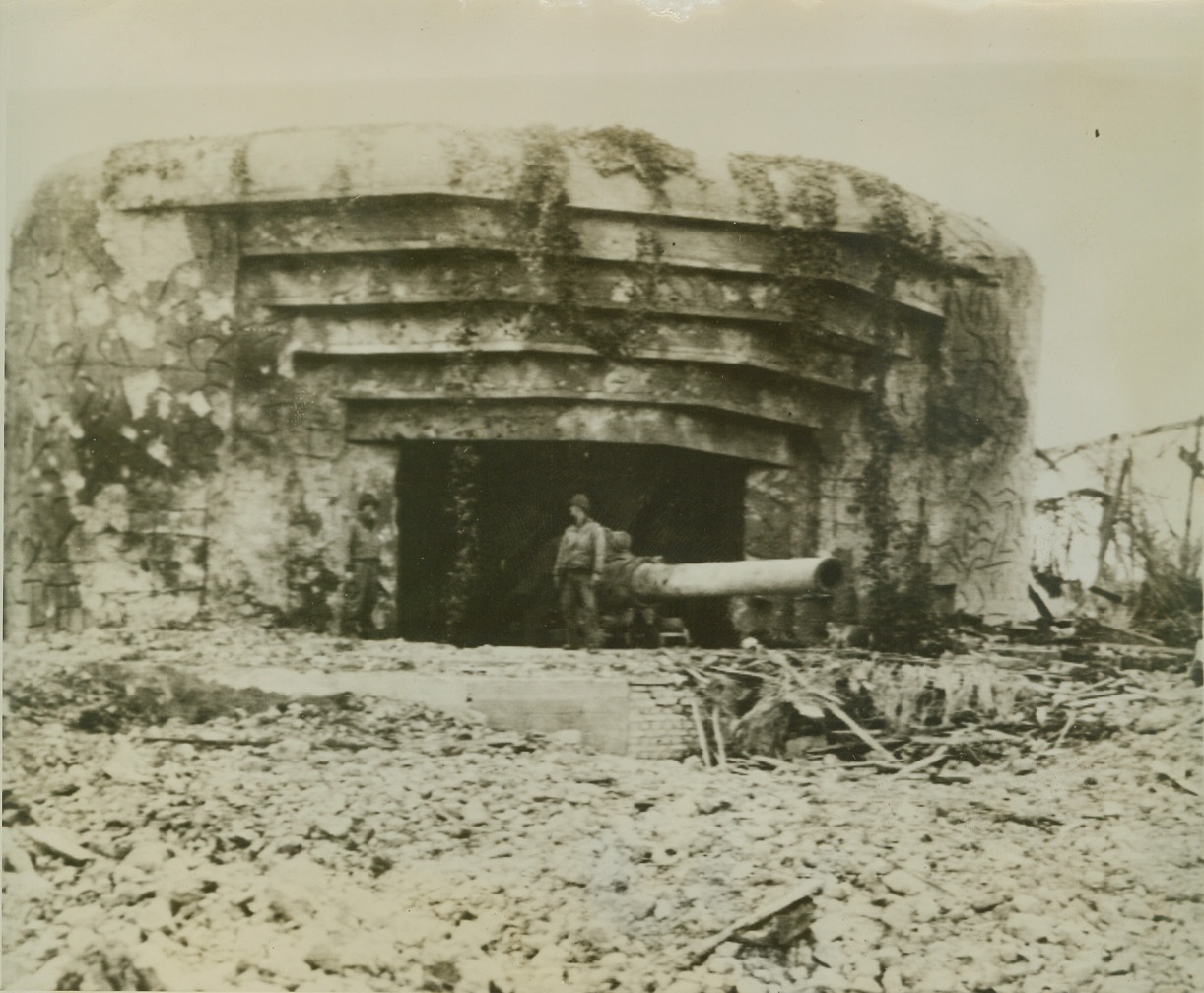
The Gun that Failed, 6/18/1944. SOMEWHERE IN FRANCE -- This oversized German naval gun, planted on the Channel coast of France, was one of many that failed in their jobs of protecting the Cherbourg peninsula from advancing Allied forces. The defensive gun was quickly put out of commission by naval and artillery fire. Credit (ACME Photo via U.S. Signal Corps Radiotelephoto);
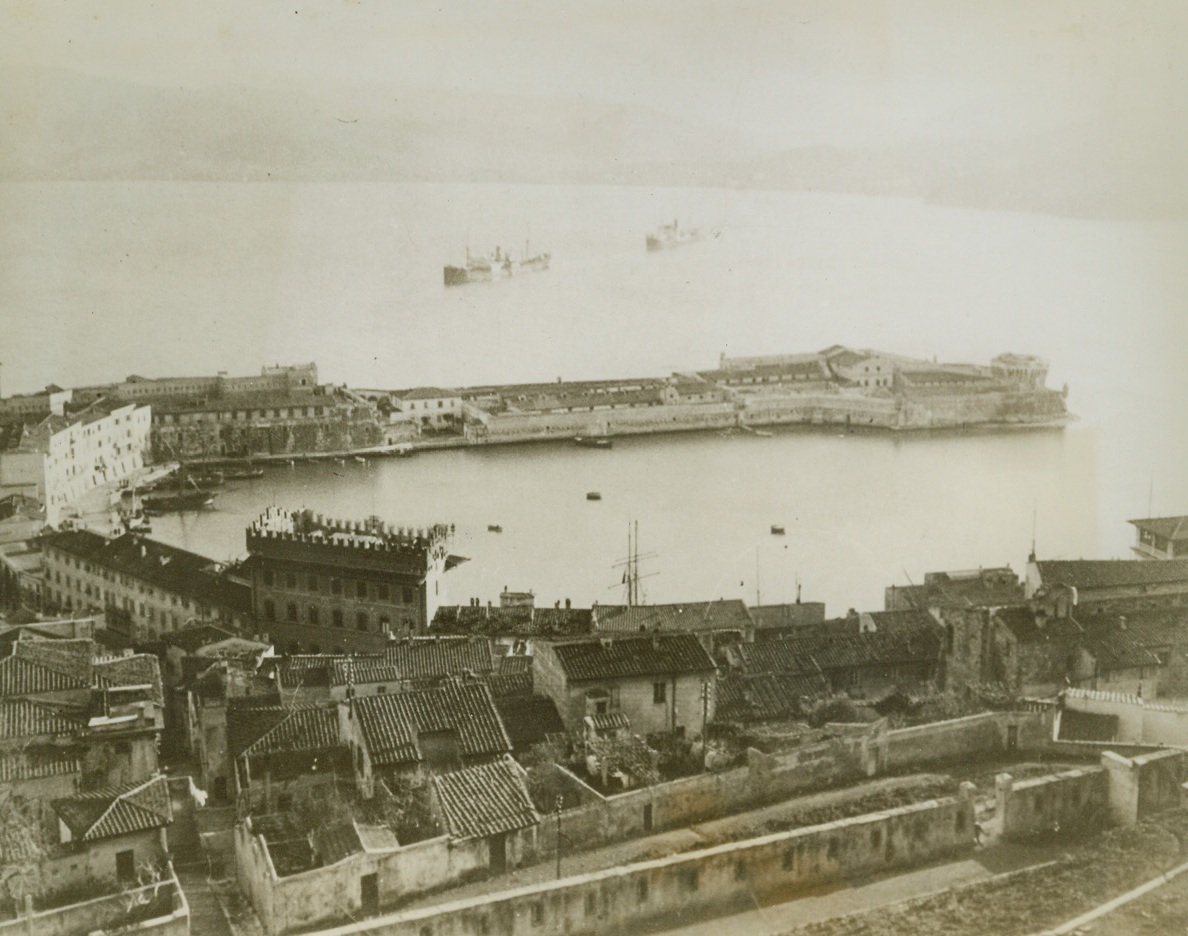
French Gain on Elba, 6/19/1944. ELBA, ITALY – Overcoming stiff German resistance, French troops have made “substantial” progress in their march through the German-held island of Elba, off the Italian coast. Porto Ferrairo, shown above, has already been occupied. This town, an iron port, had been worked steadily to satisfy armament needs. Endowed with a natural harbor, its capture will simplify the task of reinforcing the battling troops on the island.Credit Line (Acme);
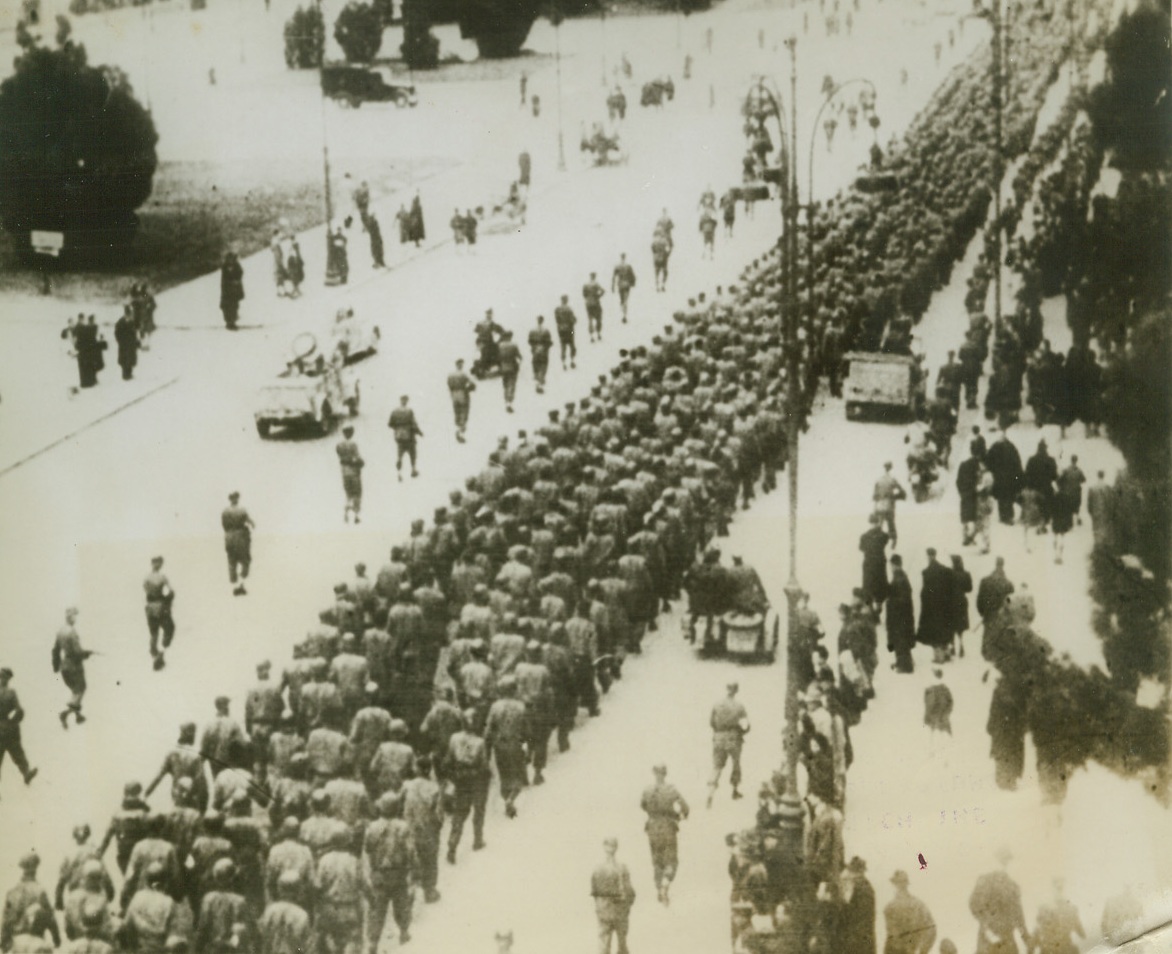
Allied Prisoners in Rome, 6/19/1944. ROME, ITALY – This group of marching men, according to the German newsreel from which the picture was taken, are Allied soldiers, captured in the fighting in Italy, being marched thru Rome en route to a German prison camp. These boys may still be prisoners, but the Germans no longer occupy Rome.Credit Line (Acme);
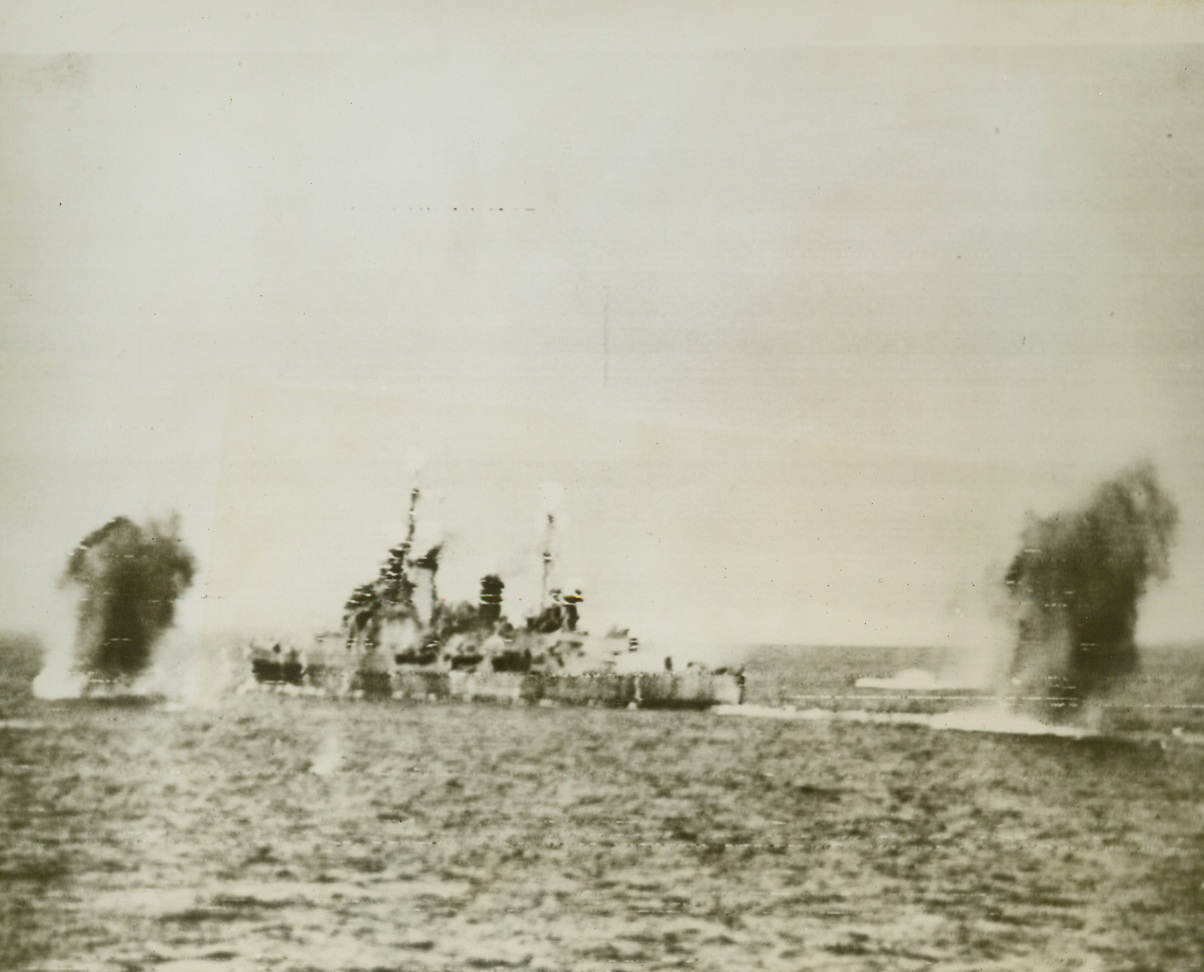
Bad Shots, 6/26/1944. WASHINGTON, D.C. – While US and British warships bombarded Cherbourg as American troops stormed it from the land side, German shore batteries fire at HMS Glasgow, in an attempt to stop the attack from the sea. Latest reports state there is still street fighting in progress in the key port. Credit (Signal Corps Radiotelephoto from Acme);
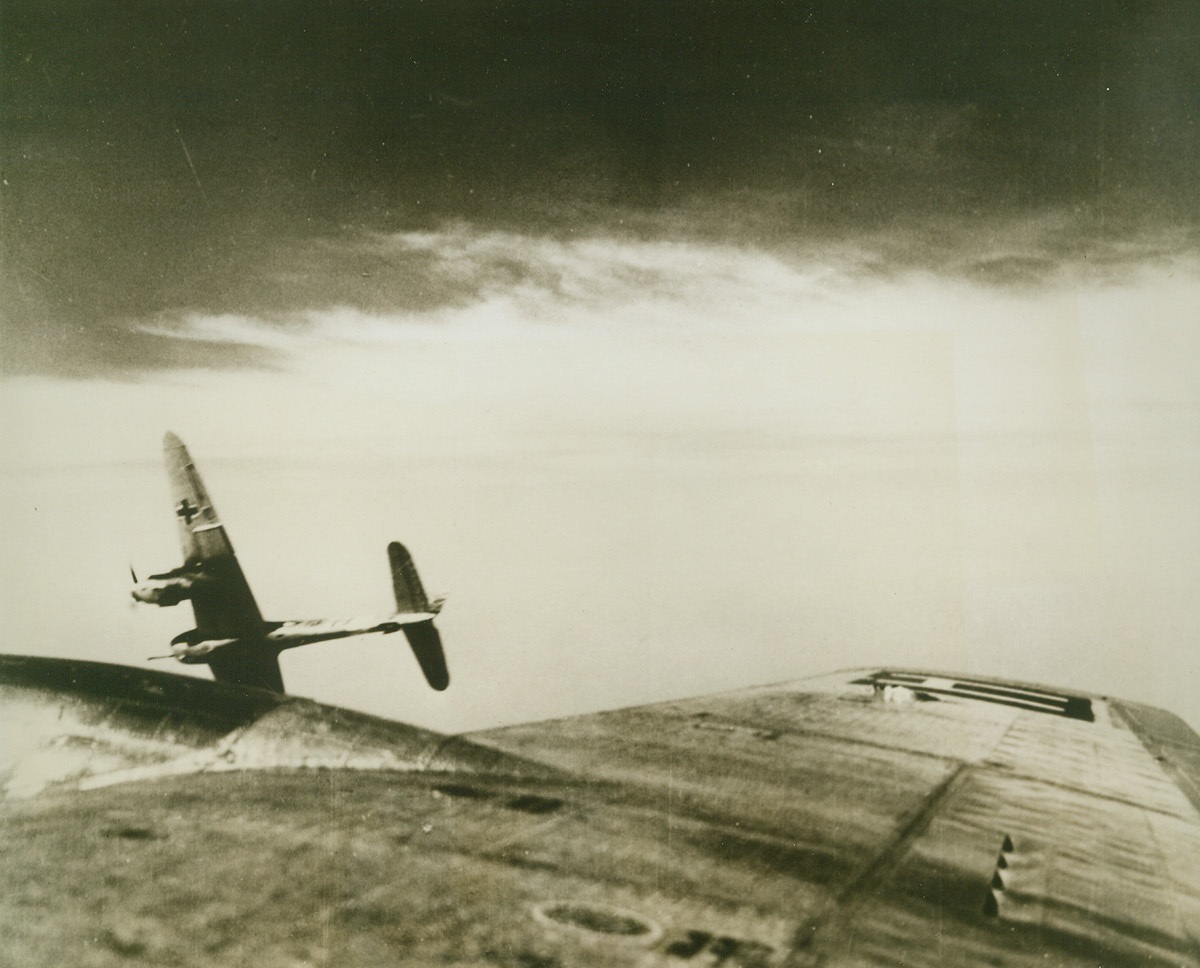
Nazi Messerschmitt Takes a Dive, 6/17/1944. Not many pictures like this one come out of the war. You are looking out of an American Flying Fortress at a Nazi Messerschmitt less than 25 feet off the bomber’s wing, just as the fighter pulls away to start its dive. The photograph was taken by Sgt. Victor LaBruno, Jersey City, N.J., while he was flying as a combat aerial photographer during a U.S. Army 8th Air Force attack on the synthetic oil plants at Brux, near the border of Czechoslovakia. As more than 100 German fighters attacked the formation of Flying Fortresses, Sgt. LaBruno crouched in the radio room of the B-17 “Lady Godiva” and caught this unusually near shot of a Nazi fighter. In civilian life, Sgt. LaBruno was a photographer in New York City.Credit (USAAF Photo from Acme);
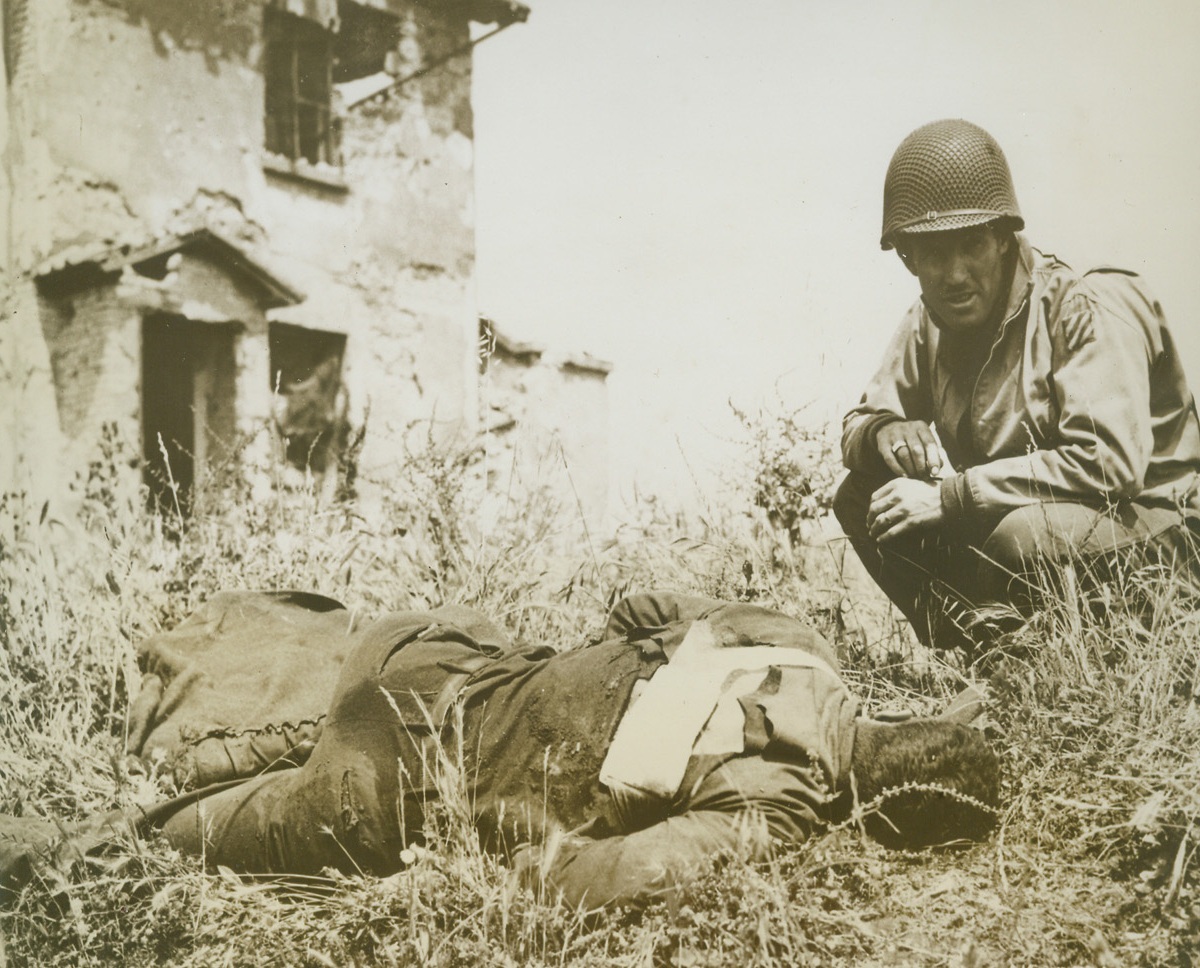
One Price for Rome’s Liberation, 6/14/1944. ITALY – The drive for the liberation of the Eternal City, which was accomplished June 4th, was costly to the Allies in men and material – but to the Nazis, it was the beginning of the end of their occupation of Italy, Now, they are fleeing to the north in disorderly retreat. Here, in a photo taken during the most violent part of the battle for Rome and released today in the U.S., a soldier of the U.S. Fifth Army, comforts a buddy badly wounded during the fighting in the Cisterna area.Credit Line (U.S. Signal Corps Photo from Acme);
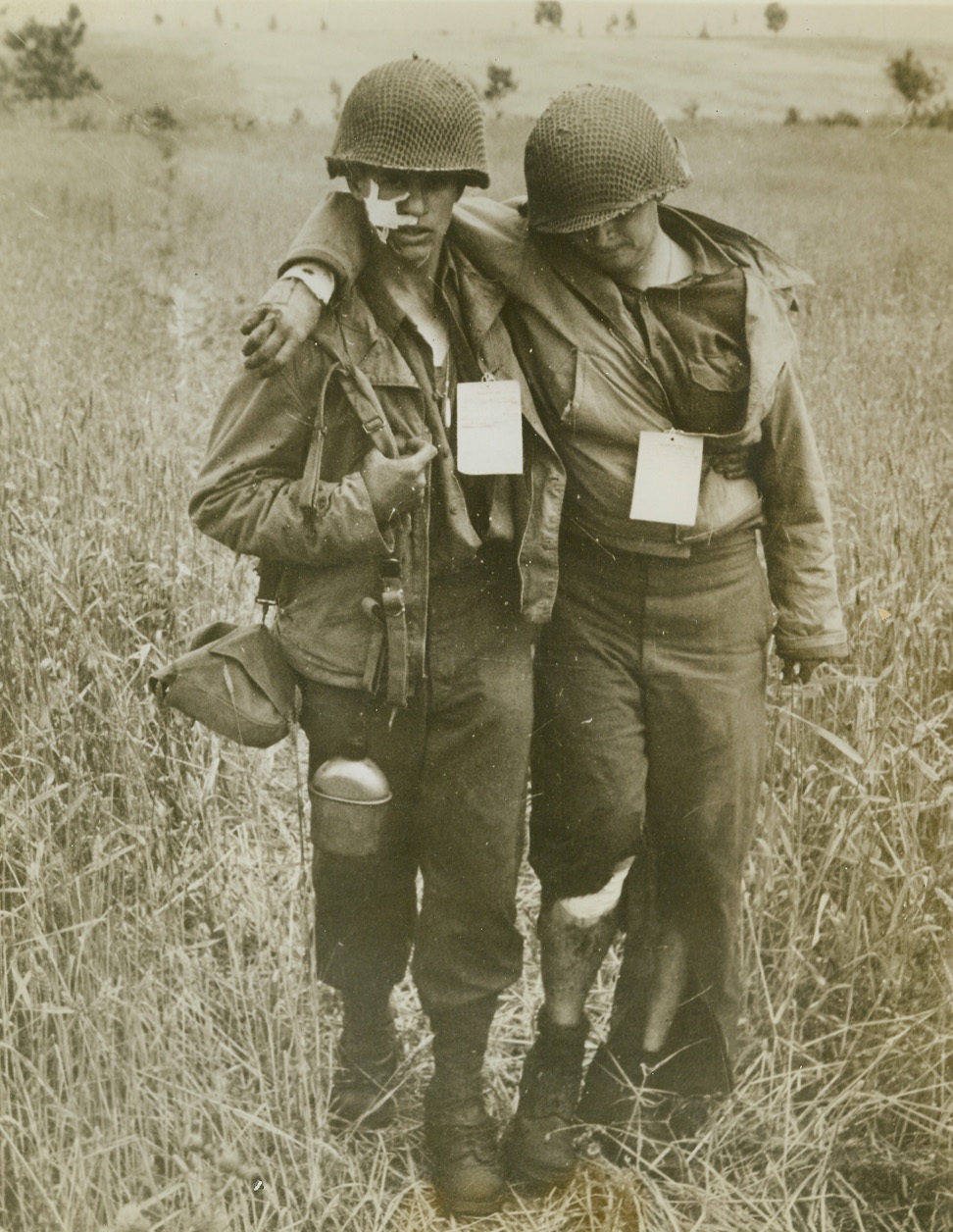
One Price for Rome’s Liberation, 6/14/1944. ITALY – The drive for the liberation of the Eternal City, which was accomplished June 4th, was costly to the Allies in men and material – but to the Nazis, it was the beginning of the end of their occupation of Italy, Now, they are fleeing to the north in disorderly retreat. In this photo, just released in the U.S., one wounded U.S. Fifth Army soldier, helps a buddy who is more seriously injured, to a hospital area in the rear. Credit Line (U.S. Signal Corps Photo from Acme);
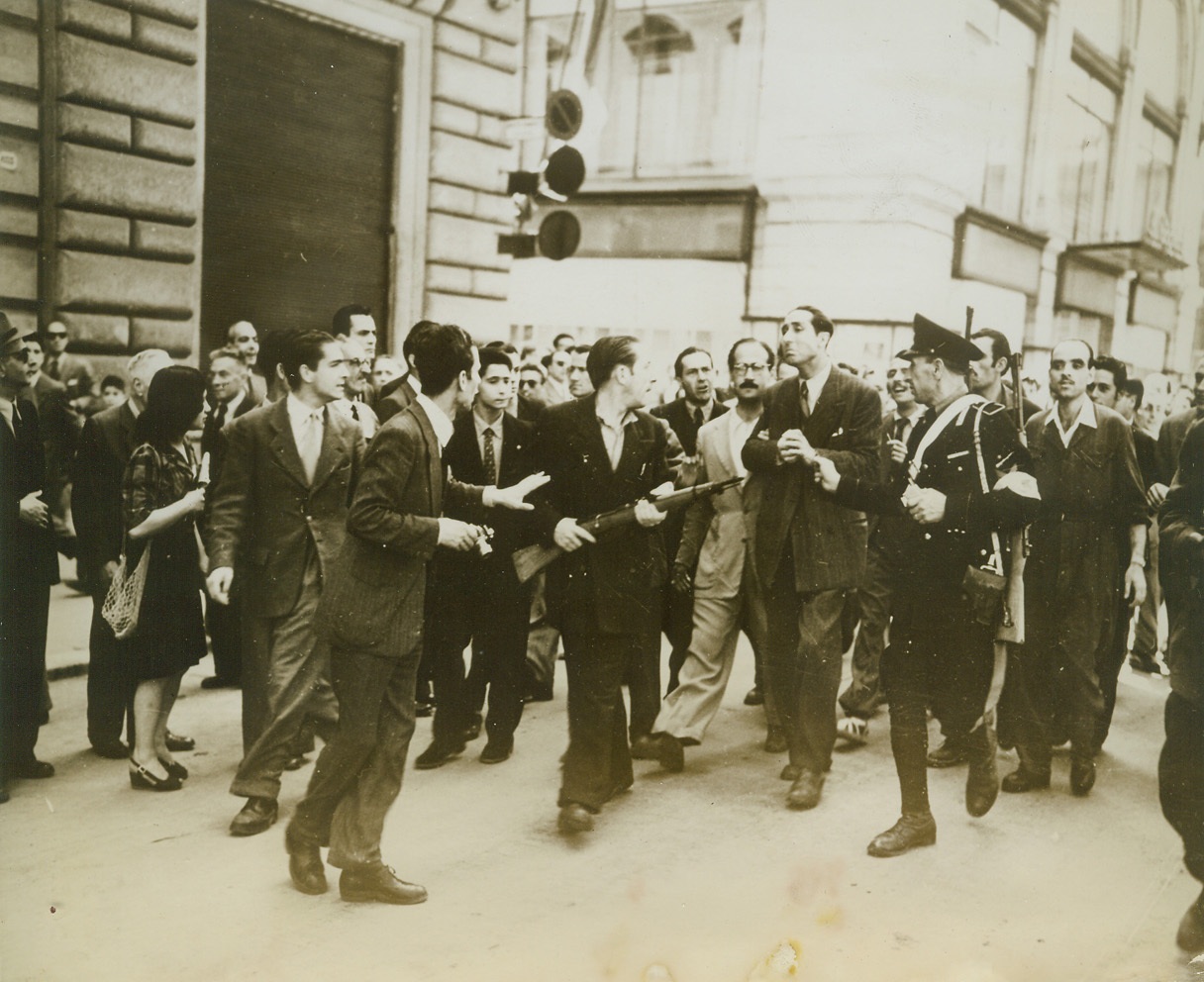
No Title. 6/15/1944.
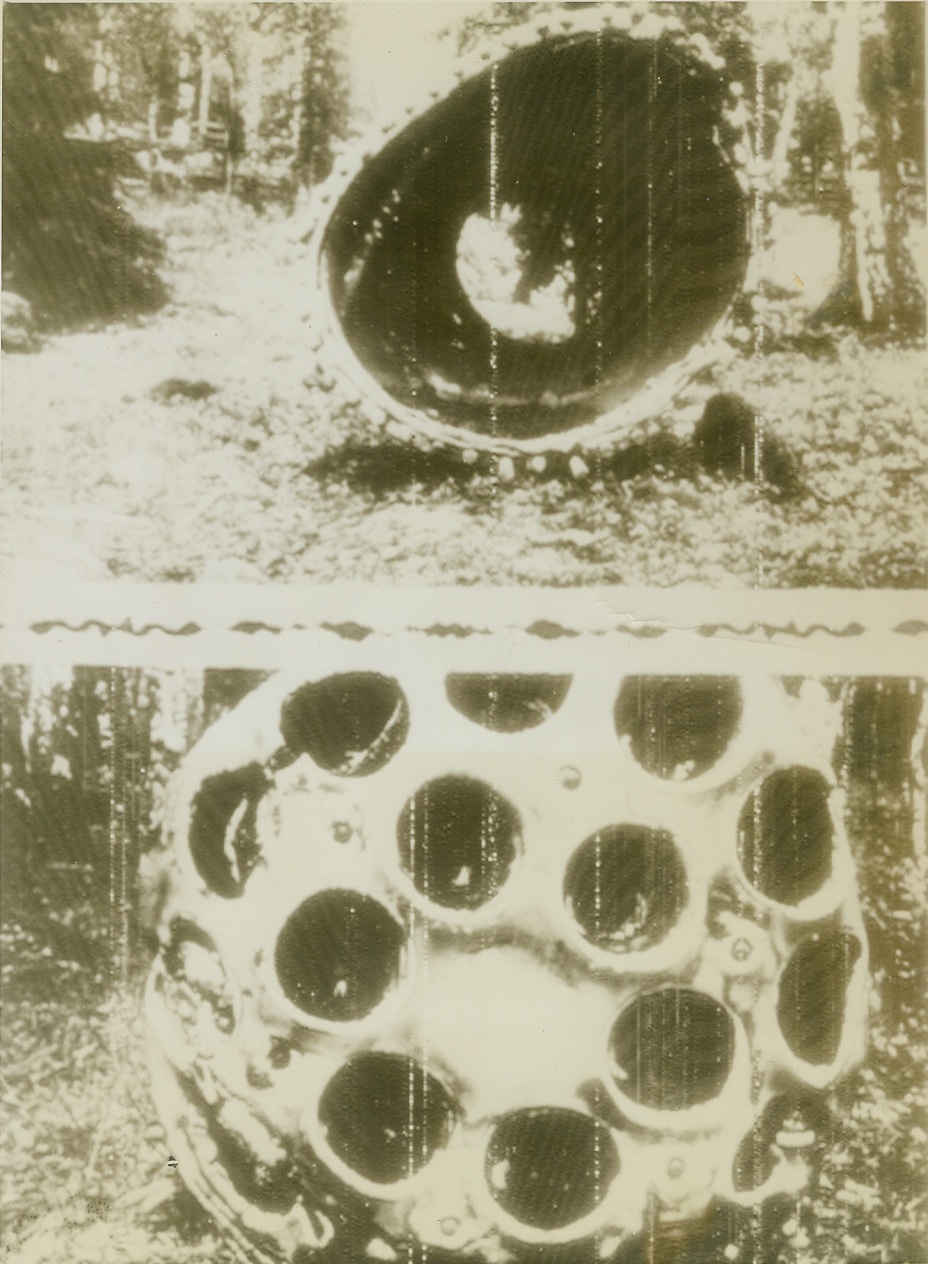
German Rocket Bomb Allegedly Attacks Sweden, 6/16/1944. The caption accompanying this photo, radioed today from Stockholm, identifies this Nazi secret weapon as a rocket bomb, apparently radio steered. In the photo of the tail assembly there are 18 holes, exhaust vents for the rocket gases that propelled the bomb. However, there is also evidence of a battery driven electric motor, suggesting that both methods of propulsion may have been used in the alleged attack on Kalmar, southern Sweden. Credit (Acme Radiophoto);
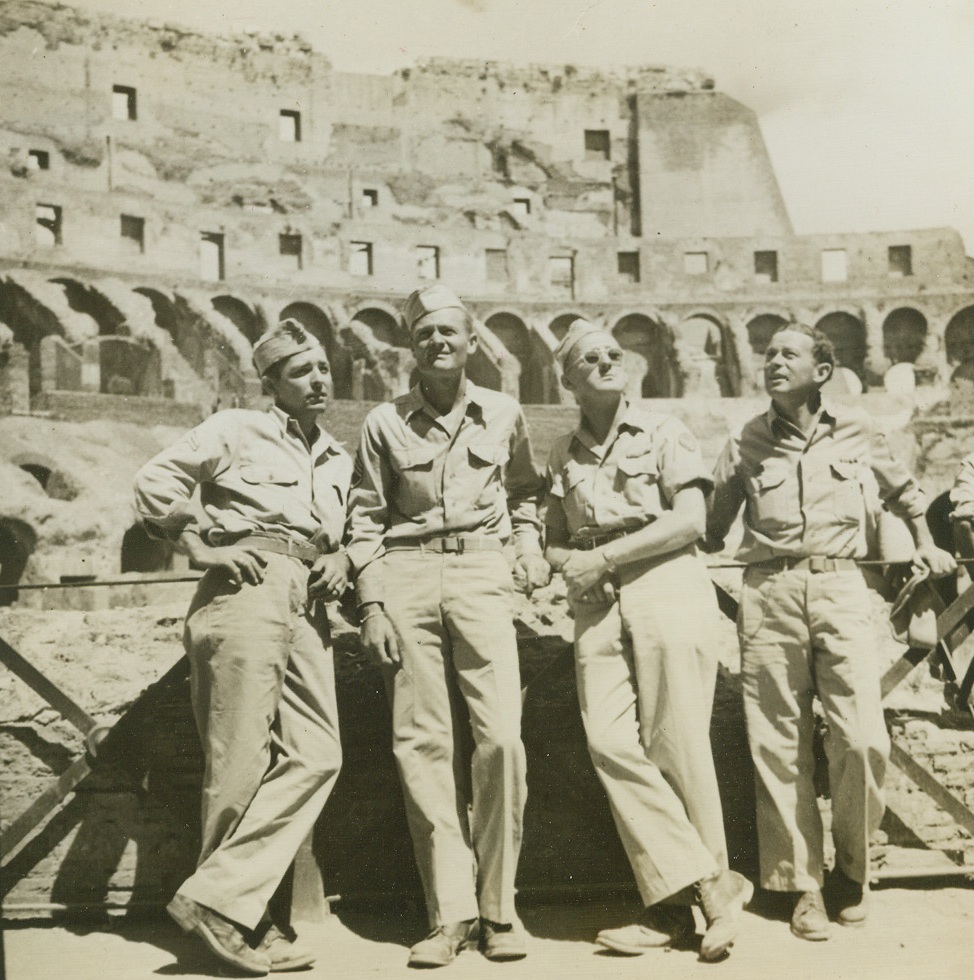
Get a Load of That!, 6/17/1944. ROME, ITALY – Relaxing after the hard fighting which preceded the Allied entry into Rome, these G.I.’s do a little sightseeing. Here they are getting an eyeful of the Coliseum in Rome, relic of the days of Caesar and Cicero. Left to right: Cpl. Randell Herman, Birthright, Tex.; S/Sgt. Marshall Veal, Oconee, Ga.; Pfc. Malcome Lawson, Clairmont, N.H., and Cpl. William D. Shore, Chicago, Ill. Credit (Acme) (WP);
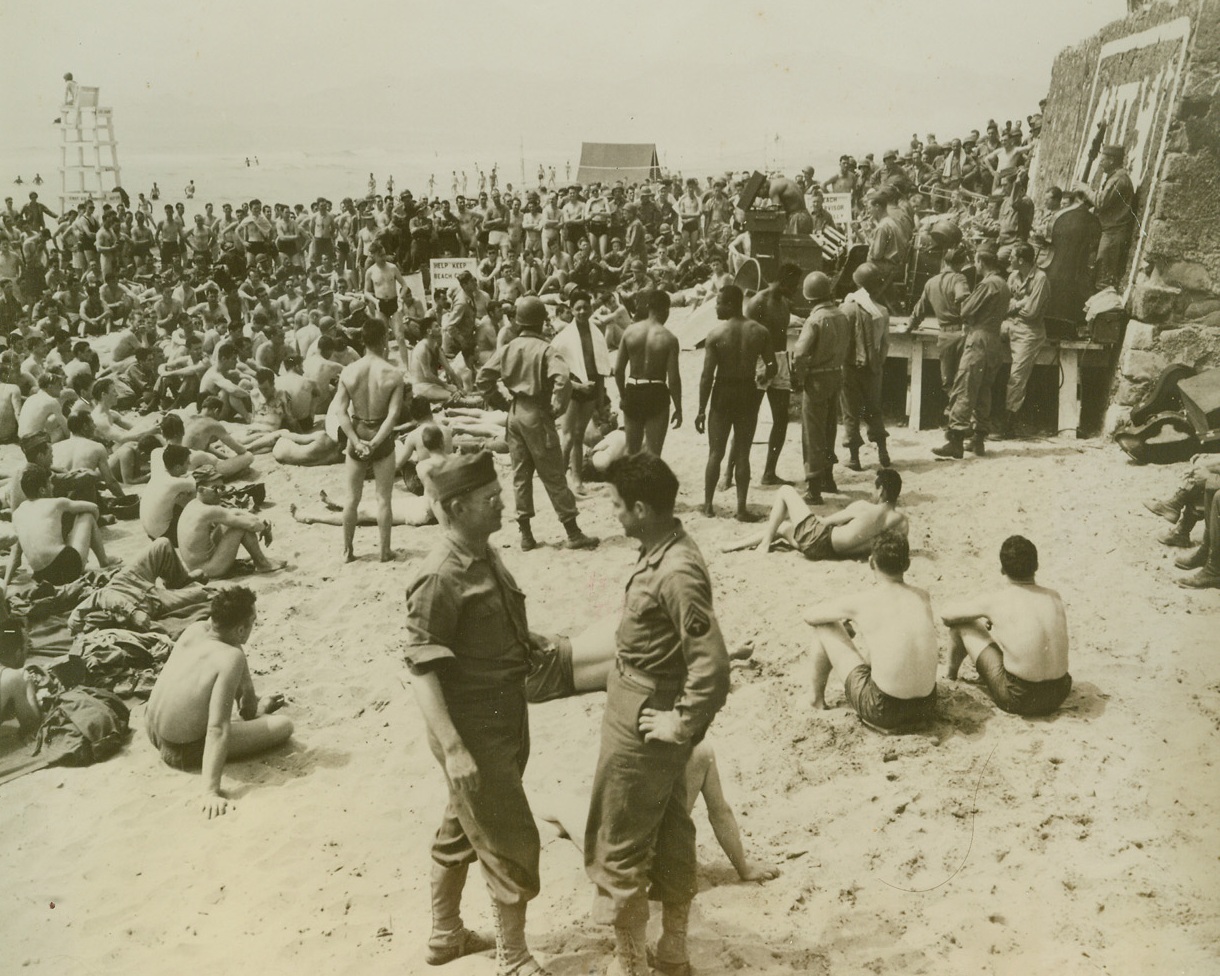
Coney Island in Italy, 6/16/1944. ITALY – In a scene similar to the one enacted with regularity at Coney Island, Yank troops of the Fifth Army get a touch of home as they lounge on a beach in Italy. A swing band plays for the boys on request and no regulations are placed on swimsuit style. Some come dressed G.I. and others in the oldest of bathing wear. New Yorkers, working in the their offices during the hottest days of the year, can look with envy at this beach scene. As a reminder that the war is still close at hand, note the screening smoke in the background.Credit Line (Signal Corps Photo from Acme);
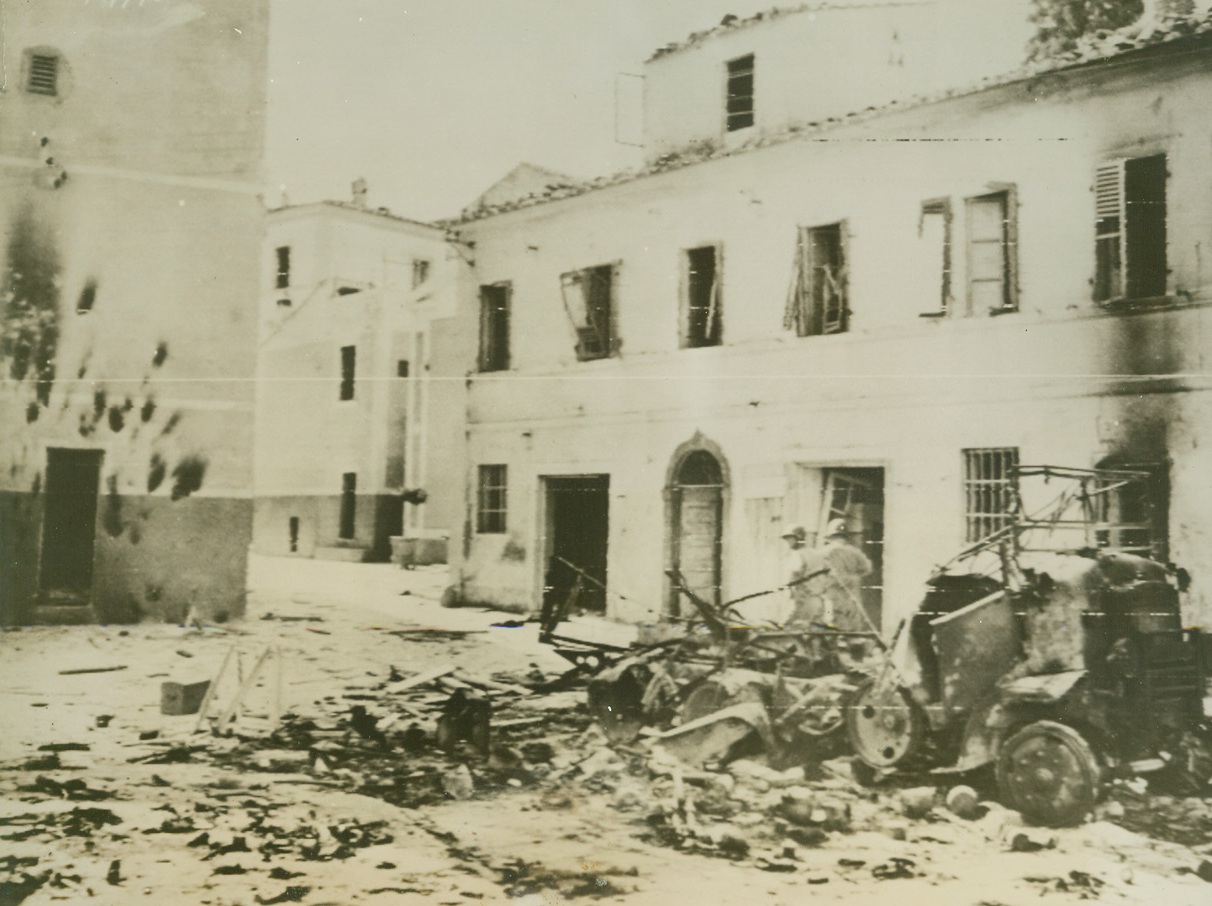
THE WAR REACHES ELBA, 6/20/1944. WASHINGTON, D.C.—Wrecked German vehicle attests to the destruction wrought by Naval rocket barrages in the town of Marina Di Campo, in Elba. 1,800 enemy troops were captured by French Colonials in the downfall of the island. Credit: Signal Corps Radio-Telephoto from Algiers via Acme;
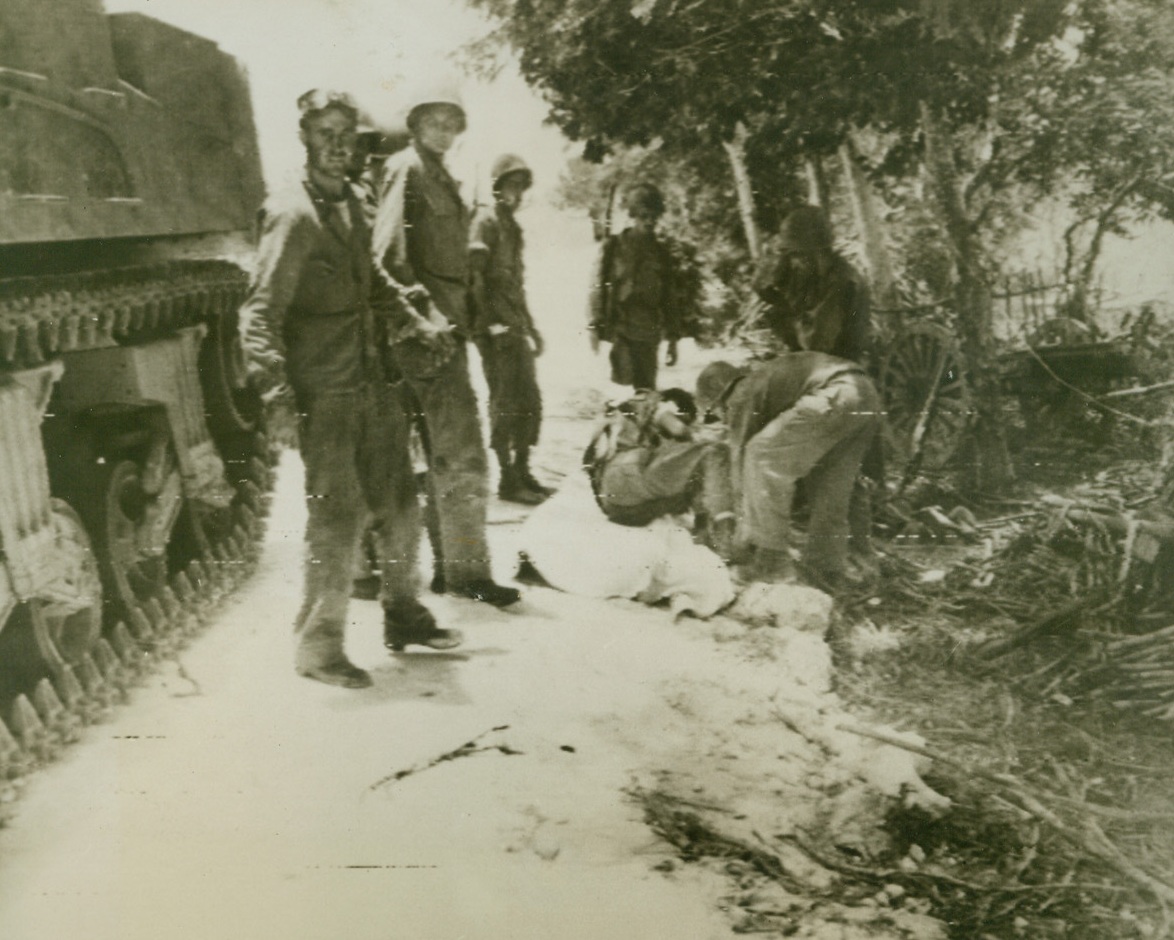
YANK CASUALTY ON SAIPAN, 6/24/1944. SAIPAN—An American casualty, wounded in an attempt to storm a Jap pillbox, is cared for by medical corpsmen on Saipan. American patrols have succeeded in penetrating to the capital city of the Japanese Marianas meeting almost no opposition along the way. Credit (Signal Corps Radiotelephoto from ACME);
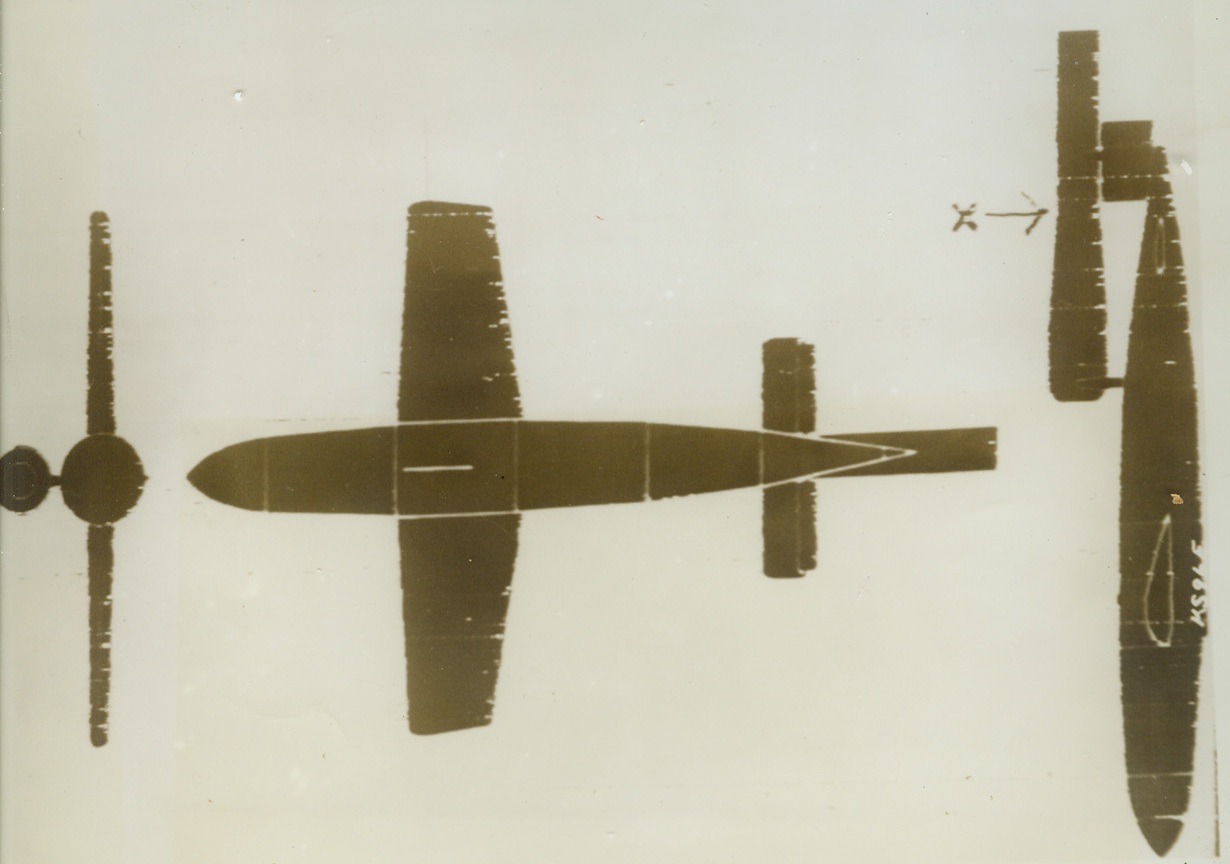
GERMAN PILOTLESS PLANE, 6/17/1944. This is a drawing of the German pilotless plane, which has a span of 16 feet and a length of 25 feet, 4 ½ inches. The section marked “X” in the third drawing is the propulsion unit. These aircraft have twice attacked southern England, with heavy death and destruction resulting. However, the second raid was much less intense than the first. Credit (British Official Photo Via Army Radiotelephoto from ACME);
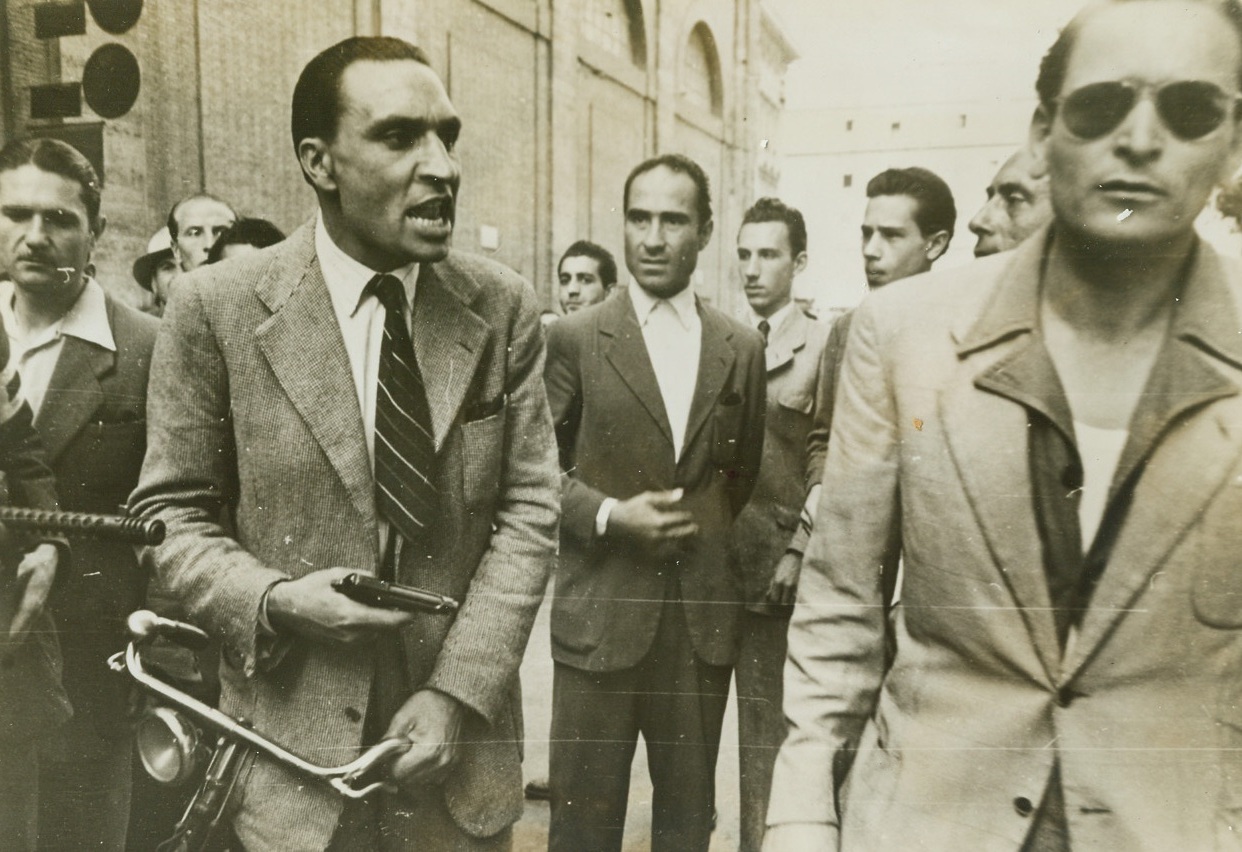
ANTI-FASCISTS HAVE THEIR DAY, 6/17/1944. ROME, ITALY—With the Allied entry of Rome, groups of rabid anti-fascists, who had long been forced underground, sprang from their hiding places, banded together and smoked out known fascists to bring them to trial and make them pay the inevitable price all fascists must pay for their lordly ways, their rule with an iron hand, and the suffering they forced upon the people. Not all reach a courtroom. The fiery Italian people have made their own rules governing the treatment of fascists. This series of pictures taken in Rome tell the story of one anti-fascist organization and the capture of some of Musso’s stooges. New York Bureau Given the chance to speak for the first time in years, this member of an anti-fascist organization doesn’t hold reins to his words as he yells his hatred at a known fascist captured in a tobacco shop. His pistol is ready to bark death if his prisoner makes one false move. Anti-fascists blew up a tobacco shop and took three of Musso’s stooges prisoner. Not all were taken to trial. Credit-WP-(ACME);
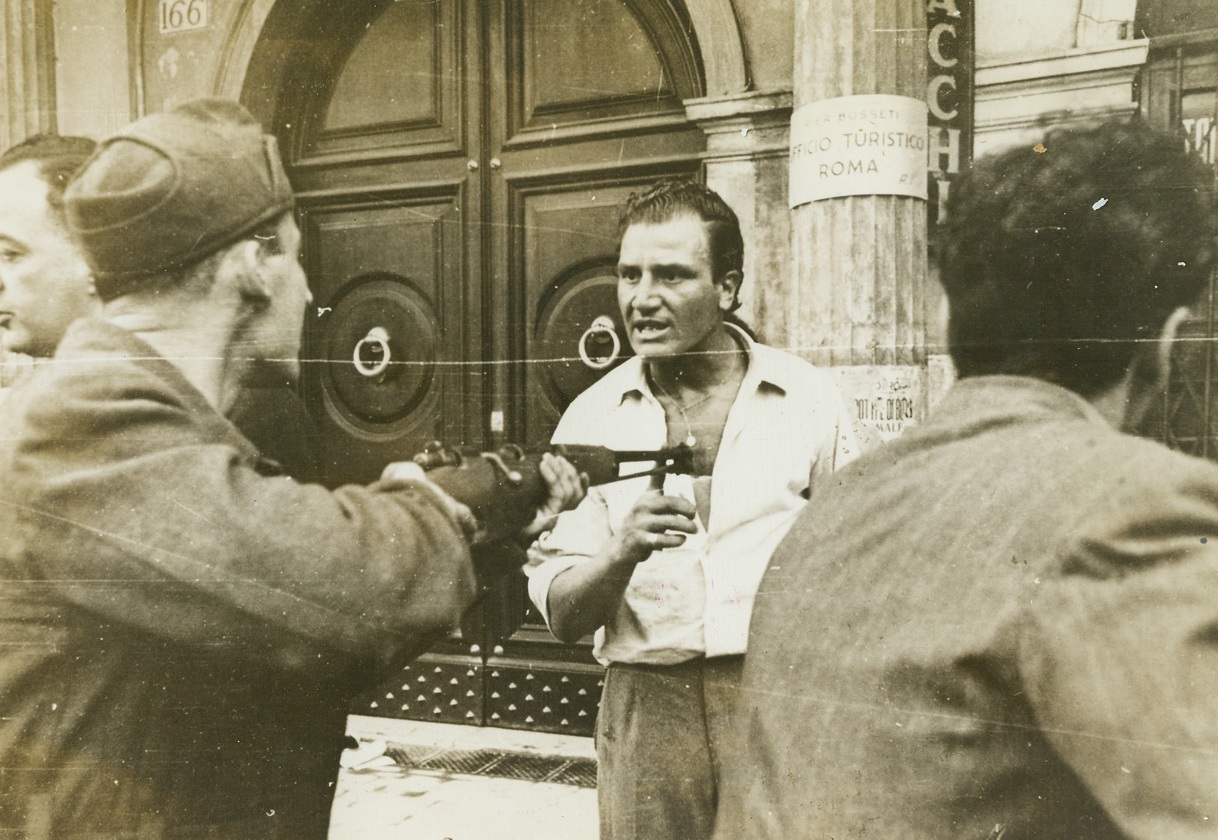
ANTI-FASCISTS HAVE THEIR DAY, 6/17/1944. ROME, ITALY—With the Allied entry of Rome, groups of rabid anti-fascists, who had long been forced underground, sprang from their hiding places, banded together and smoked out known fascists to bring them to trial and make them pay the inevitable price all fascists must pay for their lordly ways, their rule with an iron hand, and the suffering they forced upon the people. Not all reach a courtroom. The fiery Italian people have made their own rules governing the treatment of fascists. This series of pictures taken in Rome tell the story of one anti-fascist organization and the capture of some of Musso’s stooges. New York Bureau Captured in a tobacco shop along with two of his partners, this known fascist feebly tries to push aside the barrel of a rifle pointed threateningly at his chest by an Italian patriot. Groups of anti-fascists prowl through the streets of Rome now that the Allies occupy the city and mete out their own idea of a proper punishment to any fascist they can smoke out. Some are taken to trial where their fate is decided. Some never reach a courtroom. The anti-fascists in Italy can now pay back in full measure for the years they suffered under fascistic rule. Credit-WP-(ACME);
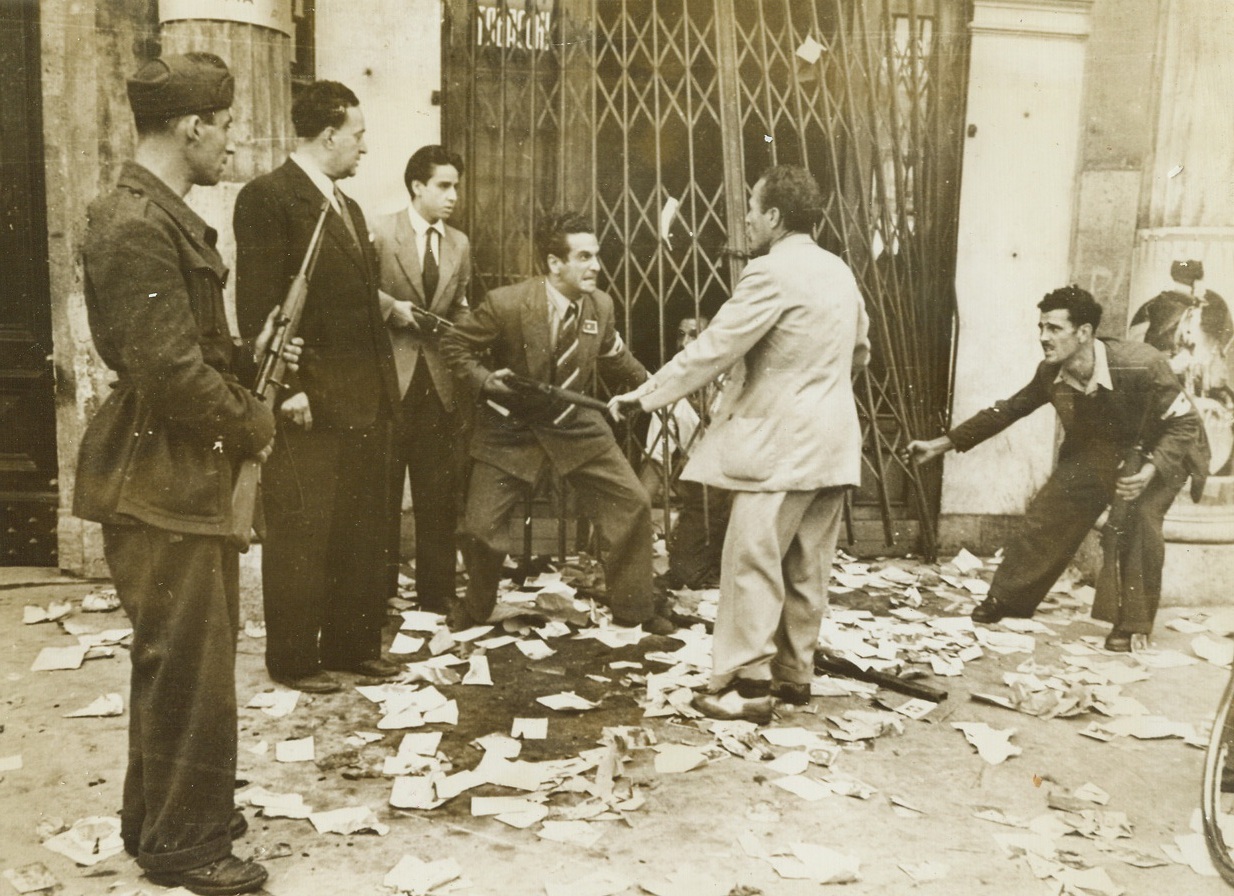
ANTI-FASCISTS HAVE THEIR DAY, 6/17/1944. ROME, ITALY—With the Allied entry of Rome, groups of rabid anti-fascists, who had long been forced underground, sprang from their hiding places, banded together and smoked out known fascists to bring them to trial and make them pay the inevitable price all fascists must pay for their lordly ways, their rule with an iron hand, and the suffering they forced upon the people. Not all reach a courtroom. The fiery Italian people have made their own rules governing the treatment of fascists. This series of pictures taken in Rome tell the story of one anti-fascist organization and the capture of some of Musso’s stooges. New York Bureau With the information that three known fascists were hidden in a tobacco shop, armed Romans blew out the front of the shop and dragged out the three men. One rabid member of the patriotic group vents his hatred in words that need no telling as a captured fascist cringes before him. Note the arm bands and lapel tags used by the anti-fascists. Another of the fascists kneels behind the grill waiting to be brought out.;

CASUALTY ON THE MINEFIELD, 6/12/1944. While American medics give first aid to an American combat engineer who stepped on a German mine, another engineer searches for further mines. Before evacuating the beachhead area, the Nazis planted the surrounding fields with mines, but Allies cleared a path to make way for their advancing forces. Credit (ACME Photo by Bert Brandt, War Pool Correspondent, via US Army Radiotelephoto);
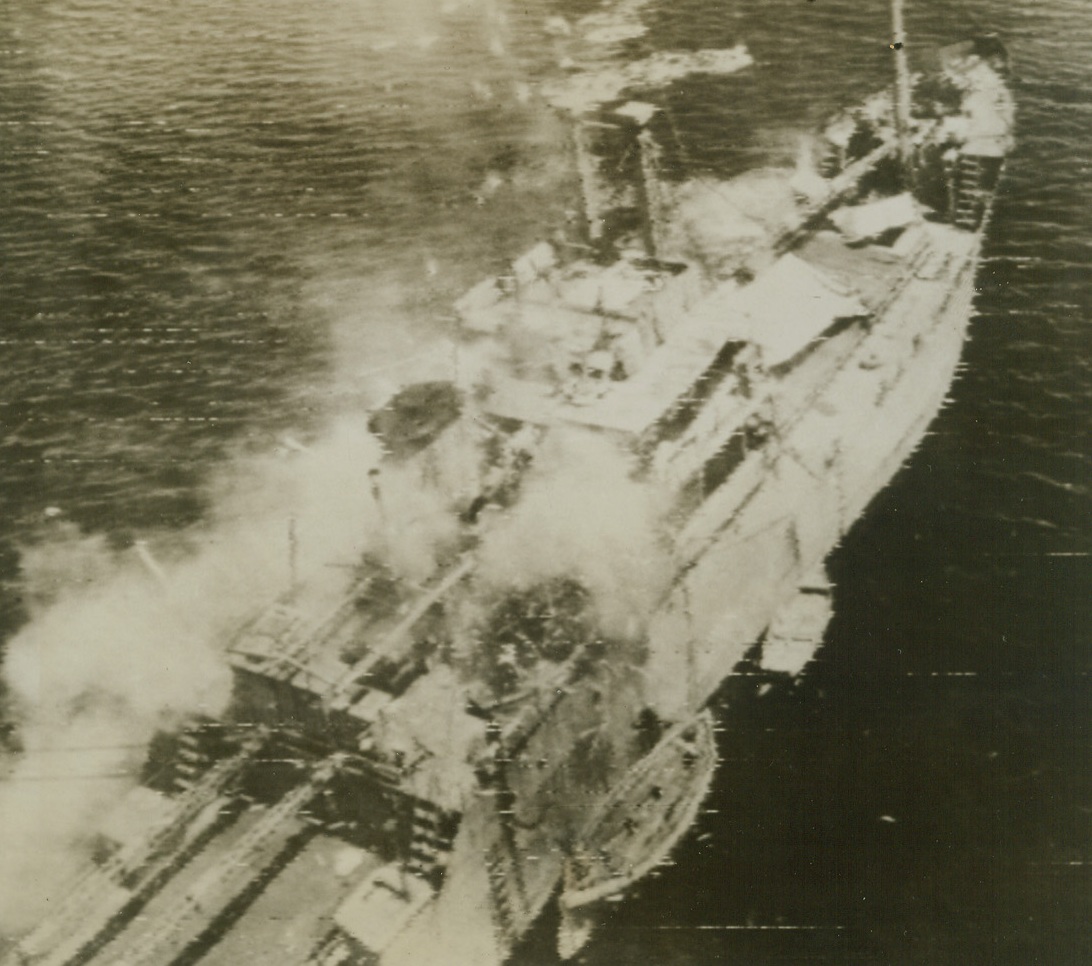
In for the Kill, 6/22/1944. This photo, flashed to the U.S. today by radiotelephoto, was taken from a B-25 Mitchell bomber, as it came in to put the finishing touches on this Jap transport, already smoking heavily and dead in the water. No sign of life can be seen aboard the doomed vessel and anti-aircraft guns are not manned. Note starboard life boat blown from its Davits by a bomb. Lt. Gen. Kenney’s planes caught the ship north of New Guinea. Credit: Fifth Air Forces photo via Army Radiotelephoto from ACME;

Yanks Continue Drive on Saipan, 6/19/1944. Saipan Island – U.S. Troops on Saipan have driven into the center of that important island in the Marianas and today engaged the Japs in a bloody battle for Aslito Airfield, only four hours flying time from Tokyo. An enemy tank-led counterattack has been beaten off. In this air view of Saipan the important Aslito Airfield can be seen at lower right. With the island of Saipan in the foreground and Tinian in the background, this photo covers a distance of approximately 26 miles. Credit: USAAF photo from ACME;
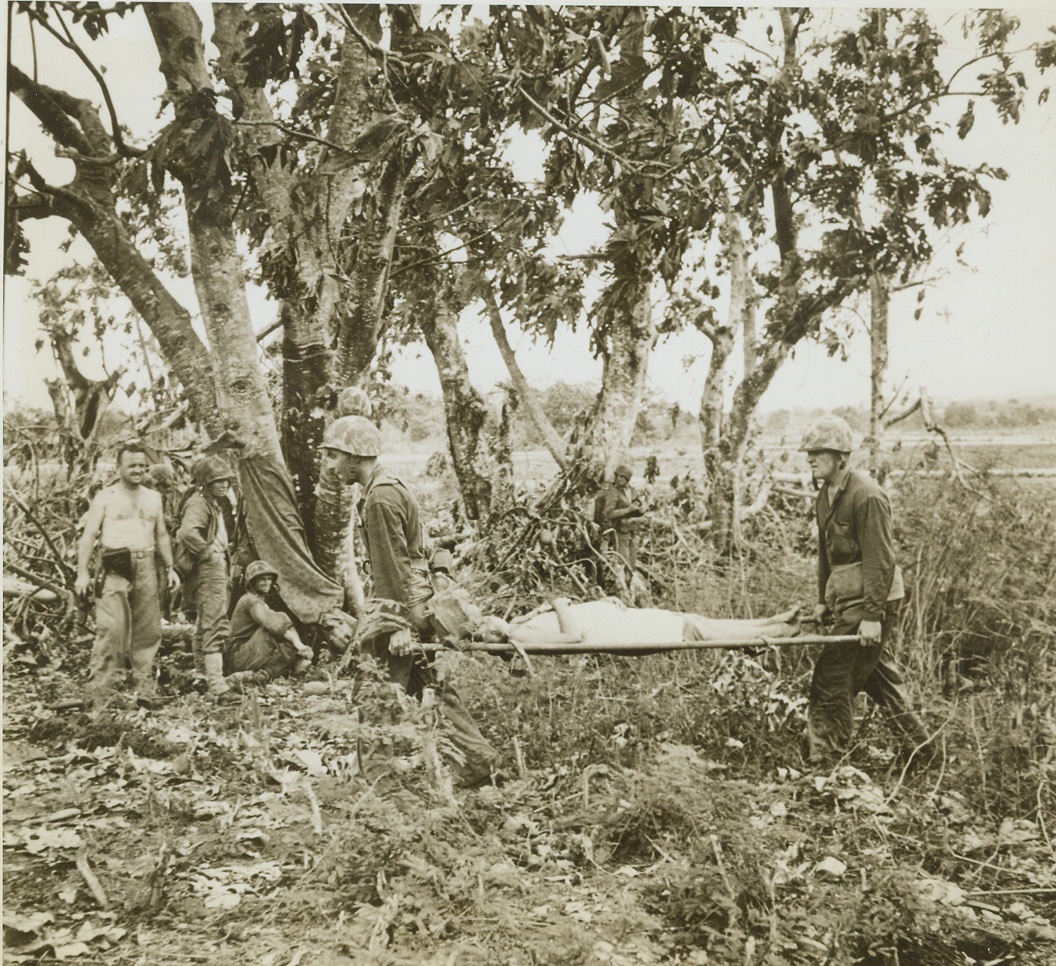
Prepare to Deliver War Baby, 6/28/1944. Saipan – A Marine doctor and corpsman carry a pregnant Jap woman to an aid station where her baby was delivered a few hours later. In carrying the woman to the prison camp station, these two mercy bearers were shot at by Jap snipers and had to wait a half hour in a ditch while Marines exchanged gunfire with the hidden sniper. Credit: ACME;
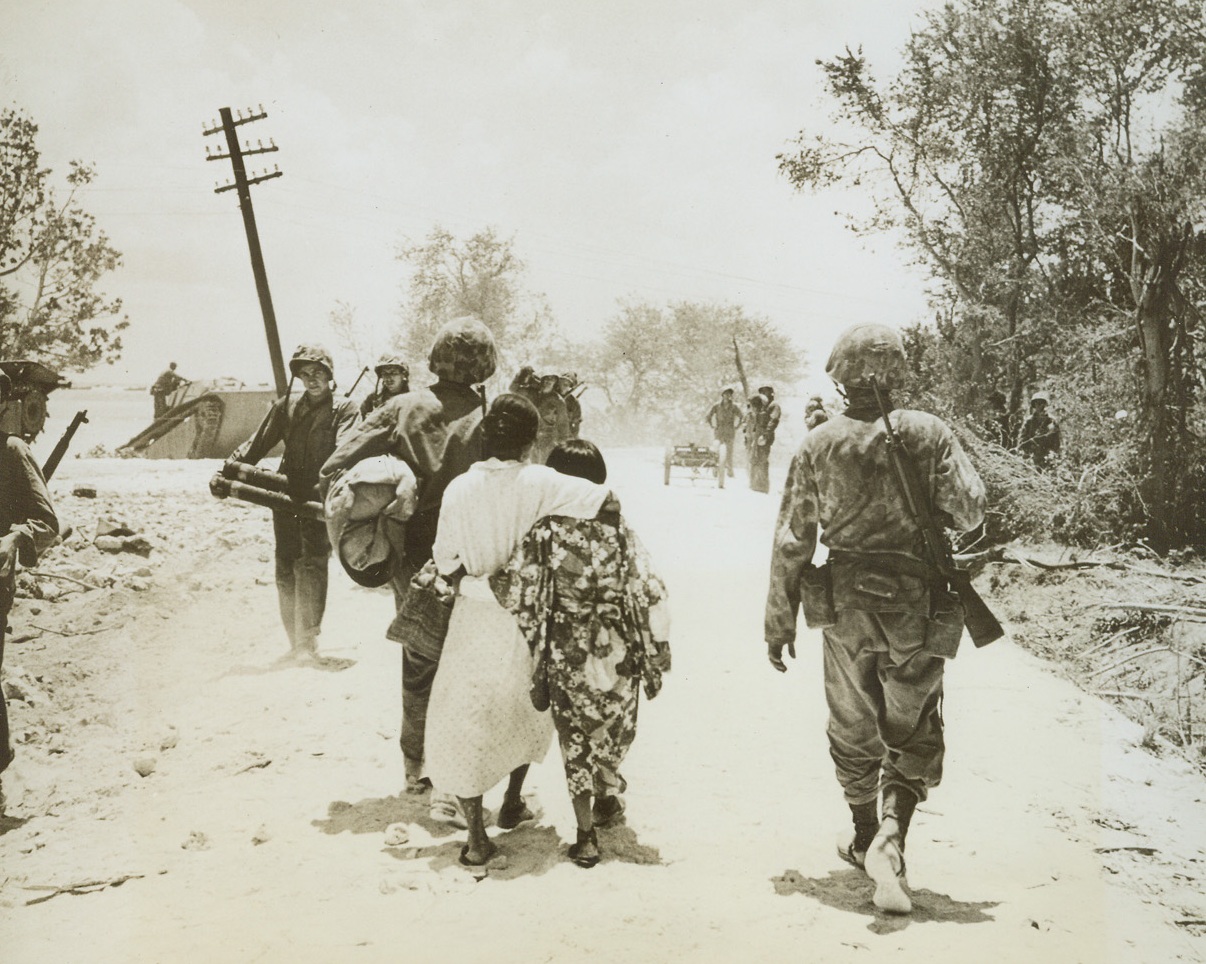
Civilian Prisoners on Saipan, 6/28/1944. Saipan – Japanese mother and daughter, prisoners of war, are escorted to the beach under military escort. Captured on the first day of the invasion of Saipan, these civilian prisoners of war had to wait a full day before prison camps were hastily erected. Credit: ACME;
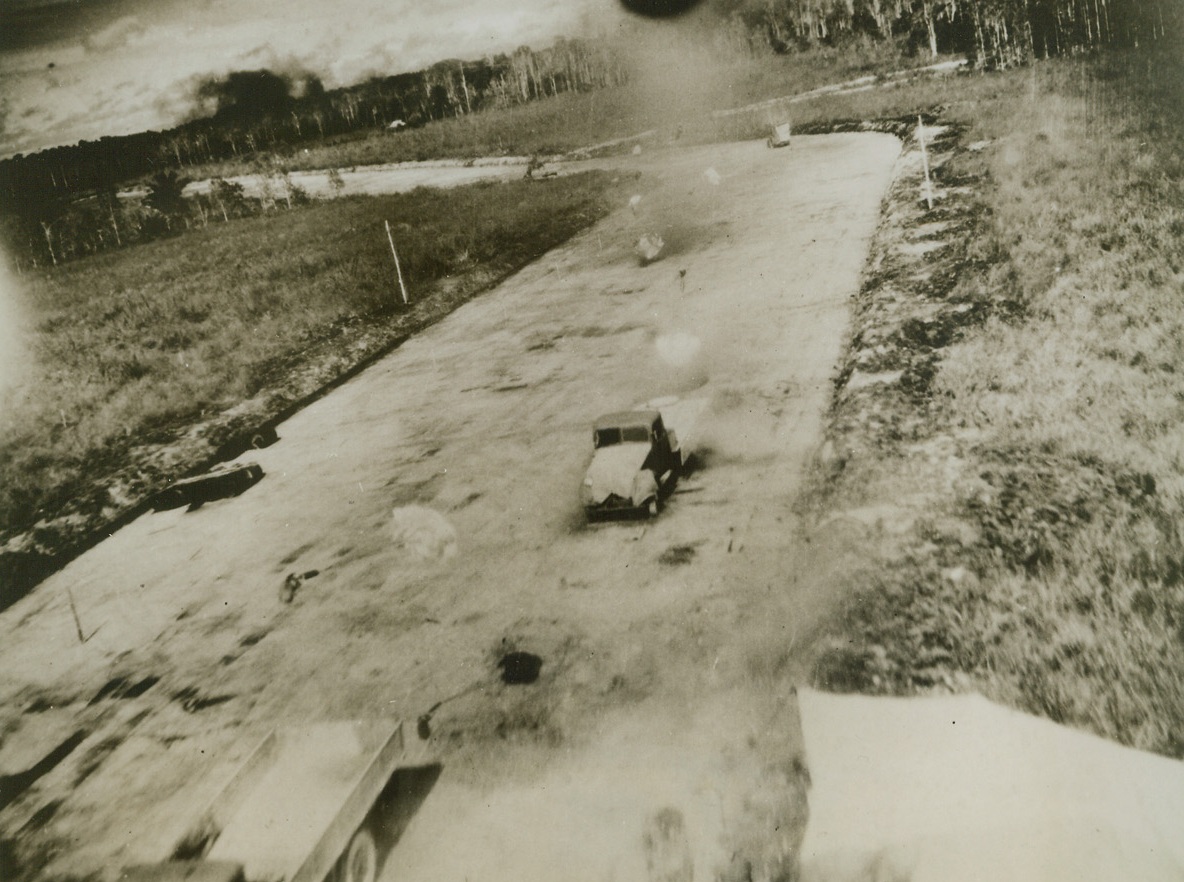
Gently Moving Death, 6/13/1944. Otawiri, Dutch New Guinea – These parachute bombs, gifts from Gen. Kenney’s Fifth Air Force Bombers, settle gently on a taxiing strip amid the abandoned trucks on the runway. Japs fled to the jungles when the bombers began the attack on the Airdrome, leaving vehicles, aircraft, and equipment to be destroyed by the “handkerchief” bombs. Credit: USAAF photo from ACME;
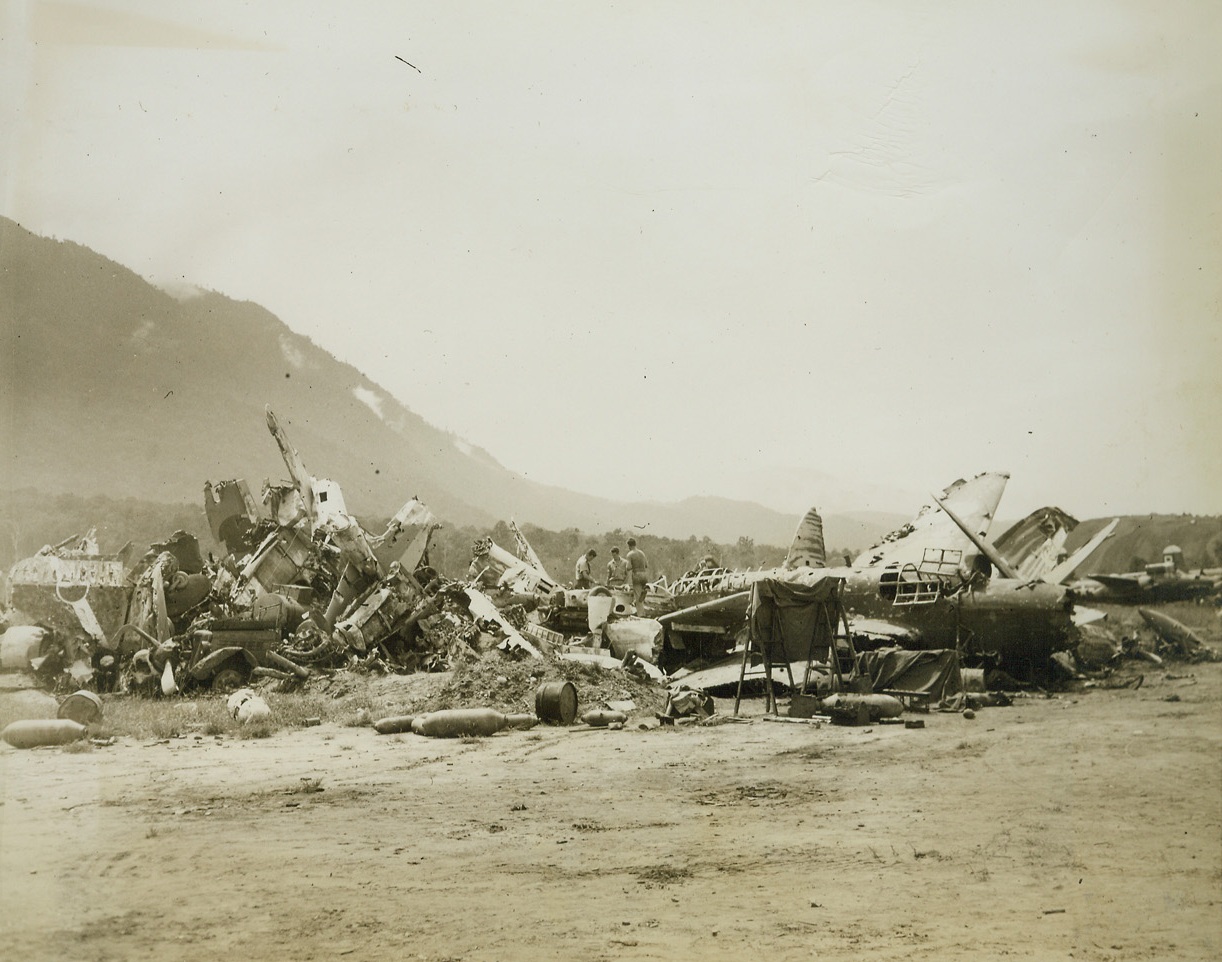
Warbird Boneyard, 6/12/1944. Hollandia – All that remains of Jap warbirds that were shot up on Hollandia Airstrip during Allied raids in the battle for the strategic filed is piled high in this corner of the strip. Allied fighters swept the wreckage of the planes to one side so that our forces might begin using the airfield immediately after its capture. Credit: ACME photo by Frank Prist, Jr. for the War Picture Pool;
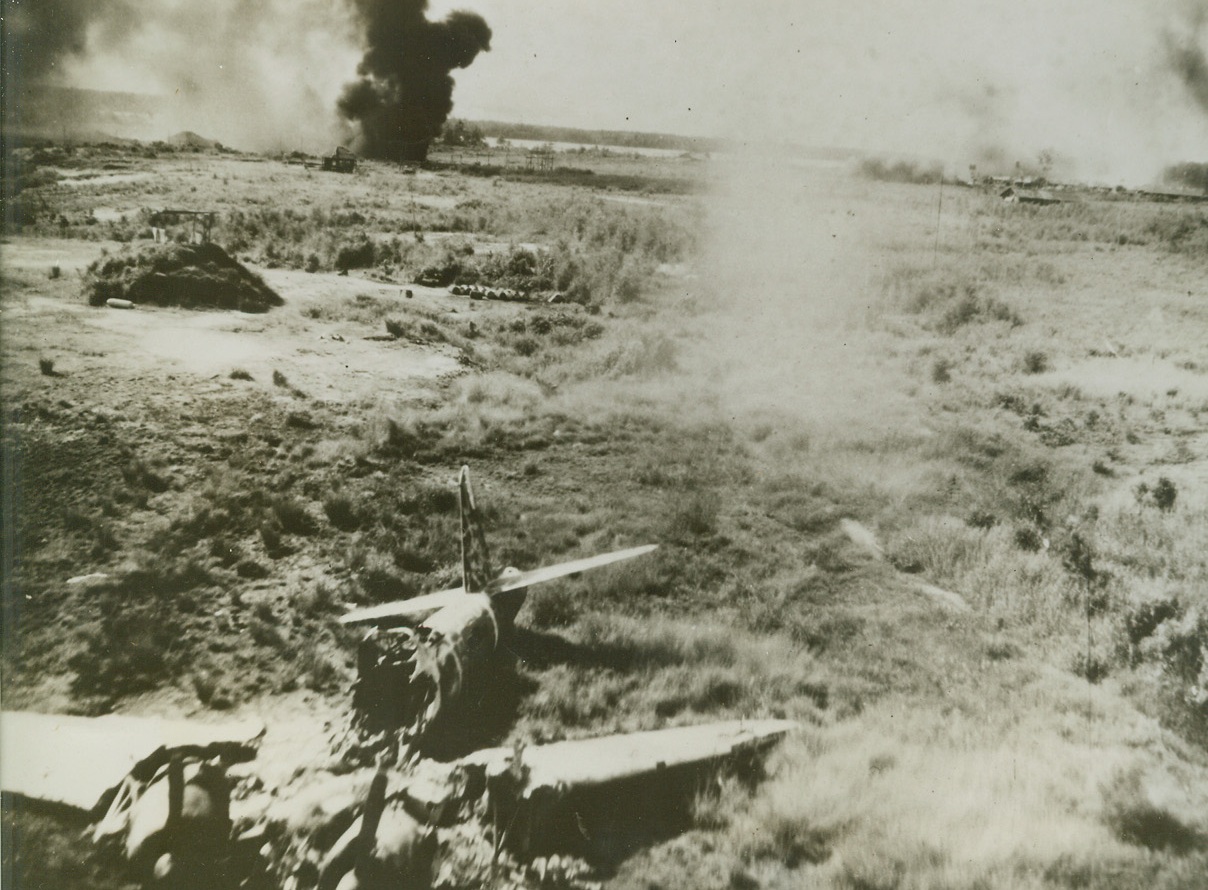
Blast Jap Airfield, 6/12/1944. New Guinea – Wrecked planes, smoke and fire are vivid proof of the effectiveness of General Kenney’s Air Force as they swoop low over a Jap Airdrome. Jap base is located at Babo, Durch New Guinea. (Passed by Military Censor.) Credit: USAAF photo from ACME;
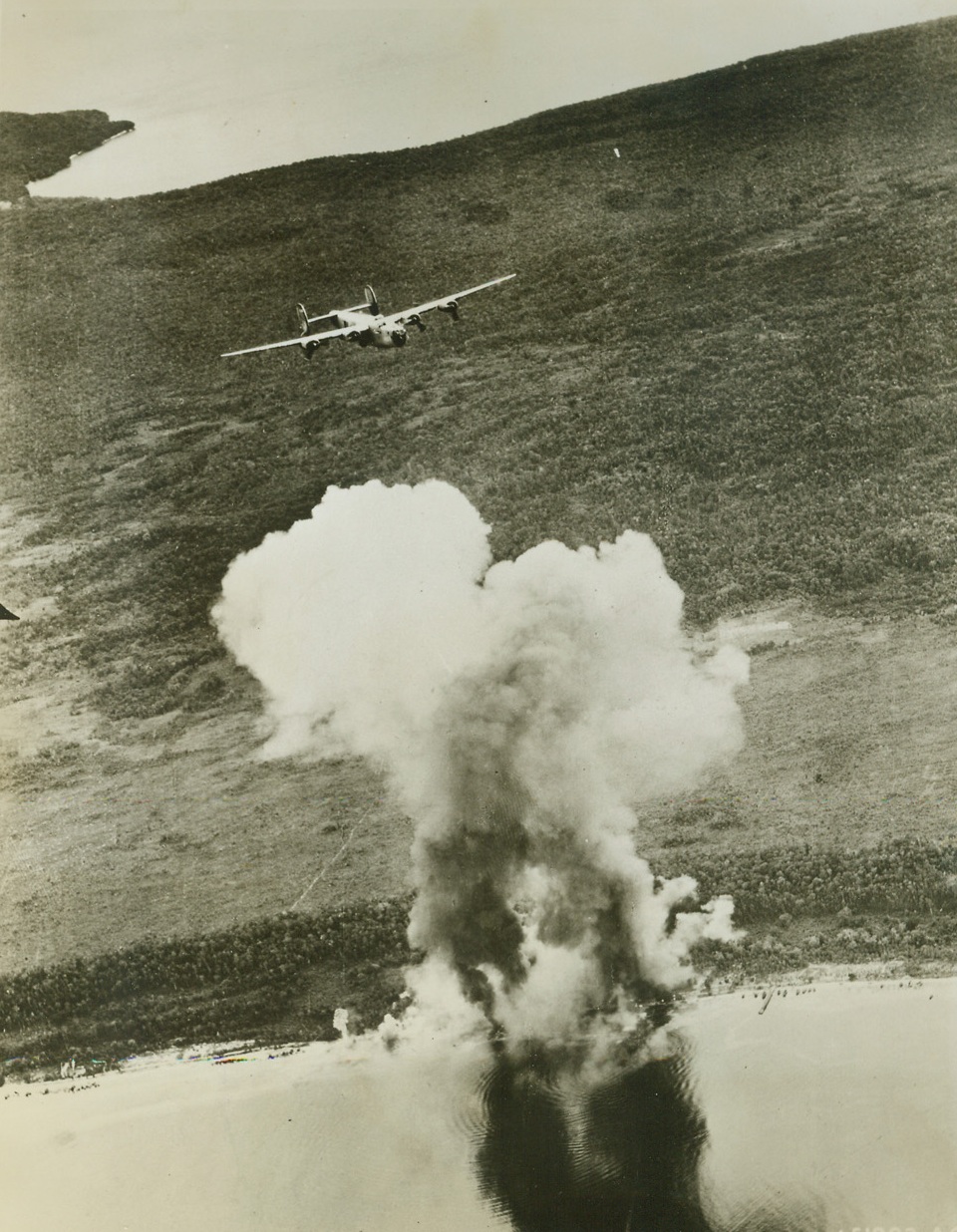
Bullseye on Jap Supply Dump, 6/29/1944. A Jap supply and personnel area goes up in a column of smoke on Biak Island, as Liberator Bombers of the U.S. 13th Air Force lay down a pattern of bombs on the narrow beach that is the target. Dark column of smoke causing the deep shadow on calm sea indicates hits on a fuel dump. Credit: USAAF photo from ACME;
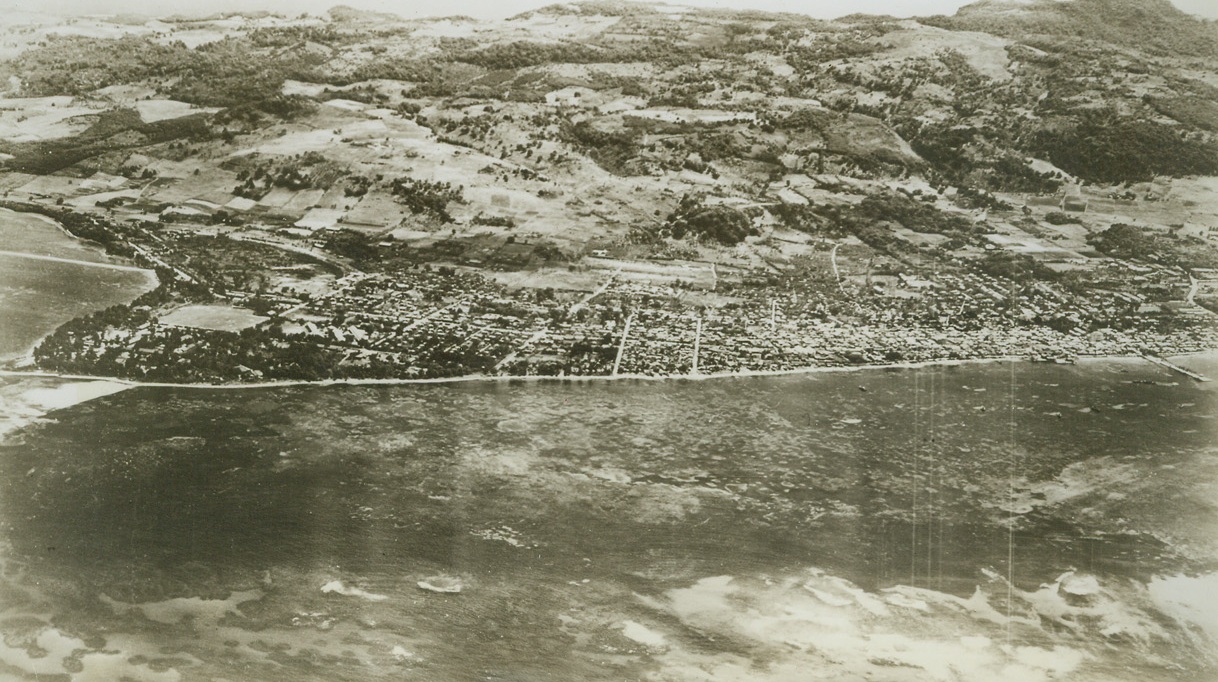
Yanks Reach Saipan Capital, 6/23/1944. Saipan, Marianas – This is an airview of Garapan, capital city of Saipan Island whose entire southern section is now in the hands of the Americans. Yank troops are now on the outskirts of the capitol and largest city, whose industries include a chemical plant and cannery. The large building to the left of Government Pier (right) is Japanese Administration Building. Enemy counter attack to the right of this area was repulsed by out forces. Credit: US Navy photo from ACME;

Skeleton, 6/14/1944. New York City – The Kunigawa Maru, Japanese troopship, lies battered and beached on the shores of a South Pacific Island, a skeleton remnant of the one-mighty Japanese fleet. At left is a remains of a Jap pillbox. The Kunigawa Maru was beached during the battle of Iron Bottom Bay in the Coral Sea between Guadalcanal and Savo Islands. Credit: ACME;
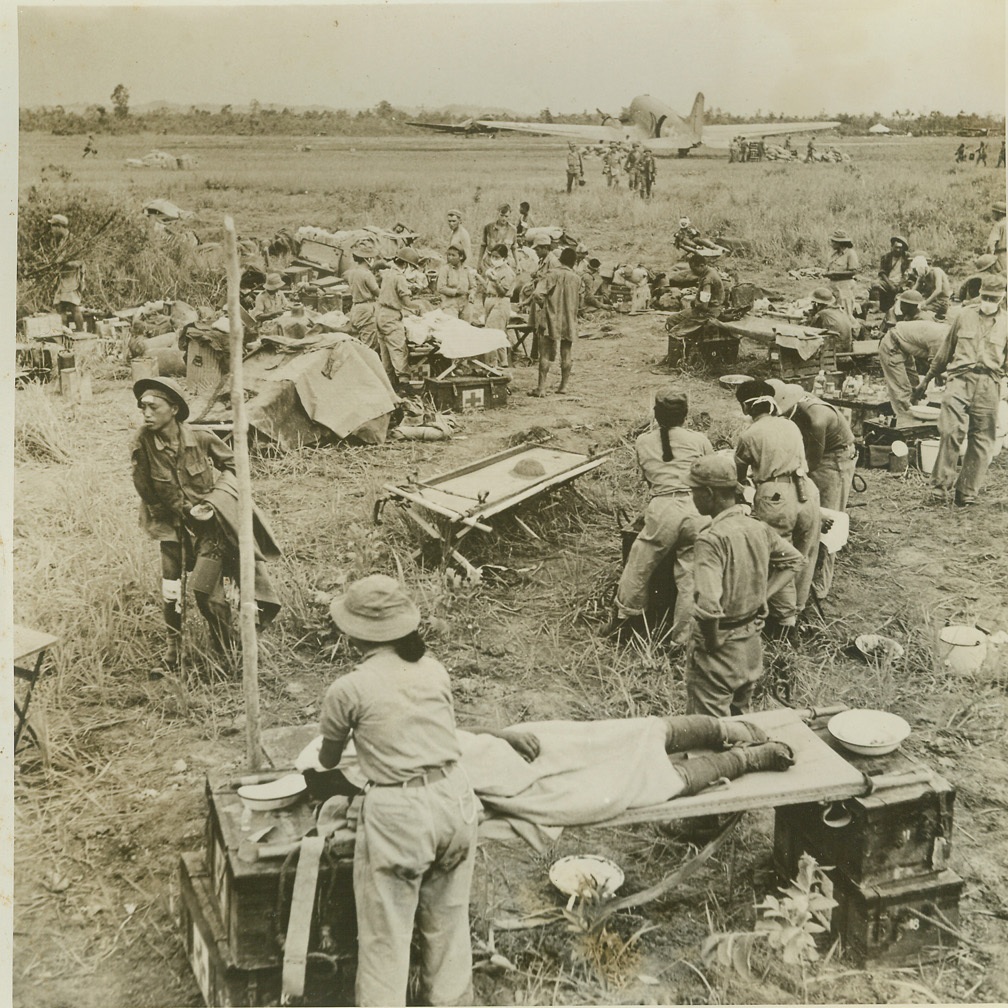
Medical Unit at Work on Airfield, 6/17/1944. MYITKYINA, BURMA -- Chinese nurses assist Col. Gordon S. Seagraves in setting up a field hospital for Chinese and American soldiers wounded during a Jap Zero attack on Myitkyina Airdrome. The airfield was taken from the Japs by Merrill's Marauders but Jap snipers and strafing planes returned to cause considerable trouble. Credit (ACME) (WP);

Changsha – Jap Nemesis, 6/3/1944. China – Pillboxes line the Nan Tsen Road in Changsha – the Chinese city in the Hunan Province which, for the fourth time, is now threatened by Japanese forces. Each time the Japanese Army set out to conquer Changsha, they were driven back by Chinese troops in ignominous defeat. The new Jap drive may bring the invaders disastrous defeat again in their attempt to capture the strategic and well-defended city. Changsha has been virtually rebuilt after the poundings it suffered during the previous Japanese drives. Ruins, however, still stand side by side with new buildings. Credit: Chinese Ministry of Information photo from ACME;
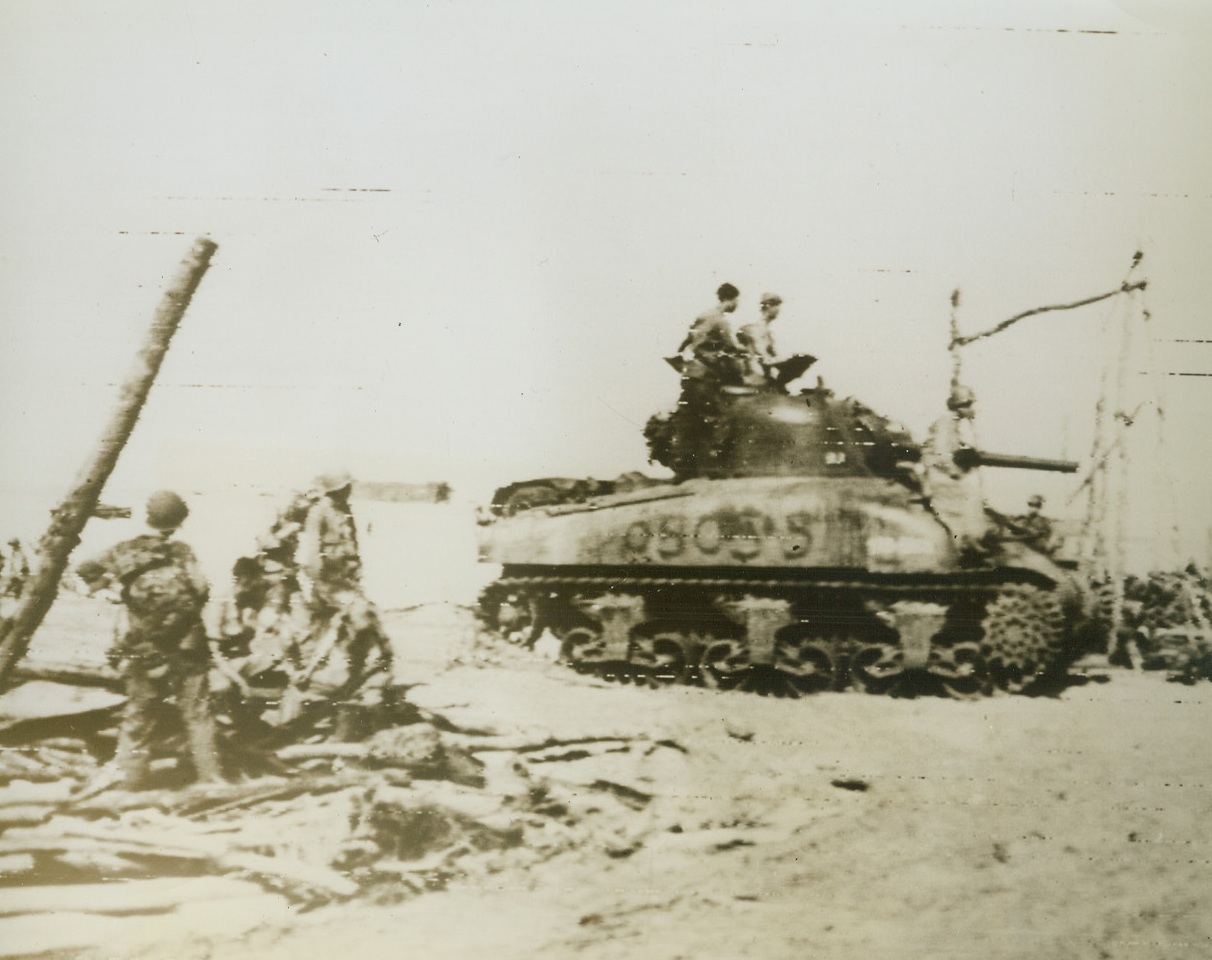
Jap Hunting at Biak, 6/3/1944. South Pacific – United States Medium Tanks move ashore at Biak Island in the Schouten group. Shortly after their arrival the American tanks engaged several Japanese Tanks in the first battle of its kind in the Southwest Pacific. Even in the treacherous jungle terrain the American vehicles proved superior to the enemy’s. Credit: US Army Radiotelephoto from ACME;
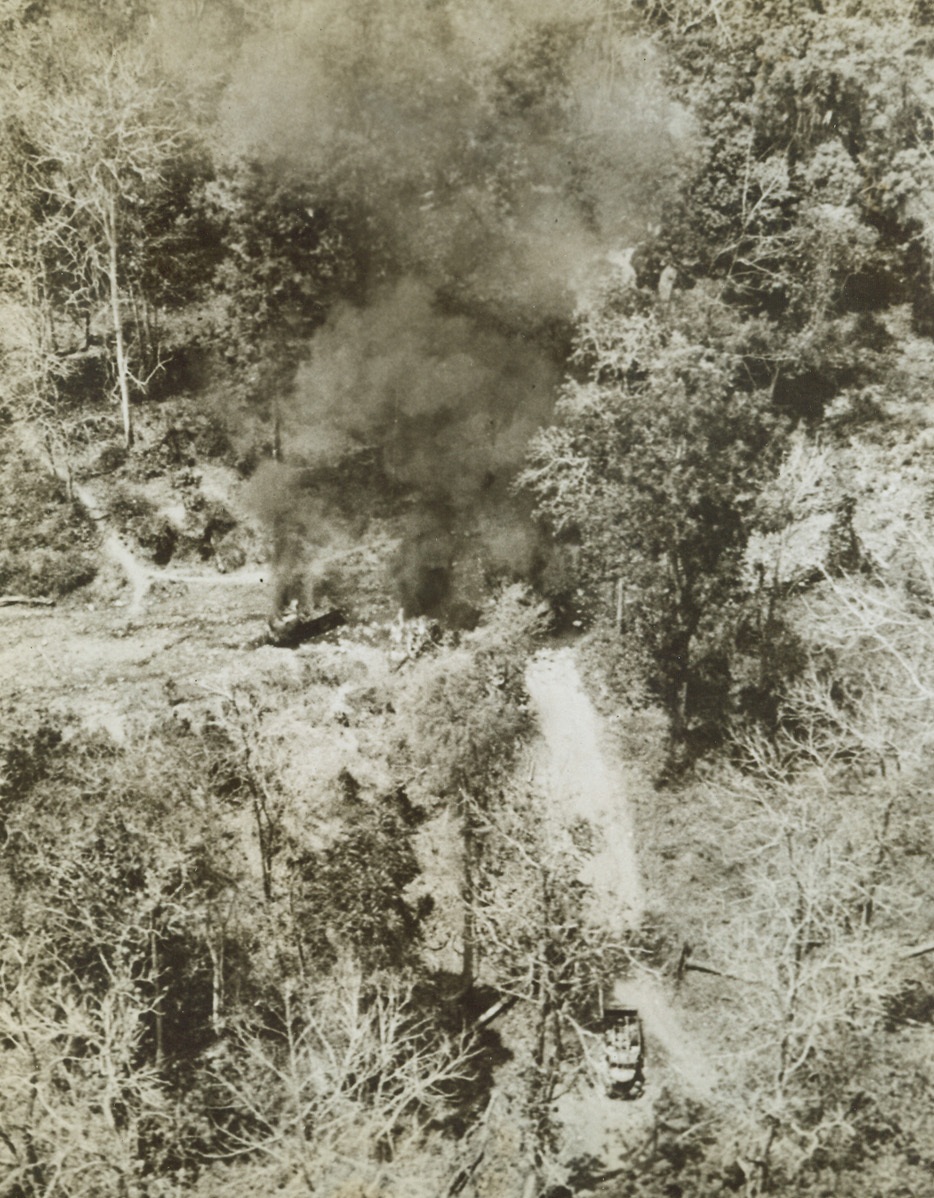
Jap Dead Form Allied Air Beacon, 6/3/1944. Burma – A raiding column, battling the Japs ambushed a truck convoy of Japanese crawling back to their supply depots in Burma. The Allied Column, in order to signal Light Planes to parachute ammunition to them, piled Jap dead in the captured trucks, covered them with oil, and set fire to the convoy. Two of the trucks can be seen in lower foreground and left background. The pyre sent up smoke columns which guided the planes to the spot. A horror story, but war is not for the sensitive. Credit: ACME;
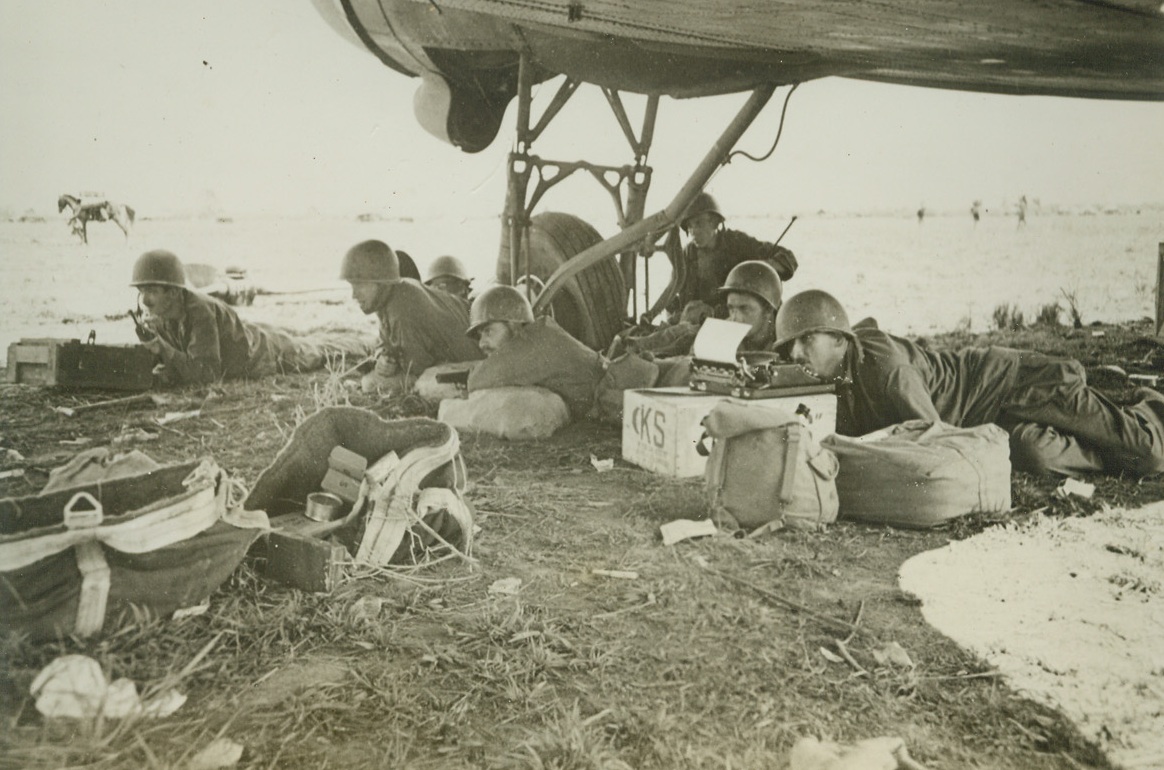
Wing of Plane Offers Refuge from Strafing, 6/17/1944. Makyina, Burma – American Soldiers at Makyina Airdrome, which was taken from the Japs by Merrill’s Marauders, take refuge under the wing of a C-47 as a Jap sniper bullet whizzes by. After the capture of the field, the American and Chinese soldiers were constantly bothered by Jap snipers and strafing planes. Note the correspondent with paper in his typewriter, ready to bang out a story, or else caught in the middle of one. Credit: ACME;
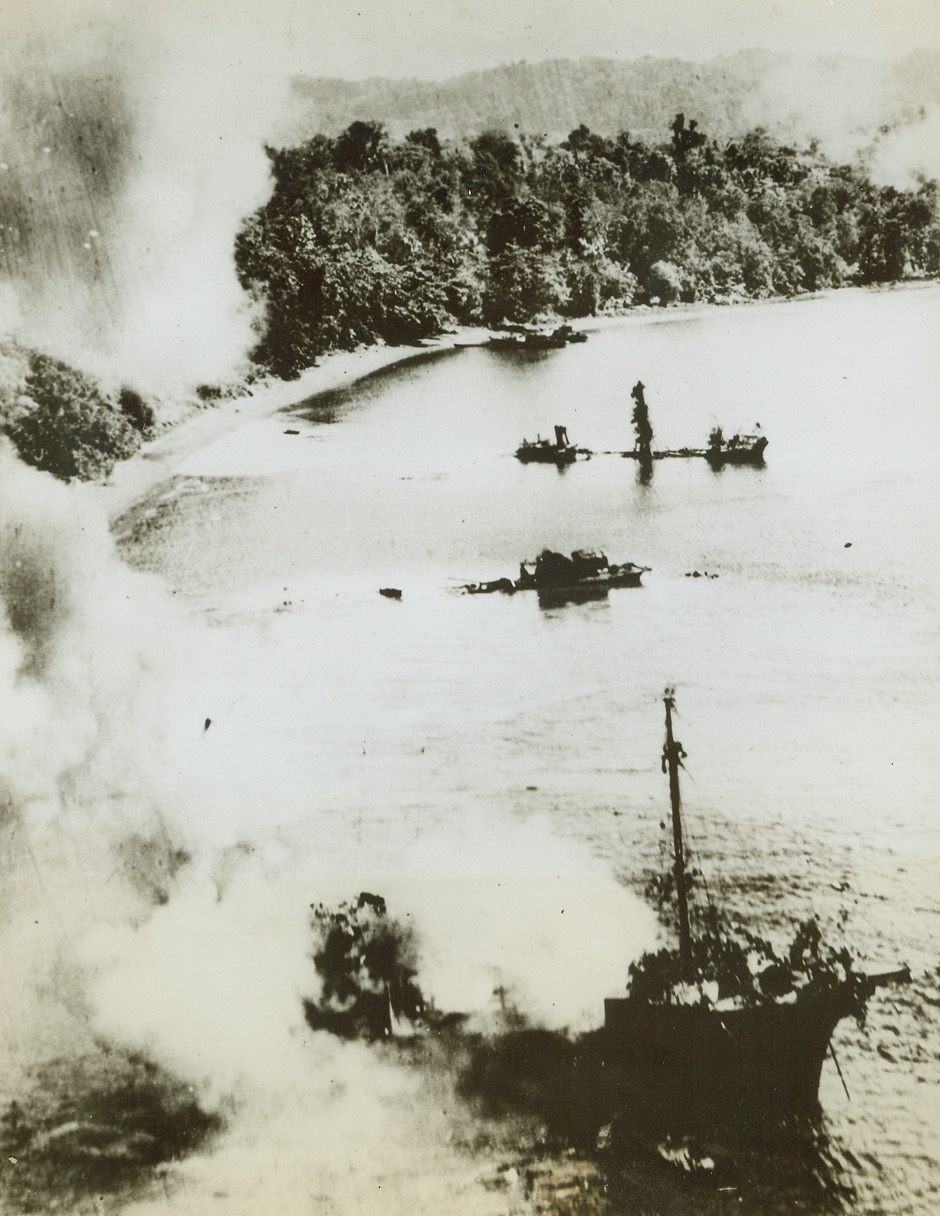
U.S. Bombers Hit at Jap Shipping, 6/27/1944. Manokwari, Dutch New Guinea – Battle smoke from the harbor of Manokwari as US bombers from the 5th Air Force attack Jap shipping. Strafed from masthead-level, the ship in the foreground is burning fiercely and the two ships in the background are sinking after direct hits.Credit (USAAF photo from ACME);
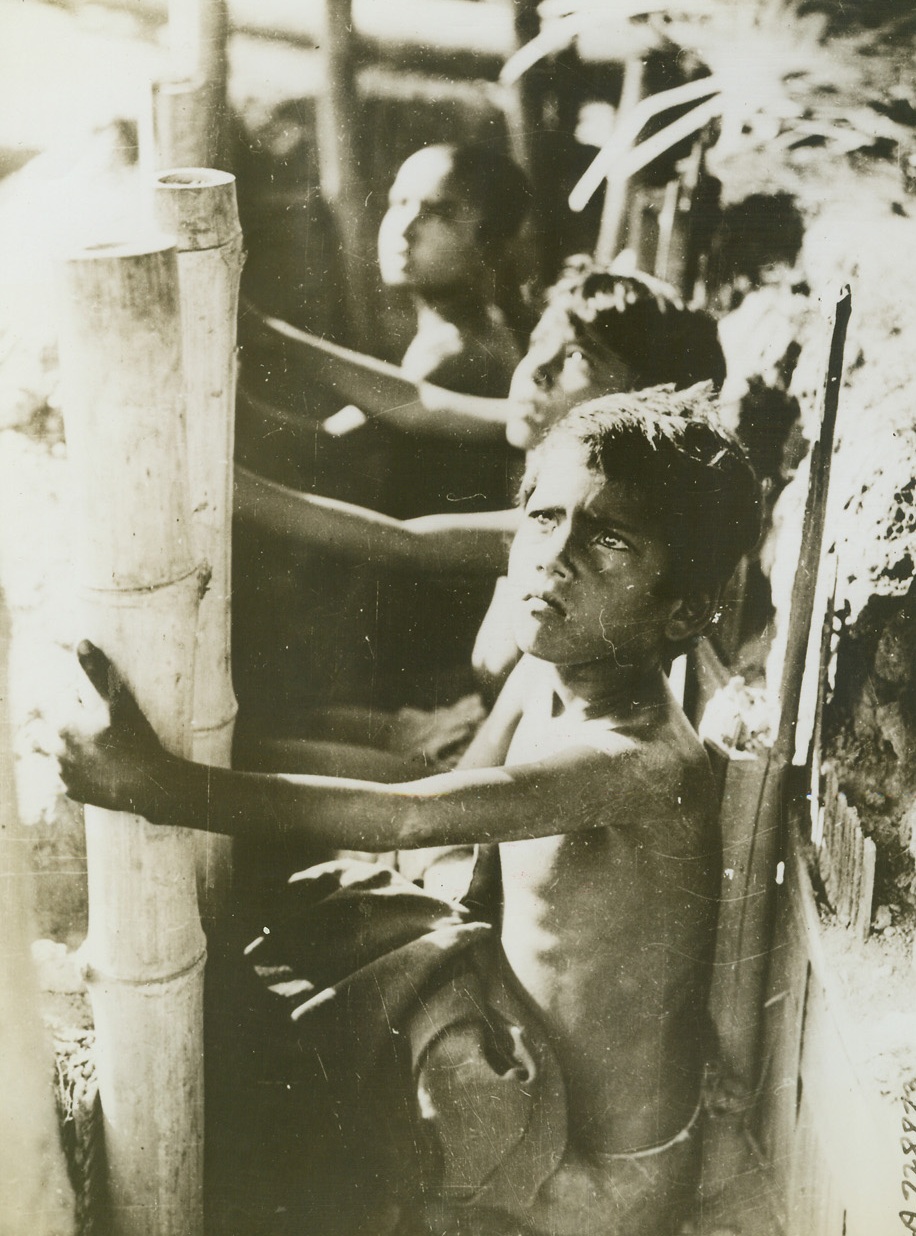
Fearful Eyes of the Innocent, 6/30/1944. Bengal—Fear grips the faces of these Bangal children as they sit in slit trenches and anxiously watch strafing Jap zeros pass overhead. Children like these the world over have never know the wonders of peace being born into maddened civilization brought on by the tyranny of the axis. Bamboo poles and basketwork support the sides of the trench offering the native youngsters protection.Credit (British official photo from ACME);
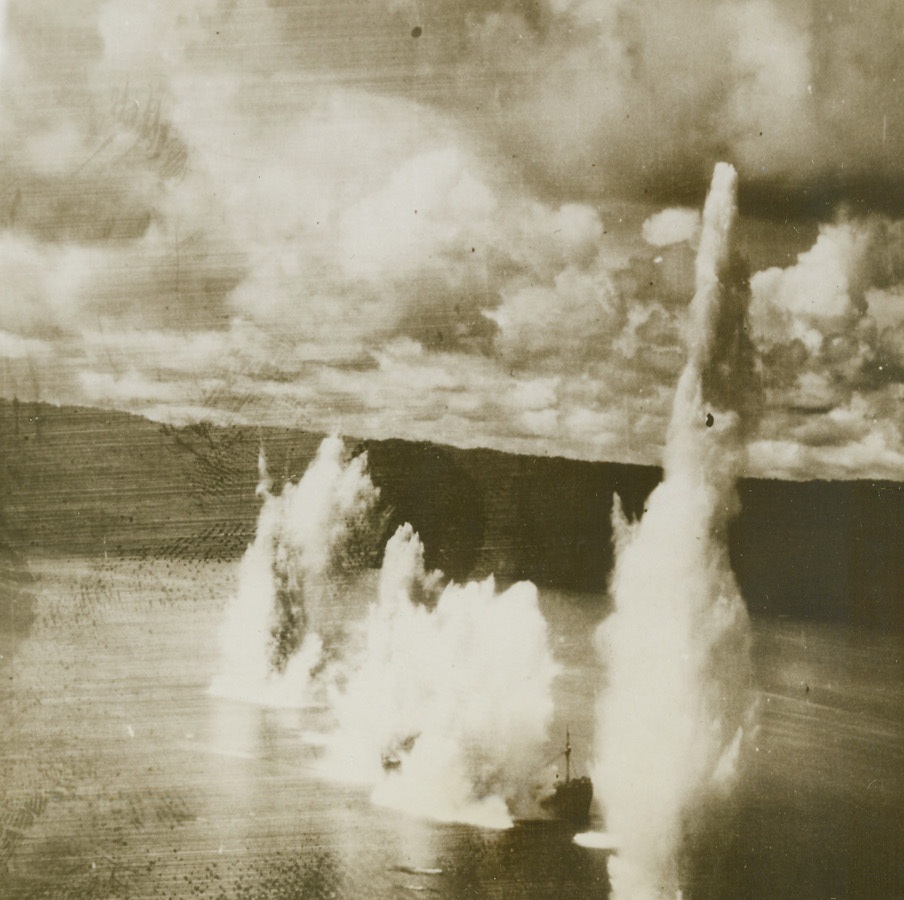
DOOM FOR JAP FREIGHTER, 6/30/1944. NEW GUINEA—Caught off the northern coast of New Guinea by a surprise attack by B-25’s of the 5th Air Force, this Jap freighter was soon crippled by bombs and machine gun fire. As it wallowed helplessly in the water a bomber moved in and scored a direct hit-spelling finis for the Jap boat.Credit: USAAF PHOTO FROM ACME.;
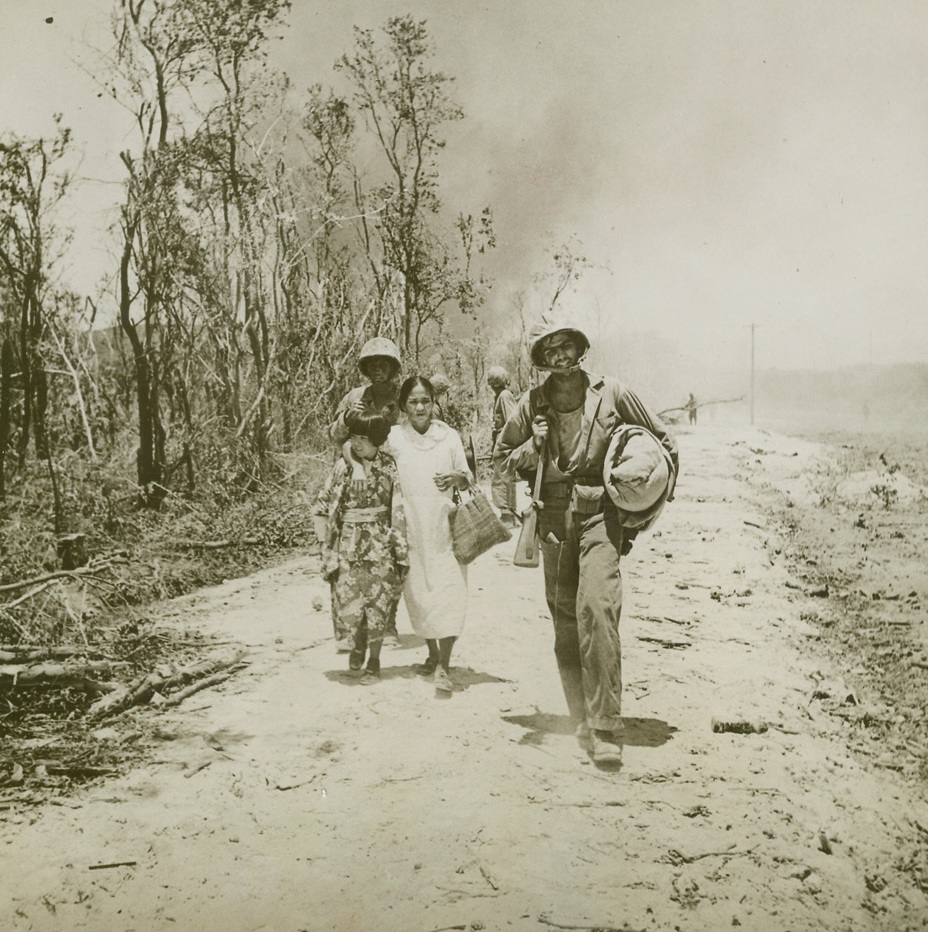
JAP CIVILIANS CAPTURED ON SAIPAN, 6/30/1944. SAIPAN, MARIANAIS—While the Yank in front carries their meager belongings, this Japanese mother and daughter march down the road to the beach where they had to wait until a prison camp was built later in the day. They were captured on the second day of the American invasion of Saipan. In contrast to her mother’s Occidental dress, the little girl wears the traditional Japanese kimono. Credit: ACME.;
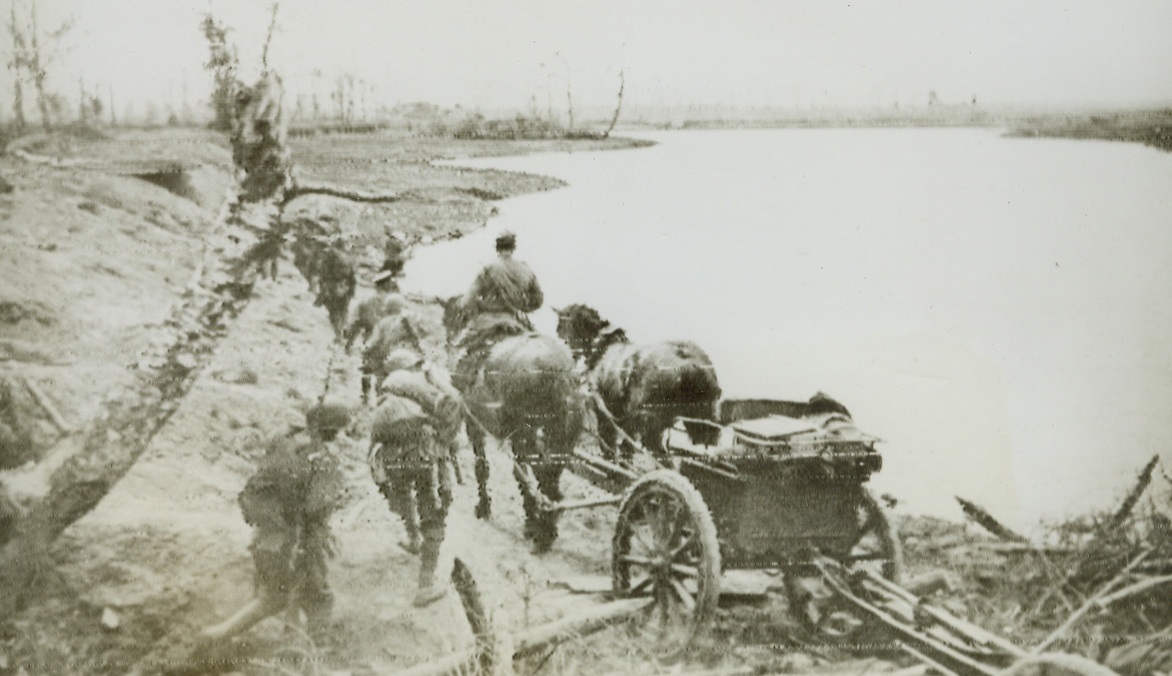
Red Army Continues Finnish Drive, 6/21/1944. KARELIAN ISTHMUS—In a swift 60-mile drive up the Karelian Isthmus, Marshall Leonid A. Govorov’s Leningrad Army yesterday captured the fortress city of Viipuri. Front dispatches have reported that the Finnish Army is in complete route and vastly outnumbered. Using horses over terrain not suited for vehicles, Soviet troops are shown on the march by the bank of the Sestra River.Credit: ACME;
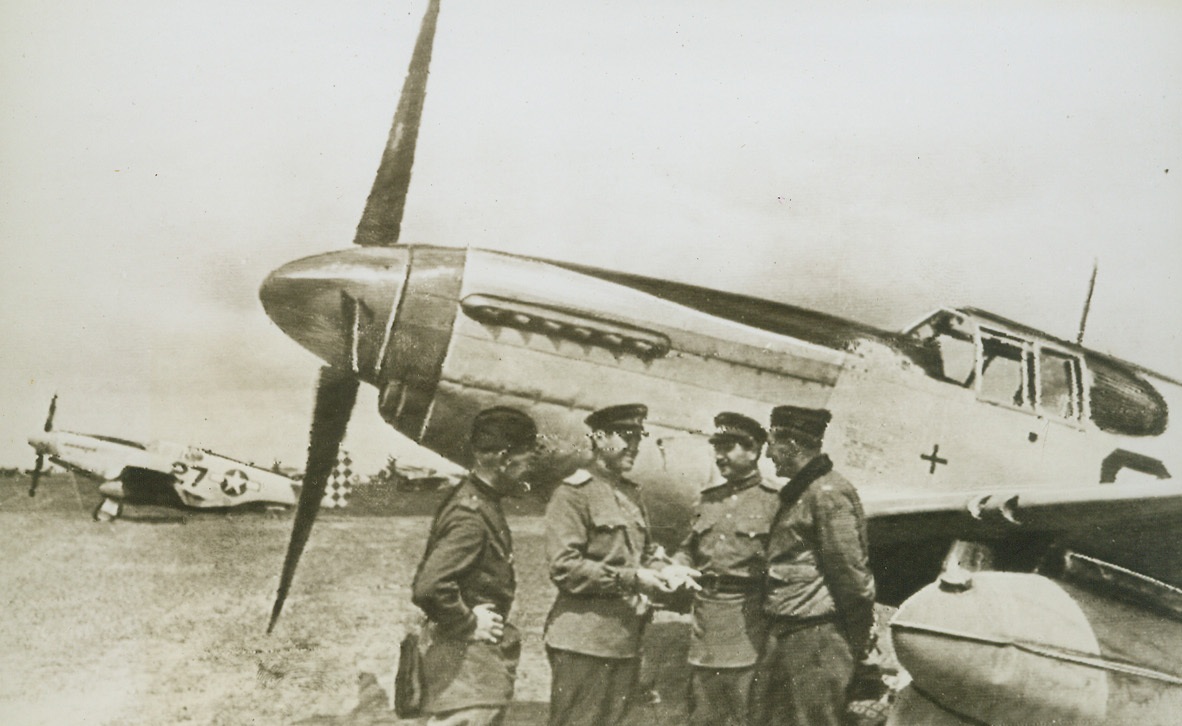
Yank Airfield in Russia, 6/7/1944. Russia – With the disclosure that after bombing enemy military targets in Romania, American “Flying Fortresses” had landed on an aerodrome in the Soviet Union, the potentialities of shuttle bombing become even more potent than they already are. A group of Yank airmen are shown gathered around the field kitchen at an American airfield in Russia. Credit: ACME Radiophoto;
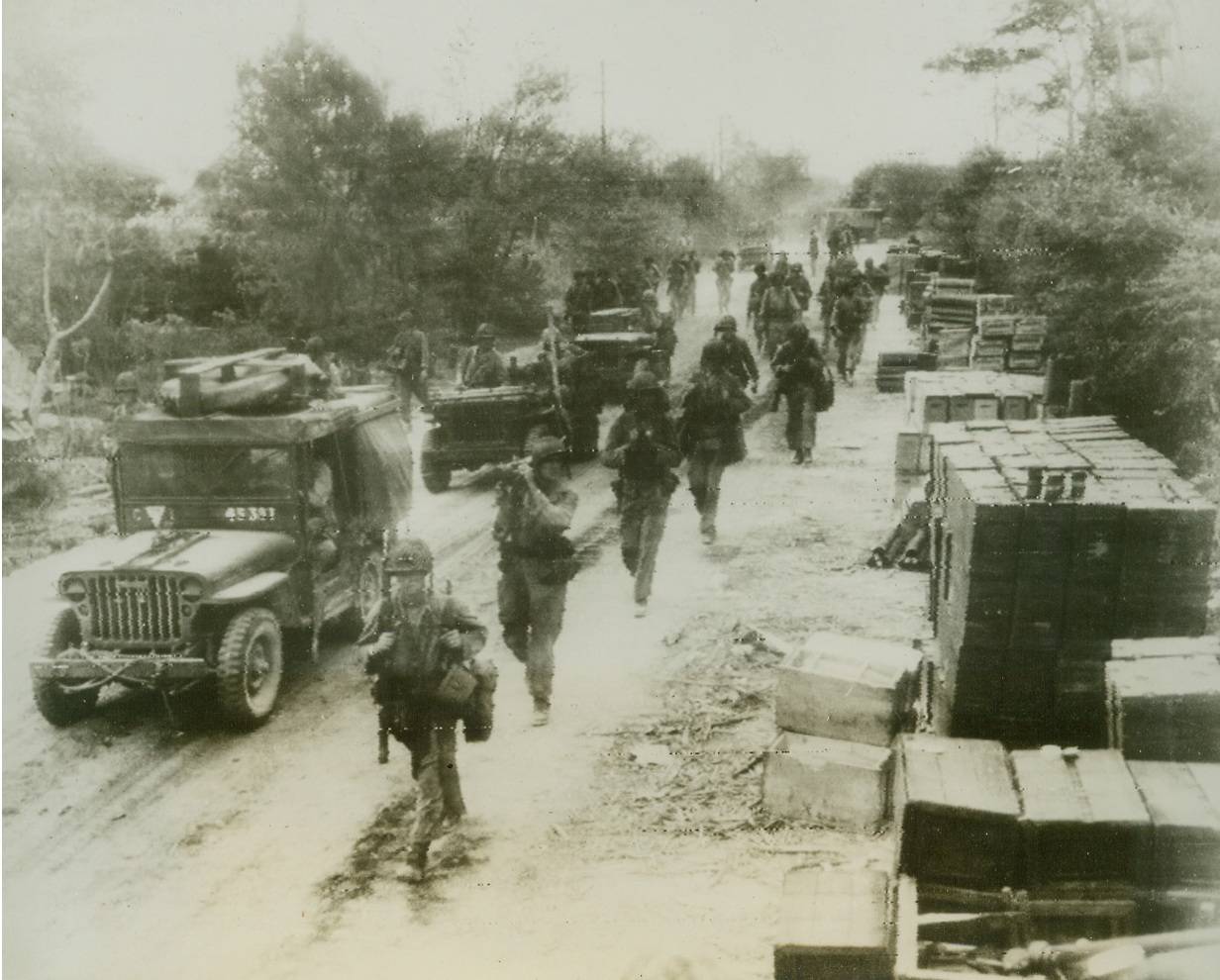
Yanks Move Up On Saipan Front, 6/24/1944. SAIPAN, M.I.—Along a Saipan road lined with ammunition cases, American troops and trucks move up to the front lines to reinforce leathernecks and doughboys engaged in bitter fighting for the vital Jap base. Photo radioed from Honolulu. Credit: ACME;
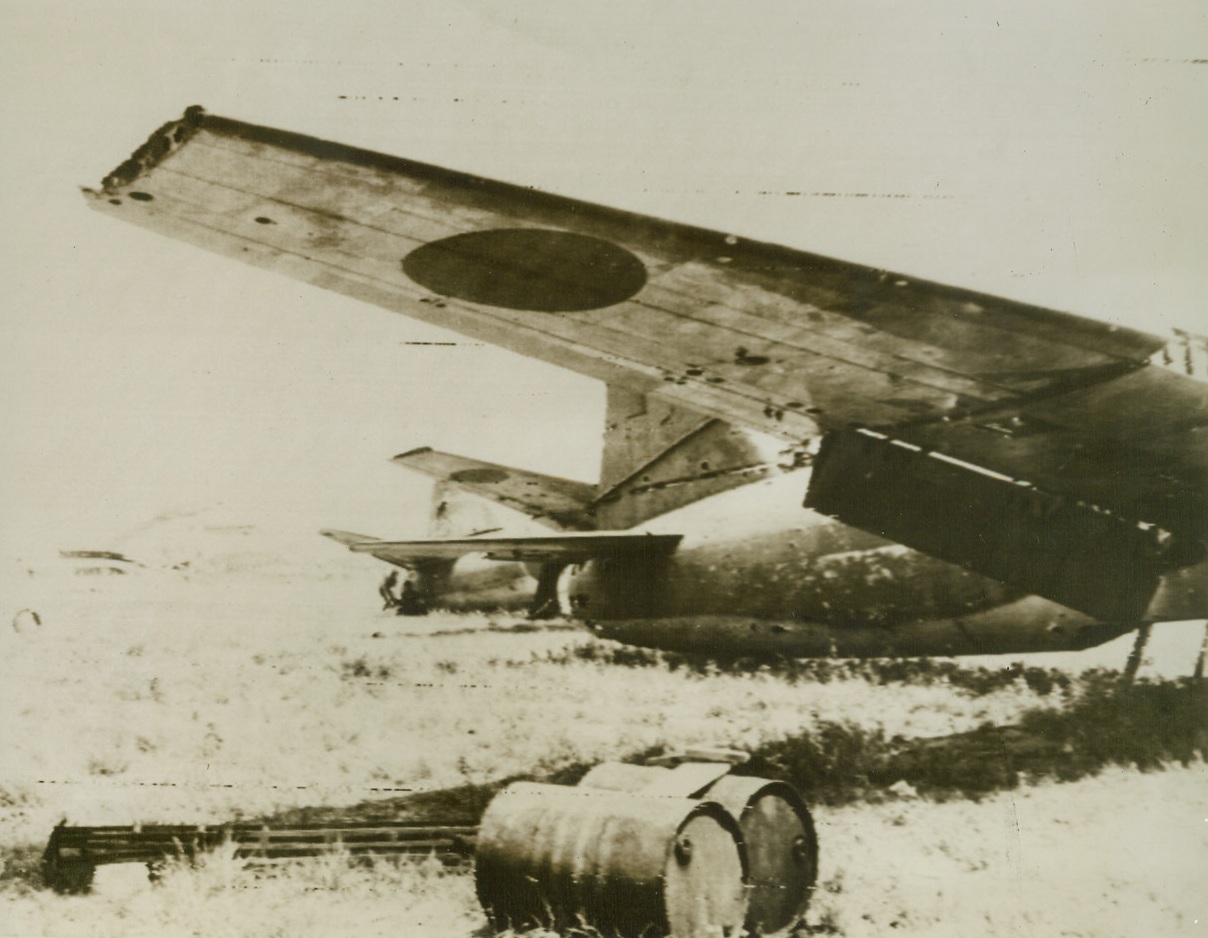
Jap Planes – Dead Ducks, 6/24/1944. Saipan – Damaged Jap warplanes lie useless on the Aslito Airstrip on Saipan, mute testimony of the work of American fliers who kept these enemy birds of war out of action. Latest reports state that American patrols have penetrated into the capital city of the Japanese Marianas meeting almost no opposition. Credit: Signal Corps Radiotelephoto from ACME;

n the Wake of Yank Advance,, 6/24/1944. Saipan – Wreckage and dead Japs mark the path of advance Yank troops have made on Saipan. Almost unopposed today American patrols penetrated into the capital city of the Japanese Marianas. The entire southwestern section of the island below the airfield of Aslito has been turned into a mighty artillery base which continually hurls shells into Jap positions. Credit: Signal Corps Radiotelephoto from ACME;

Making It Hot for the Japs, 6/24/1944. Saipan – Using the fearsome flamethrower, U.S. Army Infantrymen destroy a Jap pillbox position. Yank troops march steadily through the strongly defended island meeting stiff resistance in most cases but today, in reaching the capital city of the Japanese Marianas, American patrols met almost no opposition. Credit: Signal Corps Radiotelephoto from ACME;
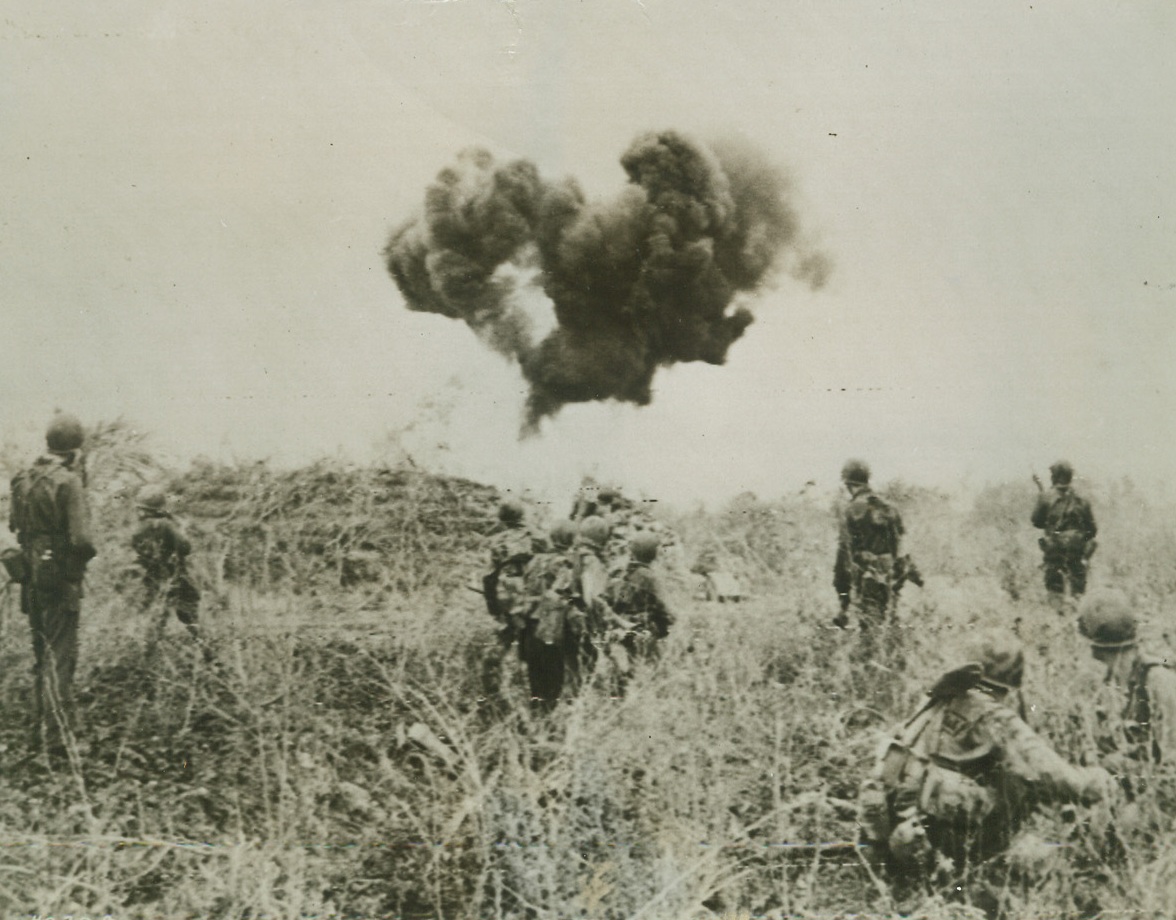
Flamethrowers at Work, 6/24/1944. Saipan, Marianas – US Infantrymen, creeping up on a Jap pillbox on Saipan, pause while a flamethrower disposes of the entrenchment. Although the Japs have been putting up fierce resistance, the Yanks have been making steady inroads into their territory. Today (June 24) fighting continues in the Garapan Area. Credit: Signal Corps Radiotelephoto from ACME;

Reinforcements Land On Saipan, 6/24/1944. Saipan – United States Army troops land from an LST to reinforce Americans battling Japs for possession of this key base in the Marianas. Yank forces are continuing their advance on the strategic island yesterday penetrating to the capital city in the Japanese Marianas meeting almost no opposition. Credit: Signal Corps Radiotelephoto from ACME;
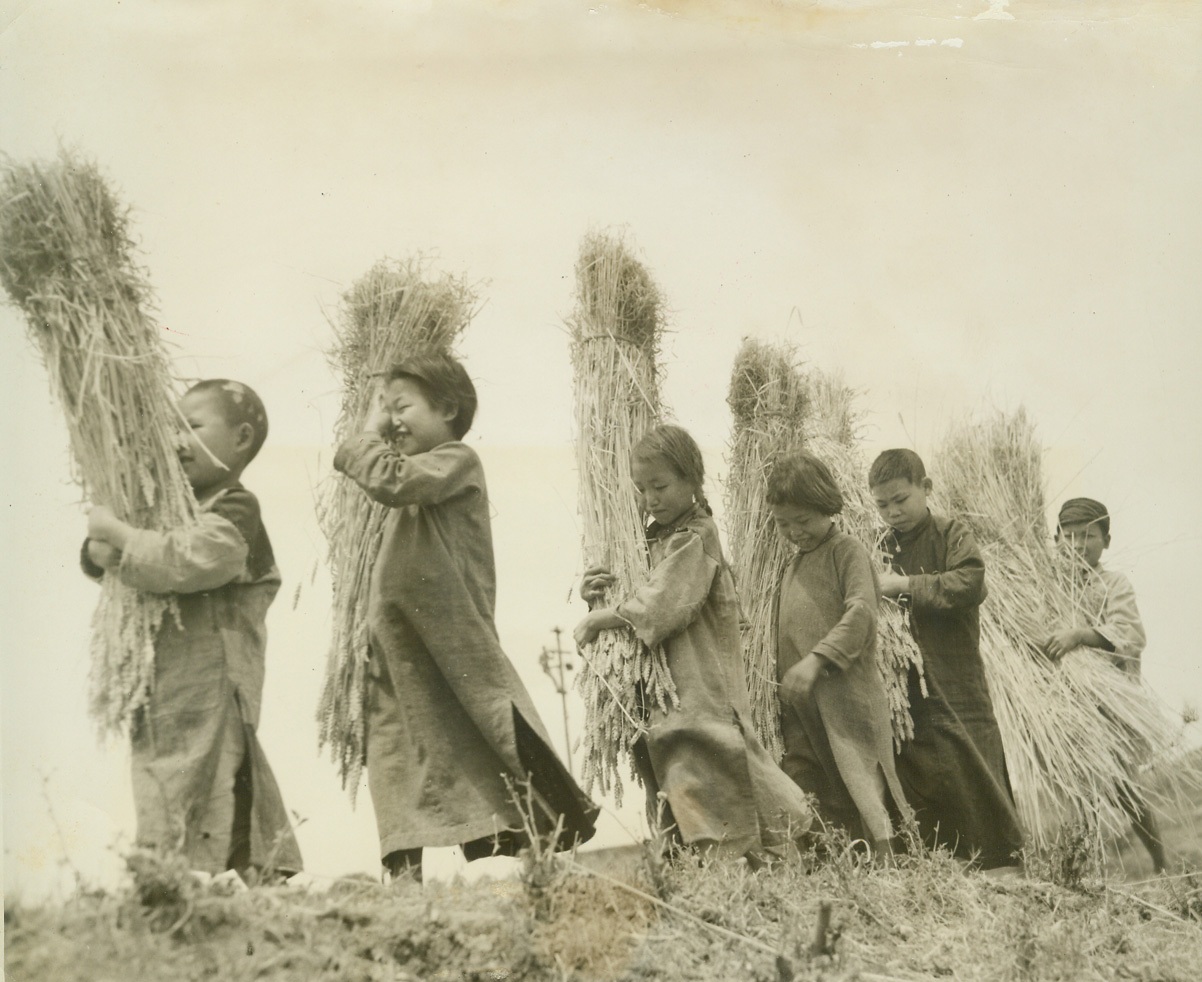
China Feeds American Warbirds, 6/20/1944. China – While many of their own suffer from the lack of food, China, nevertheless, has mobilized its agricultural resources to see that the American air and ground crews under Maj. Gen. Claire Chennault and comprising the 14th U.S. Army Air Force, are well fed. Their supplies limited almost solely to fuel, parts and equipment that are flown over “the hump” by the ATC planes because the Japs closed the Burma road, these Yank airmen must depend on food grown and processed in China, itself. But the Chinese, noble in their duty to an ally fighting in their own country against their enemy—the Jap—are responding to a degree far beyond the limits of ordinary hospitality. Using crude methods, nonetheless effective, the gallant Chinese are producing foodstuffs in ever-increasing quantities to meet the needs of constantly augmented U.S. units in China. With the bombing of the Japanese mainland by super fortresses, China has seen the beginning of the reward her people have been striving for – the complete neutralization of Japan as a militaristic world power. It was through the hard work of the Chinese in building bases and supplying food for the airmen of the huge B-29s, that this raid was possible. From these bases in China, it is believed, will come more and more raids on Nippon and, eventually, the all important attack preceding the invasion of the Japanese mainland. In this series of photos made by ACME War Pool photographer Frank Cancellare, Chinese farmers, their wives, and even their small children are shown as they labor to make the soil produce more – and yet more food so that the Americans fighting and flying for them, shall not go hungry. New York Bureau Have their definite jobs in Chinese farming, carry sheaves of wheat from the field to the communal village. Where it will be threshed by hand. Credit line (ACME photo by Frank Cancellare for the War Picture pool);
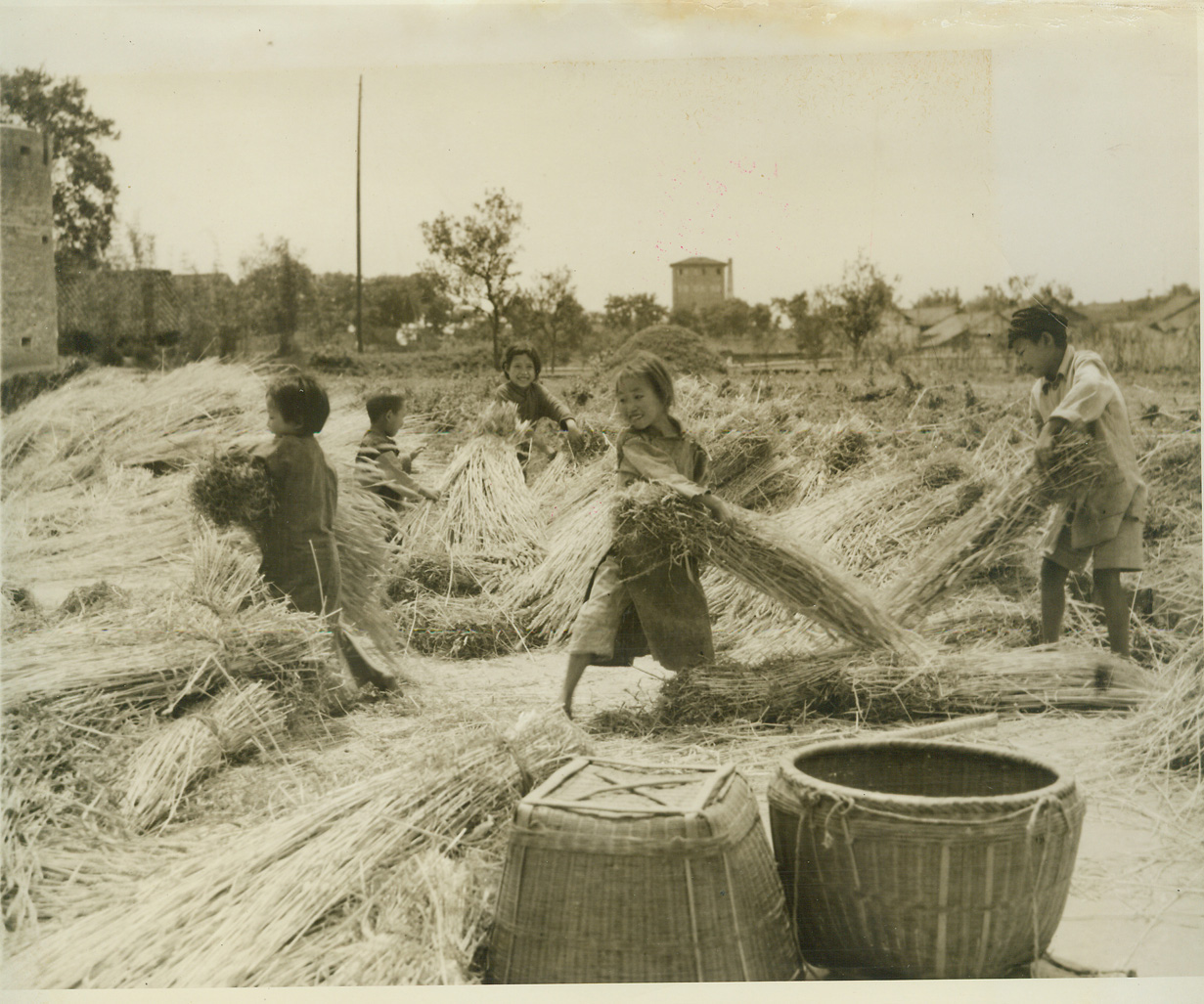
China Feeds American Warbirds, 6/20/1944. China – While many of their own suffer from the lack of food, China, nevertheless, has mobilized its agricultural resources to see that the American air and ground crews under Maj. Gen. Claire Chennault and comprising the 14th U.S. Army Air Force, are well fed. Their supplies limited almost solely to fuel, parts and equipment that are flown over “the hump” by the ATC planes because the Japs closed the Burma road, these Yank airmen must depend on food grown and processed in China, itself. But the Chinese, noble in their duty to an ally fighting in their own country against their enemy—the Jap—are responding to a degree far beyond the limits of ordinary hospitality. Using crude methods, nonetheless effective, the gallant Chinese are producing foodstuffs in ever-increasing quantities to meet the needs of constantly augmented U.S. units in China. With the bombing of the Japanese mainland by super fortresses, China has seen the beginning of the reward her people have been striving for – the complete neutralization of Japan as a militaristic world power. It was through the hard work of the Chinese in building bases and supplying food for the airmen of the huge B-29s, that this raid was possible. From these bases in China, it is believed, will come more and more raids on Nippon and, eventually, the all important attack preceding the invasion of the Japanese mainland. In this series of photos made by ACME War Pool photographer Frank Cancellare, Chinese farmers, their wives, and even their small children are shown as they labor to make the soil produce more – and yet more food so that the Americans fighting and flying for them, shall not go hungry. New York Bureau Enjoying themselves as though they were playing a game, Chinese children bundle wheat after it has been cut by hand. Note ancient blockhouses, (background), once uses as a defense against neighboring war lords and bandits. Credit line (ACME photo by Frank Cancellare for War Picture Pool);
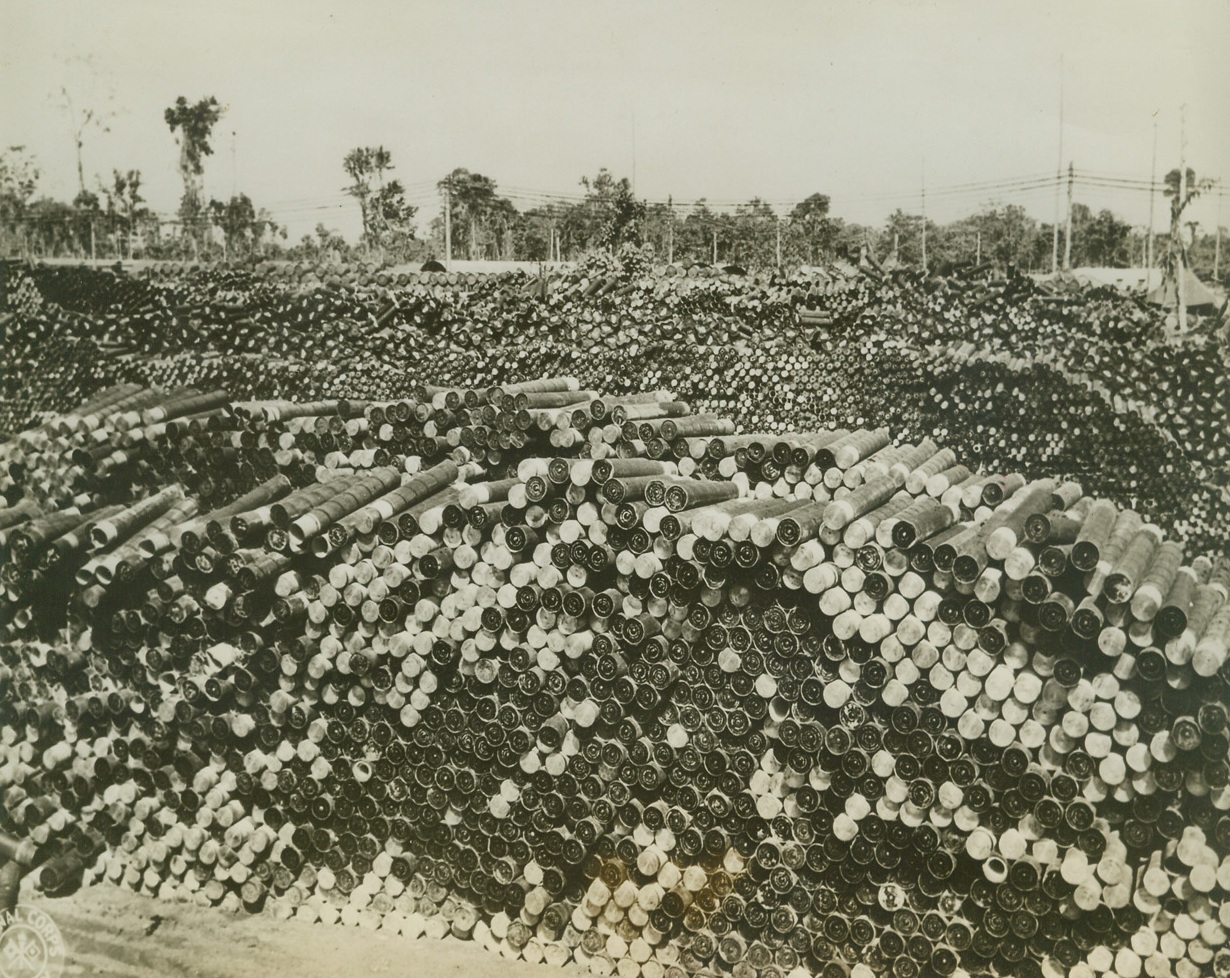
They’ve Delivered Their Sting, 6/16/1944. Bougainville, Solomons – This mass of empty artillery cases, reaped one upon the other, tells a mute tale of the ferocity of the allied attack on Bougainville. Thousands of Japs were killed during March and April, 1944, when they stormed US Army positions and were thrown back by rifle, machine gun, and shell fire. Credit (Signal Corps photo from ACME);

Blast Jap Bases in Marianas, 6/16/1944. Pacific – A bomber of the 7th Air Force flies over a group of islands, Jap strongholds, in the Marianas on its mission of destruction. Softening-up attacks on the island group preceded the invasion by American troops of Saipan yesterday. Credit (Signal Corps Radio telephoto from ACME);
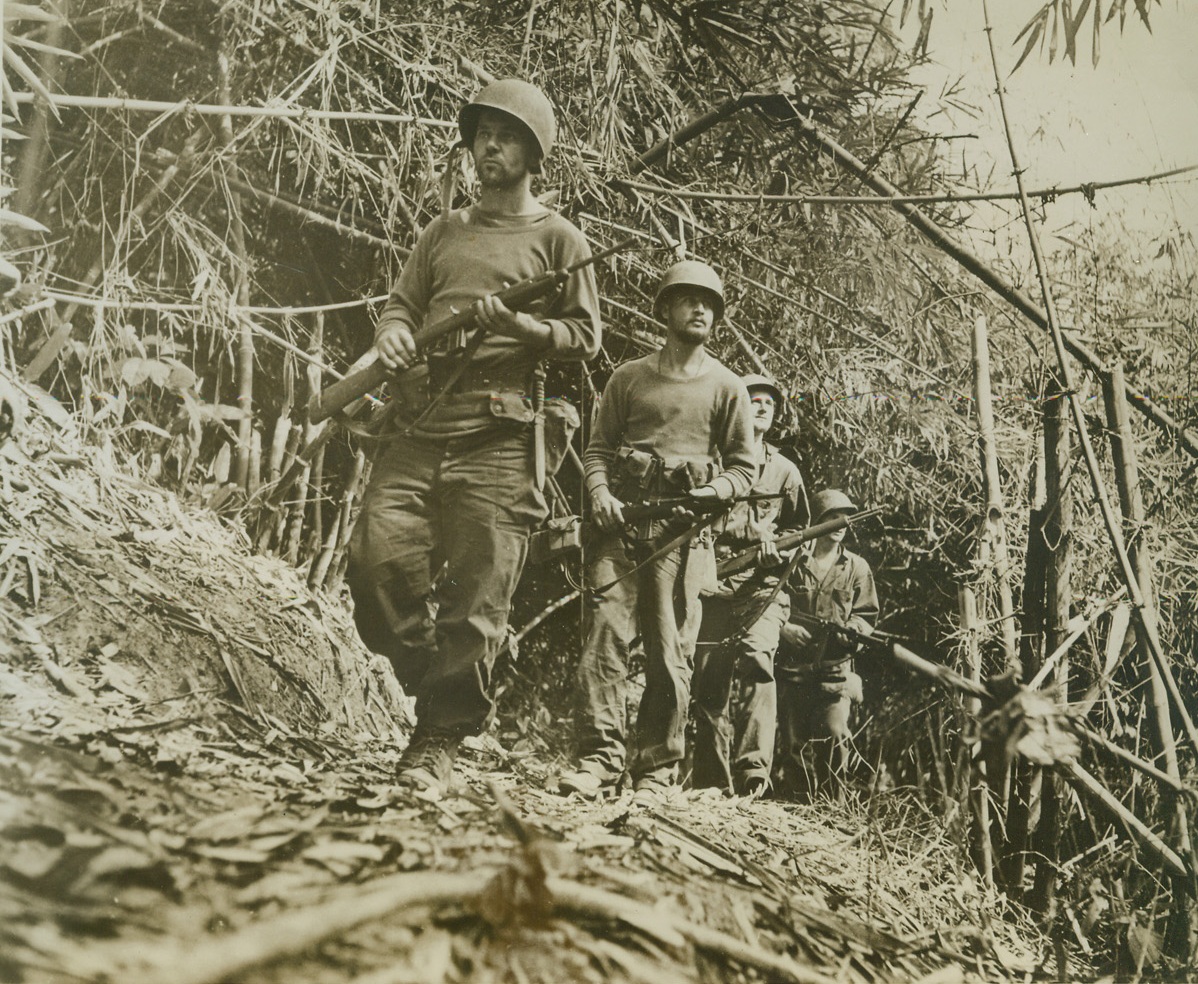
Headed for Trouble and Japs, 6/16/1944. Burma – Patrolling the jungles for Jap snipers, these four members of the famed Merrill’s Marauders are grim and determined as they go about their task. The jungle fighters are (left to right): Lt. Kenneth Bratlof, Cloquet, Minn.; Pvt. Anthony Callisto, Solvay, N.Y., Pvt. Sidney Block, Philadelphia, Pa.; and Pfc Harry Brabazon, also of Philadelphia, Pa. Marauders are now supers jungle fighters and casualties average one Marauder to fifty Japs. Credit – WP – (ACME);

Tuning Up for the Raid on Japan, 6/17/1944. Somewhere-In-India – B-29 bombers, America’s newest air armada were tuned up at a base somewhere in India ad from there started on their mission to bomb the steel center of Japan on June 15th. The photos were shipped from India on June 12th and were received in Washington, June 17th due to the expediting of the air transport command. This photo shows a B-29 receiving an engine exchange. Credit line (ACME photo by Frank Cancellare for the War Picture Pool);
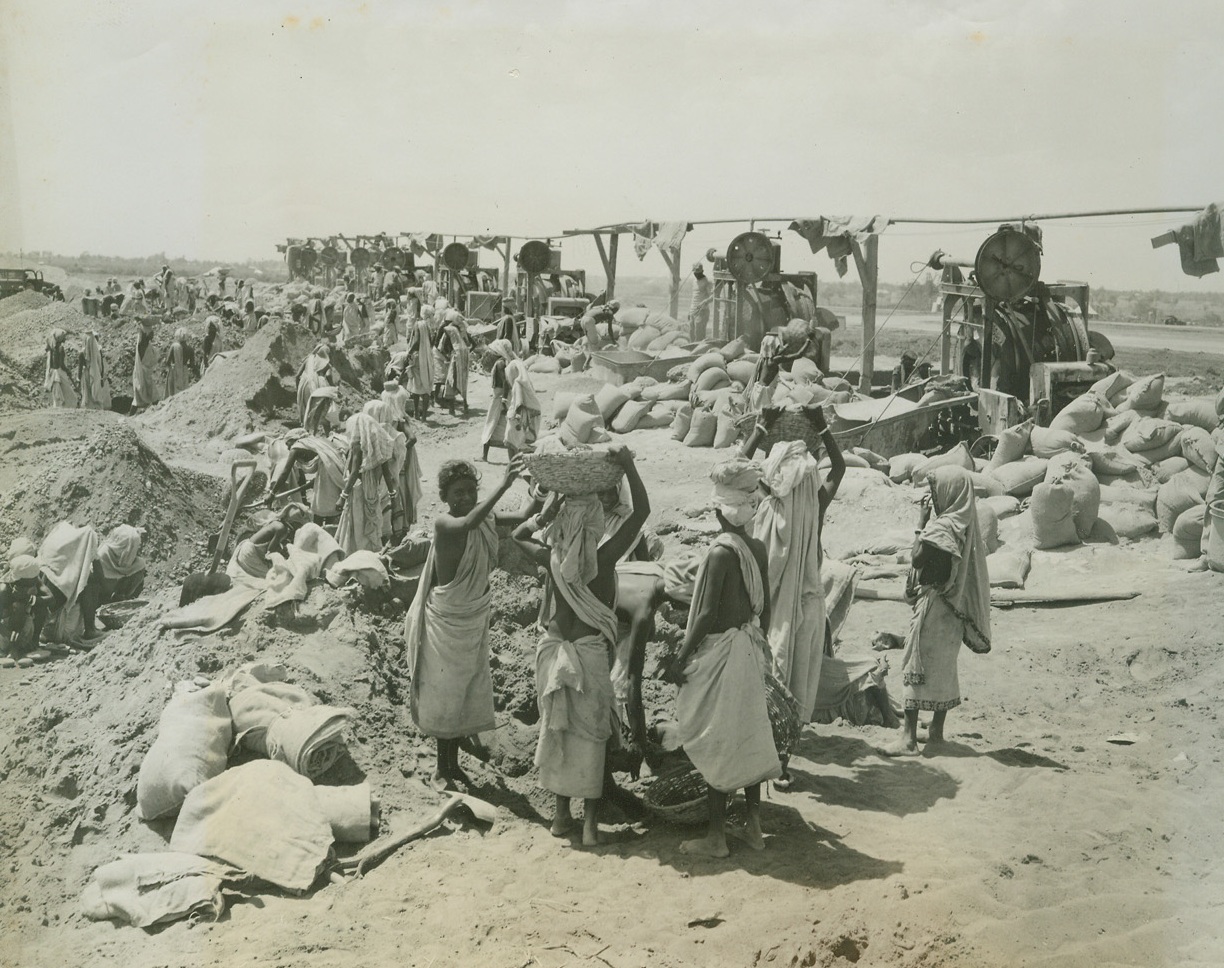
Indian Natives Enlarge Airport for Bombing of Japan, 6/17/1944. Somewhere-in-India, B-29 bombers, America’s newest air weapon were tuned up at a base in India and from there started on their mission to bomb the steel center of Japan on June 15th. The photos were shipped from India on June 12th and were received in Washington, June 17th due to the expediting by the air transport command. Here are the native Indian as they worked to enlarge the airport to provide the additional area necessary for the take-off of the super planes. Credit line (ACME photo by Frank Cancellare for the War Picture Pool);
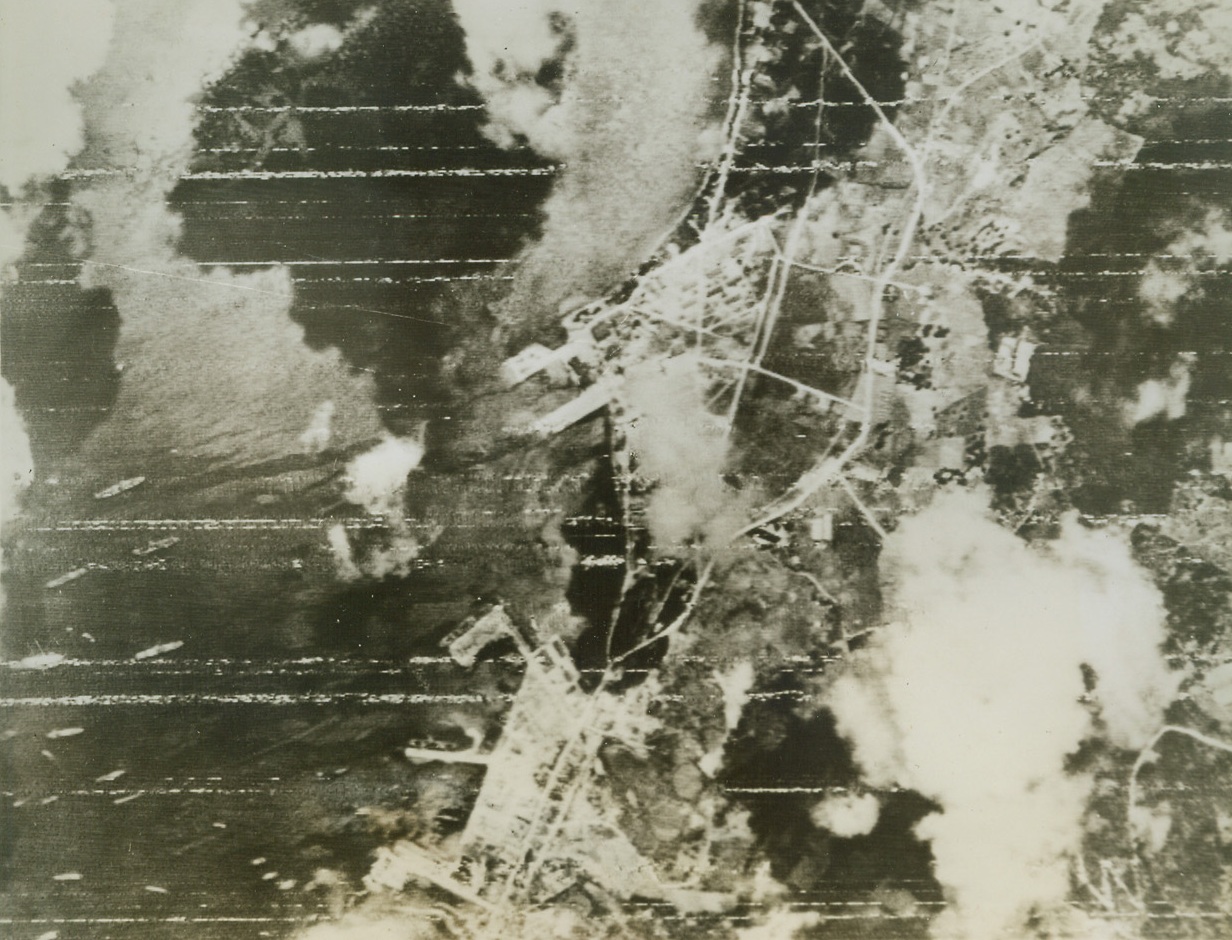
Air Attack Precedes Saipan Landing, 6/16/1944. Saipan, Marianas – This air view taken during the bombing attack preceding landings by US forces shows the seaplane base North of Flores Point. On the plane ramp are four 4-engined flying boats of the Mavis type. The harbor is cotted with warships, transports, and a sub. Heavy fighting continues in the Saipan area, and US forces have captured Agingan Point and are now battling for the town of Charan-Kanoa. Credit line (Signal Corps Radio telephoto from ACME);
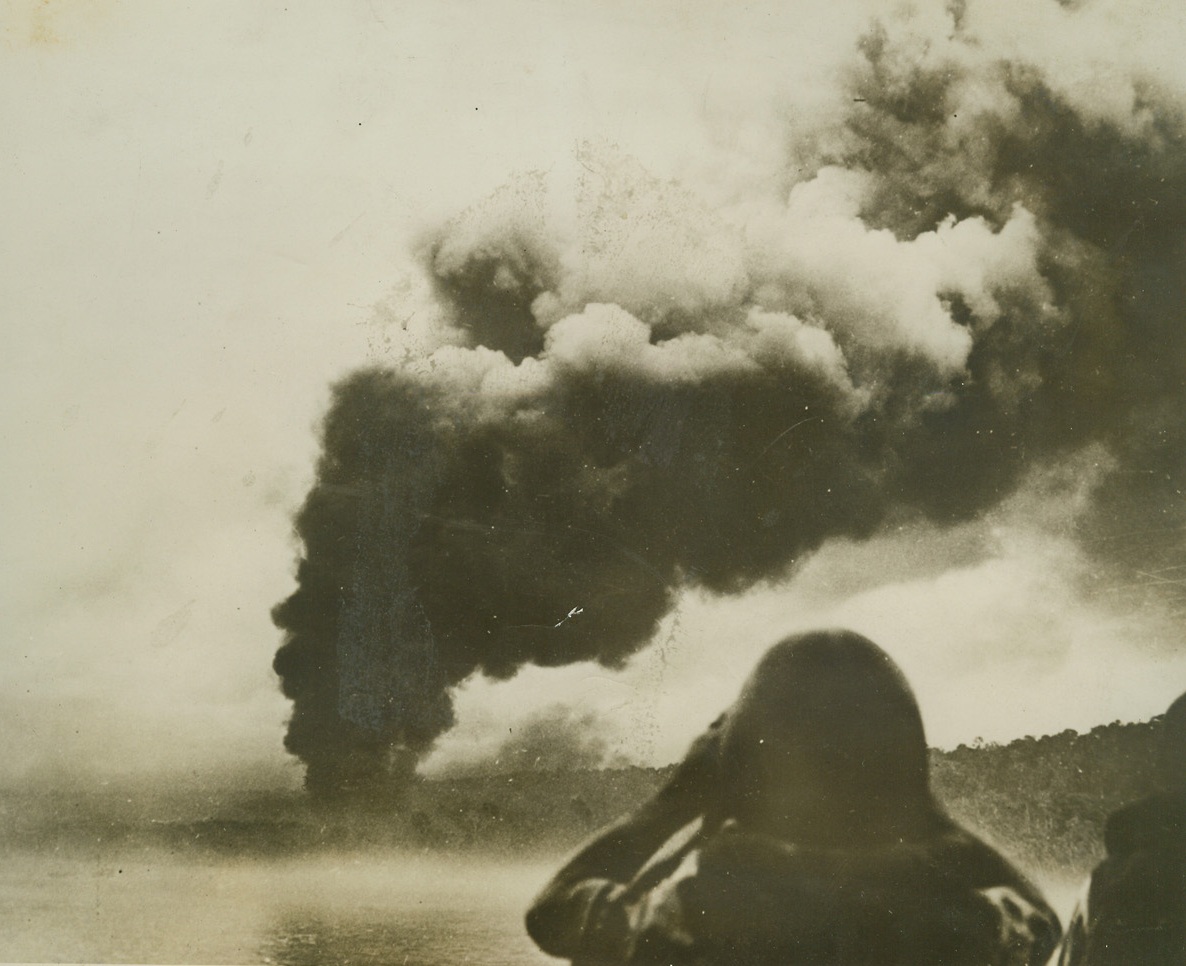
As Yanks Prepared Biak Landing, 6/14/1944. Columns of dense, black smoke rise from burning installations on tiny but strategic Biak Island in the Netherlands Indies, as U.S. Navy ships pound the Jap base as a part of landing operations last May 27th. In the foreground a lookout carefully scans the skies watching for enemy planes which might use the smoke for cover in a strafing dive. Credit line (U.S. Navy photo from ACME);
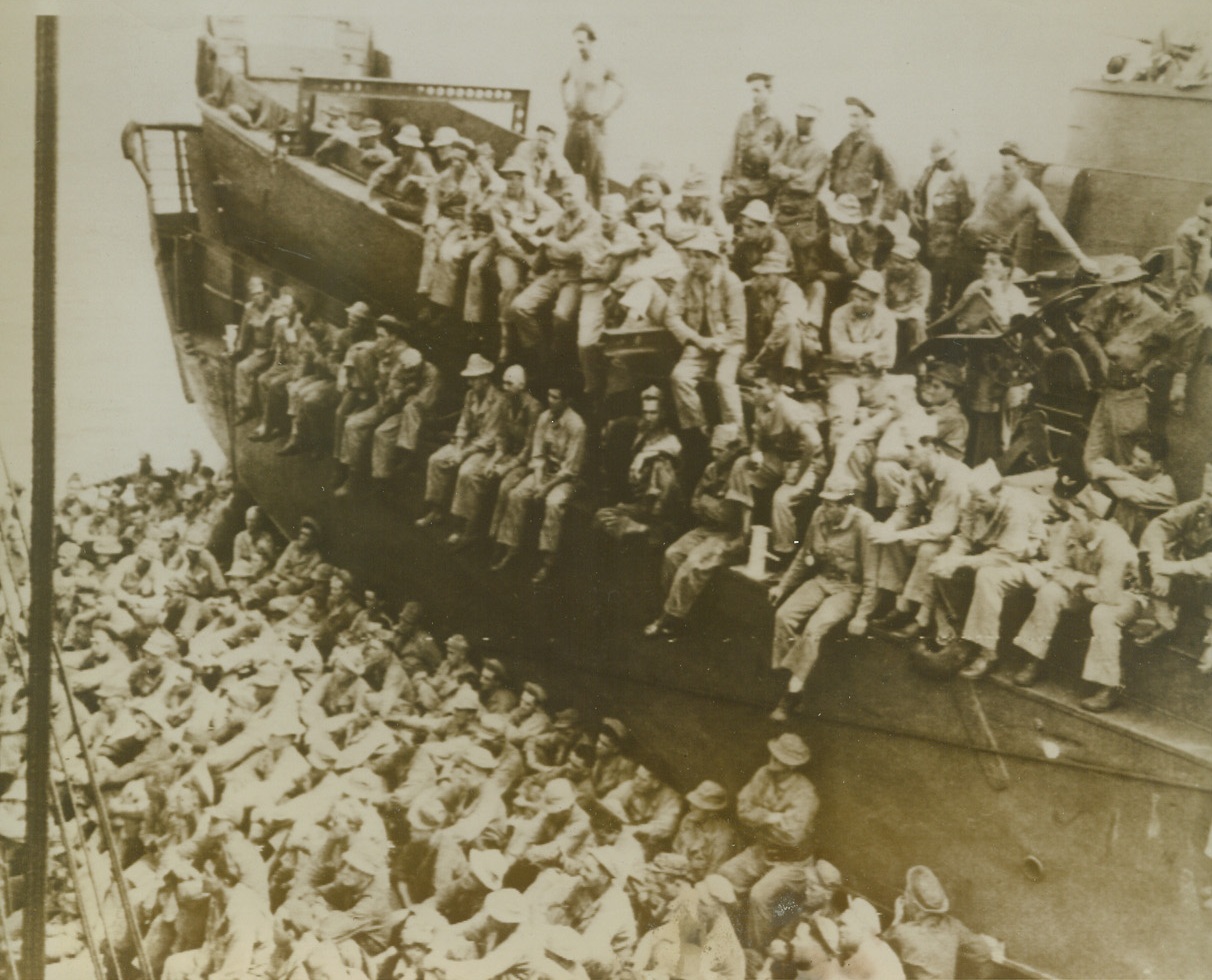
Invasion Briefing, 6/18/1944. At Sea – en route to the Marianas for the invasion of Saipan, where fierce fighting is now in progress, soldiers listen to instructions given them aboard a combat transport. Photo was flashed to the U.S. from Hawaii. Credit (Signal Corps radio telephoto from ACME);
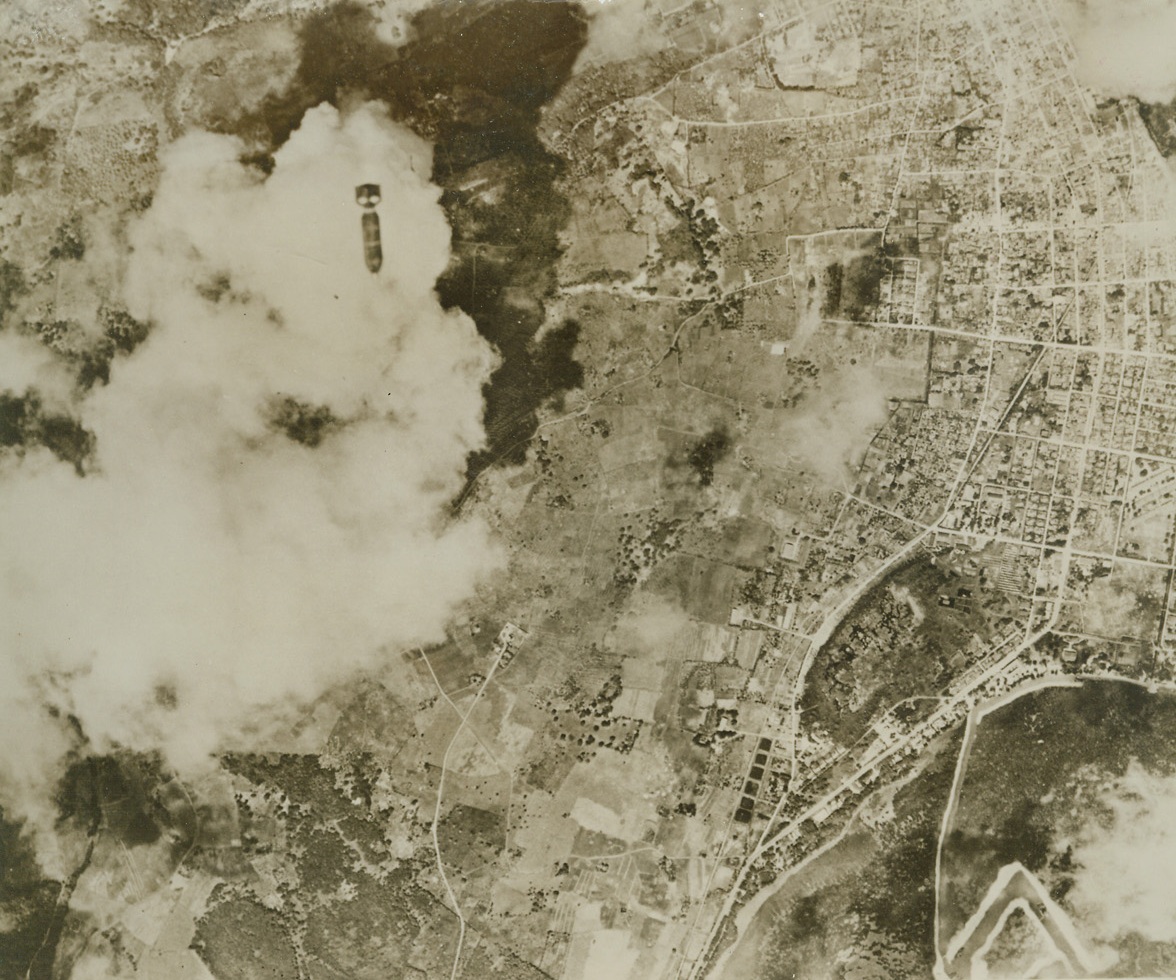
Blast Saipan Harbor, 6/17/1944. Saipan Islands – a bomb from a Navy bomber of the Pacific fleet falls on Japanese installations at Tanapag Harbor on Saipan island in the Marianas. Odd design in lower left-hand corner is a dredging channel and small boat basin. American troops on Saipan have succeeded in extending their bitterly fought for beachheads and have beaten back a Jap counterattack. Credit (US Navy photo from ACME);
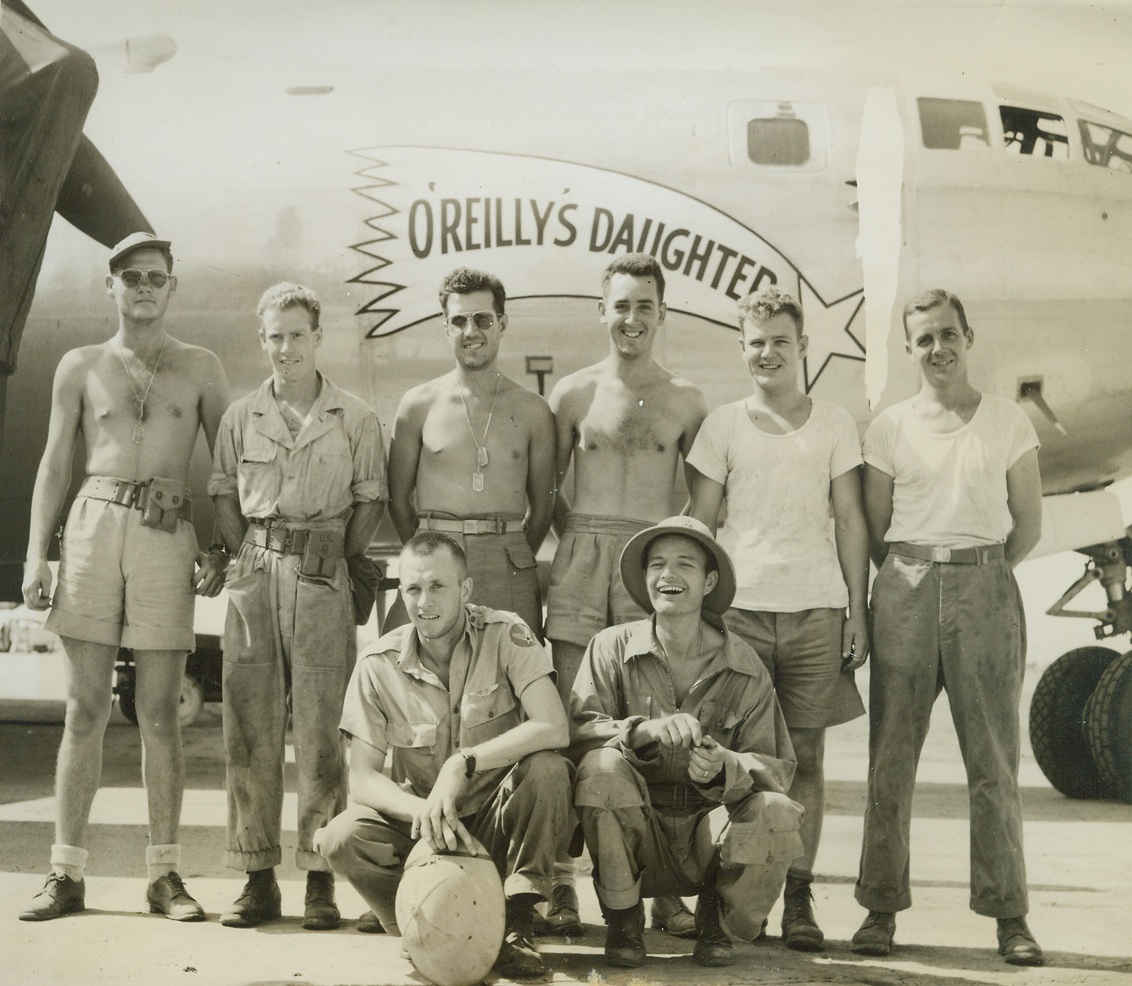
“O-Reilly’s Daughter: Raring to Go, 6/18/1944. China – The crew of “O’Reilly’s Daughter”, named after the song so popular with Air Corpsmen, is mighty proud of the success of the raid staged on Japan by B-29 superfortresses in their maiden operational flight. Winging over the Japanese mainland on June 15, these gigantic planes of the 20th bomber command had as their main target Yawata, important steel center. They also attacked Kokura and Moji. Left to right, standing; Sgt. William beckham, radar, Albany, Ga.; Sgt. Rollin Heffernan, gunner, Apollo, Pa.; Sgt. W. Alpaugh, radio, Rockford, Ohio; Sgt. E. Brandaze, gunner, Pittsfield, Mass.; Sgt. Grandville Adams, gunner, Messick, Va.; and Sgt. J. Meechan, gunner, Cleveland, Ohio. Kneeling, left to right: Capt. E. Winkler, co-pilot, Ogden, Utah, and Capt. Louis Wedel, bombardier, Hereford, Texas. Credit (ACME photo by Frank Cancellare, War Pool correspondent);

Crew of “Superfortress”, 6/18/1944. China – It has now been established that the new B-29 superfortresses of the 20th bomber command which rocked Japan recently flew from a Chinese base. Before taking the bombers on the maiden mission, crews had been thoroughly trained in manning these super aircraft, different from any heavy planes manufactured thus far in the war. Here is one of the crews of a B-29. Left to right, standing on ground an ladder: Sgt. B. Patterson, gunner, Oil City, Pa.; Sgt. J. Chobot, gunner, Dearborn, Mich.; Sgt. D. Nebeker, Jr. guner, Salt Latke City, Utah; Sgt. D.G. Hales, crew chief, Corsicana, Tex., Sgt. J.S. Parto, Radio operator, Hazelton, Pa.; Sgt. R.B. Moble, radio, Williamsburg, Pa.; and Sgt. M.P. Plant, gunner, Long view, Wash. Standing in the center of the ladder is flight officer J.C. Martin (English), Sweetwater, Tec. Kneeling, left to right; Maj. H.R. Brown, pilot, Ardmore, Tenn.; lt. W. Stern, bombardier, Rockford, Ill.; Lt. J. Goeringer, co-pilot, Fresno, Calif.; and Lt. A.C. Beach, navigator, Morgantown, Pa. Credit (ACME photo by Frank Cancellare, War Pool correspondent);
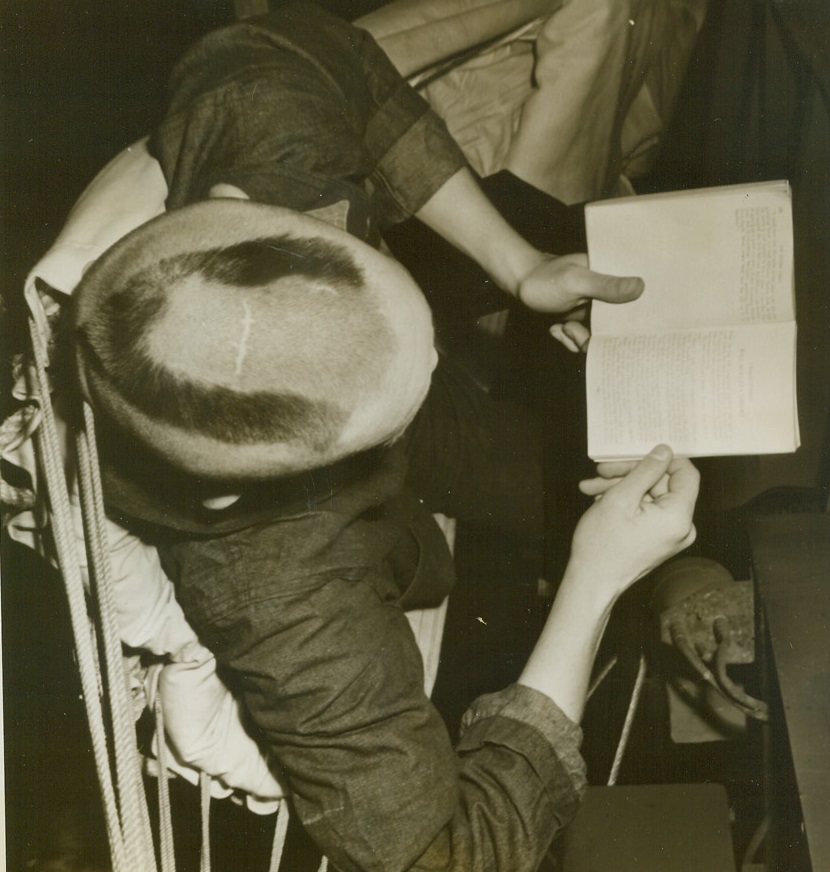
Shorn of His Locks, 6/19/1944. Somewhere in the Pacific – Mrs. Ducy would never recognize her son Seaman 2/c Bob Ducy, Hartford City, Ind., with all his brunette locks shorn into one forlorn “V”. Seaman Ducy is aboard an aircraft carrier loaded with supplies and equipment for a naval station somewhere in the Pacific. Credit (ACME photo by Stanley Troutman, War pool correspondent);
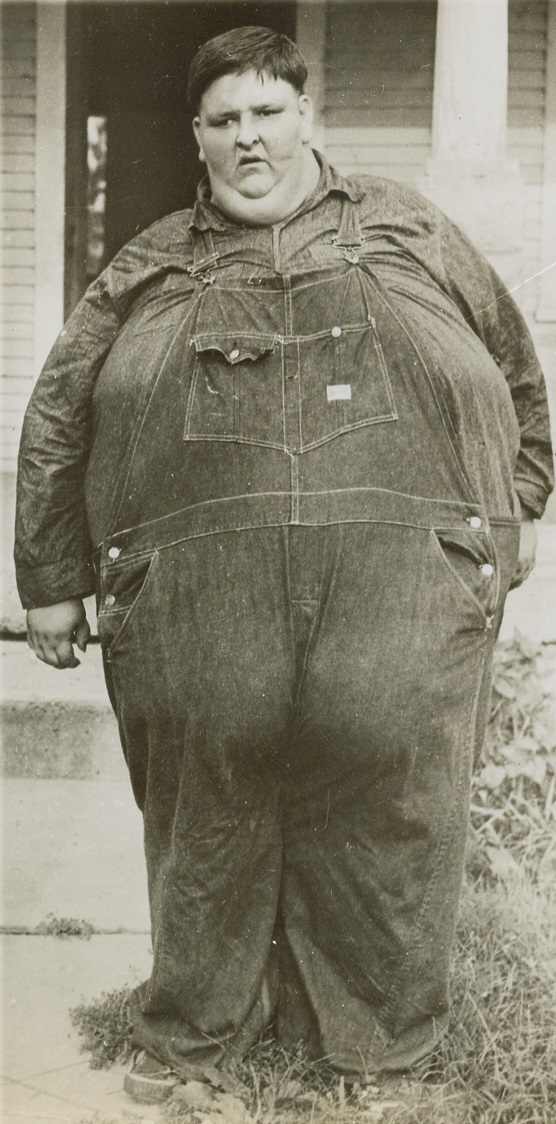
Just Call Me “Chubby”, 6/9/1944. Mt. Sterling, Ill. – Robert Hughes, 18, of Mt. Sterling, Ill., weighing 709 pounds, is the heaviest draft registrant in the country. Officials said his excessive weight would probably keep him out of service. He has a waistline of 95 inches. Credit line ACME;
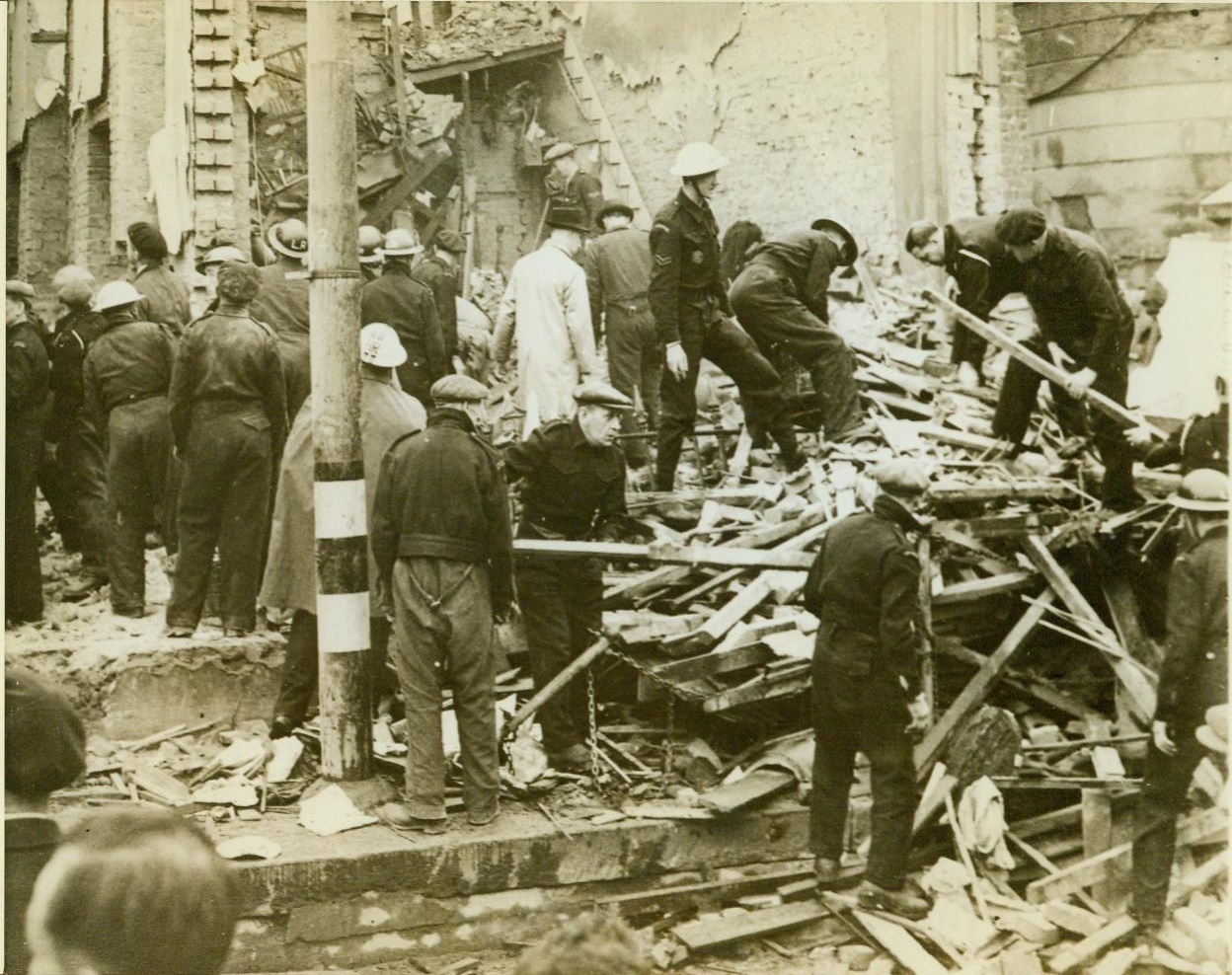
Damage done by pilotless plane, 6/19/1944. SOUTHERN ENGLAND – Rescue workers search the ruins of robot-bombed shops in southern England after an attack by German pilotless planes. It was disclosed today that the Nazi high command intended to send their demon ships into action at four times the strength with which they are attacking. Six months of ceaseless bombing of the pilotless plane launching platforms changed Hitler’s plans. CREDIT LINE (ACME);
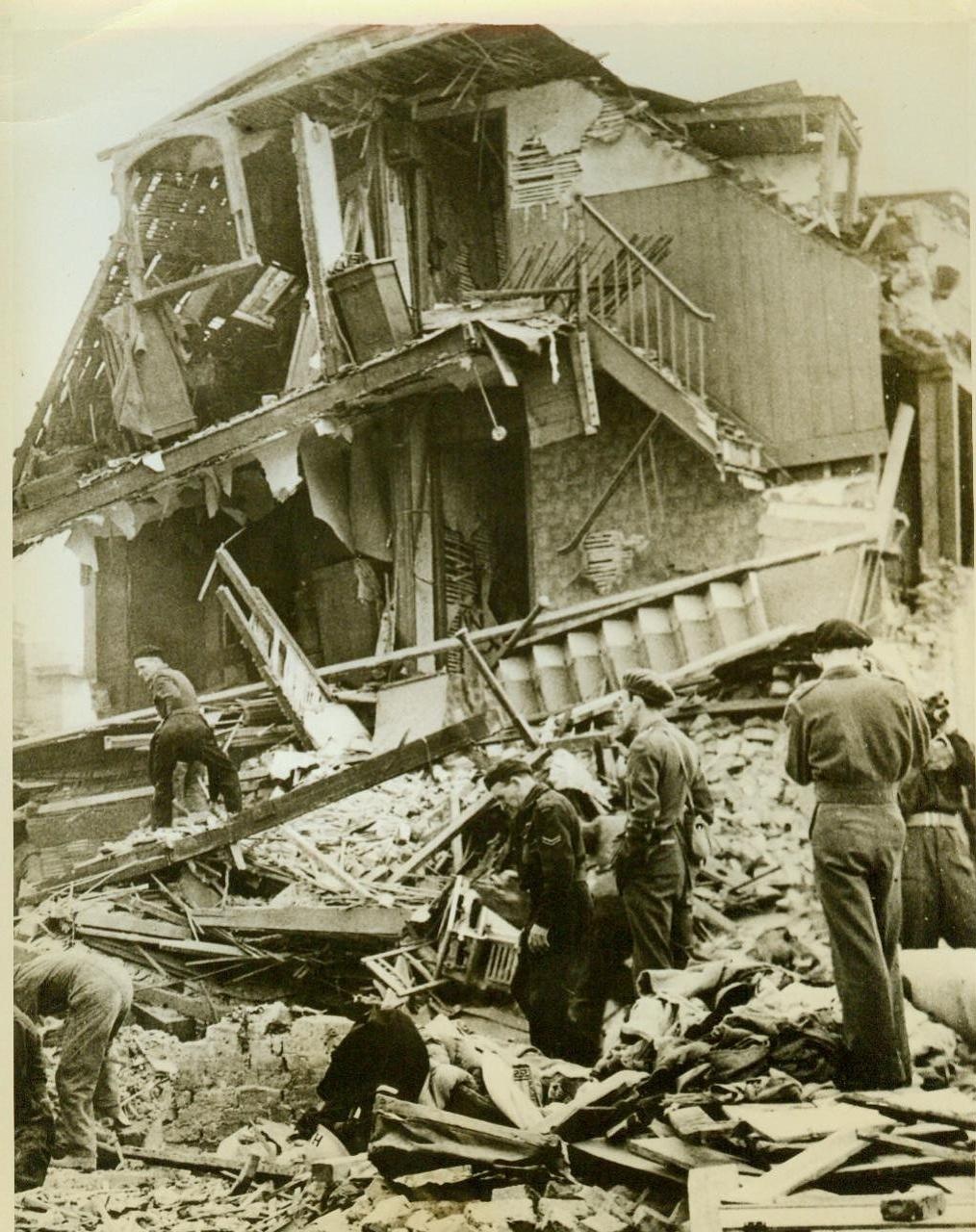
Hunt for victims of robot planes, 6/19/1944. SOUTHERN ENGLAND – Combing the ruins of a home in southern England, rescue workers hunt for possible victims of a raid by the Nazi pilotless plane. The demon ship, sent across the Channel from one of the few robot launching platforms still left after Allied bombings, left this scene of destruction in its wake. CREDIT LINE (ACME) 6/19/44;
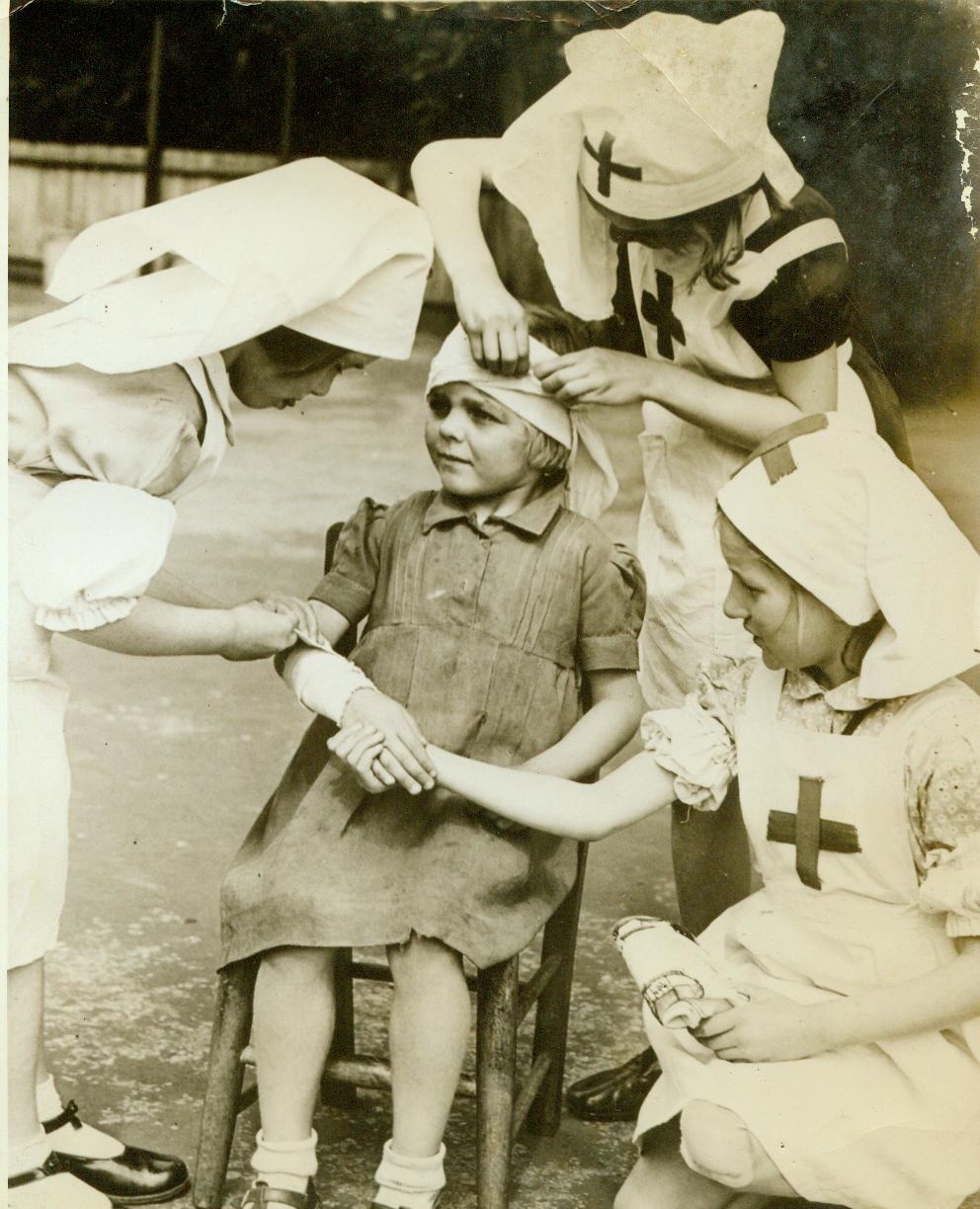
Youthful pill-pushers, 6/19/1944. ENGLAND – Dolls and building blocks have no lure for the young children at school in Beddington, Surrey. The study of first aid occupies all their time, and the youngsters are given instruction in the rudimentary functions. Here, three earnest little nurses attend a “patient”. Left to right: Ann Moon, 6; Patient Janet North, 5; Julia Walls, 7’ and Sheila Webb, 6. CREDIT (ACME) 6/19/44;
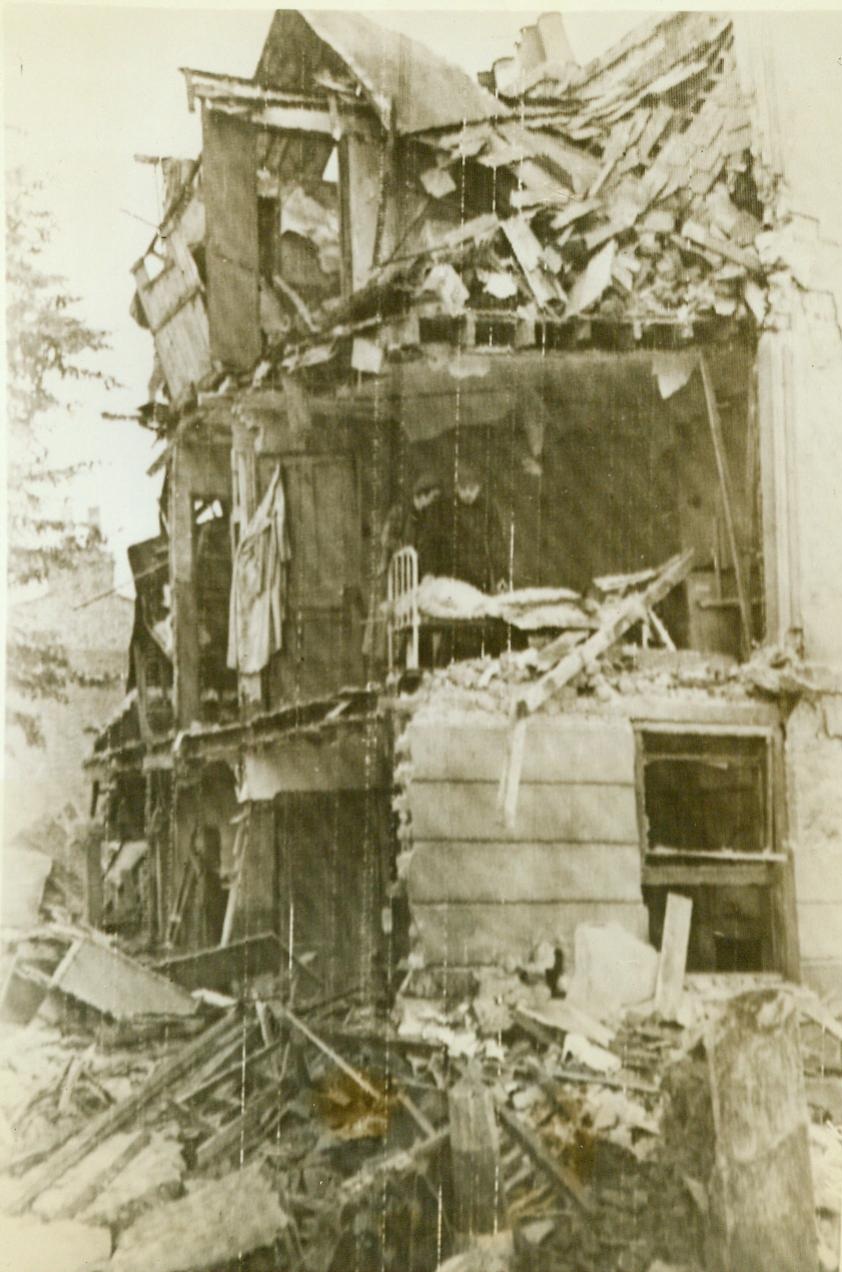
Nazi “robot planes” attack England, 6/17/1944. ENGLAND – Amid this shambles which was once a house in southern England, former residents search for their belongings which they left behind in their hurried evacuation of the area. Last night (June 16) the pilotless planes attacked England again, but on a smaller scale than the preceding raid. The aerial weapons are believed to be either rocket or jet-propelled. CREDIT (Signal Corps Radiotelephoto from ACMA) 6/17/44;
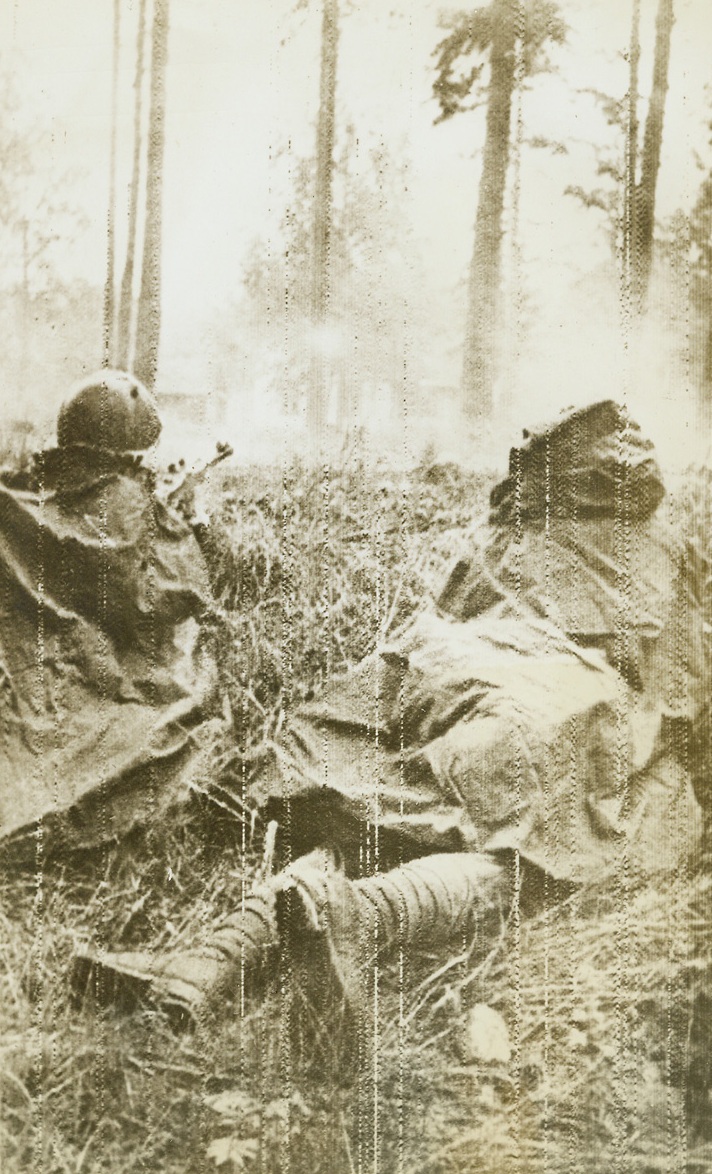
Red Army in Finnish Drive, 6/14/1944. Karelian Isthmus—The Red Army, storming its way into Finland, continues to advance along the narrow Karelian front. Crack Finnish units, fighting stubbornly behind formidable fortifications, have slowed its progress slightly. Yesterday the Soviets reported a gain of six miles. Camouflages Soviet infantrymen fire from a wooded area as they dislodge Finnish tommygunners from houses on the outskirts of Terrioki. Credit: ACME radiophoto.;
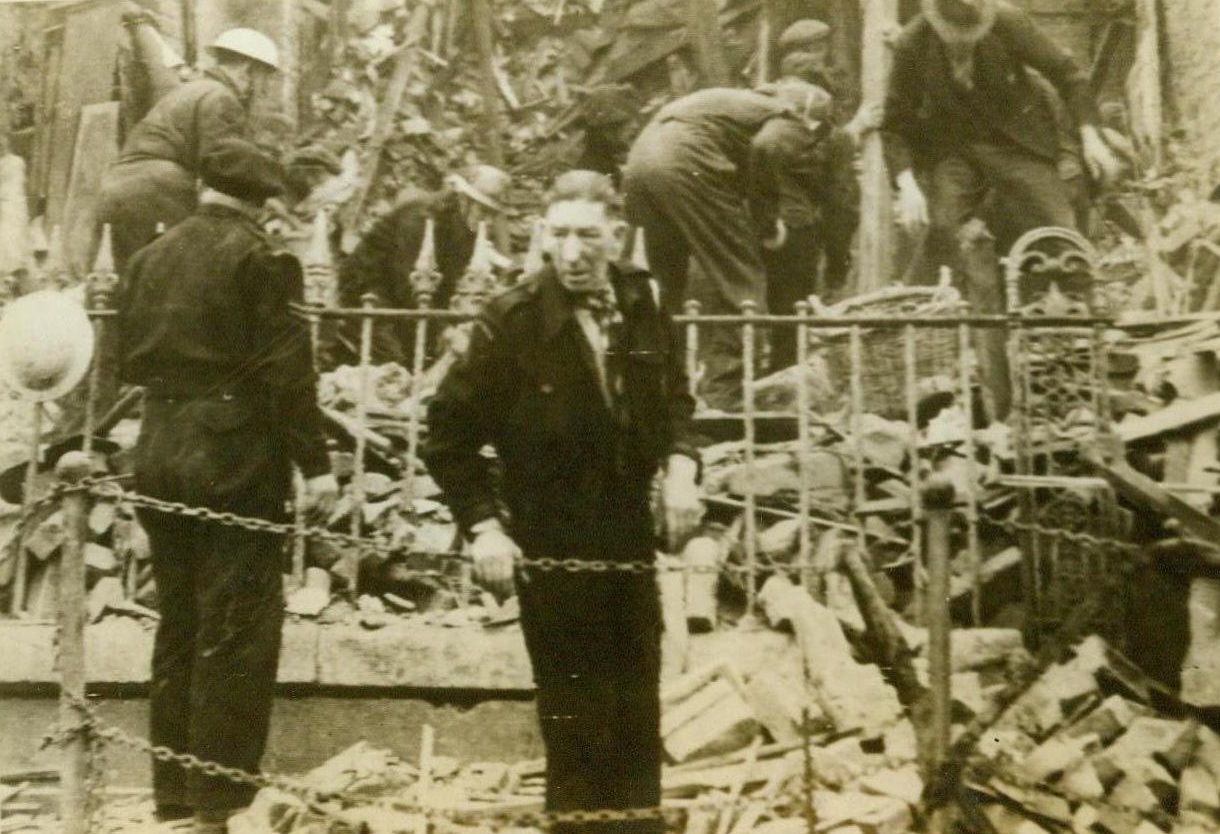
Hit by pilotless plane, 6/16/1944. ENGLAND – In a desperate effort to stem the tide of warfare, swinging in the favor of the Allies in France, Hitler sent his “secret weapon” – robot planes – on its mission of destruction in England. Rescue workers search the debris of this wrecked house in southern England for buried family. Yesterday flocks of the ghostly, pilotless planes bombed Britain. CREDIT (Signal Corps Radiotelephoto from ACME) 6/1/44;
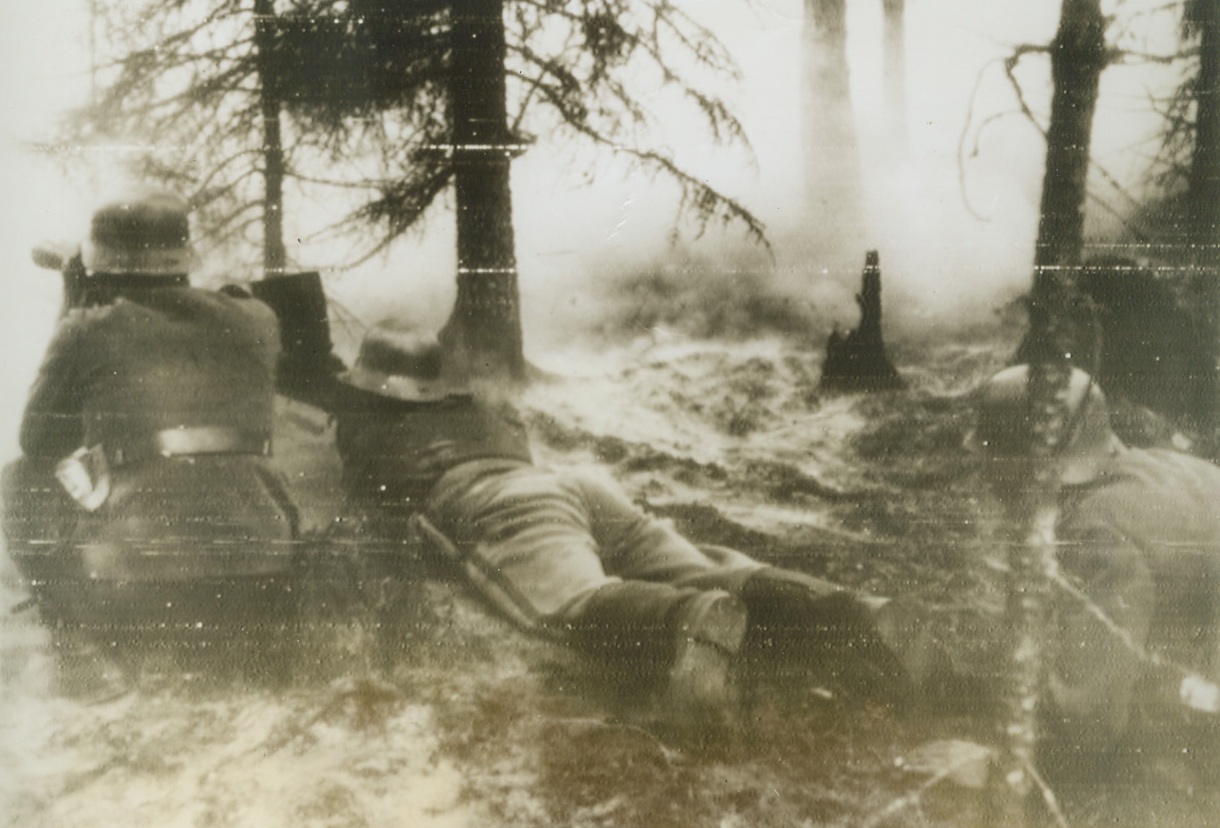
Fins Battle Russian Troops, 6/16/1944. According to the caption accompanying this photo, approved by Finnish censors and radioed today from Stockholm, these soldiers are members of a Finnish anti-tank unit at Vammelsuu, where Russian attacks have been halted in bitter fighting. Credit: ACME radiophoto.;
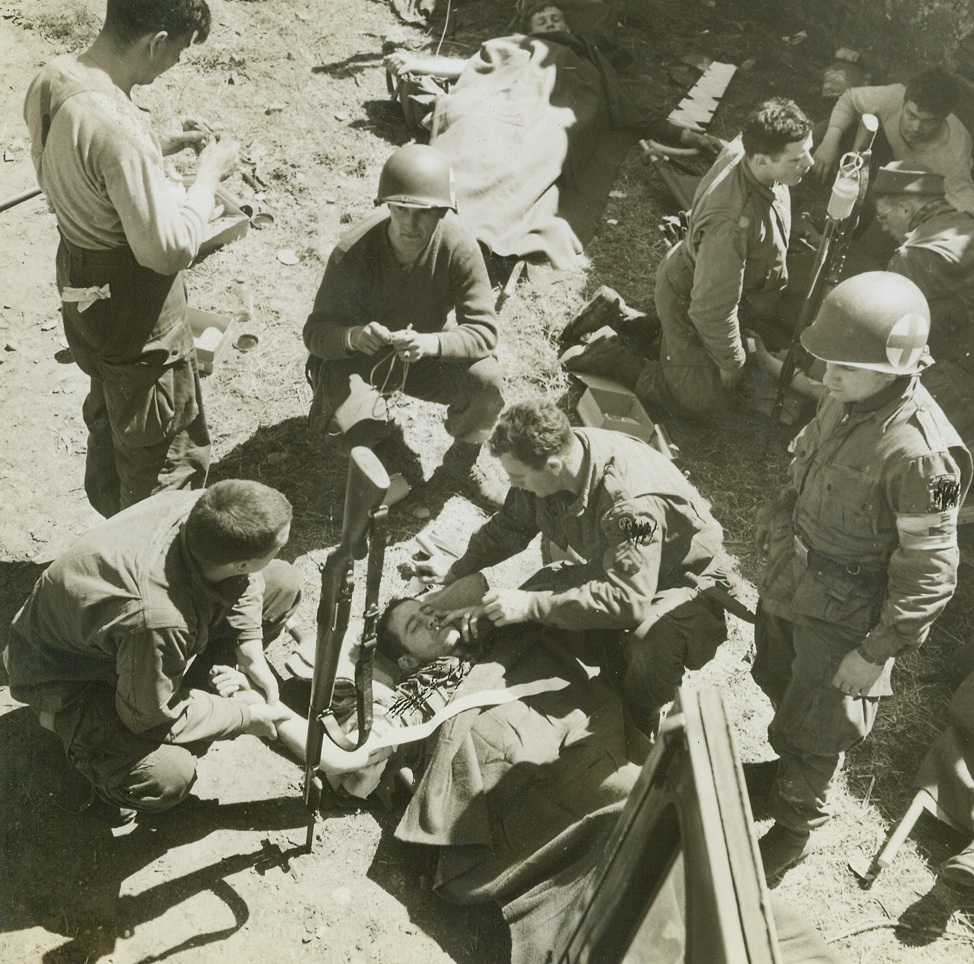
Wounded Warriors, 6/23/1944. St. Sauveur, France—With his rifle stuck in the ground at his side, this American soldier receives medical attention after the battle for St. Sauveur was over, and the town won. In the upper right another wounded man is receiving plasma with the transfusion apparatus stuck on his rifle. Credit: ACME photo by Andrew Lopez, War Pool Correspondent.;
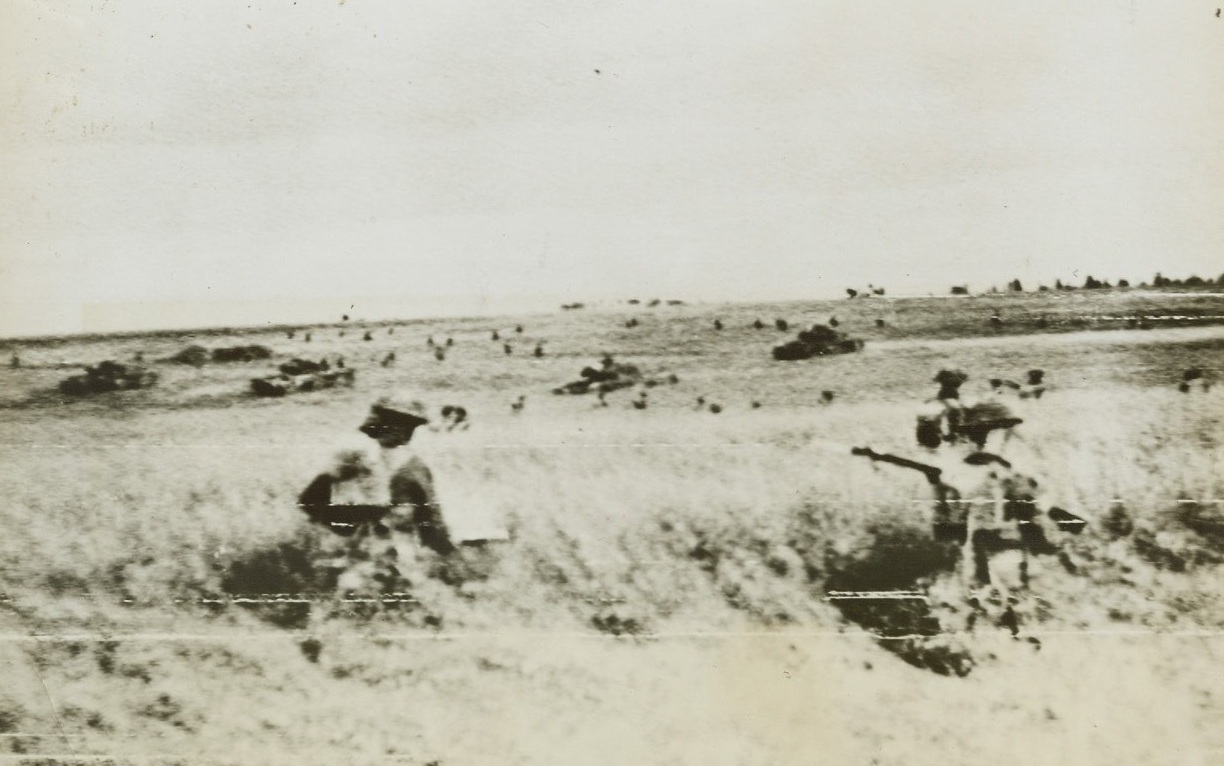
British Advance Near Caen, 6/30/1944. France—British tanks and infantry advance across a cornfield near Caen, France to widen the gap torn in the enemy defenses. A great armored battle is raging south of Caen as British drove on toward the Orne River. Reports from the front state that the enemy is putting up his most desperate defense since American troops cut the Cherbourg Peninsula. Credit: British war office photo via Signal Corps radiotelephoto from ACME;
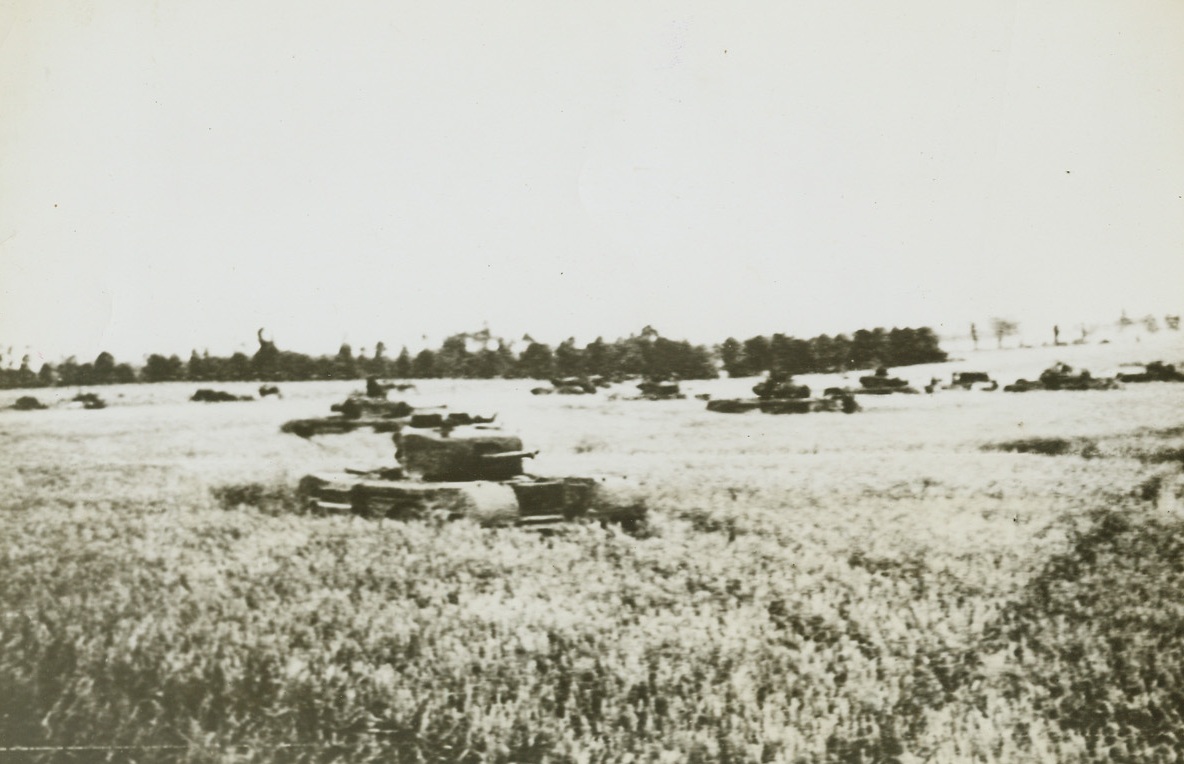
Tanks Charge to Battle, 6/30/1944. France—British tanks dash across a cornfield in France to engage German armored forces in what may amount to the decisive battle for the key city of Caen. German broadcasts have stated that the British drive represented “a gigantic attempt to cut off and capture Caen.” Credit: British war office photo via Army radiotelephoto from ACME.;
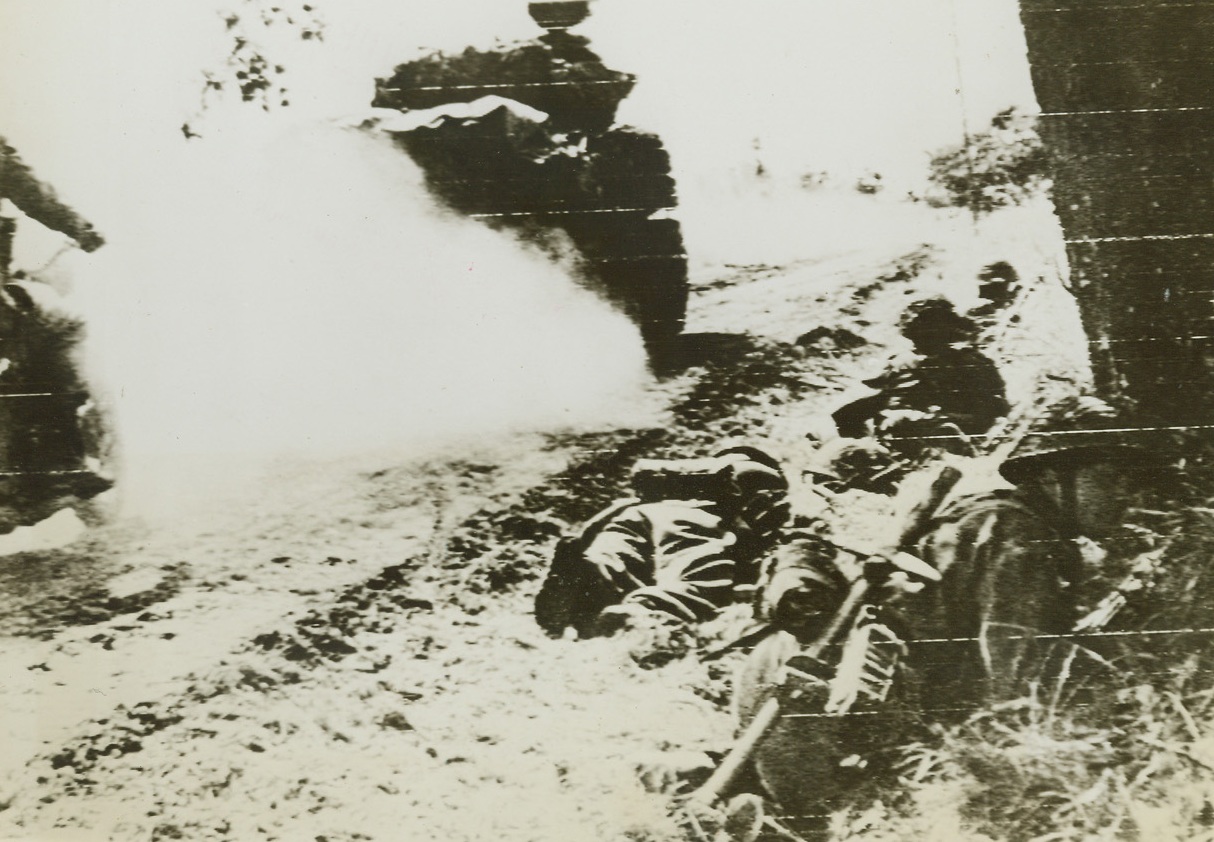
Speeds to Battle, 6/30/1944. France—A Sherman tank followed by a dispatch rider pass British infantrymen using a ditch for shelter while holding positions on a roadside between Tilly and Caen. Headquarters has announced that 60 German tanks have been knocked out in the racing battles around Caen. Credit: US Army radiotelephoto from ACME.;

Enemy Demolition Go Hang, 6/29/1944. England—A Bailey Bridge, new U.S.-British war creation proving of immense value to Allied operations and an answer to enemy demolition, is shown being constructed across a river in England. Parts of the bridge, built both in the U.S. and England, are interchangeable and can be speedily put together. It was invented by Mr. D.C. Bailey of the Ministry of Supply. Credit: British official photo from ACME.;
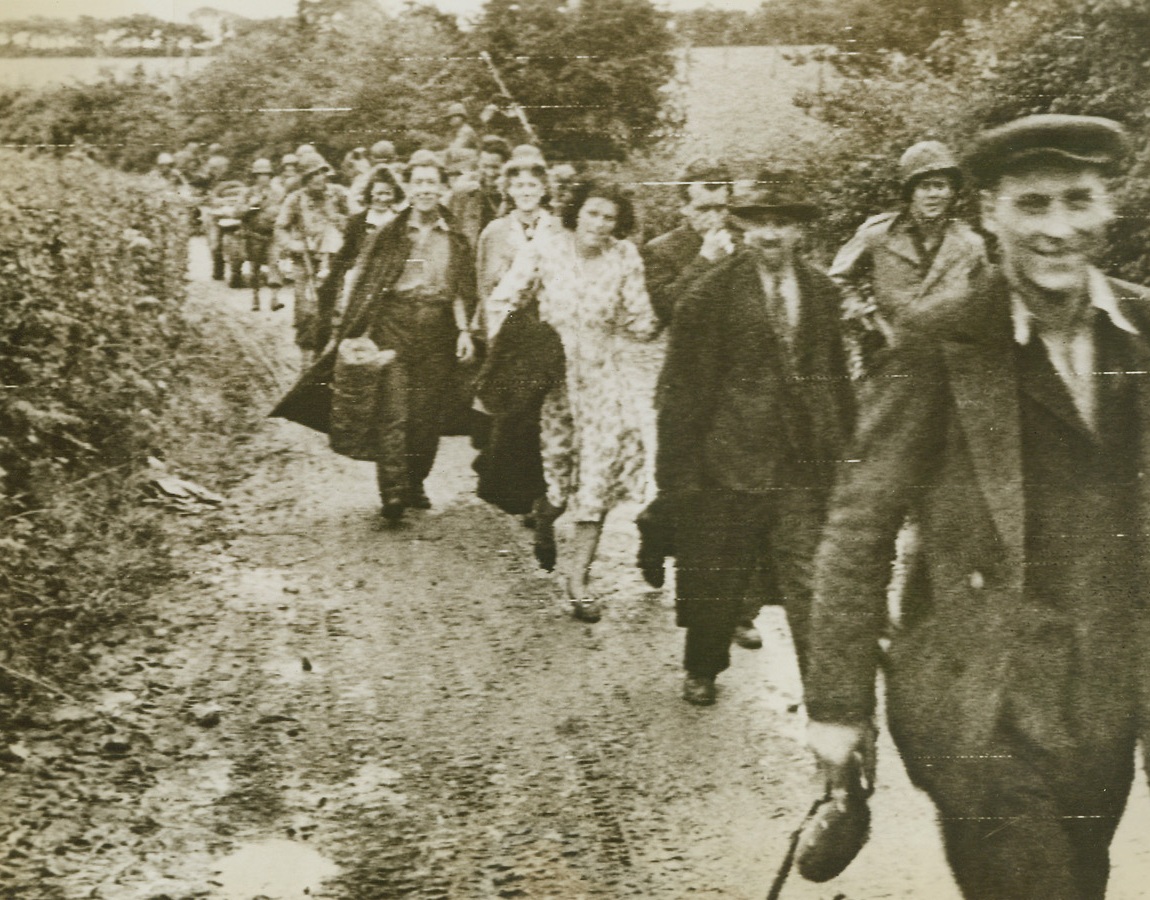
Bound for Home, 6/29/1944. Cherbourg, France—Homeward bound, smiling French civilians trek back to the ruins of their houses in liberated Cherbourg after the vital city had been occupied by American troops. Although each fears that his home may not be there when he reaches it, the Frenchmen still smile, glad that they no longer have to worry about war being fought on their doorsteps. Credit: ACME photo via Army radiotelephoto.;
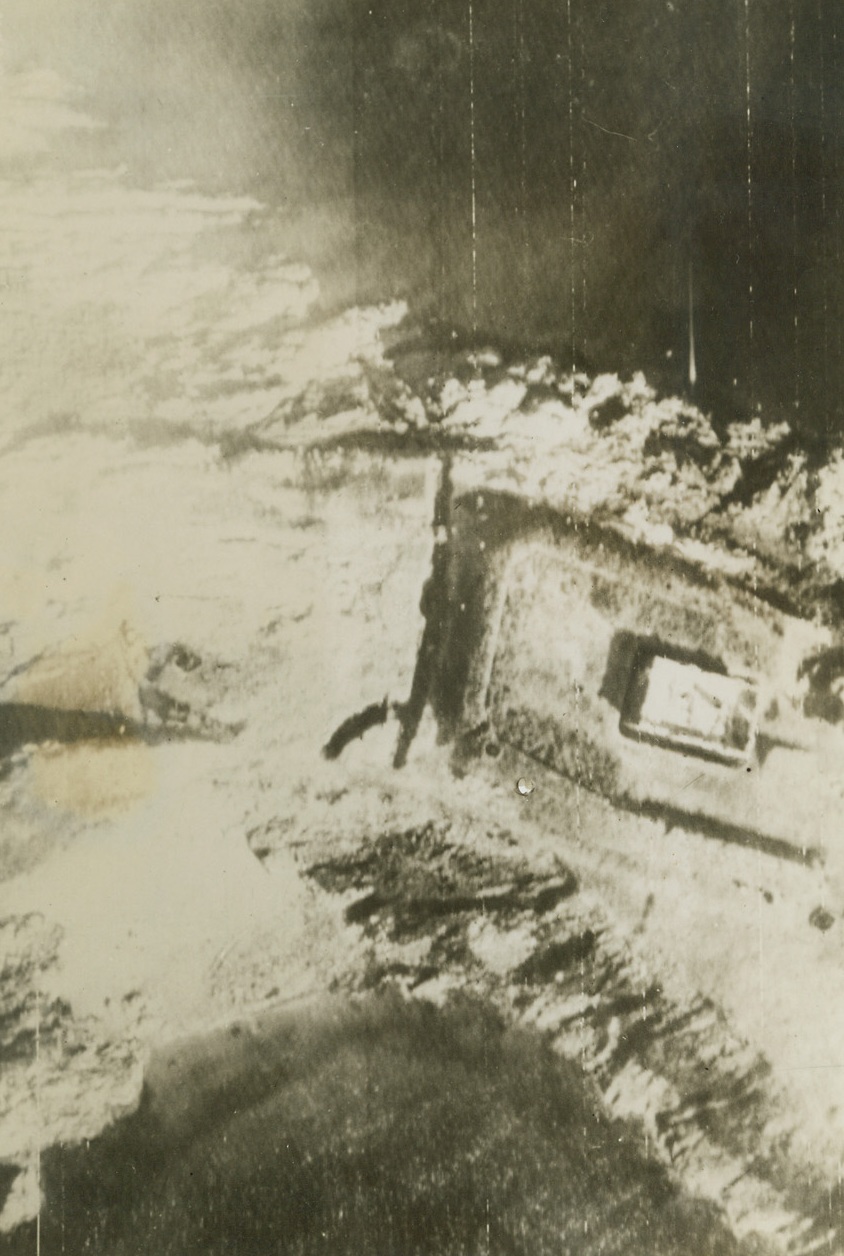
Abandoned Fortification, 6/14/1944. France—Taken from a photo plane of the Ninth Air Force, this radiotelephoto shows an abandoned German fortification somewhere on the northern coast of France. A moat can be seen surrounding the fort. Credit: 9th USAAF photo transmitted by Signal Corps radiotelephoto from London from ACME.;
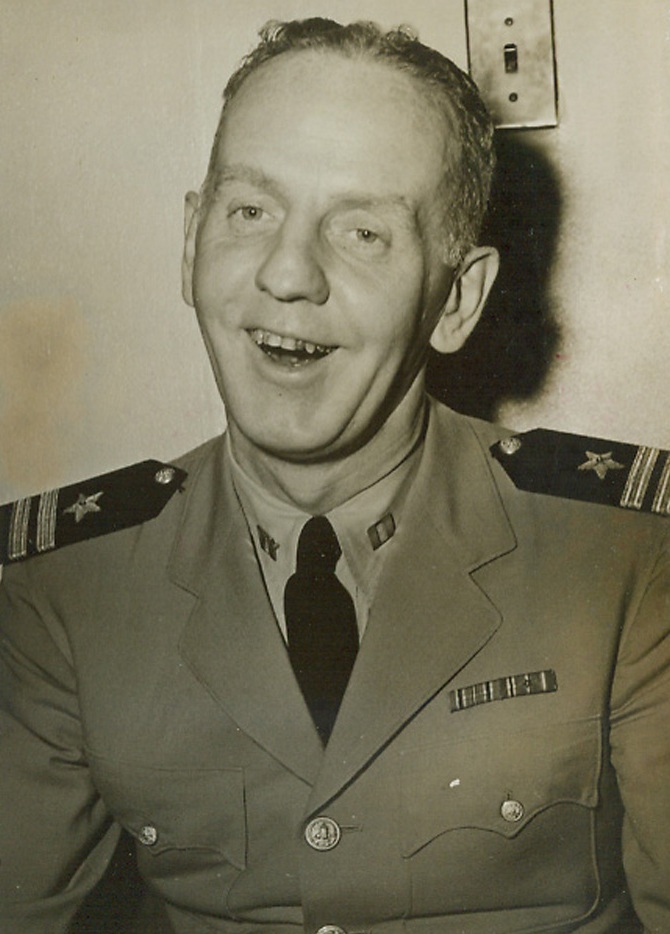
D-Day Eyewitness in New York, 6/17/1944. New York—Lt. John Mason Brown, USNR, who left the beachhead at Normandy last Tuesday and returned to the U.S. by plane, is shown holding a press interview here. Lt. Brown was aboard the USS Augusta, flagship of R/Adm. Alan G. Kirk, USN, on D-Day. R/Adm. Kirk is the commander of the American Task Force Units participating in the invasions. Credit: ACME.;

Hero’s Father Gets Medal, 6/16/1944. Camp Atterbury, Ind.—William F. Craig, Toledo, Ohio, receiving the Congressional Medal of Honor awarded posthumously to his son 2nd Lt. Robert Craig for silencing a machine gun nest at Favoratta, Italy, and drawing enemy fire toward himself so his platoon could take cover after they were caught in a trap. Maj. Gen. Alan W. Jones, commanding officer of the 106th infantry division, and Lt. Marvin Rusch decorate Craig. Credit: ACME.;
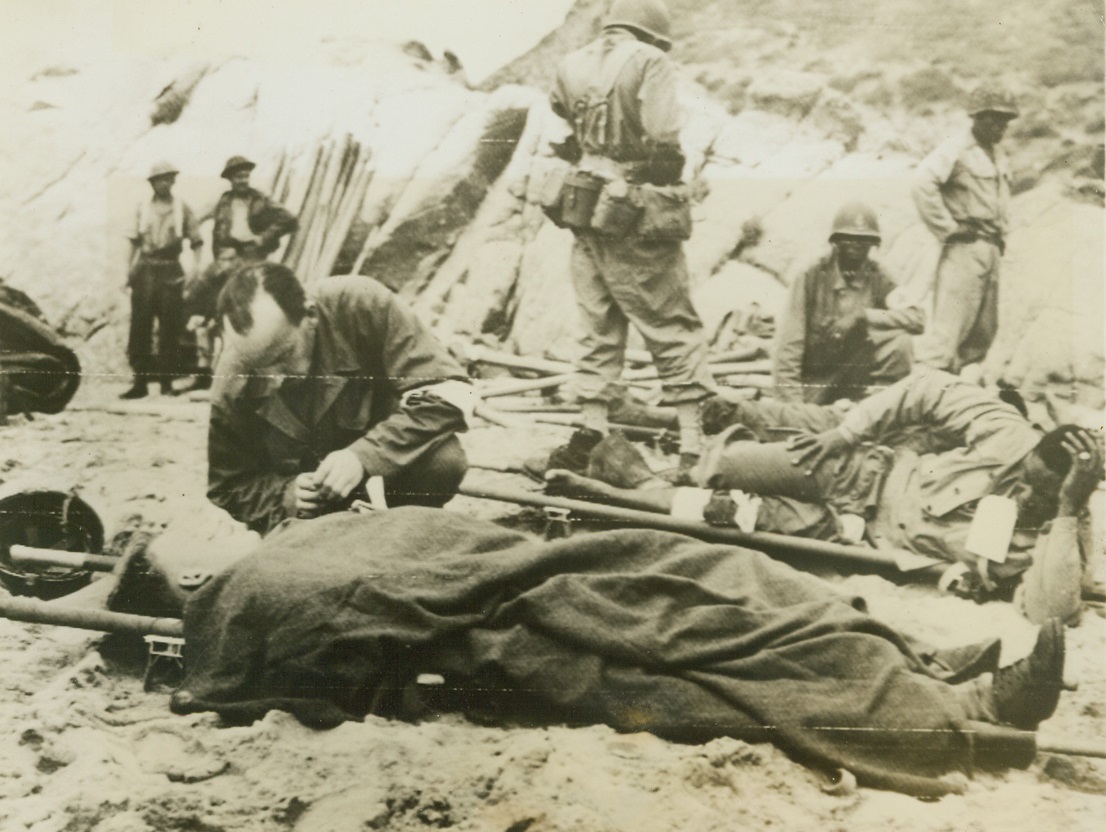
The Price Of Battle, 6/20/1944. Washington – A French Chaplain administers last rites to a wounded French soldier on the beach at Elba, during the conquest of the famous island. French soldiers were among the first to feel the effects of war. At first defeated, they were reorganized, then thrown back into battle as an important unit of the Mediterranean Forces. Now they again feel war’s sting and pay the price of battle. 6/20/44 Credit (Signal Corps Radio-Telephoto From Algeria Via ACME);
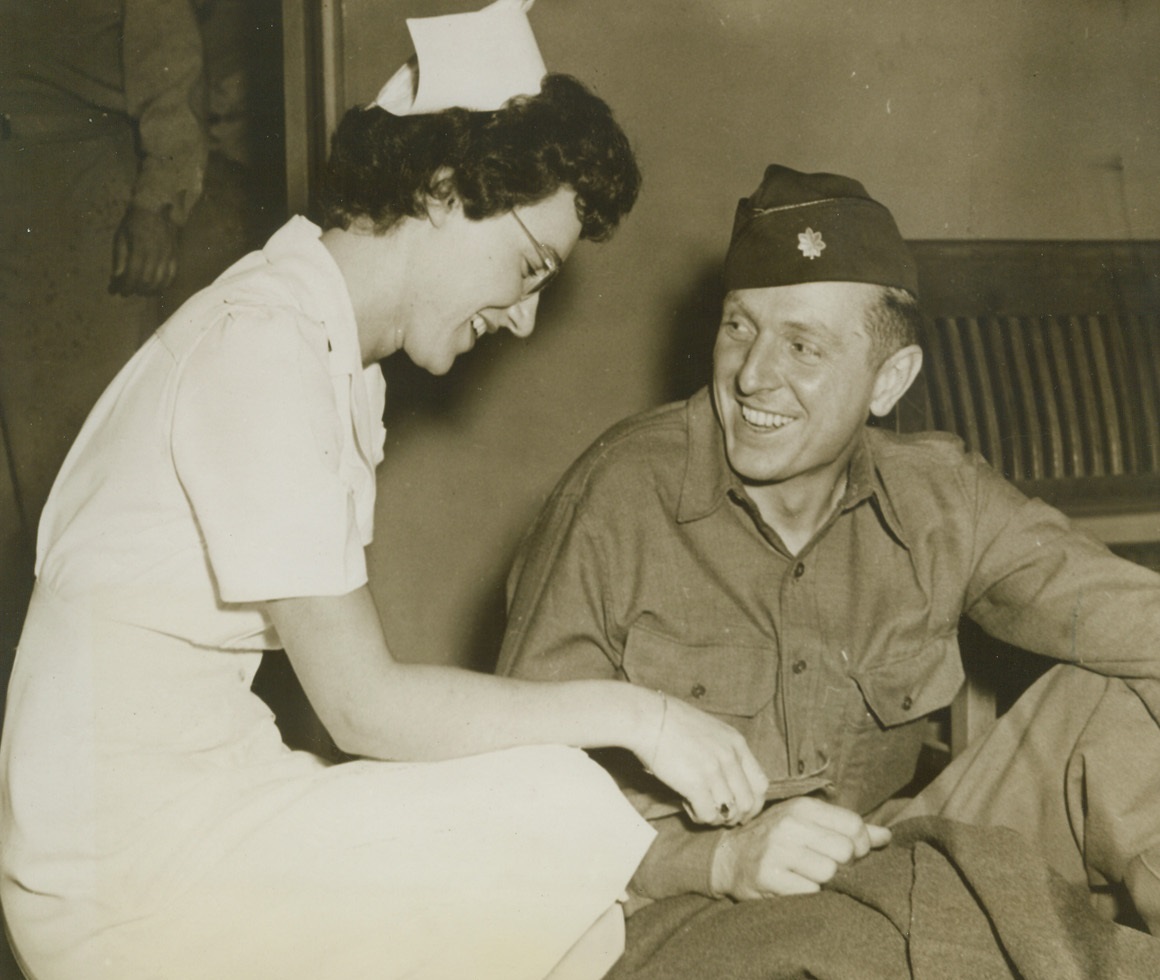
First D-Day Wounded Return to US, 6/25/1944. New York – Lt. Col. Michael C. Murphy grins with genuine happiness at nurse Lt. Olga Williams after his arrival at Mitchel Field last night (June 24) aboard an Air Transport Command Hospital Evacuation Plane. Col. Murphy, a Glider Pilot from Lafayette, Ind., and one enlisted man were the first of the invasion wounded to return to the U.S. Credit: Official USAAF photo from ACME;
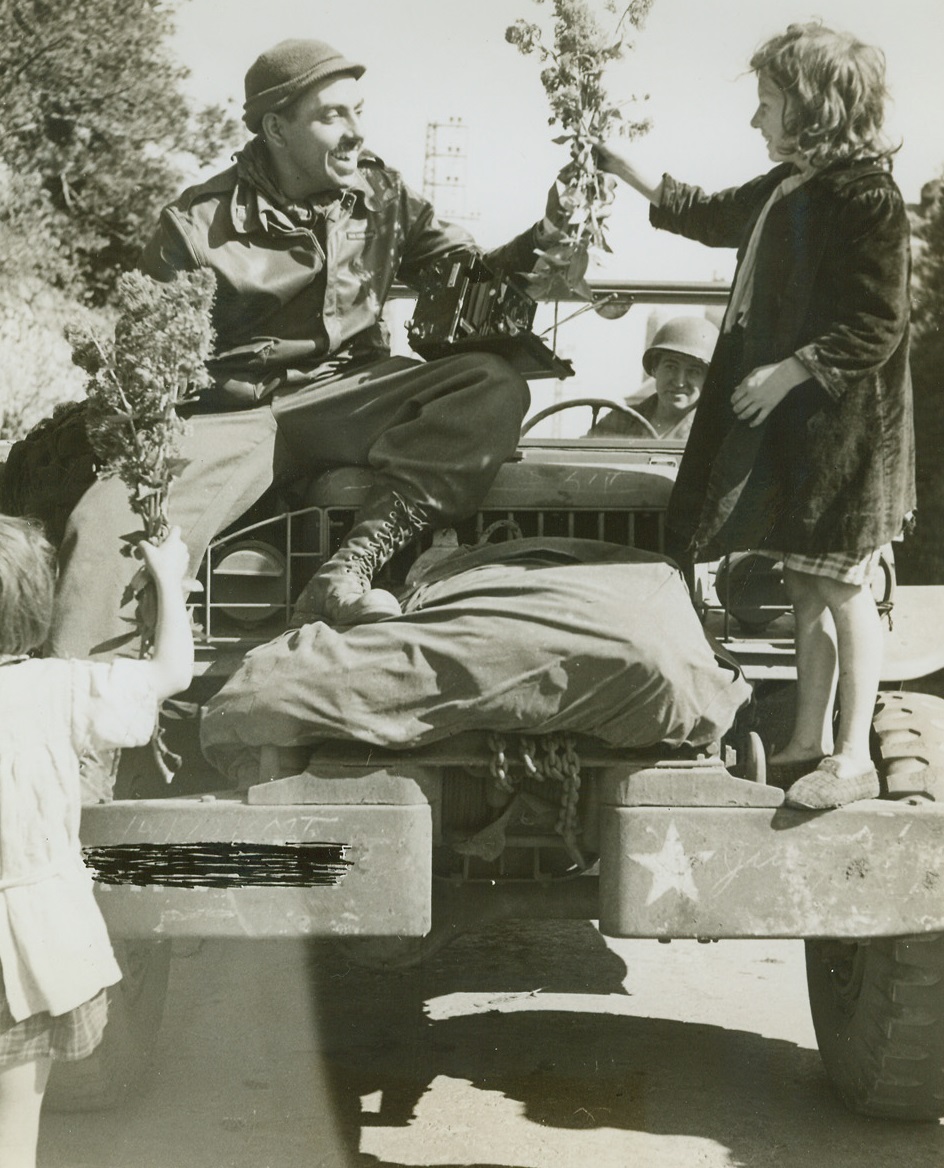
Posies for the Photographer, 6/27/1944. Bert Brandt, ACME photographer, smilingly receives wild flowers proffered by two French children on the outskirts of Barneville on the Cherbourg Peninsula as he advanced with the troops on the drive that resulted in the fall of the city. On this trip he was accompanied by Ernie Pyle, Scripps-Howard Newspaper Alliance war correspondent, who graphically described the ruin along the route as the Germans fled. Passed by censor. Credit: ACME;
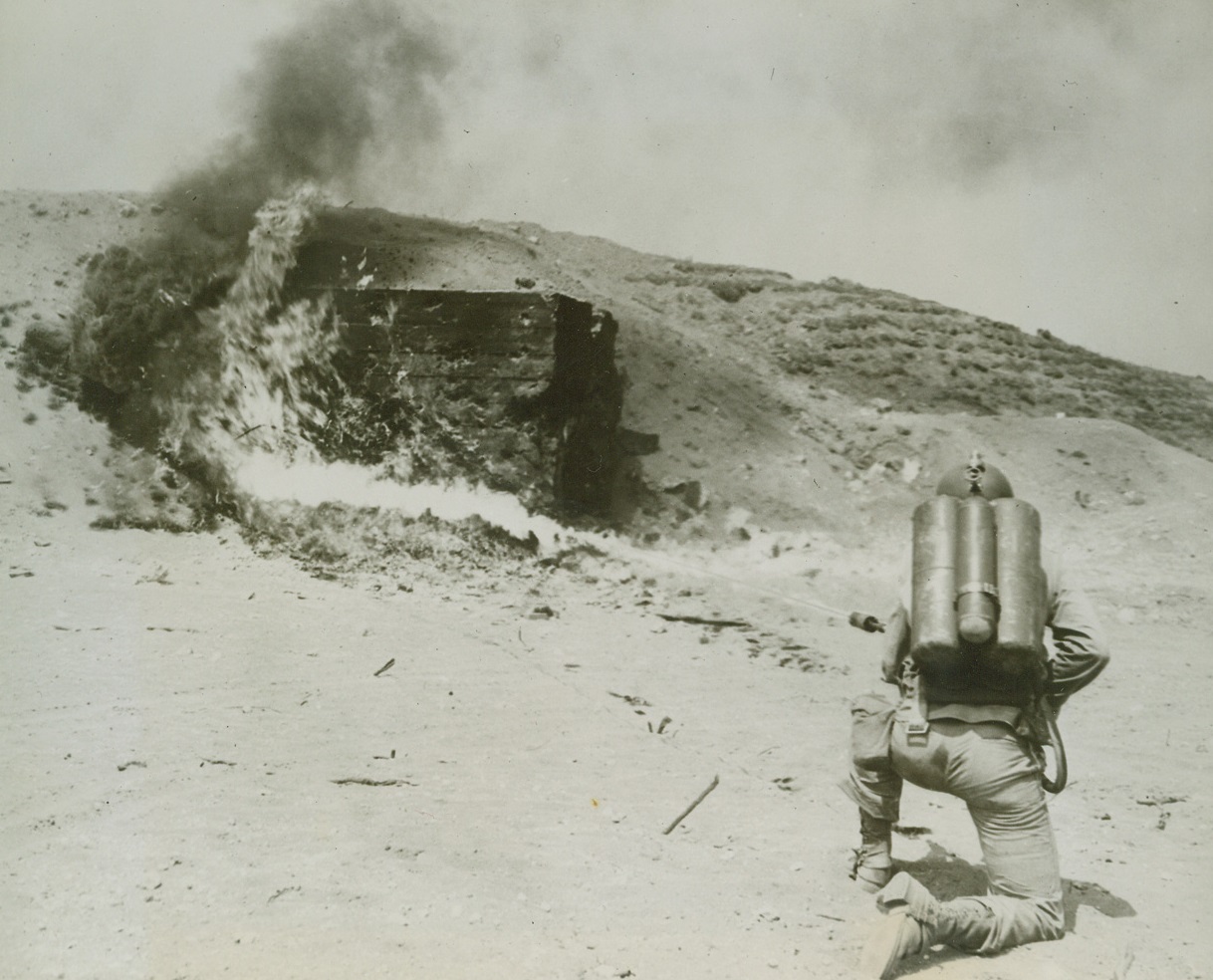
The Infantry School’s “West Wall”, 6/4/1944. Ft. Benning, GA. - Newest assault course at Ft. Benning is the Infantry School’s authentic exterior replica of a section of Germany’s famed West Wall, a series of pillboxes and blockhouses, which extends along the coastline from France to Norway and which our invasion troops must reduce from beachheads before they can drive inland to strike at the heart of Nazidom. Constructed after study from Allied photographs, the course covers 1,000 square yards and is used by the Infantry School in the training of officers and officer candidates. Infantry School demonstration troops, some of whom are shown in these photos, carry out “assaults” for the benefit of classes. Live ammunition is used and every three weeks the concrete pillboxes and blockhouses must be largely rebuilt and barbed wire torn by Bangalore Torpedoes must be restrung by Engineer Troops assigned to the school. Photo No. 2: Soldier armed with flame-thrower squirts fire at pillbox, which up until now has been under artillery attack. He is covered by riflemen. Credit: Exclusive ACME photo, for release to P.M. papers of Tuesday June 6, 1944;
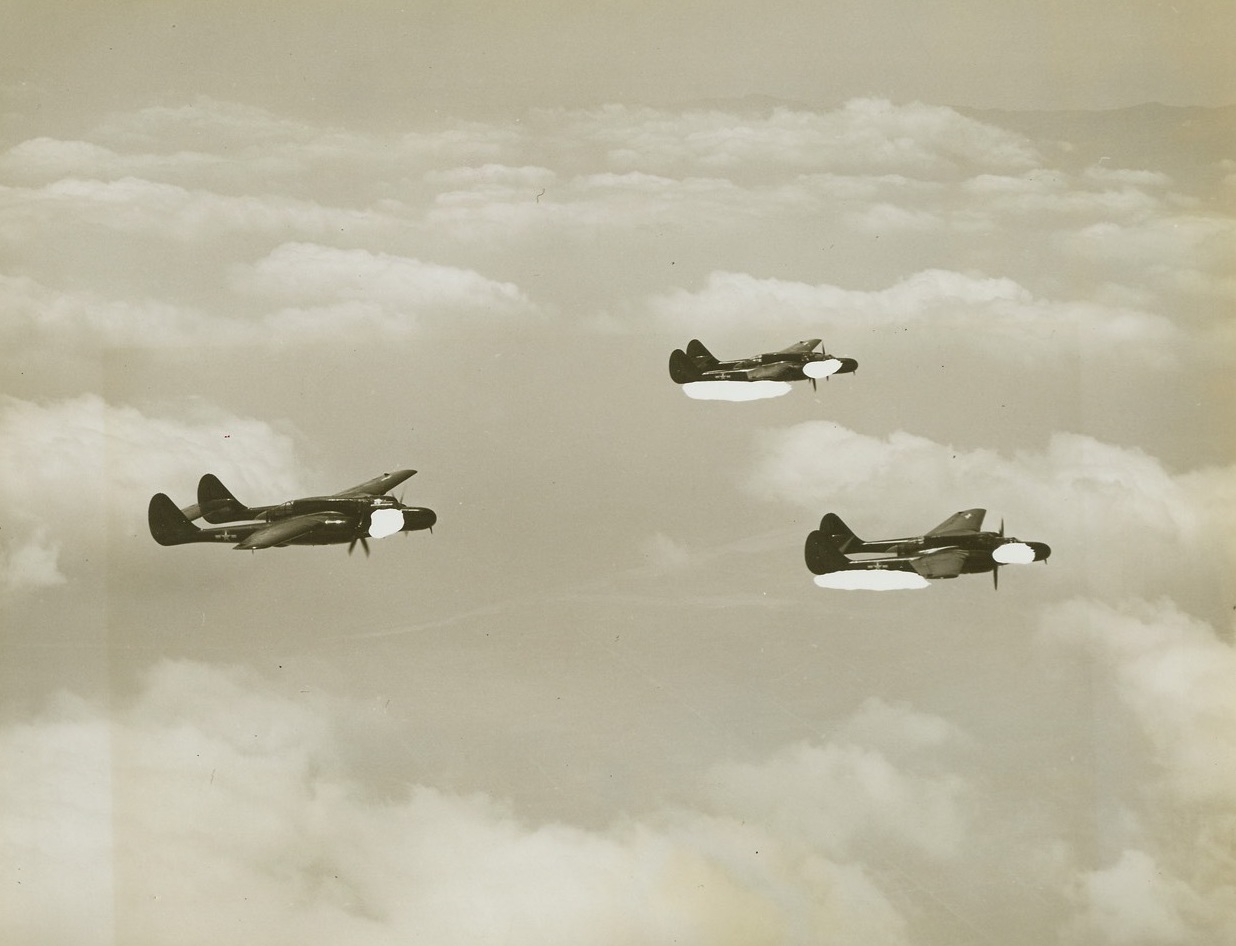
“Black Widow” Comes Out Into Light of Day, 6/13/1944. Hawthorne, California - Recently announced by the Army Air Forces, pictures of the new Northrop P-61 “Black Widow” Night Fighter have just been released. Armed with everything but the kitchen sink, the Black Widow is literally a flying gun platform and is the first Army fighter revealed since Pearl Harbor as well as the largest and most powerful pursuit plane ever built. The Black Widow is the first functional night fighter of the war. Planes used for night fighting - some with great success- have been modifications of aircraft originally planned for other types of missions and have lacked top efficiency in night battle. The P-61 was started in 1941 and an experimental model first test-flown in May 1942. Reminiscent of the P-38 with its twin fuselage, the Black Widow is equipped with the latest night fighting equipment and powered with two Pratt and Whitney Engines. As a night fighter it develops pursuit speed while retaining the easy flying characteristics and low landing speed necessary for night operations. All these pictures have been censored by the Army Air Force, and the blank spots indicate where deletions have been made. Looking somewhat like the P-38 Fighter, the “Black Widow”, newest night flyer takes to the skies in this flight of three of the powerful aircraft. Black spots indicate censorship. Credit: ACME;

Hit ‘em Where It Hurts, 6/21/1944. Northern France -- Flying bomb installations in Northern France, the launching site with ramp (bottom center) and the auxiliary buildings, are blasted by an attack by the RAF. Credit: British Air Ministry photo from ACME;
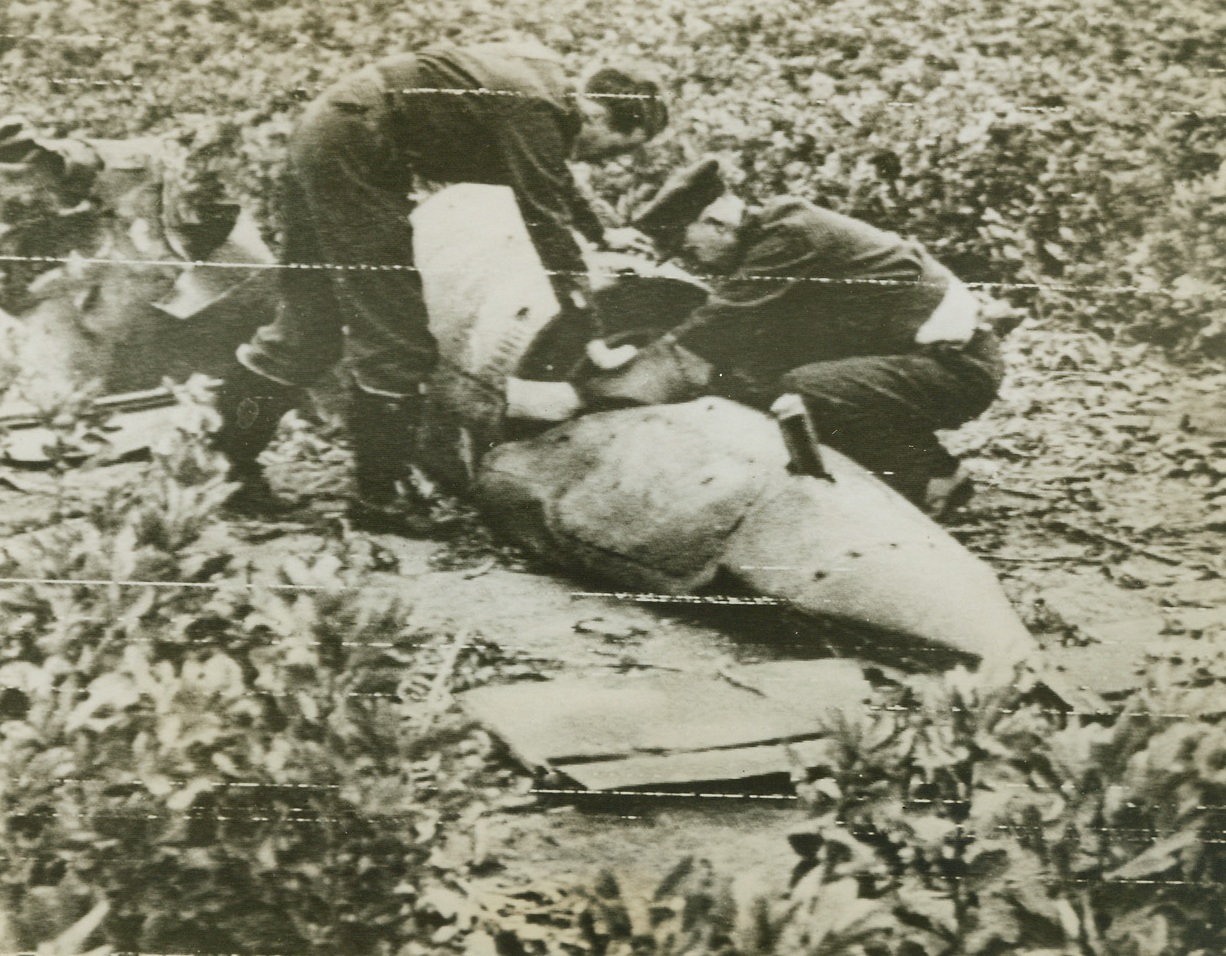
Germany’s Latest, 6/21/1944. England -- British fighter pilots examine a German flying bomb that was shot down in Southern England. Note the tail in the foreground. Credit: British Air Ministry photo from ACME;
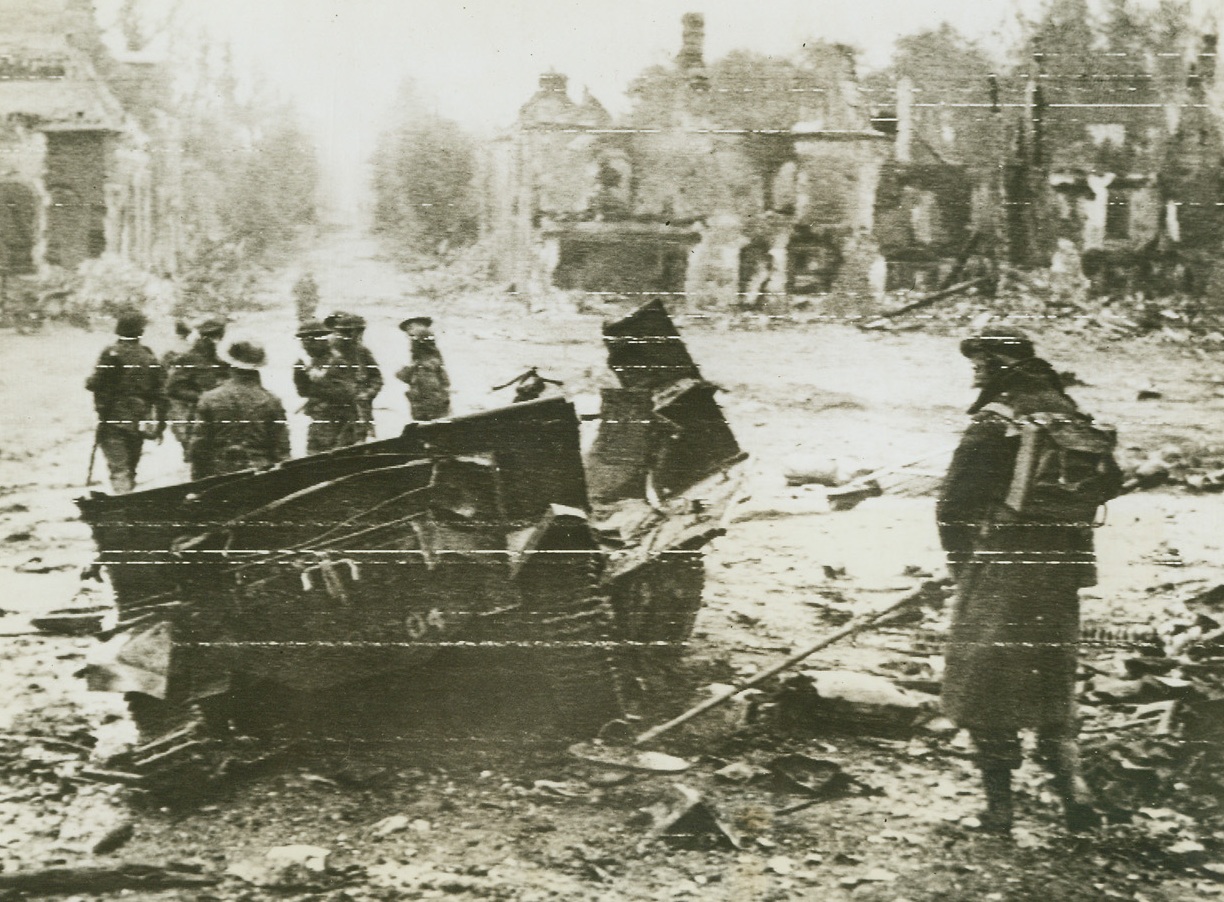
Check for Mines in Rapid Advance, 6/22/1944. France -- A British sapper checks the ground about a smashed bren-gun carrier in the battered streets of Tilly-Burseulles. Other tommies march ahead through the town captured recently after bitter fighting. Credit: British War Office photo from ACME;
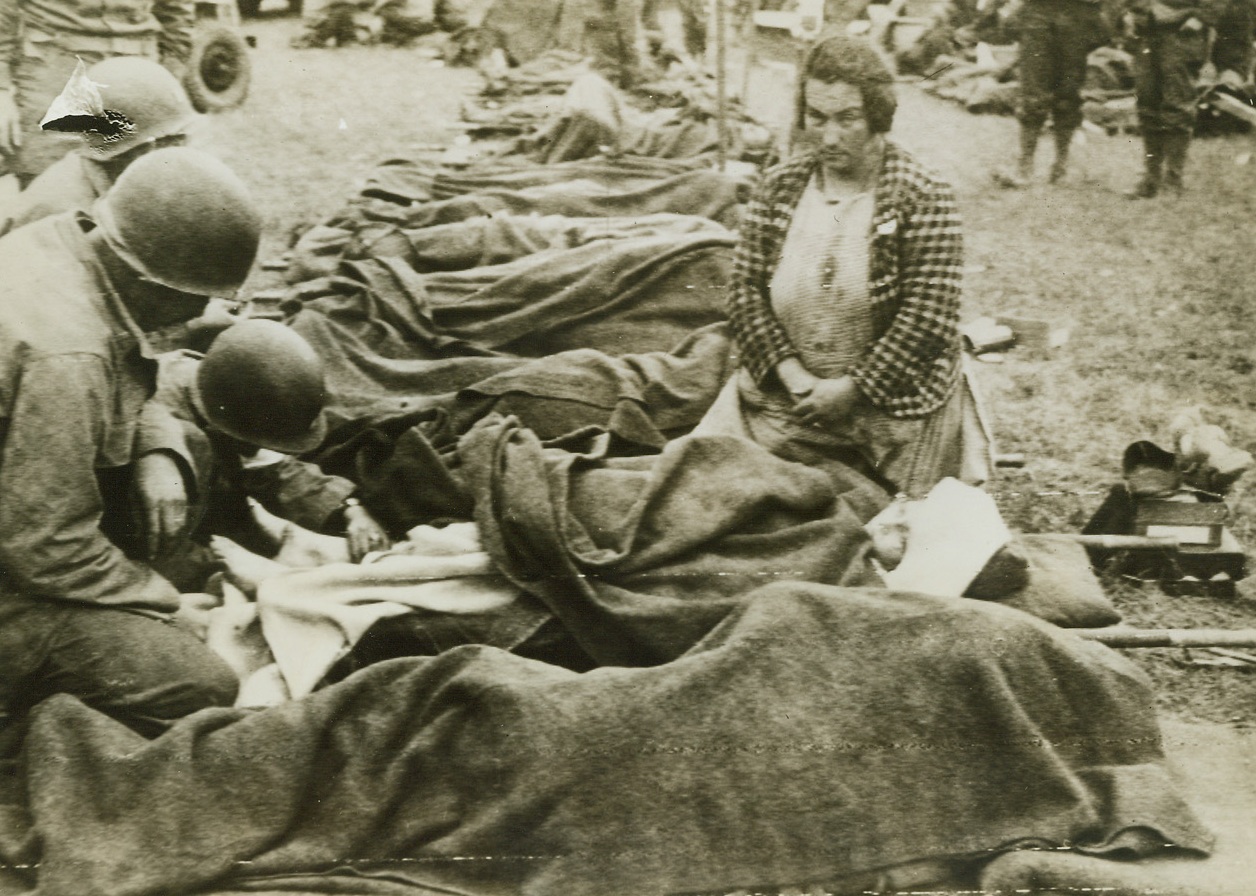
First Aid for French Girl, 6/22/1944. France -- While her mother watches, a young French girl is treated for wounds from German shell fire at an American field hospital in France. A long line of wounded--soldiers and civilians alike--wait their turn for attention from the Yank medics.;
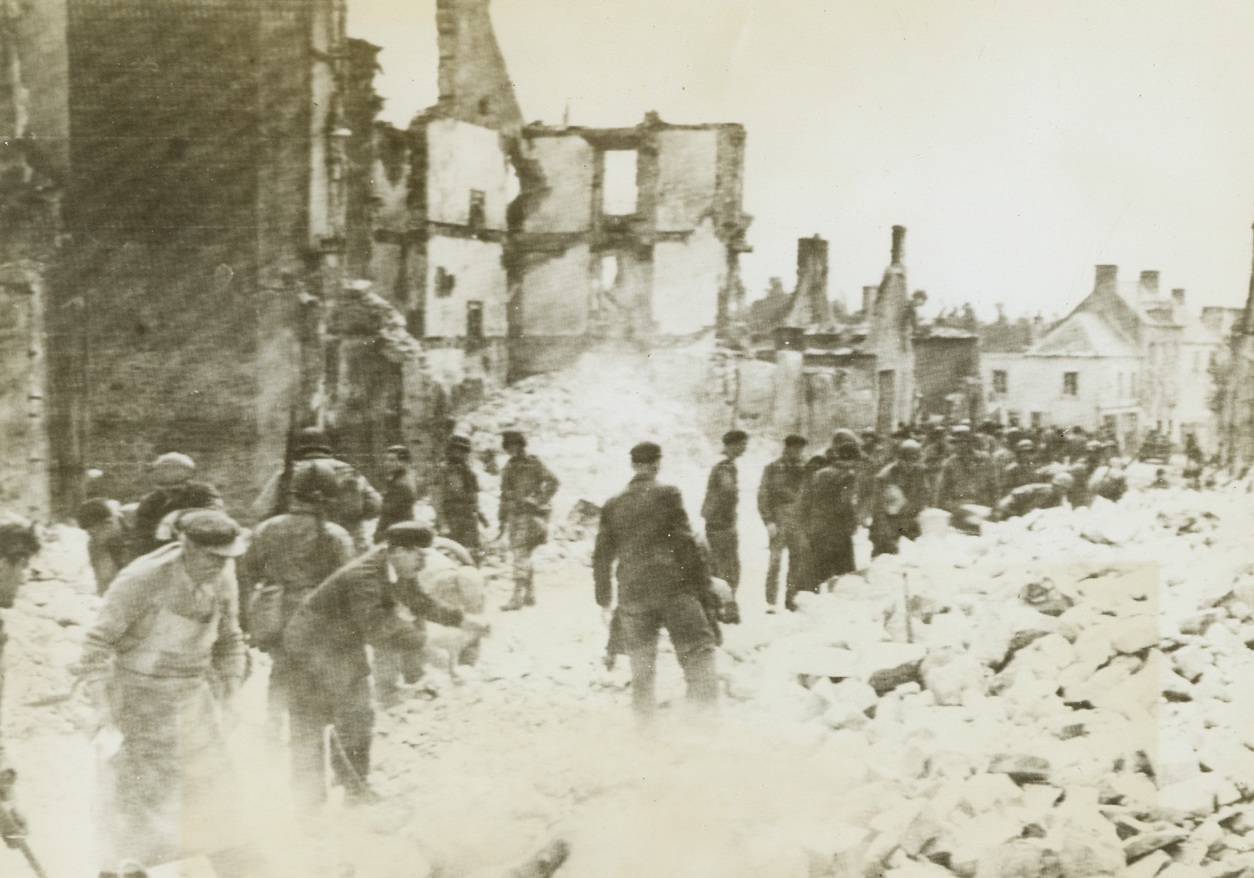
Montebourg Street Scene, 6/22/1944. France -- French civilians and American troops work side by side to clear the streets of Montebourg, France, from rubble left by the bitter battle between the Allies and the Nazis for the strategic town. Terrific American bombardment preceeded occupation of the city. Credit: Army photo from ACME;
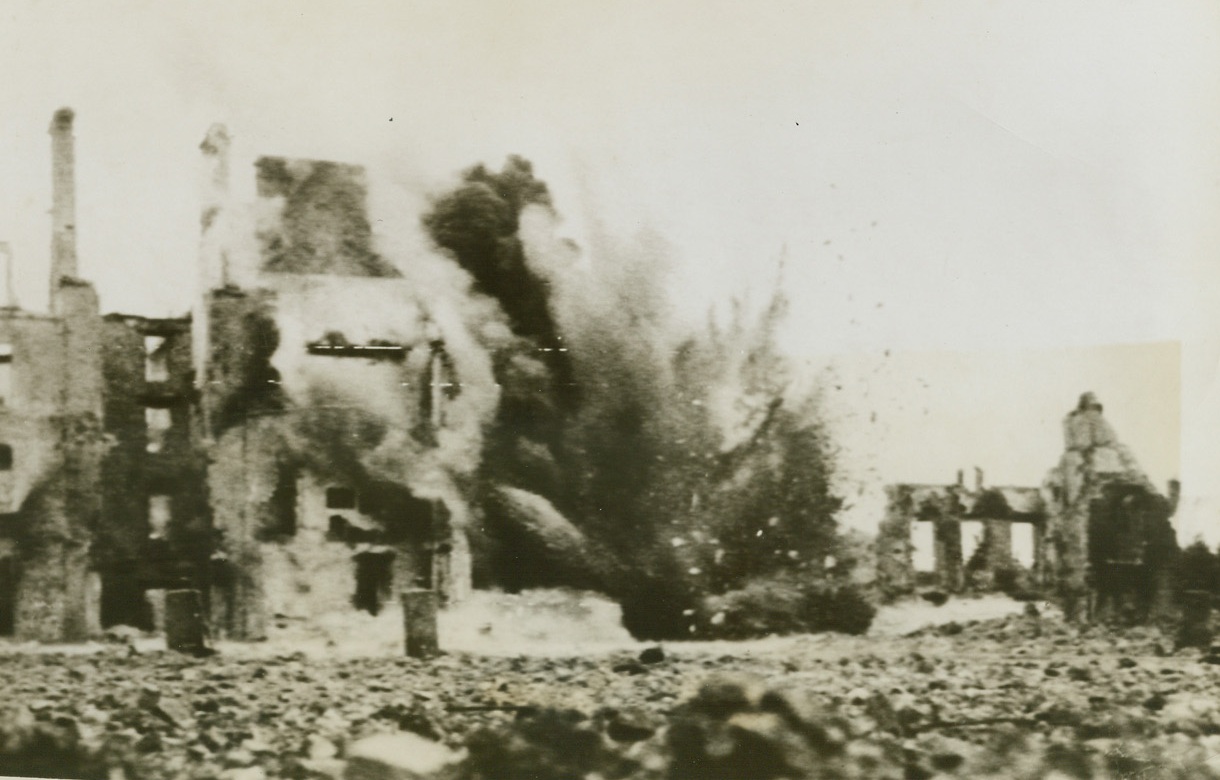
Getting Ready To Build Anew, 6/22/1944. Valognes, France -- Charges places by U.S. Army engineers topple damaged--and dangerous--buildings in Valognes after the city was taken from the fleeing Germans. No time was lost in clearing the streets of the village, which is near Cherbourg, of shaky walls and rubble that might be a danger to life and limb. The move is necessary, too, in preparing for reconstruction. Credit: Army photo from ACME;
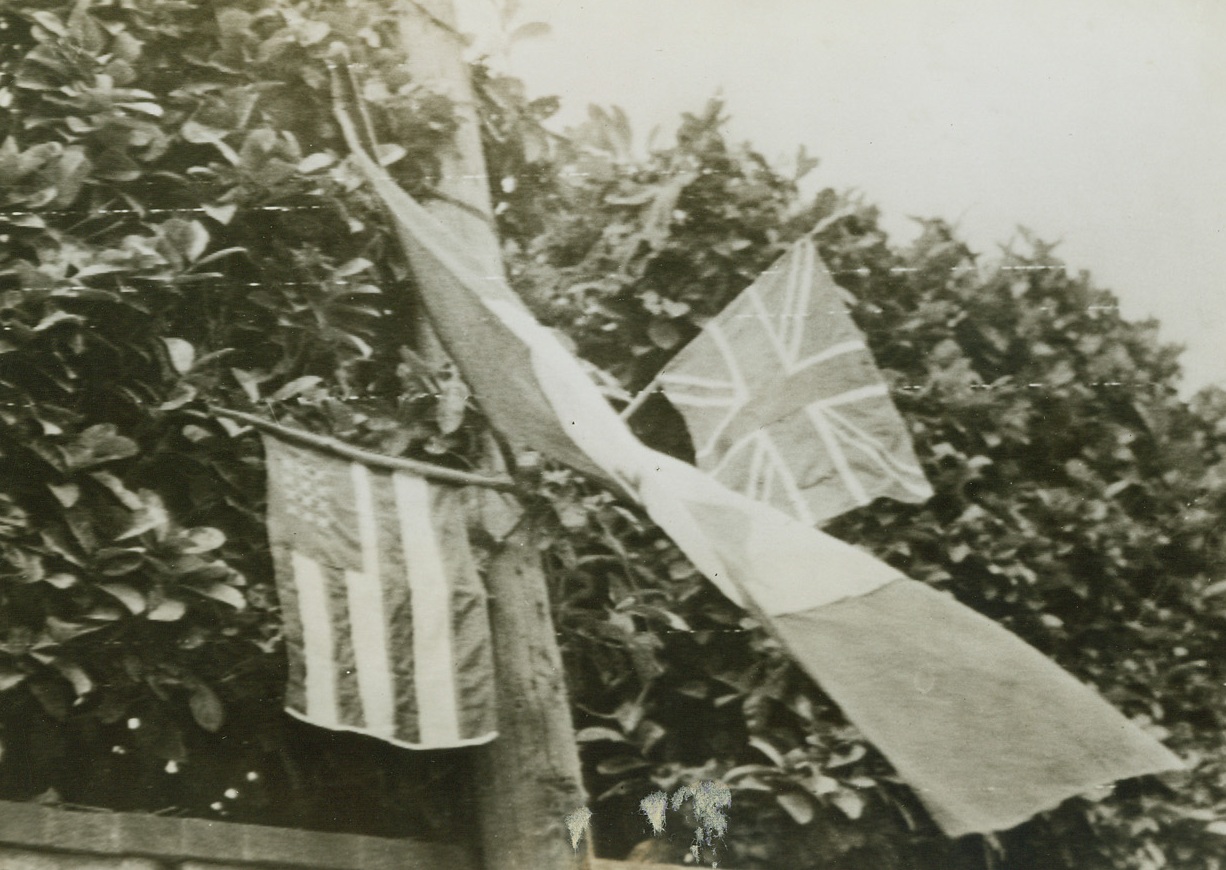
It’s The Spirit That Counts!, 6/22/1944. Trevieres, France - The natives in the Norman village of Trevieres, made these American, French and British (left to right) flags to honor the Allied troops of liberation marching into their town. Although the banners are crudely put together (the U.S. flag lacks the proper number of stars and stripes), it was the spirit of the gesture that pleased the Allied liberators. Credit: Army Radiotelephoto from ACME;
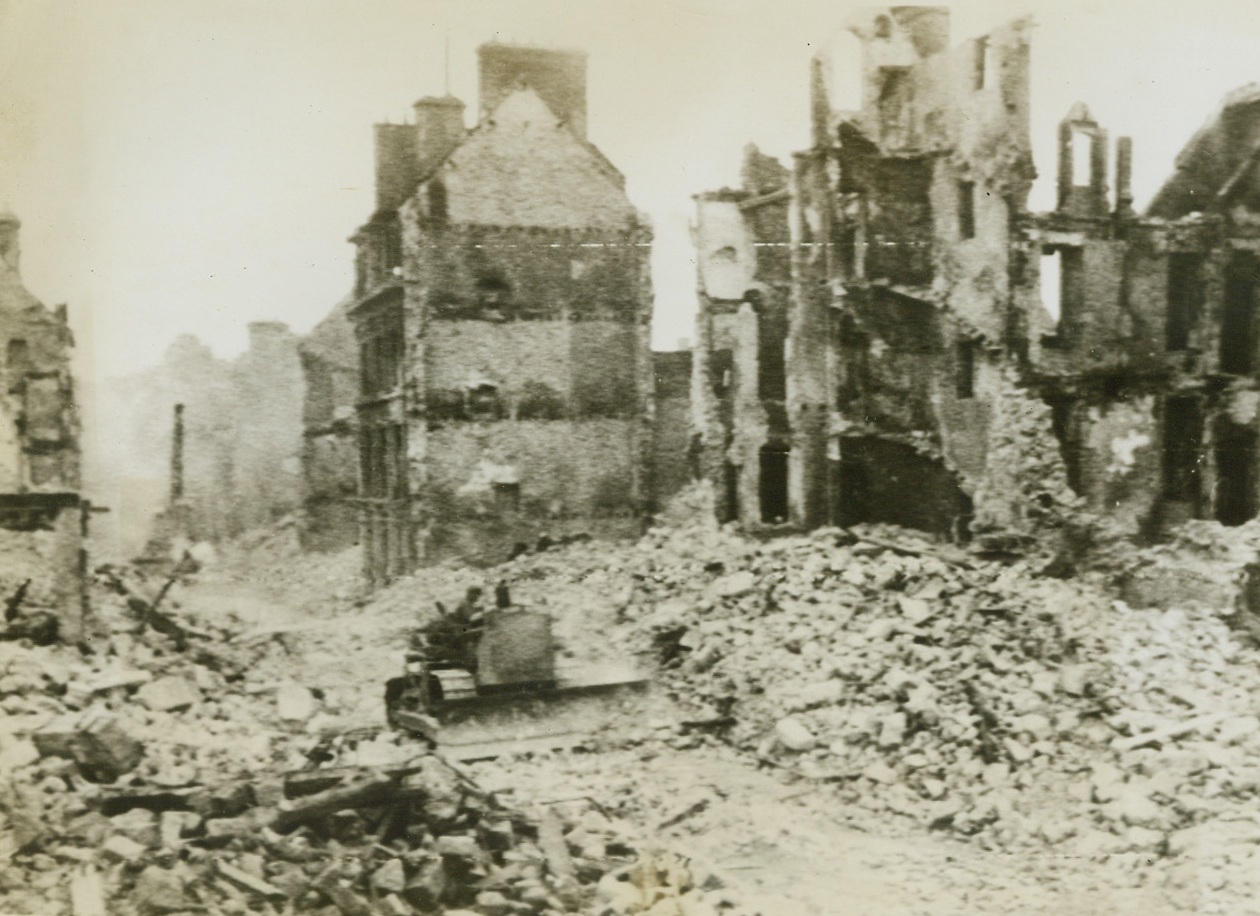
Preparing For Reconstruction in Normandy, 6/22/1944. Valognes, France - Hardly had the smoke of battle cleared, before the U.S. Engineers were busy blasting down dangerous walls, and clearing streets of rubble. Here, an Army bulldozer forces a path through a pile of wreckage in Valognes, near Cherbourg. This demolition is the first step in the reconstruction of these towns liberated by the Allies. Credit: ACME photo via Army Radiotelephoto;
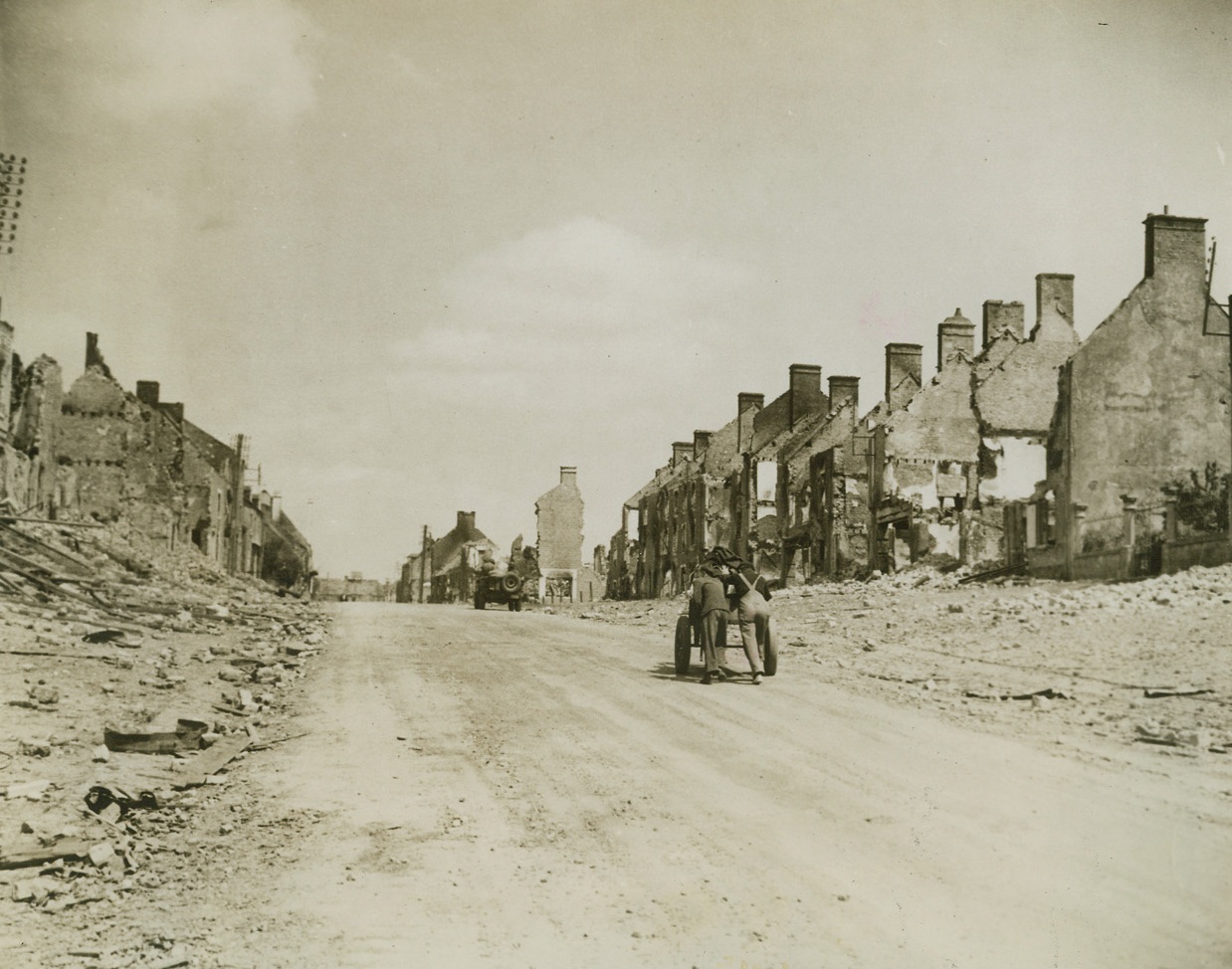
Marked By War, 6/22/1944. France - Gutted homes line the road out of Pont L`Abbe as these inhabitants of the city leave for a safer area. Nazis put up stiff resistance before the Allied Armies of Liberation forced them into retreat from this stronghold. Credit: ACME;
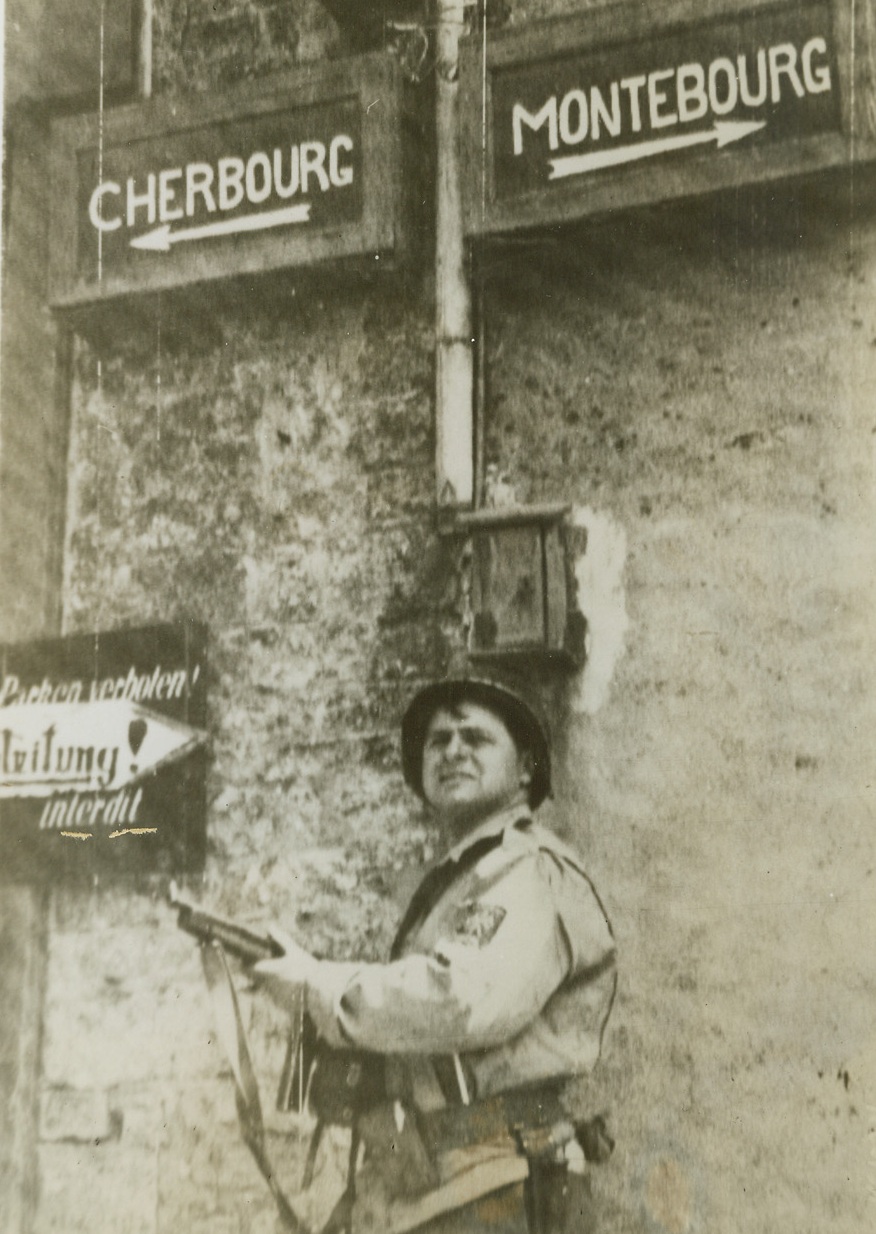
Headed For Cherbourg, 6/22/1944. France - Armed with a Tommy Gun, Signal Corps photographer Cpl. David Halberg, Cleveland, O., looks forward to the next town on the time table of the Allied Armies of Liberation - Cherbourg. Halberg was the first man to enter the town of Montebourg. Credit: Army Radiotelephoto from ACME;
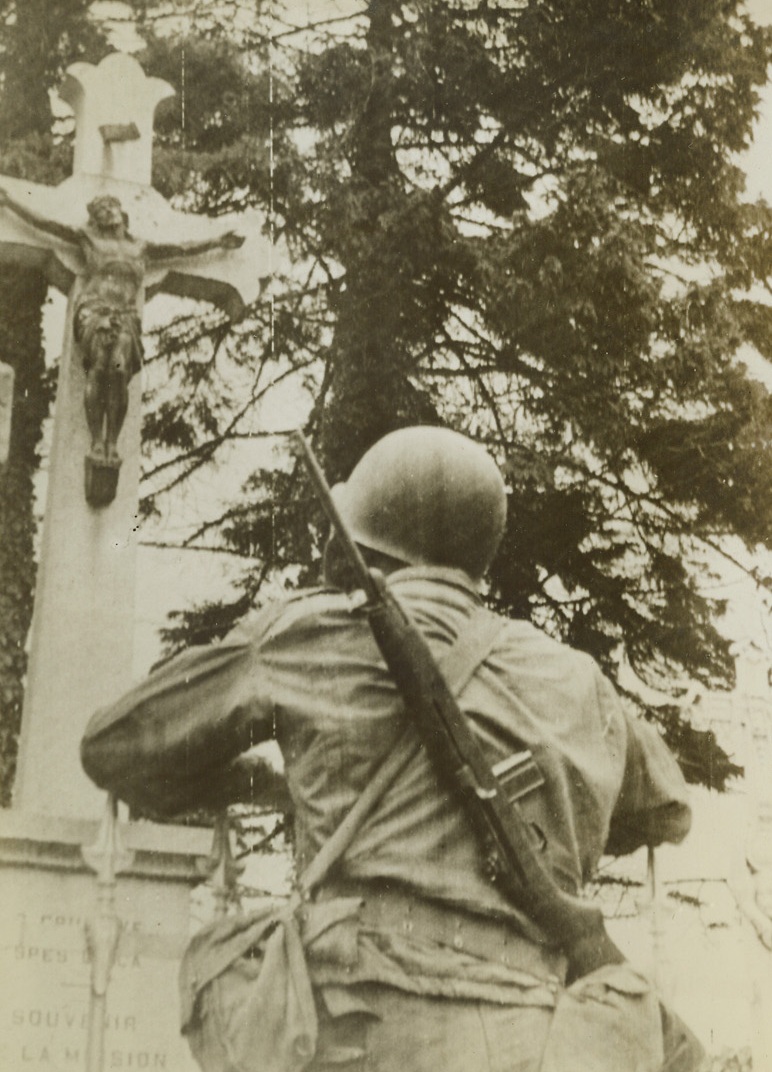
Liberator Pauses for Prayer, 6/14/1944. France - An American soldier pauses in the battle for the liberation of the people of France and the whole of Nazi-enslaved Europe for a brief moment of meditation at a way-side shrine set deep in a wooded grove. Just a moment’s pause and then this soldier will once more move on with the advancing Allied troops cracking Hitler’s Fortress wide open. Credit: Signal Corps Radiotelephoto from ACME;
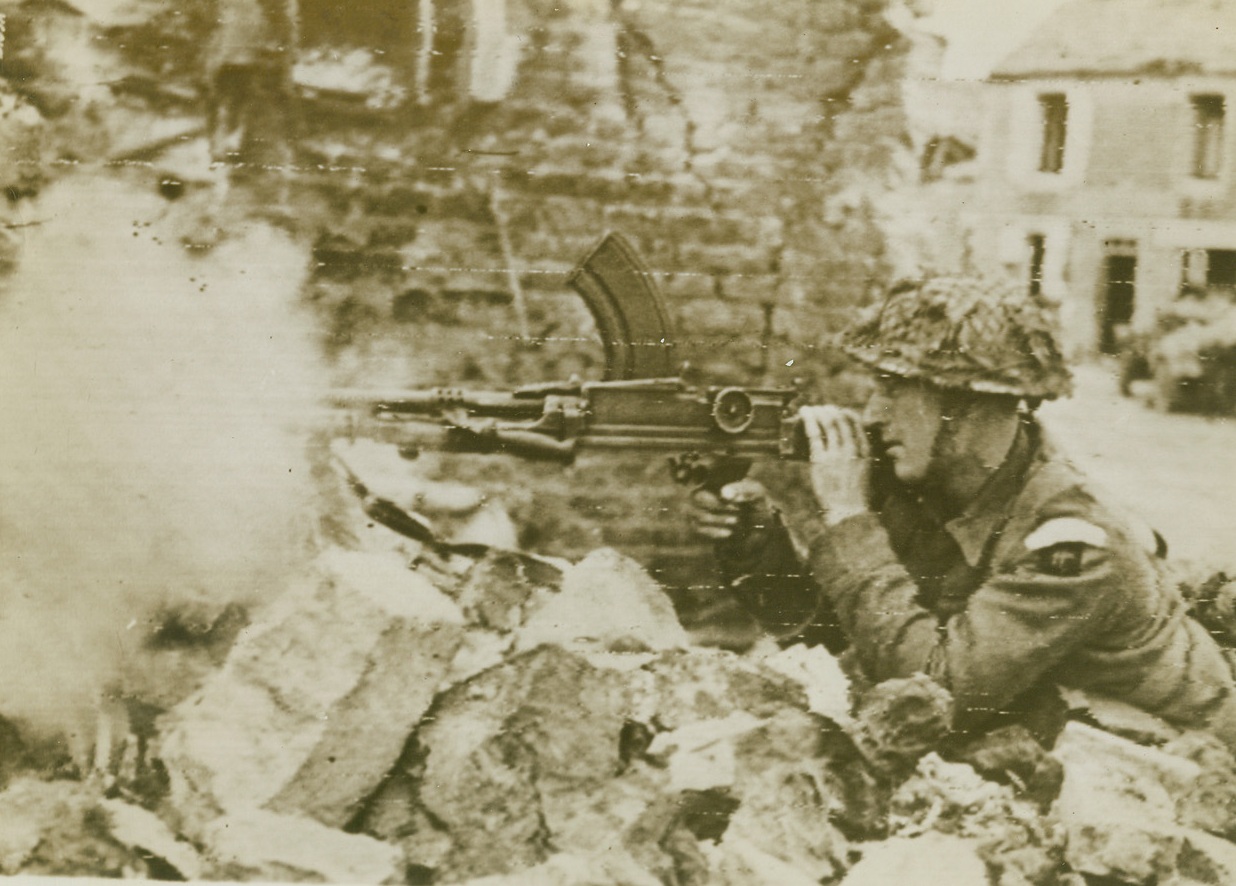
Quick Death For Nazi Snipers, 6/14/1944. France - A British Bren Gunner fires a burst at some of the enemy Rearguard, left behind in Bayeux before it was captured by the Allies. Today, despite five separate Nazi counter-attacks along the French Front, British, American and Canadian troops are holding fast. Credit: British Official photo via Army Radiotelephoto from ACME;
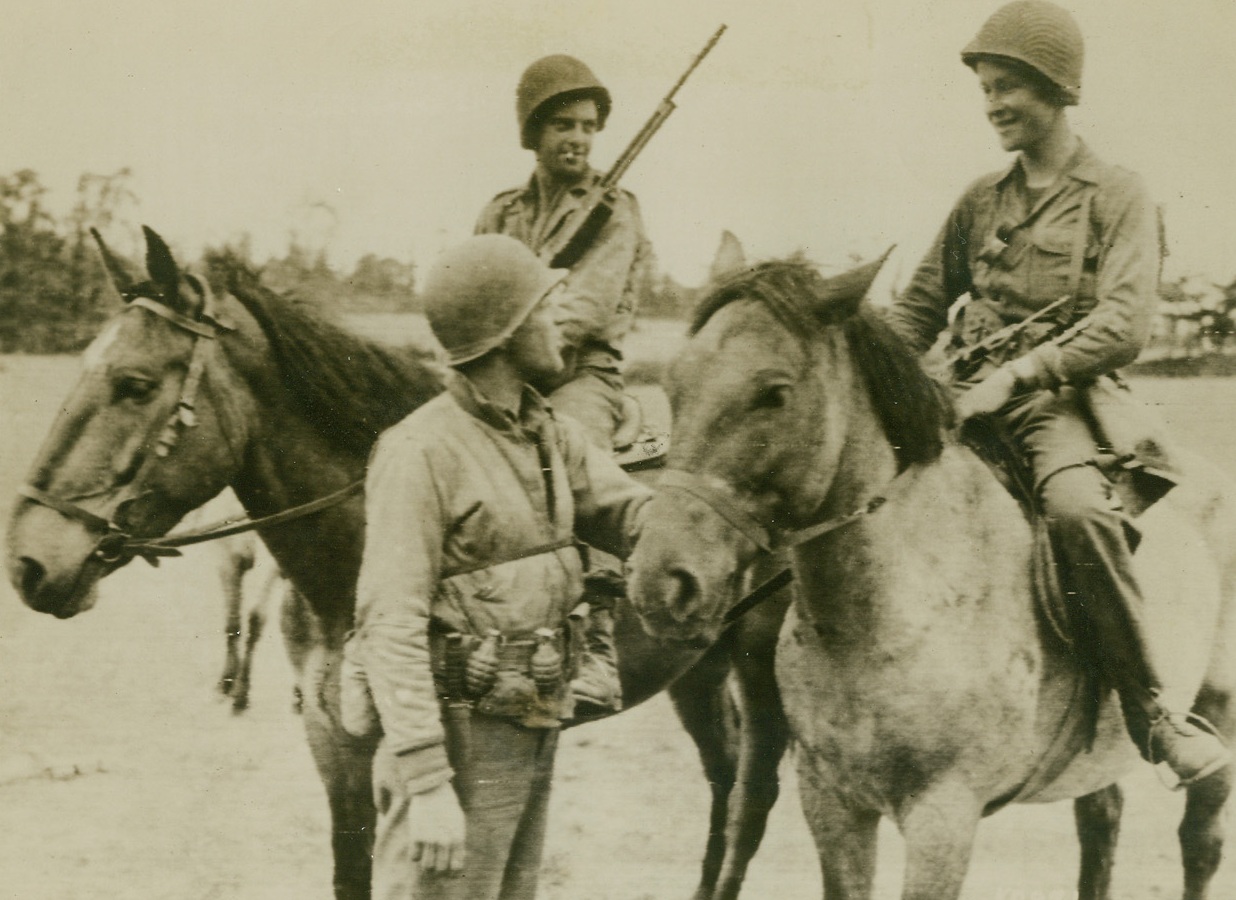
The Rangers Bring ‘Em In!, 6/13/1944. France - These two Mounted Rangers were sent out to forage for food all along the Allied beachhead in France - they returned with 43 German prisoners. Here, they talk things over with their commander. These American equivalents of the British Commandos, were in the forefront of the Allied landings. Note knife and grenades handing from the Commander’s belt. Credit: ACME photo via Army Radiotelephoto;
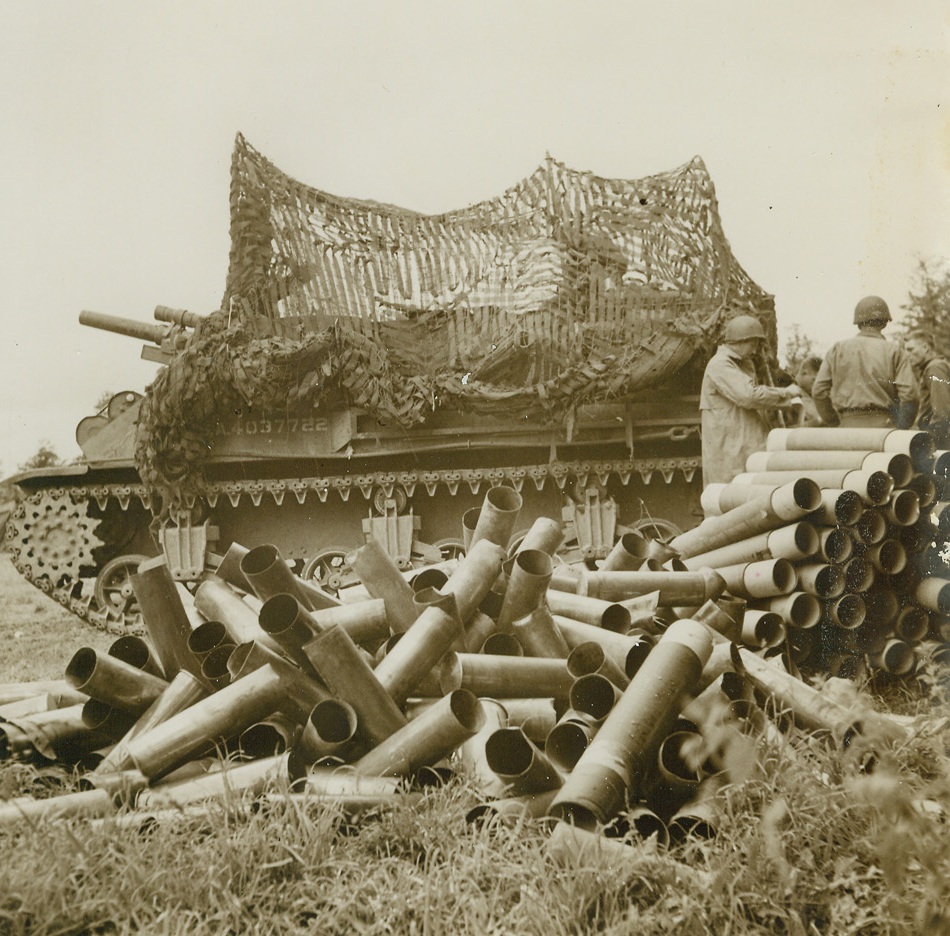
A Good Night’s Work, 6/19/1944. Carentan Area -- Piled helter-skelter on the ground beside this well-camouflaged 105mm self-propelled Howitzer, these empty shell cases represent a single night’s work in the Carentan area. Now that day has dawned the big gun, placed a short distance from the firing lines, is ready to take up the fierce barrage where it left off. Credit: ACME photo by Bert Brandt for the War Picture Pool;

Pilotless Plane Zooms Down, 6/19/1944. Southern England -- Diving to earth for its vicious attack, a German pilotless plane zooms through Southern England skies with flame streaming from the propulsion unit (mounted above and behind tail). The mystery plane has a 16-foot wingspan and is 25 ft., 4 1/2 inches long. It was disclosed today that six months of ceaseless air attack has knocked out so many of these platforms used to launch these robot planes that the pilotless bombs, when they were finally loosed, went out on less than one-fourth the scale the Nazis wanted. Credit: ACME photo via U.S. Signal Corps Radiotelephoto;
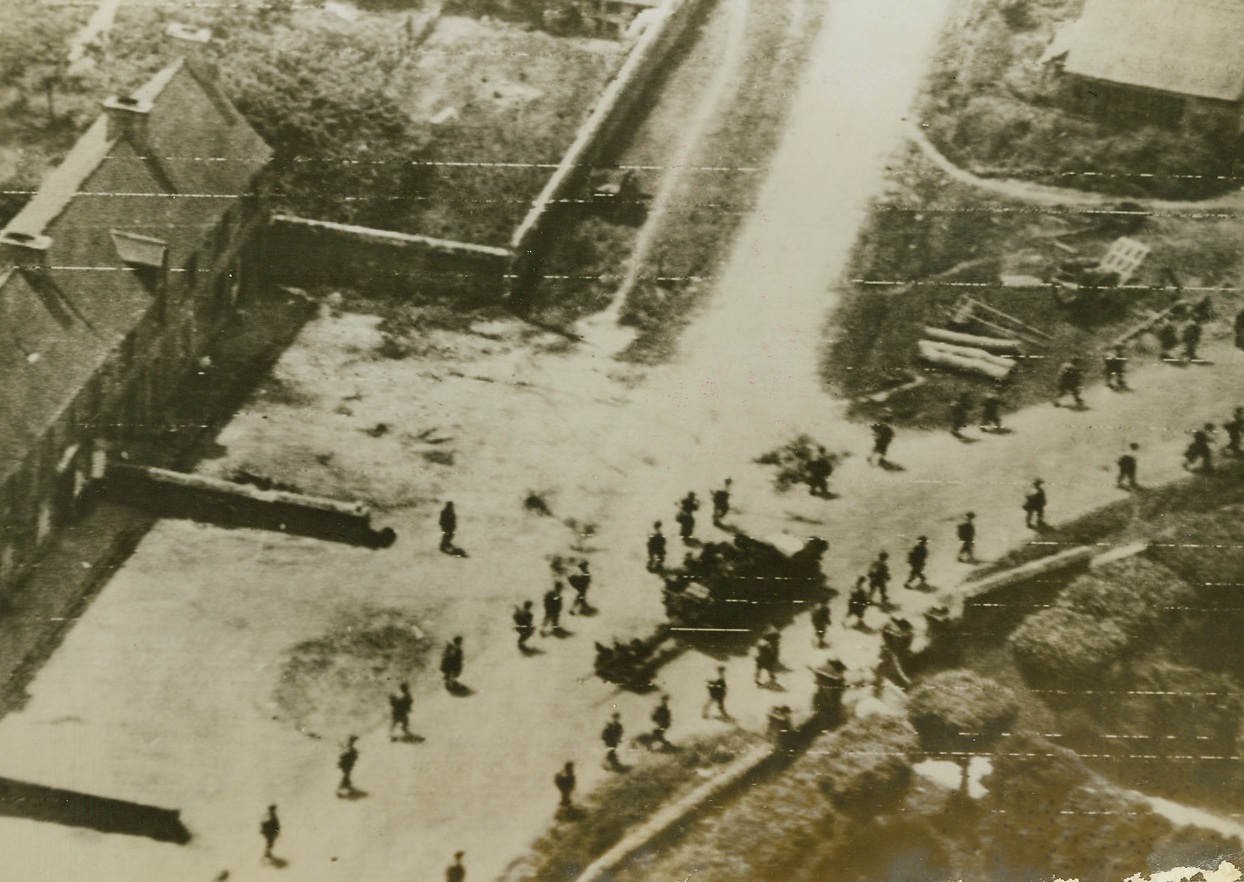
At the Other Side, 6/19/1944. St. Jacques de Nehou, France -- Yanks who have traveled clear across the Cherbourg Peninsula tramp in double column through St. Jacques de Nehou, on the west coast of the Peninsula. Pushing ahead to capture trapped Germans in the area, the Americans now have Jerry with his back against the wall. Latest communiqués from the area indicate that our forces are within seven miles of vital Cherbourg itself. Credit: Signal Corps photo from ACME;
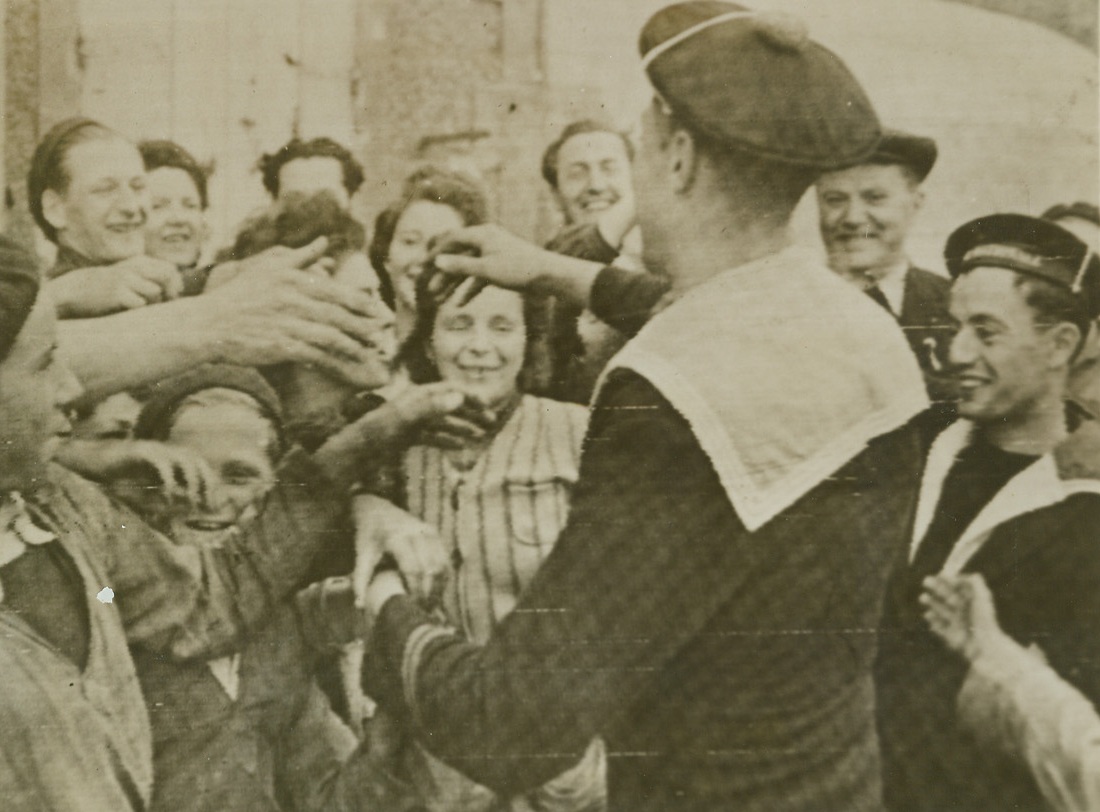
French Sailors “Invade” Homeland, 6/14/1944. France - In Port-En-Bessin, first port captured by the Allies in Normandy, is visited by French sailors who hopped off their ships to shake hands with their fellow countrymen. This was the first time in four years that some had been on their own native soil. Above civilians vie with each other to shake the sailors’ hands. Credit: British War Office photo via Signal Corps Radiotelephoto from ACME;
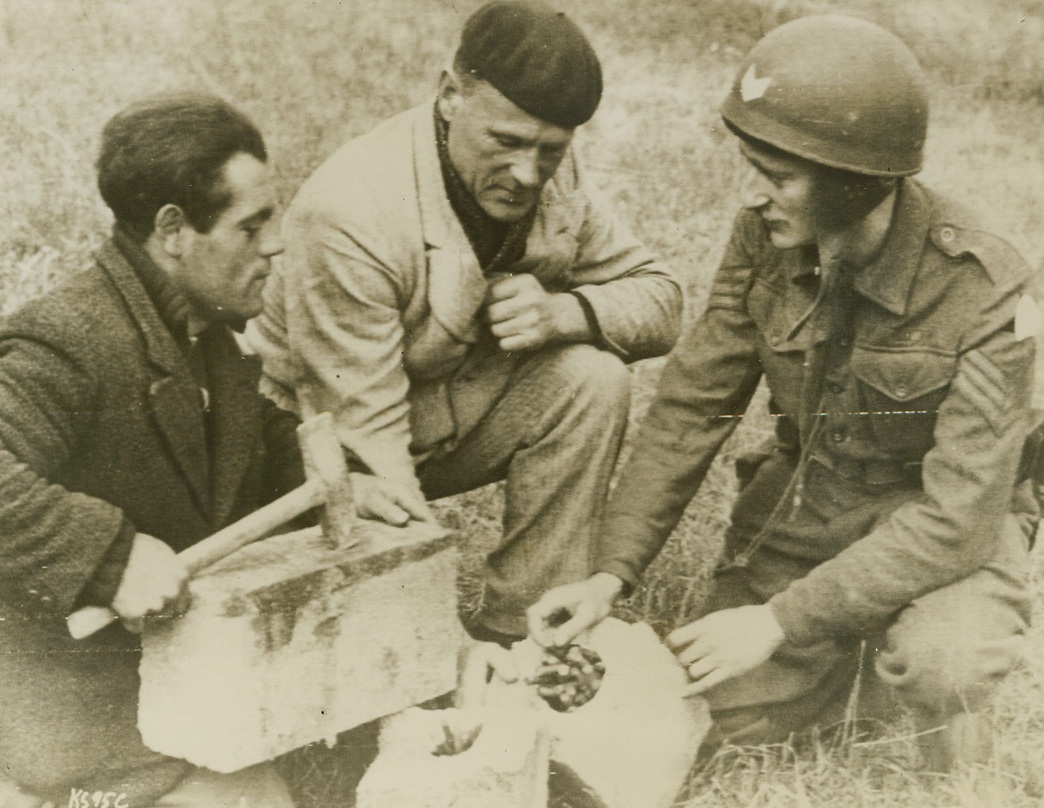
French Underground Secret, 6/16/1944. France – Doisy Marcel, of Coieville, Normandy explains to a British sergeant how ammunition stolen from the Nazis was hidden in paving stones to help the resistance movement. Marcel is a contractor when he is not hunting Nazis 6/16/44 Credit (British War Office Photo Via Signal Corps Radiotelephoto From ACME);
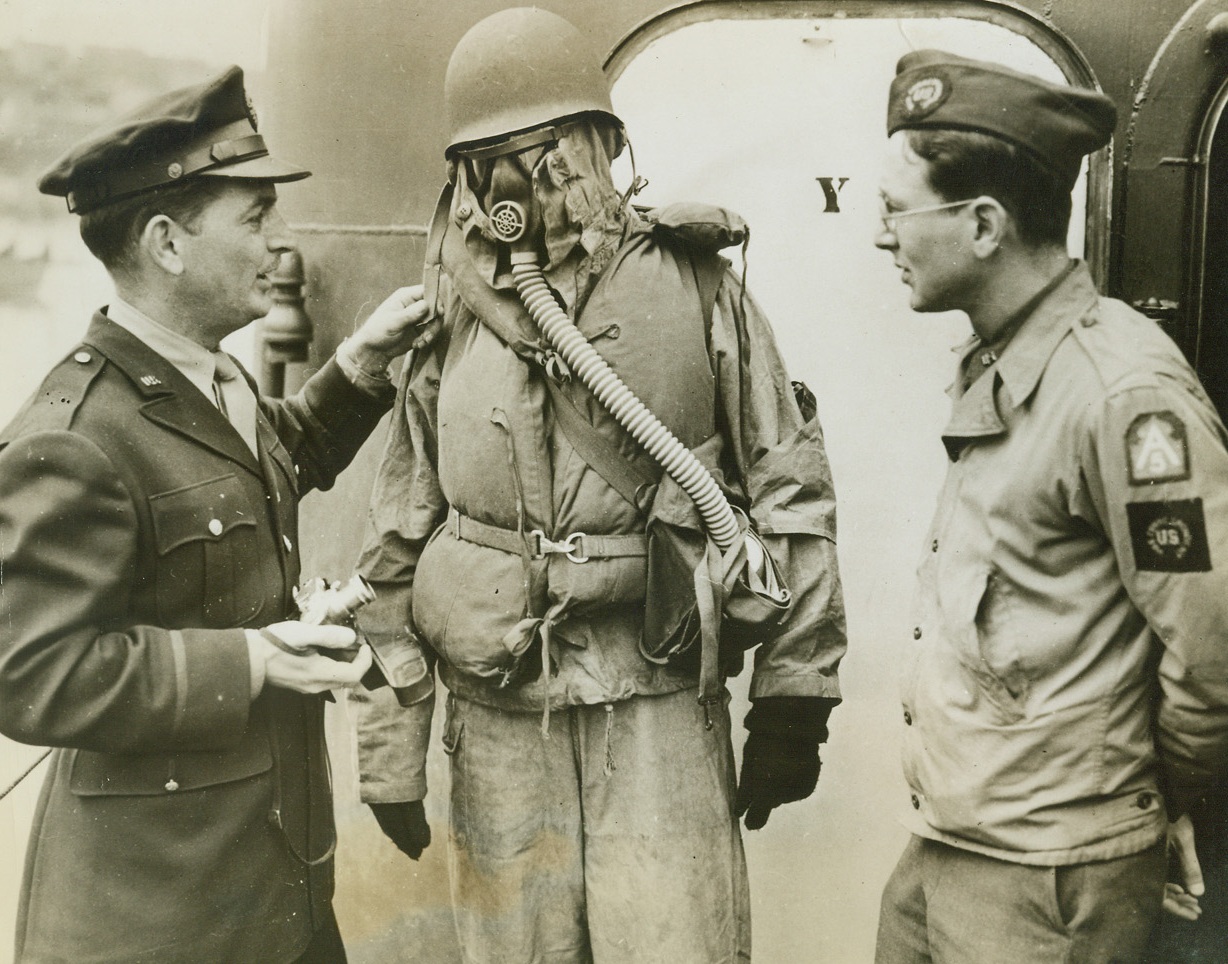
NEWSMAN PREPARES FOR THE WORST, 6/23/1944. AT SEA – Making a personal test to judge how much he will be able to see during combat action in a storm, W.R. Higginbotham of the United Press dons Navy “foul weather gear” aboard a warship. Jack Rice (left), Associated Press photographer, and Tom Wolf of NEA await his report with interest. Credit: US Navy photo from Acme;
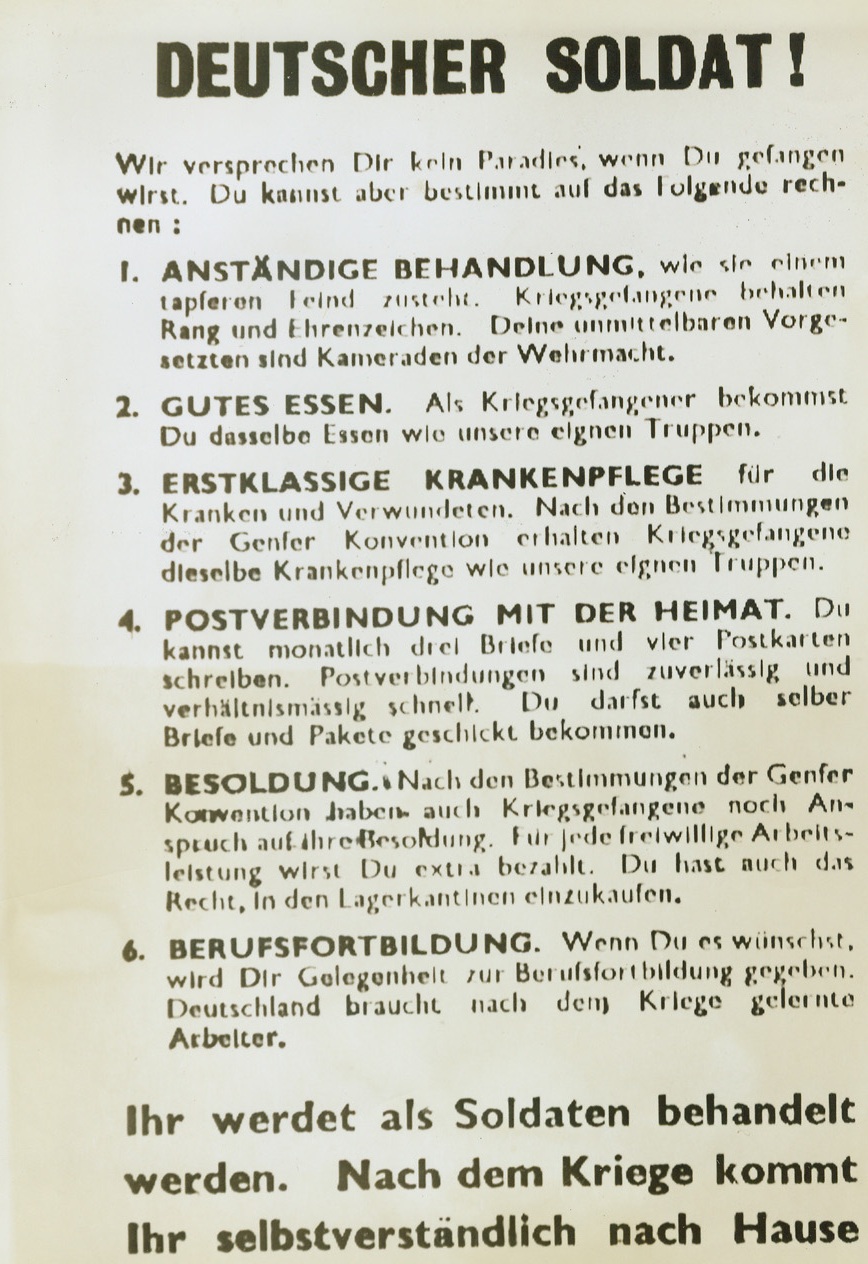
GERMAN SOLDIERS!, 6/22/1944. FRANCE – Here is one side of a pamphlet dropped to the German defenders of Cherbourg by allied airmen. Printed in German, the message does not promise paradise to surrender Nazis, but it does guarantee fair treatment as becomes a brave enemy, good food, first rate hospital care, mail facilities, payroll status and opportunities for furthering education in skilled laborsCredit: Signal Corps radio telephoto from Acme;
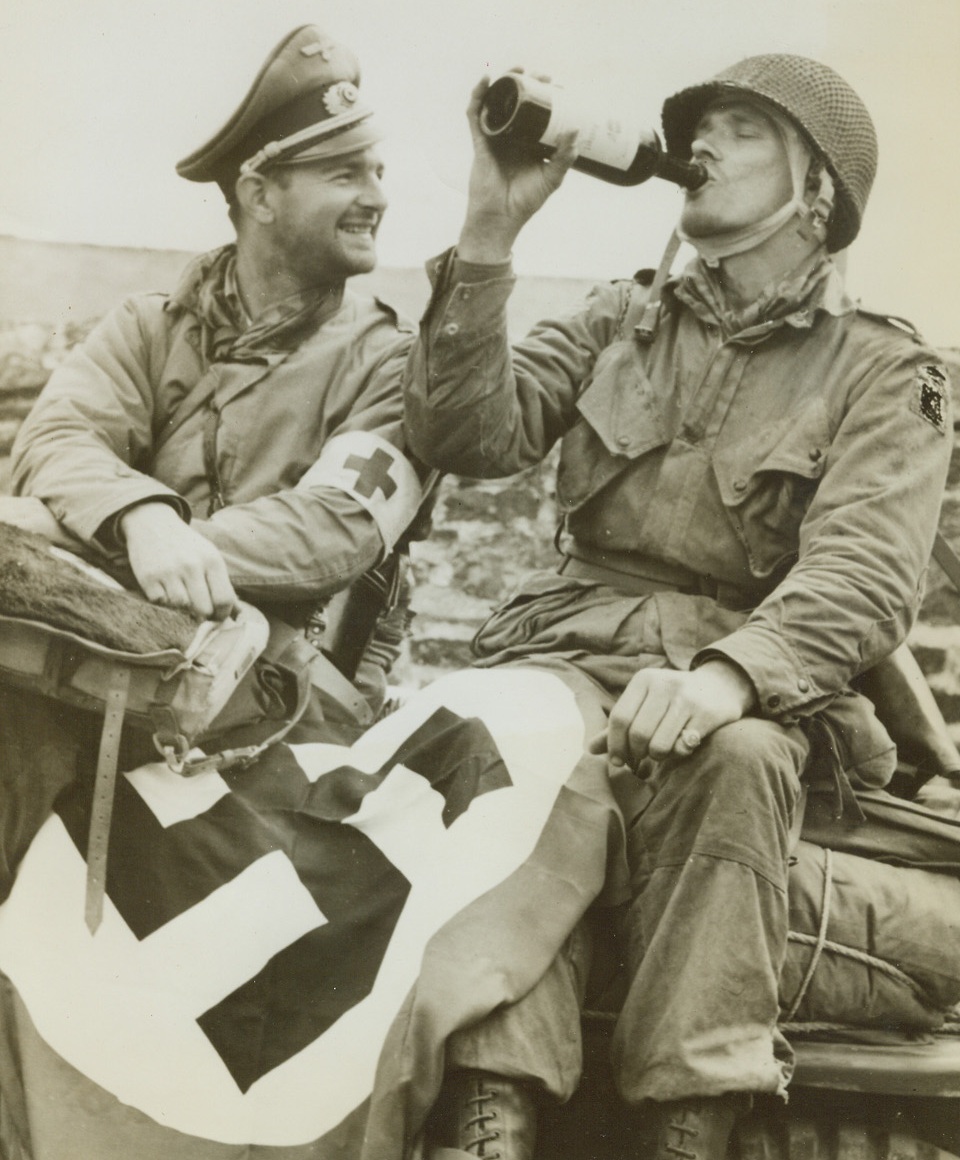
FREED BY ADVANCING YANKS, 6/25/1944. FRANCE – When Lt. Briand M. Beaudin (left), West Warwick, R.I., and Lt. Paul E.K. Lehman, Washington, D.C., parachuted to the ground in France on D-Day, they were captured by German forces in the District of Orglandes. Yanks advanced into this area and captured it, freeing the two airborne infantrymen. Wearing a German hat and displaying a Nazi flag, souvenirs of his experience, Lt. Beaudin waits his turn at the wine bottle which the two are sharing in celebration of their liberation.Credit: Acme;
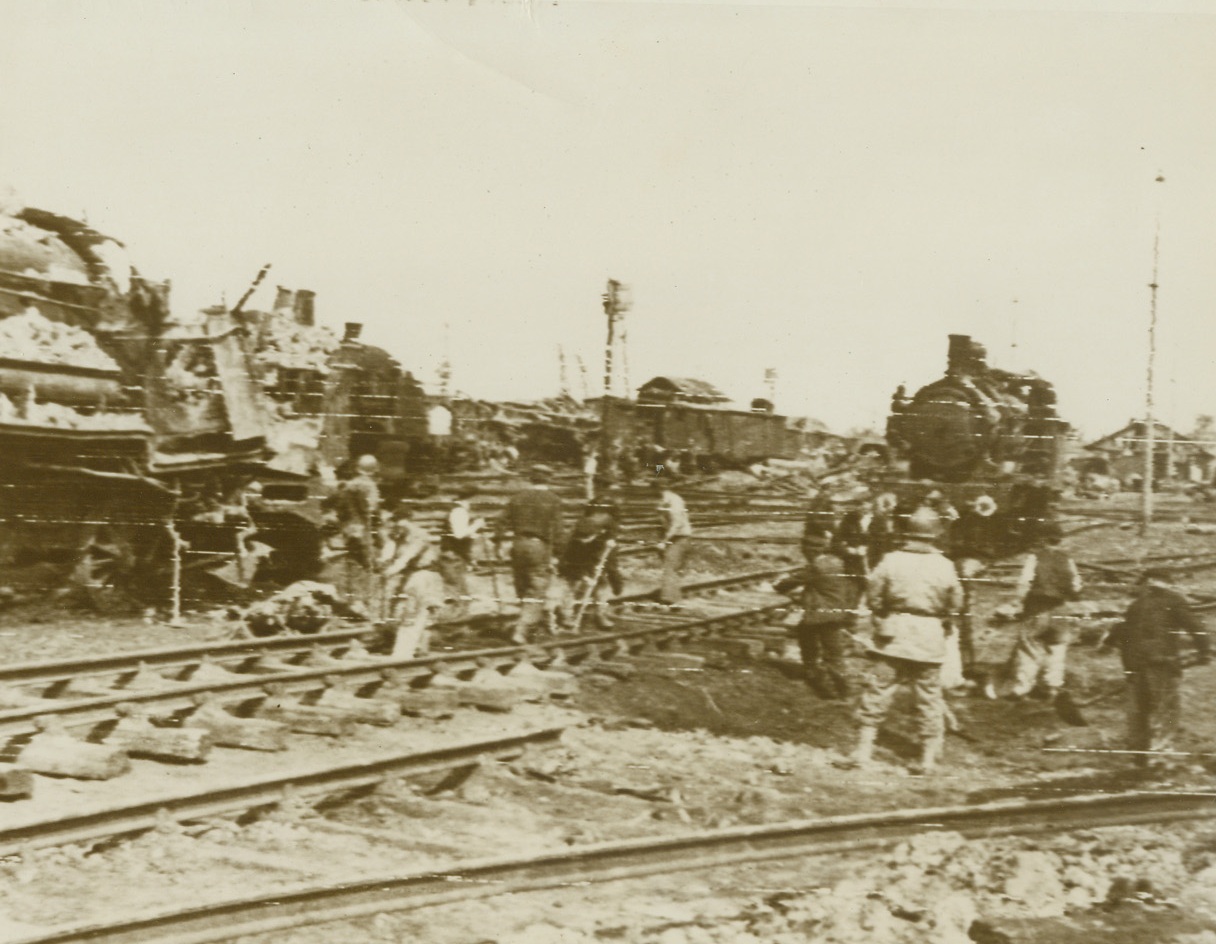
UNDOING THEIR OWN WORK, 6/24/1944. FRANCE – Now that their bombing of French railroads to cut off German supplies and reinforcements has successfully completed its work, American soldiers, with the assistance of French civilians, repair the damaged tracks in the American-occupied area around Cherbourg. Having surrounded the entire city, Yank troops have placed the key port in a state of siege, and the trapped Germans are fighting desperately.Credit: Signal Corps radio telephoto from Acme;
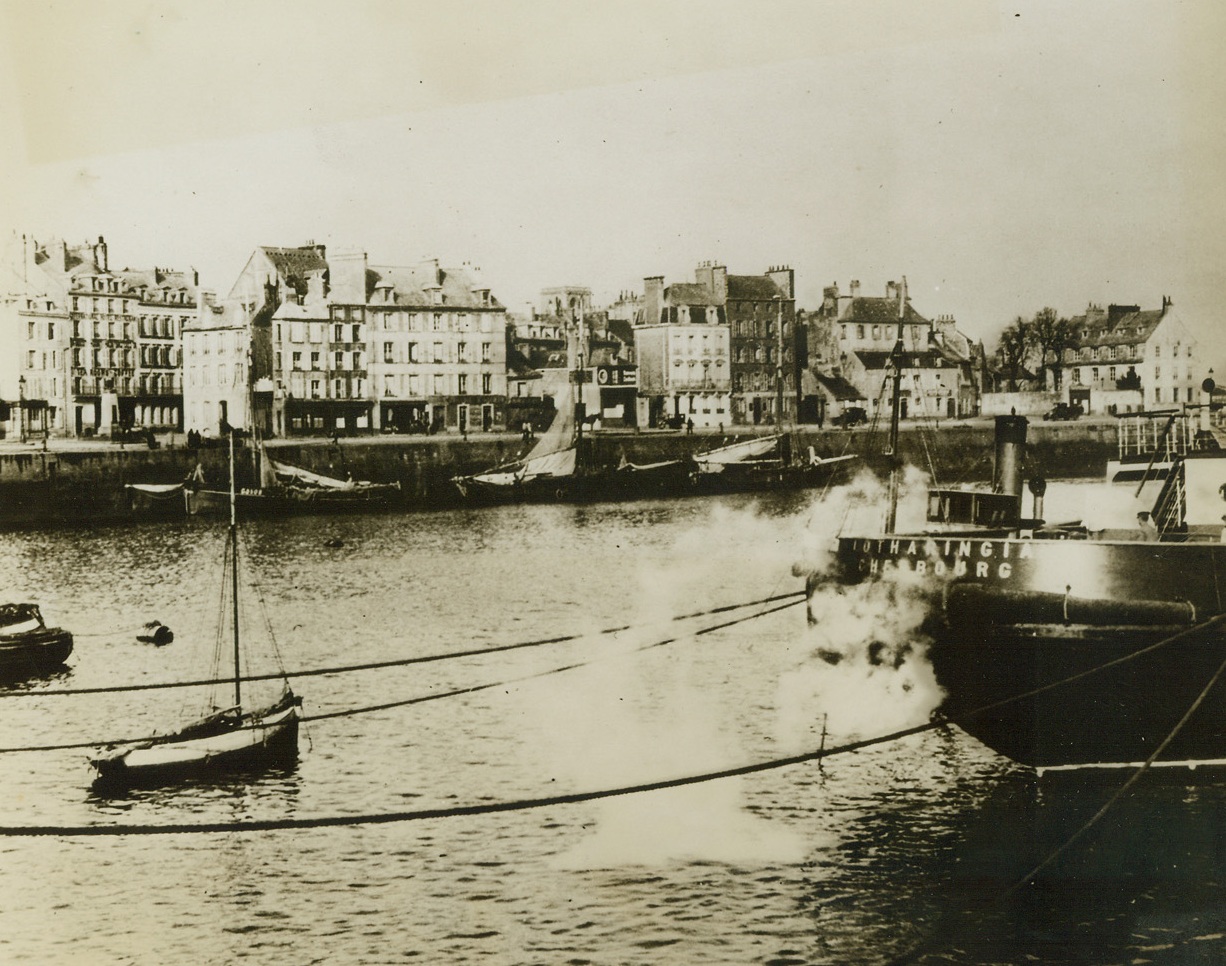
INVASION COASTLINE EXTENDS TO CHERBOURG, 6/6/1944. Combined Anglo-American landing operations—one launched from the sea and the other from the air—against the coast of western Europe early this morning (June 6th) covered the entire coastline from LeHavre to Cherbourg in France. Here is a peacetime scene in quiet Cherbourg harbor. Credit Line (ACME);
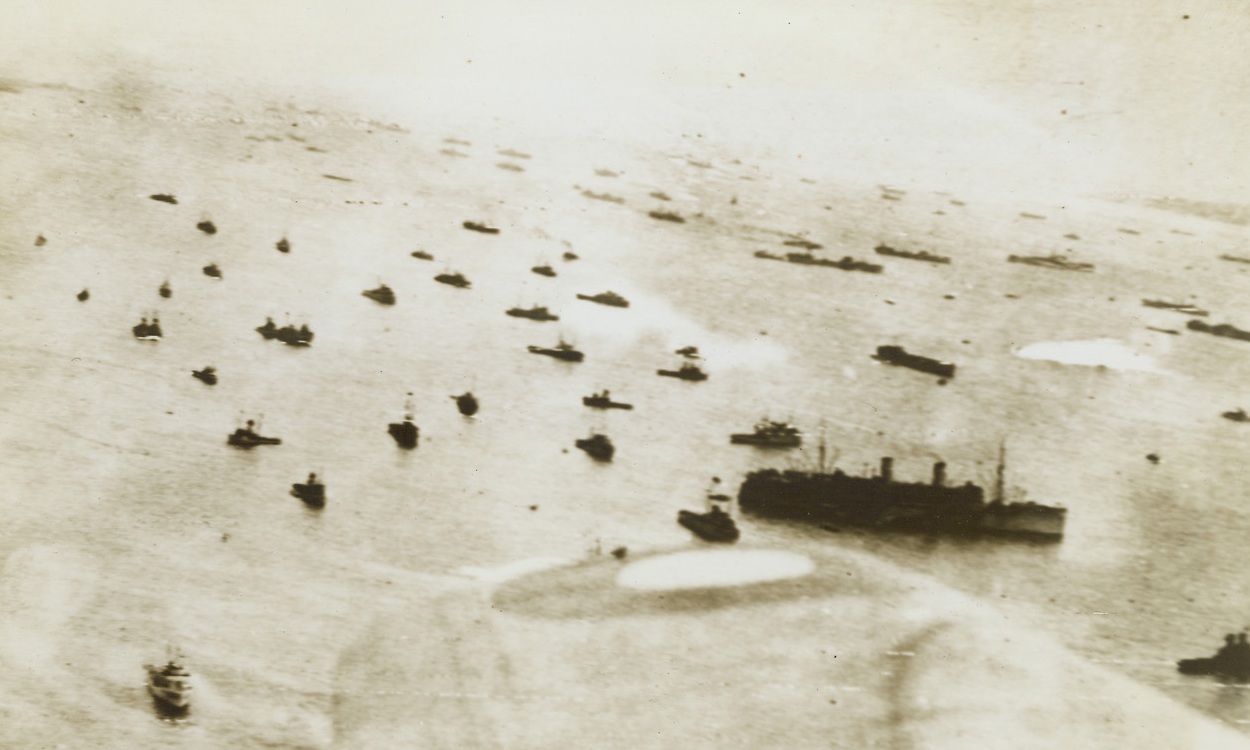
READY FOR THE “JUMP-OFF”, 6/6/1944. ENGLAND—Transports and invasion craft of all types and sizes can be seen in this photo, showing a part of the armada of some 4,000 ships that carried Allied forces to the shores of Normandy. Tonight, British and Americans have penetrated to a point some nine and a half miles inland from the beach. Credit Line (U.S. Signal Corps Radiotelephoto from ACME);
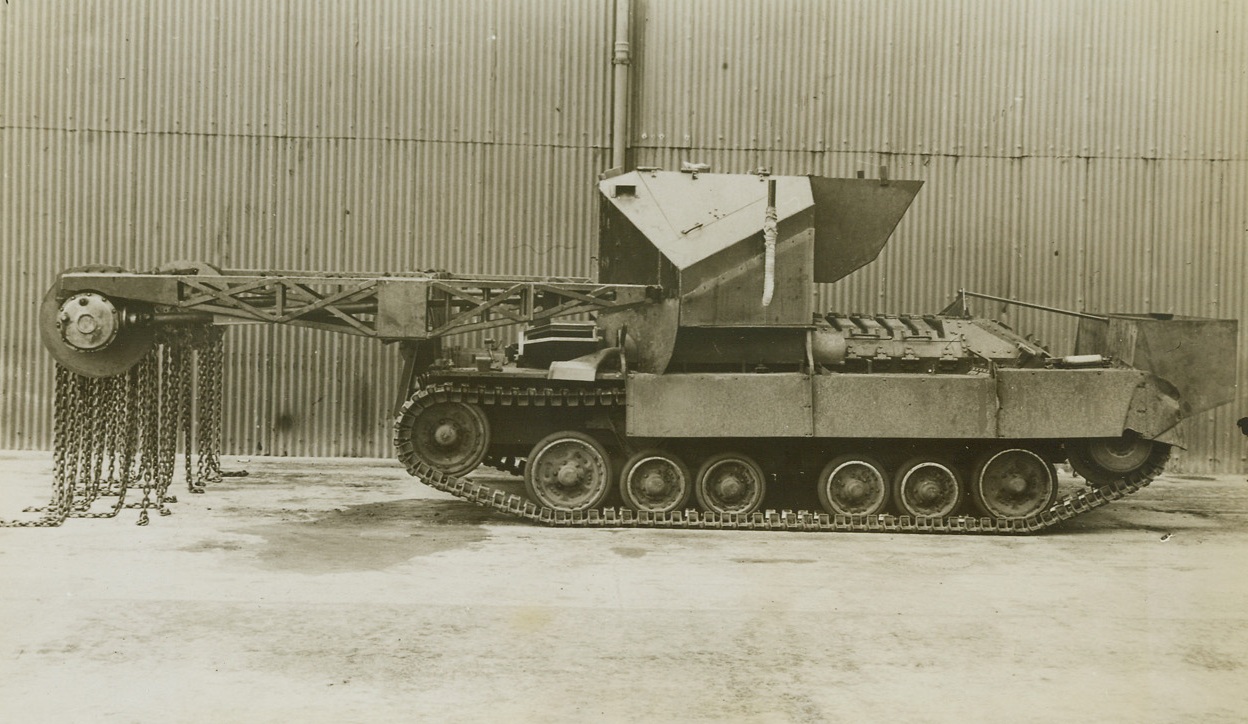
PATH BEATER, 6/29/1944. An Allied secret weapon is the British flail tank called the “Scorpion.” The tank is equipped with chains extended from a boom, which revolve rapidly beating the ground ahead and exploding mines planted by the Nazis. Moving forward in formation the tanks clear the way for advancing infantrymen and supporting vehicles. Credit (British Official Photo from ACME);
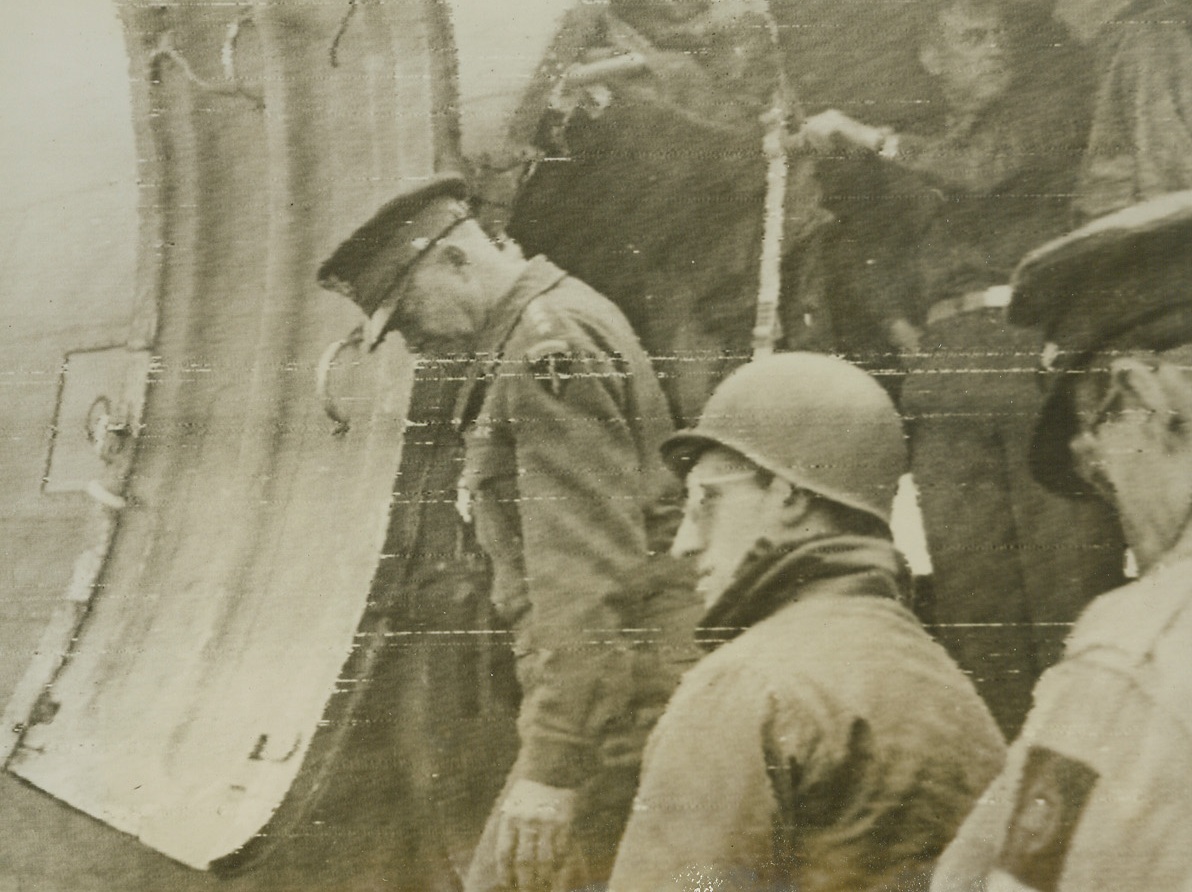
LOOKS GOOD FROM THE AIR, 6/13/1944. FRANCE—Gen. Dwight Eisenhower steps down from a plane on the French beachhead after viewing the progress of the invasion from the air. According to latest reports, the Allies have moved up the Cherbourg Peninsula to capture Montebourg, 14 miles southeast of Cherbourg, key port on the tip of the peninsula. Three villages were also captured by another American column moving up the main Paris Cherbourg highway. Credit (Signal Corps Radiotelephoto from ACME);
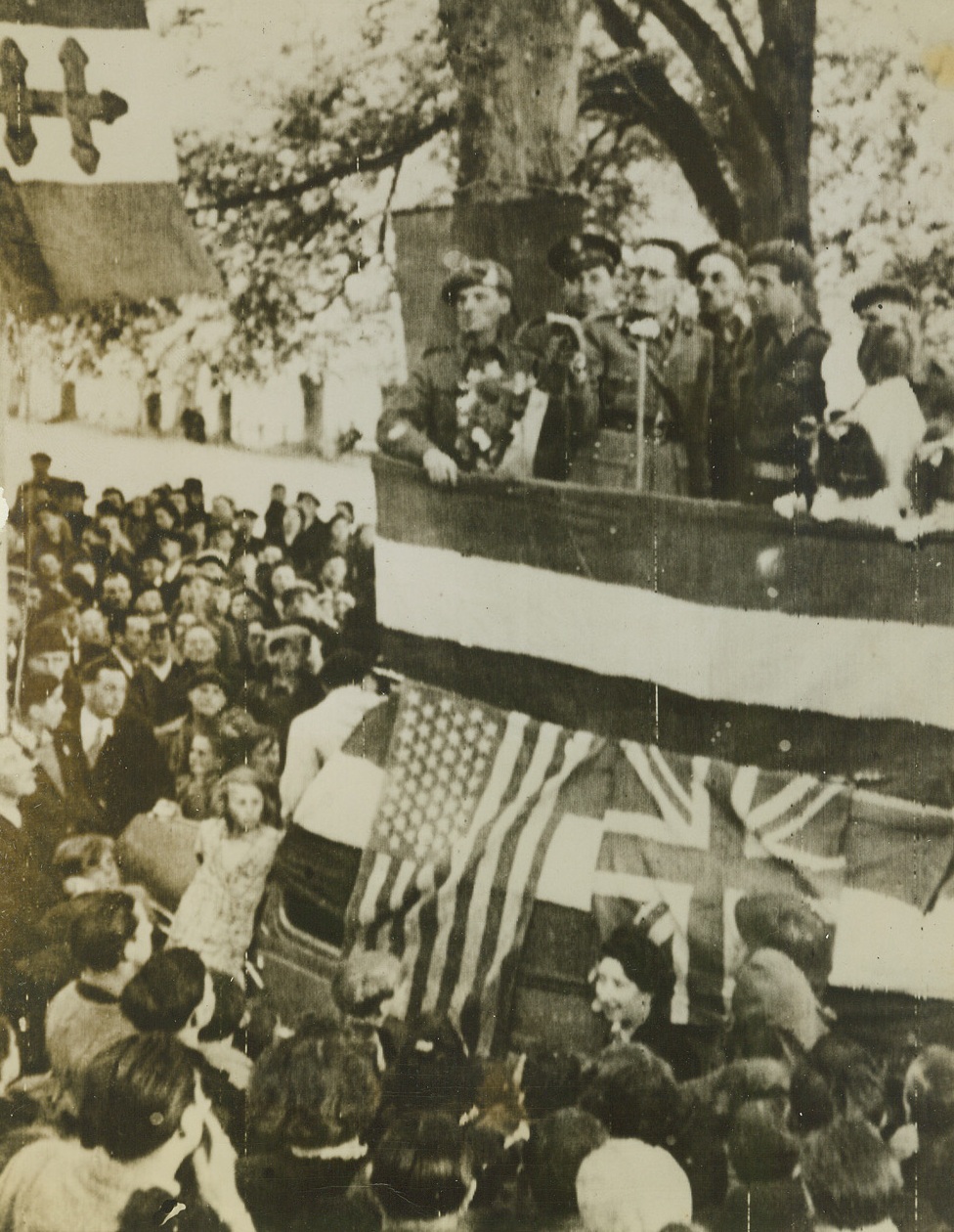
CELEBRATING FREEDOM, 6/12/1944. FRANCE—Allied officers and French war correspondents address the liberated civilians of Bayeux, the first town captured in the invasion of France. British and American flags decorate the speakers’ platform. The Allies have moved up the Normandy Peninsula to capture and threaten Cherbourg. Credit (Signal Corps Radiotelephoto from ACME);
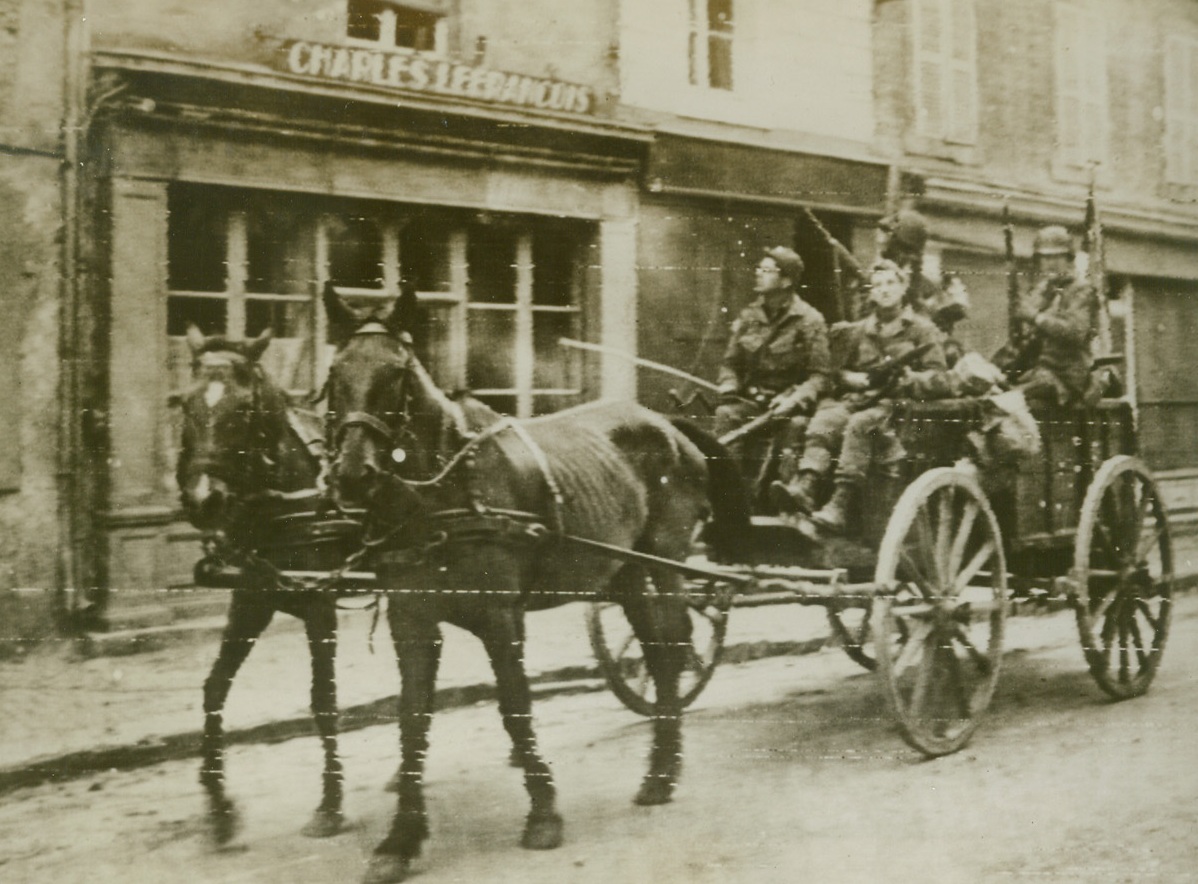
BACK TO “HORSE AND BUGGY” DAYS, 6/12/1944. ST. MERE EGLISE, FRANCE—Although they arrived in France by way of the most speedy, modern means of transportation, these paratroopers of the Allied invasion force revert to the “good ole days” as they jog along behind a horse and wagon. The field wagon was used by the Nazis when they ran short of vehicles. Credit (ACME Photo via Signal Corps Radiotelephoto);
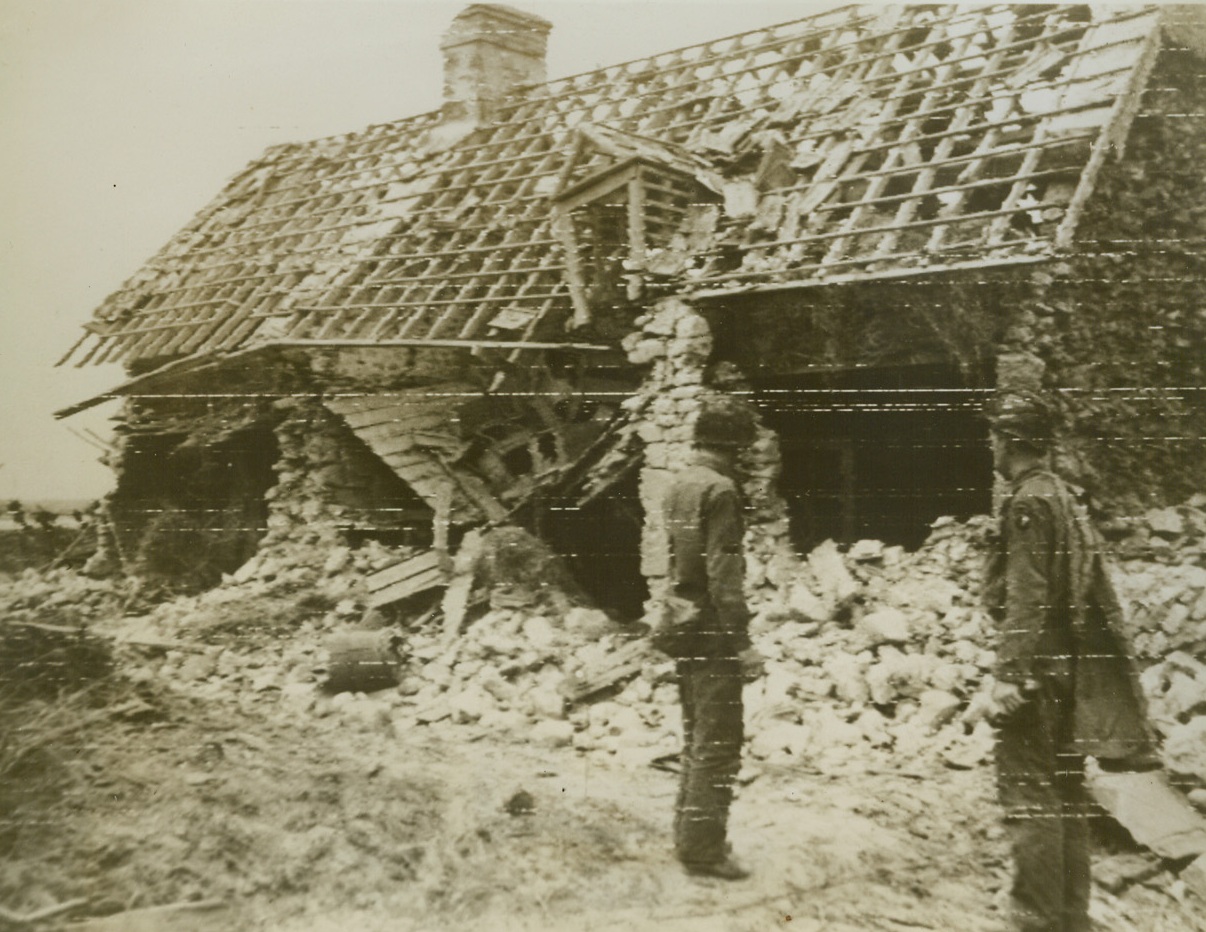
SNIPER’S NEST, 6/12/1944. SOMEWHERE IN FRANCE—Once the cozy nest in which a treacherous Nazi sniper hid himself, this building in Normandy was blown to bits by doughboys advancing overland through France. Latest communiqués from the front indicate that vital Carentan has fallen to the Allies and that American troops have driven 18 miles inland from the center of the French beachhead in a swift advance that threatens the entire German left flank. Credit (Signal Corps Radiotelephoto from ACME);
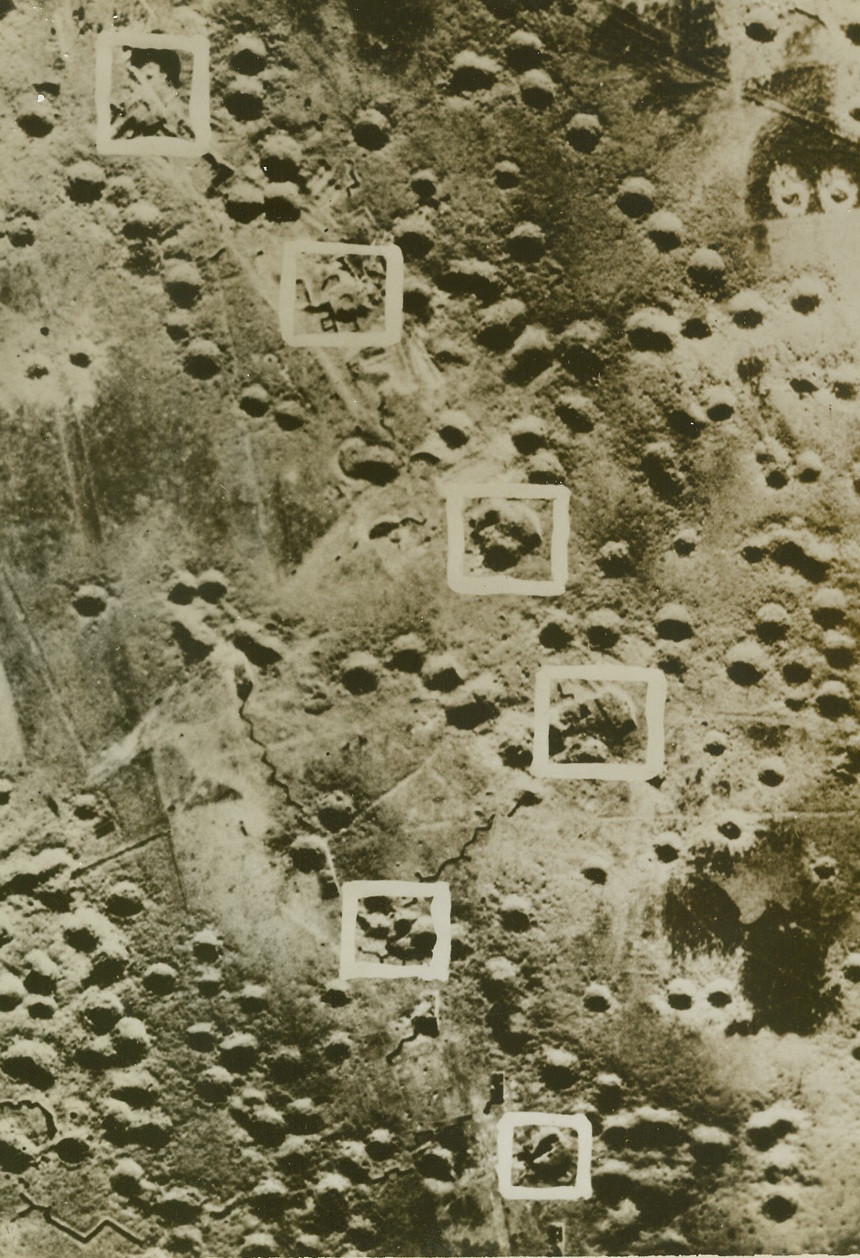
SIX THAT WENT BOOM, 6/12/1944. ST. VALERY EN CAUX, FRANCE—Surrounded by the pock marks left by Allied bombs, these six Nazi defense guns (each one outlined in white) at St. Valery en Caux were blasted to smithereens by RAF bombers in a pre-invasion Channel coast raid on May 27th. The attaching planes scored six direct hits and wiped out the entire battery before they left. Credit Line (ACME);
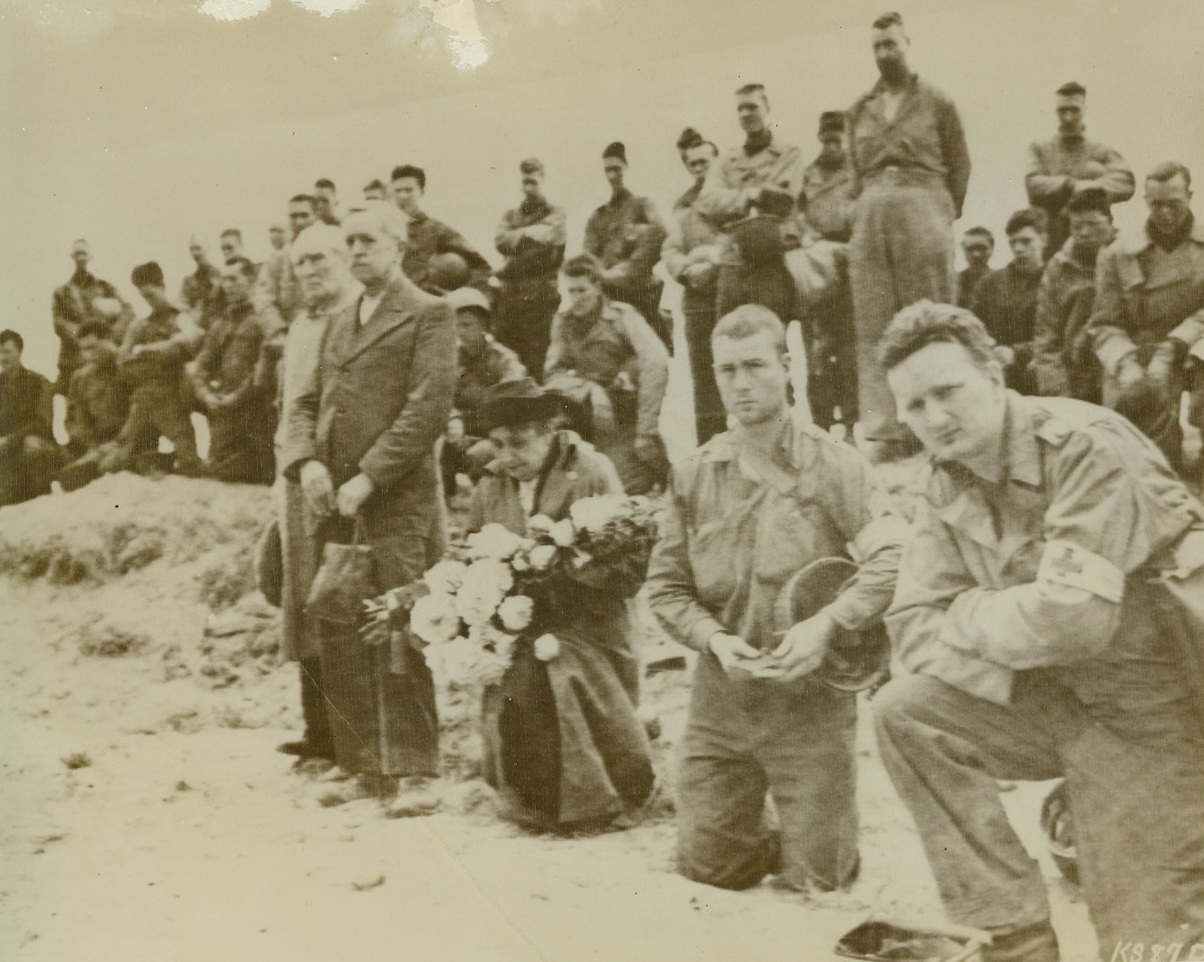
THE SUPREME SACRIFICE, 6/13/1944. FRANCE—They bring liberation to the occupied countries and protect democracy for the world, hundreds of American soldiers gave their lives in the invasion of France. A man of a liberated French town joins American troops in paying tribute to the honored dead, while his wife kneels with flowers for the graves in the first American cemetery in France. Credit (Signal Corps Radiotelephoto from ACME);
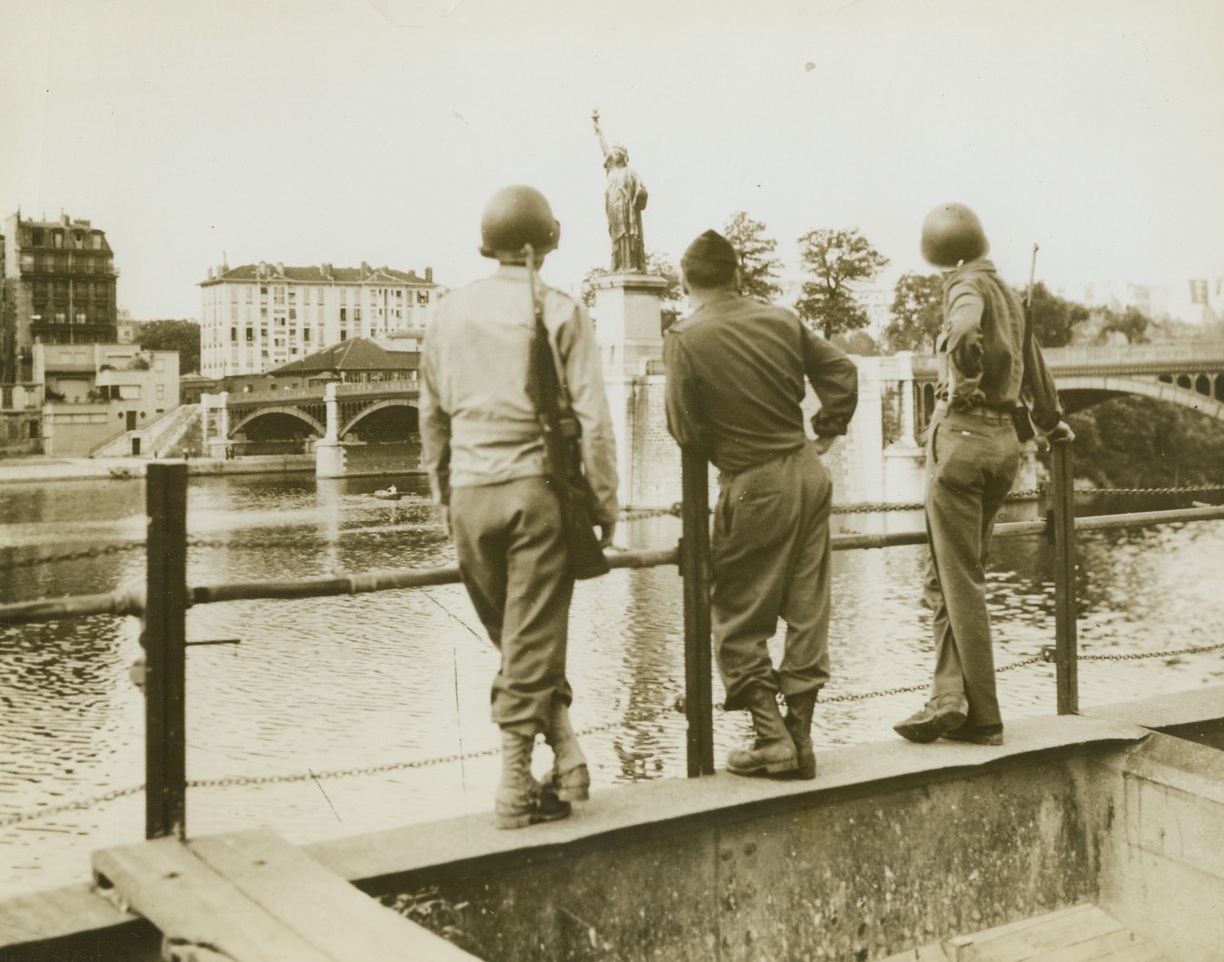
Take Me Back To Noo Yawk!, 6/18/1944. Paris, France - Three American soldiers get their eyes full of the Statue of Liberty which stands in the Seine River, probably seeing in their minds’ eye its counterpart which holds its beacon aloft in New York Harbor. Credit: ACME;
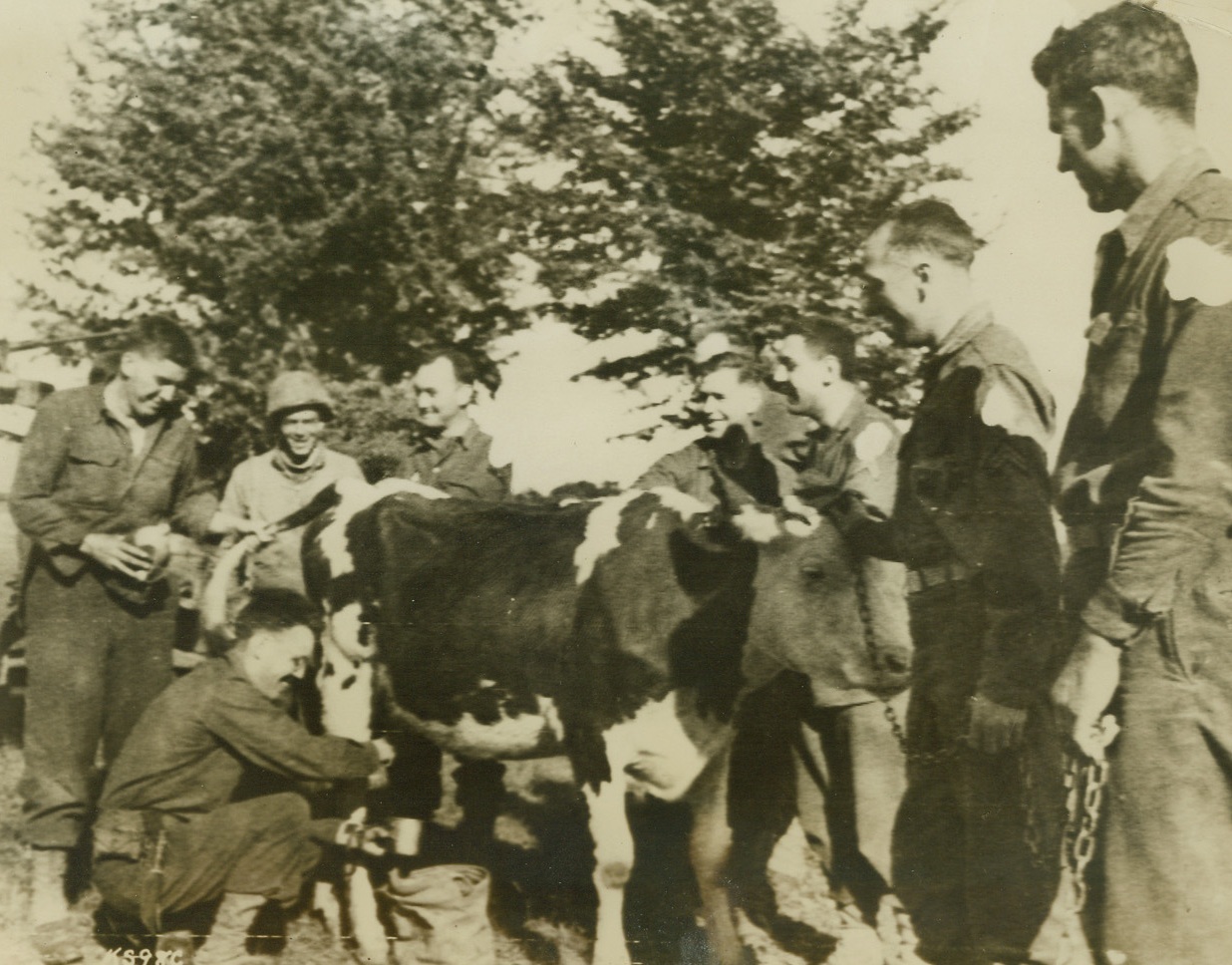
Milk Factory, 6/18/1944. Somewhere in France - Laughing G.I.s hold their cups ready as Private Robert O’Berg fills ‘em up in a field somewhere in France. Knowing how to milk a cow is a short cut to popularity in our Armed Forces, for the fighting Yanks don’t get milk in their c-rations, and they’ll take all of the creamy beverage they can get. Credit: Signal Corps Radiotelephoto from ACME;
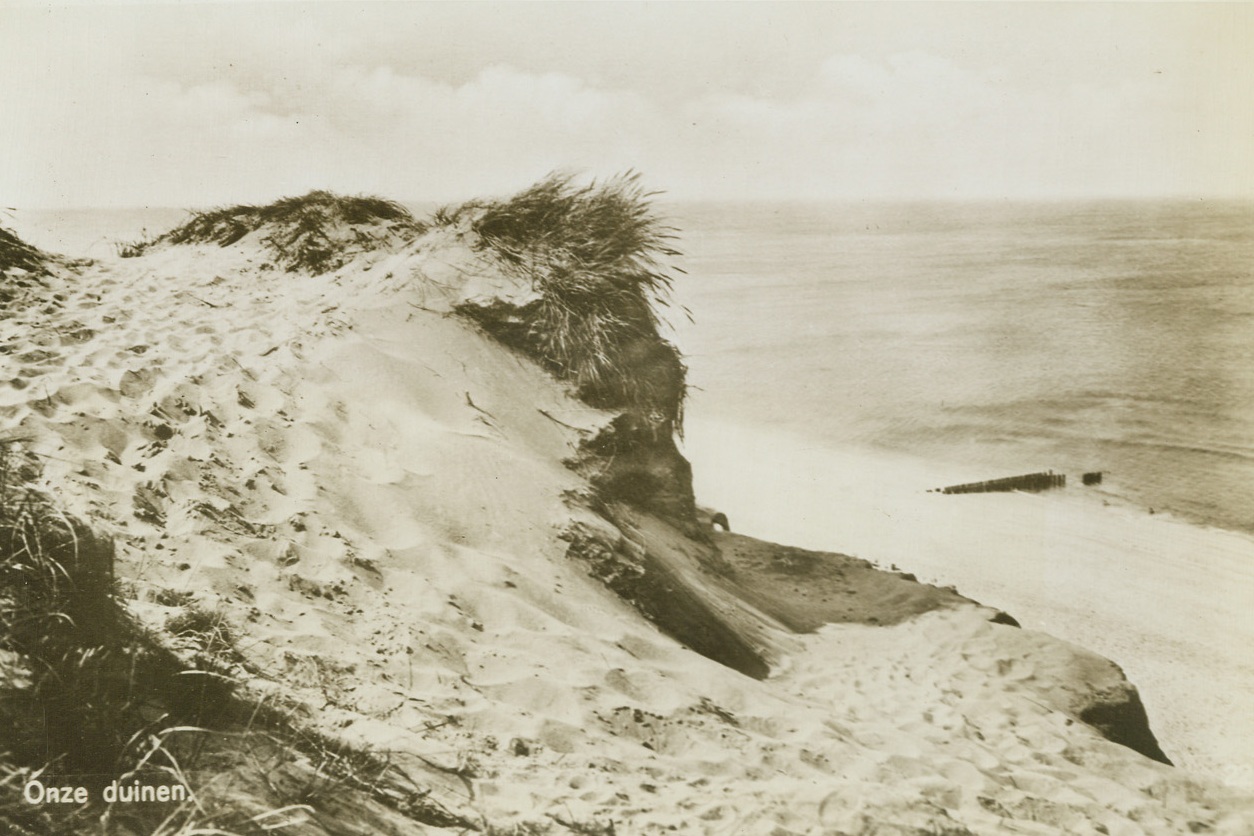
New Battleground?, 6/5/1944. Shortly after German radio reported that Allied forces had begun invasion operations in France, BBC carried an urgent message to the people of Holland from the Allied High Command, advising all residents of coastal Holland to leave their homes immediately, to keep off roads, and to stay away from railroads and bridges. If the broadcast is any indication that Allied fighters will soon land in Holland, the broad, barren sand dunes of the Netherlands—such as these at Scheveningen—may be the next Allied battleground. Credit: ACME photo from Netherlands Information Bureau;

Victory Ahead, 6/27/1944. Cherbourg, France – This is the scene which met the eyes of the Yanks a few minutes before Cherbourg fell into their hands. The key port, their goal during the entire drive up the Normandy Peninsula, lies just ahead, under a pall of battle smoke. When the end loomed near, the Nazis demolished almost everything in sight, especially in the section around the docks, where they took their last stand. Credit: Army photo from ACME;
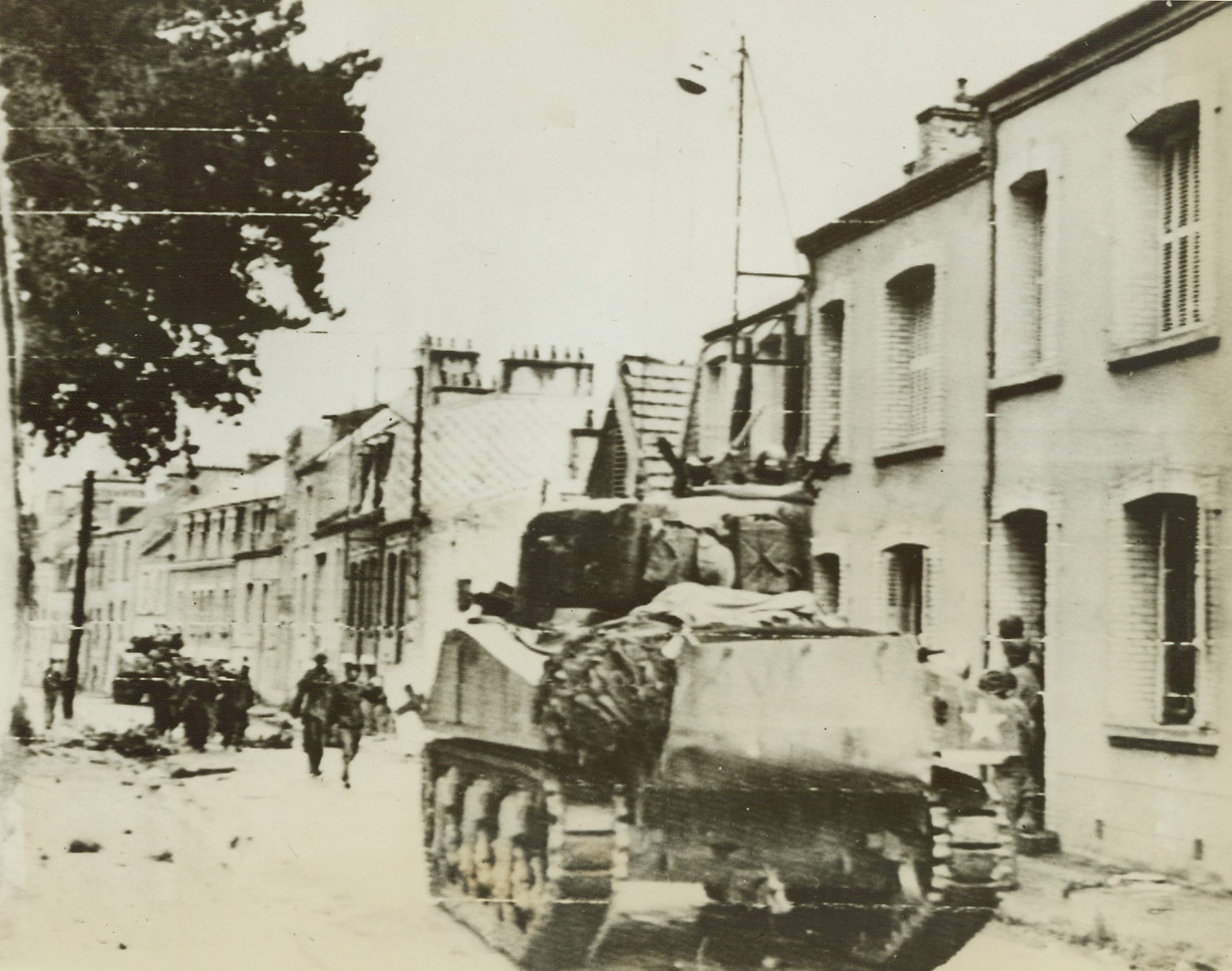
Yanks Make Tank Tracks In Cherbourg, 6/27/1944. Cherbourg, France – While Yank soldiers seek shelter in doorways from German snipers, American tanks move through the streets of Cherbourg immediately before the fall of the port city was officially announced. Now that American forces are in possession of Cherbourg, the Allies have at their disposal an adequate port for the landing of reinforcements and supplies. Credit: Army Radiotelephoto from ACME;
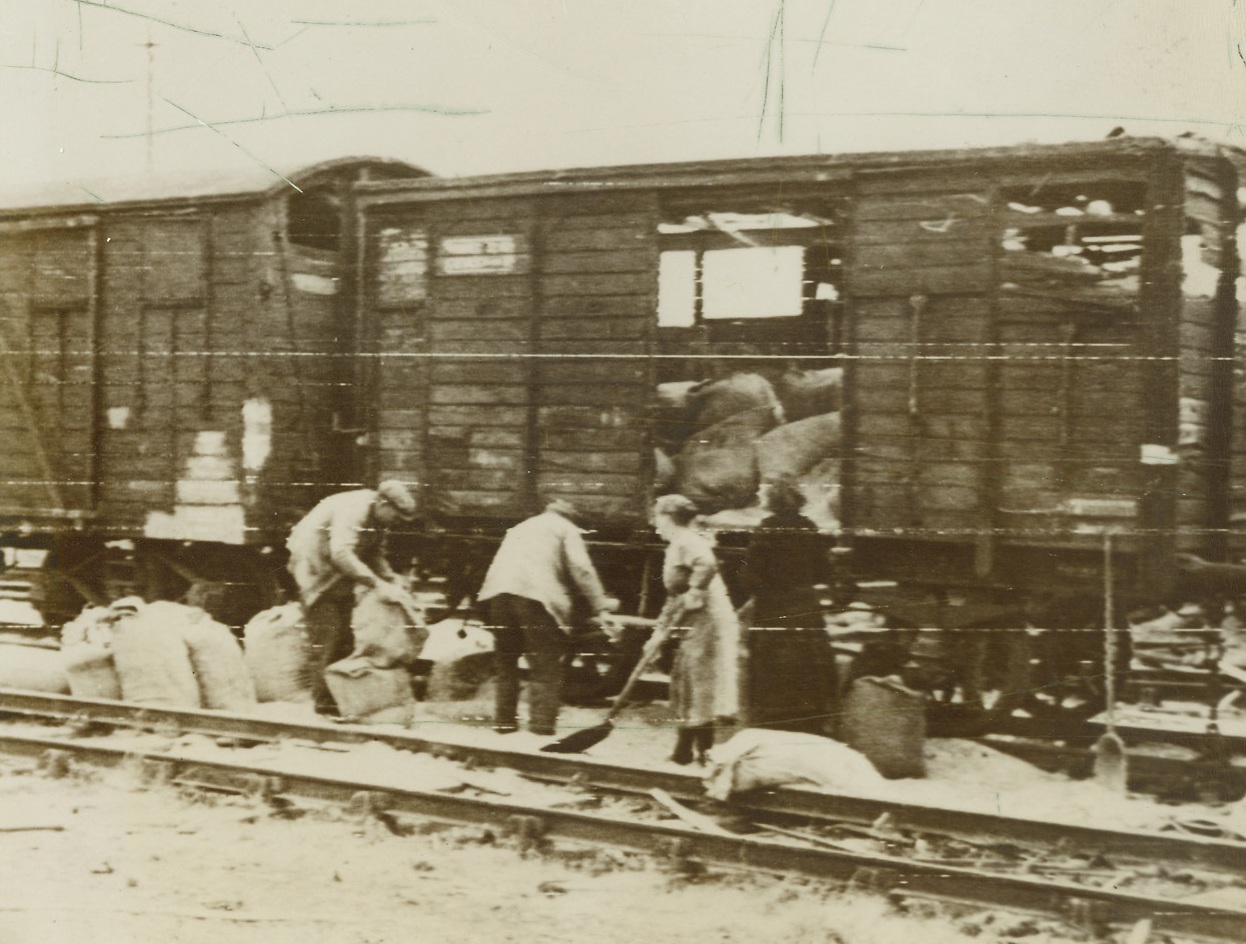
German Supplies Sidetracked, 6/24/1944. France – French farmers salvage grain from freight cars which were bombed by the Allies. The food was en route to Germany when our planes pummeled the train. The French civilians, who were kept in an almost starved condition during the Nazi occupation, are receiving food supplies from their liberations. Credit: Signal Corps Radiotelephoto from ACME;
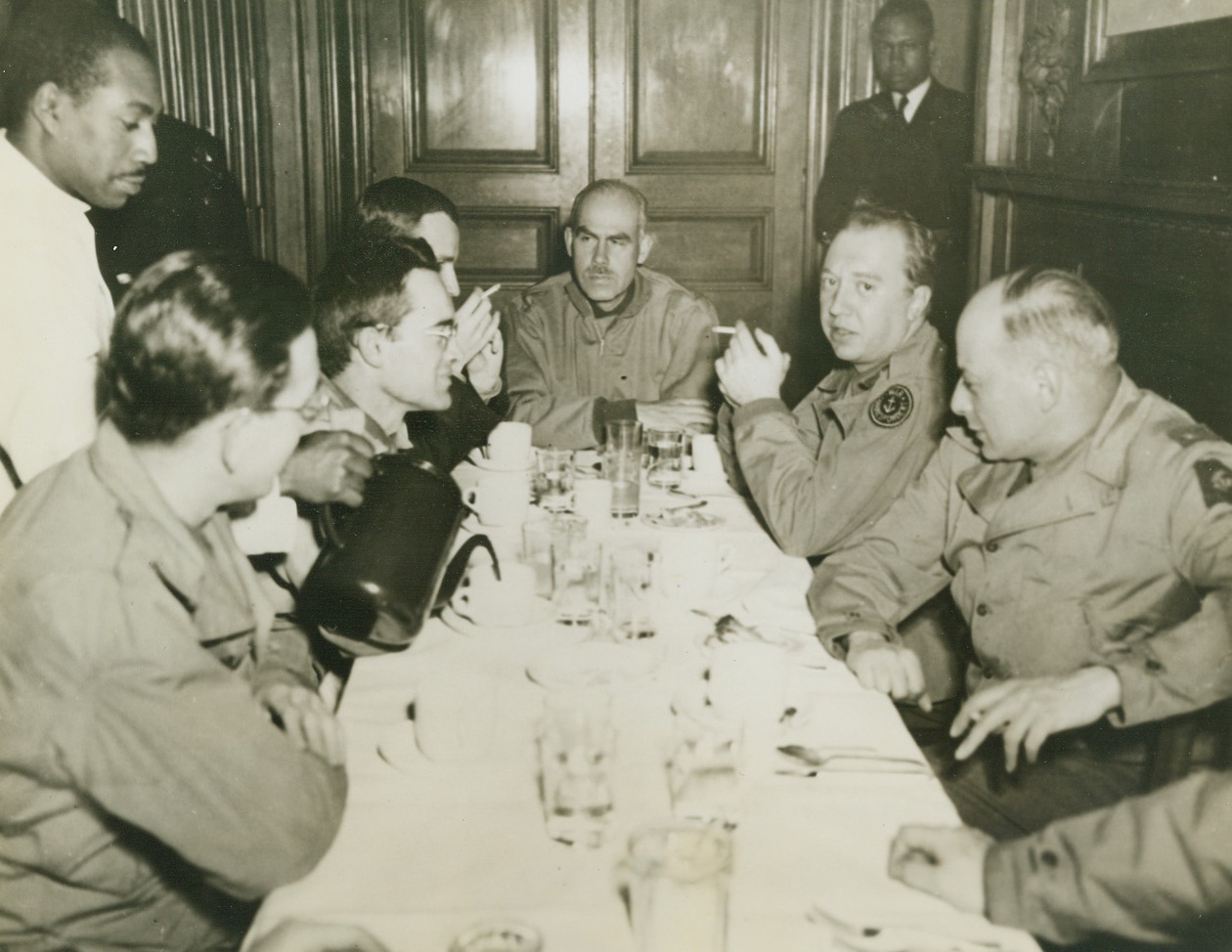
Correspondents Dig In – That’s Chow, 6/23/1944. England – War Correspondent’s who have covered the naval aspects of the invasion get together at a port somewhere in England for chow with Col. Ernest Depuis (center) of the Supreme Allied Headquarters staff. The correspondents are (left to right): Tom Wolf, of NEA; Peter Whitney, of the San Francisco Chronicle; R.L. Strout, of the Christian Science Monitor; Fred Sondern, Jr., of the Reader’s Digest; and Marcel Wallenstein, of the Kansas City Star. Credit: US Navy Photo from ACME;
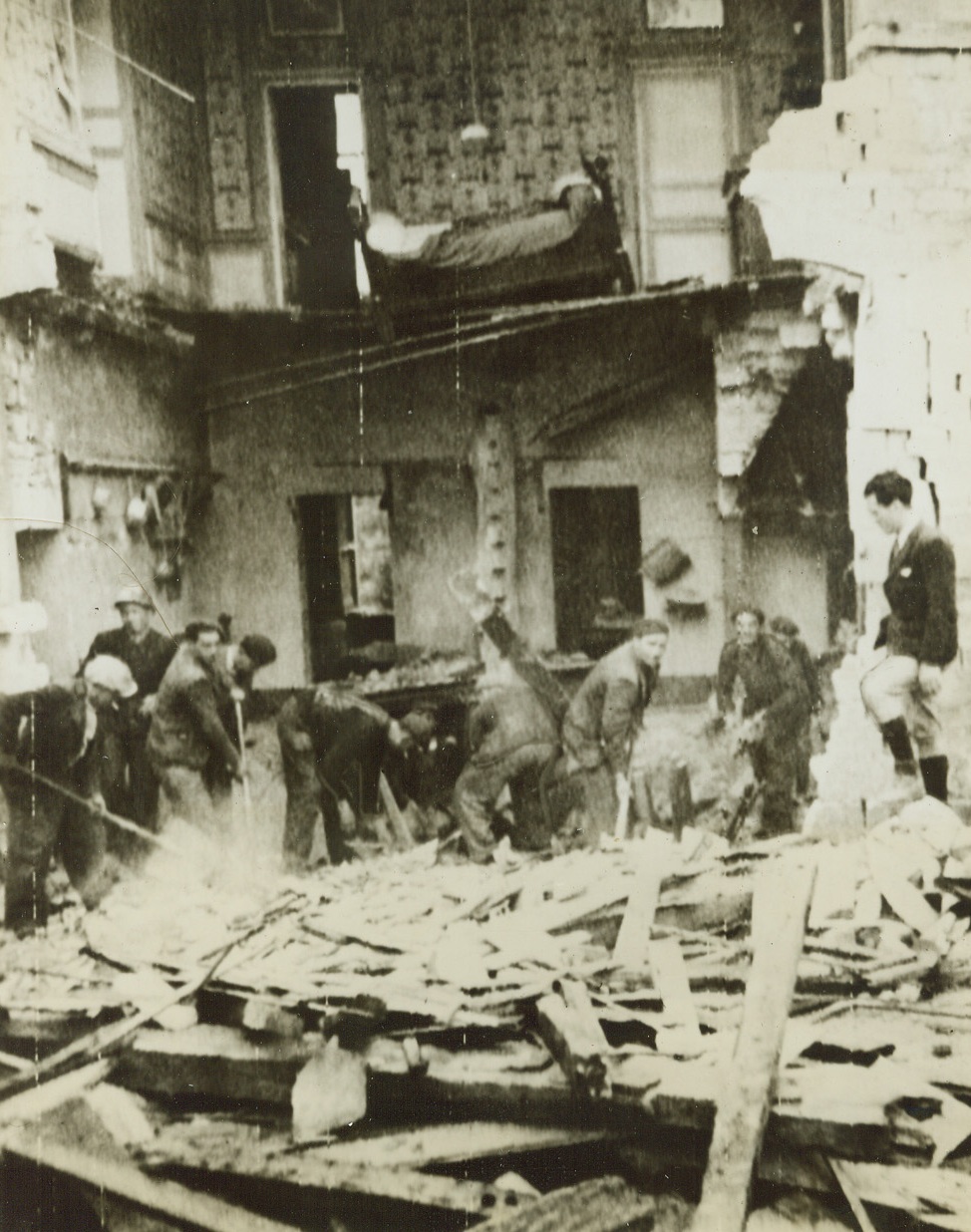
Cherbourg Citizens Dig Out, 6/29/1944. France – Returning to their homes after the capture of Cherbourg by the Allies, citizens of the French city start the important task of digging out the debris to start reconstruction operations. The scene of the most bitter fighting on the Normandy Peninsula, shattered homes are evidence of the terrific artillery fire from both the Allies and the Nazis the city was subjected to. Credit: Signal Corps Radiotelephoto from ACME;
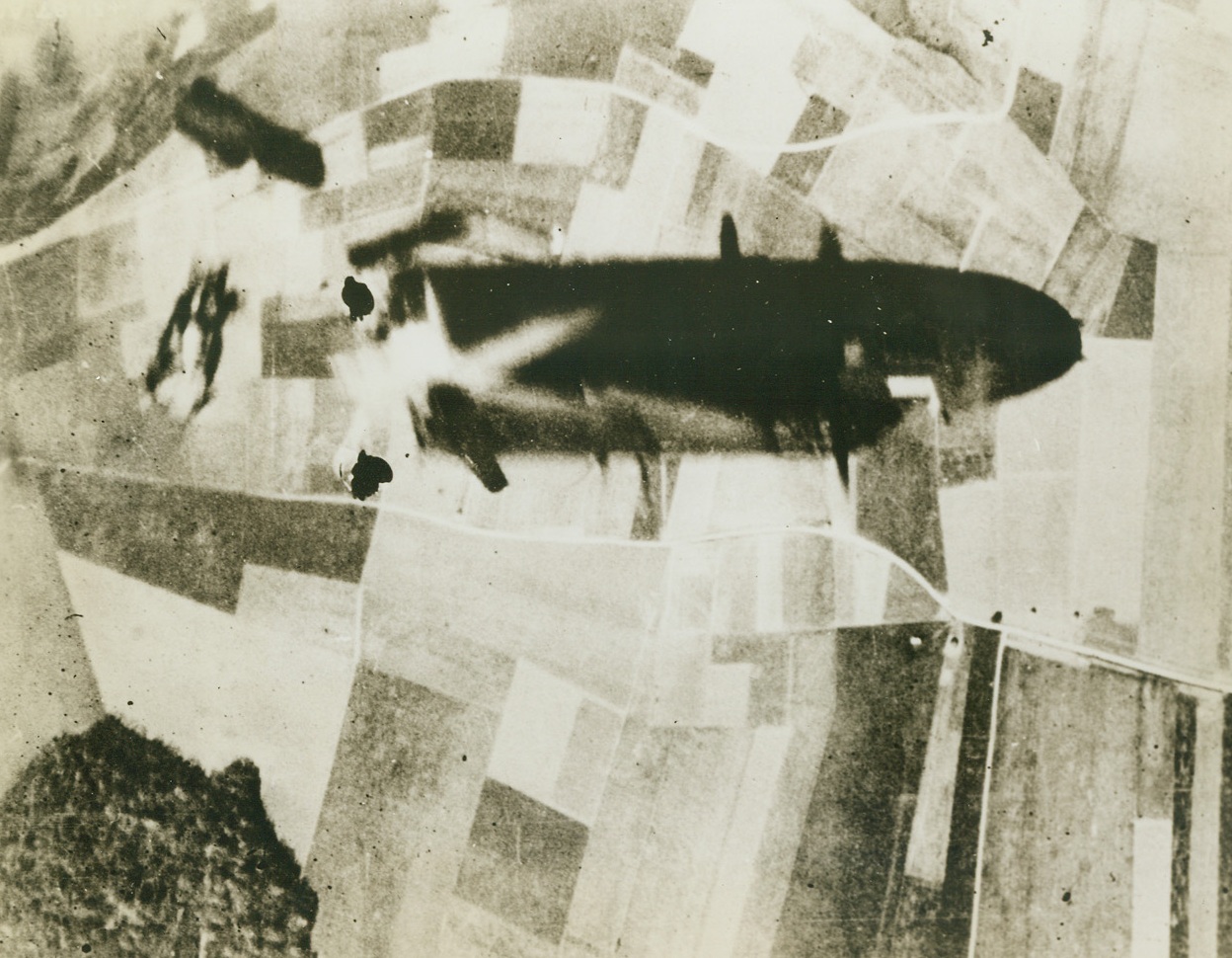
Death on the Wing, 6/29/1944. France – A B-26 Marauder, hit by flak over the French coast, literally is blown to bits, with only the nose of the once magnificent ship momentarily aloft. Remarkable photo was taken by accompanying plane’s camera. Credit: USAAF photo from ACME; France – A B-26 Marauder, hit by flak over the French coast, literally is blown to bits, with only the nose of the once magnificent ship momentarily aloft. Remarkable photo was taken by accompanying plane’s camera. Credit: USAAF photo from ACME;

Enemy Mines Take Toll, 6/13/1944. Washington, D.C. – Even though the enemy may have been driven from this sector of the invasion beachhead, all is not safe. Overturned Bren Carrier (left) moving on a French road hit a mine and was flipped over as easily as one turns over a matchstick. Credit: Official Canadian photo from London via Signal Corps Radio-telephoto from ACME;

Where Artillery Caught German Column, 6/27/1944. Barneville, France – Dead horses and overturned wagons lie in the ditch of the road from Barneville to Bricquebec, where the retreating German column of which they had been a part, had been caught be American artillery fire and wiped out. An American bulldozer, clearing the road, pushed the wreckage into the ditch. At the right, a U.S. truck rolls down the road towards Cherbourg, now in Allied hands. Credit: ACME photo by Bert Brandt for War Picture Pool;

Sniper Hunt, 6/27/1944. Cherbourg, France – Amid the ruins of Cherbourg, two American soldiers peer at a window from which a German sniper had been shooting at U.S. troops. Photo, flashed to the U.S. by radiotelephoto today, was taken during the hand-to-hand fighting in the streets of the important channel port after the Nazi commanders had surrendered. Credit: ACME photo by Bert Brandt for War Picture Pool via Army Radiotelephoto;
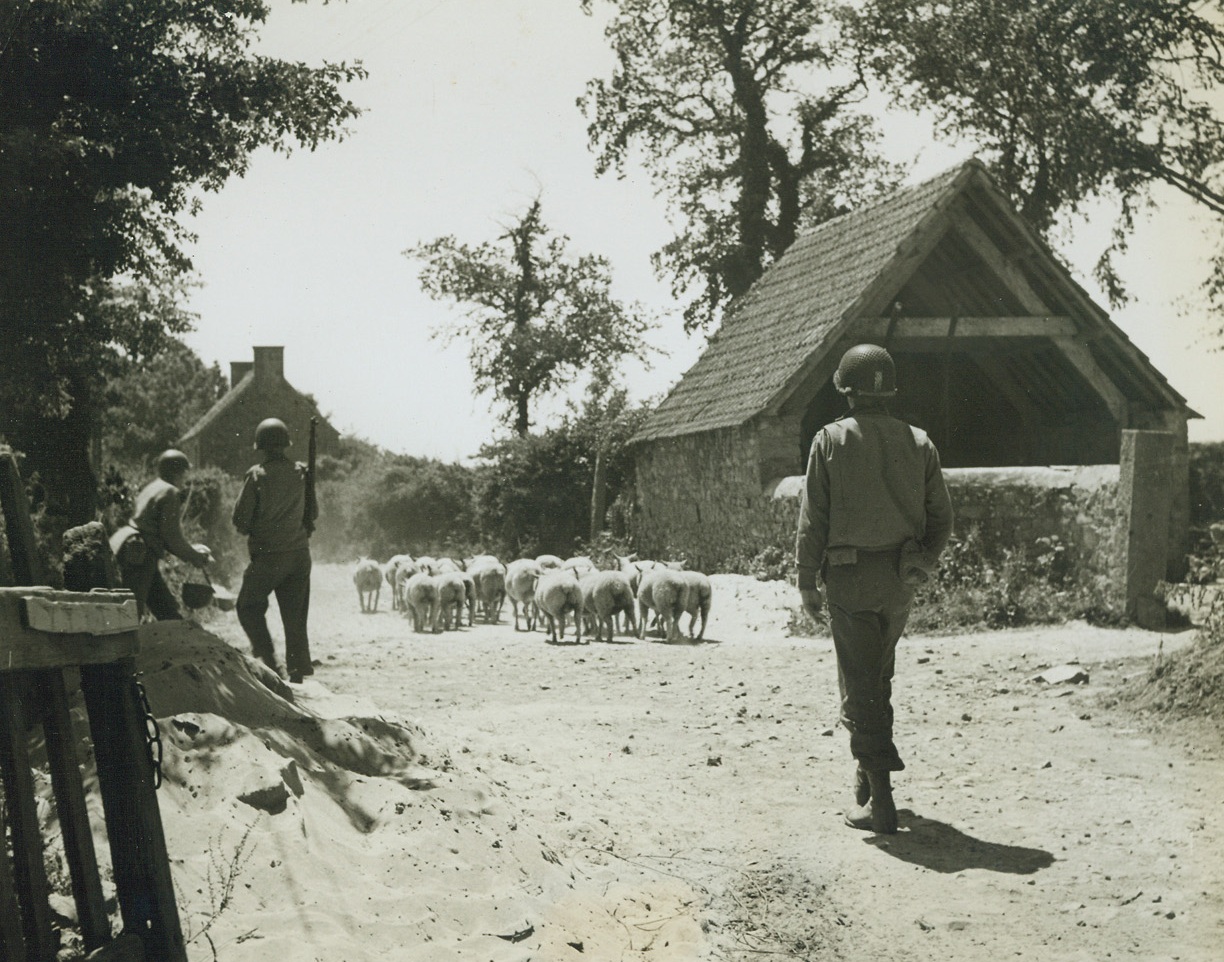
Herdsmen in Uniform, 6/28/1944. France – Men of the invasion troops in France have to be jacks-of-all-trades. Here, near the Cherbourg front, soldiers steer a herd of sheep away from their bivouac area. Credit: ACME photo by Bert Brandt, War Pool Correspondent;

Rescue, 6/28/1944. England – After a pilotless Nazi plane crashed on a house in southern England, its occupants were rescued by firemen and wardens. Here a woman is carried down a ladder from the house. Credit: ACME;
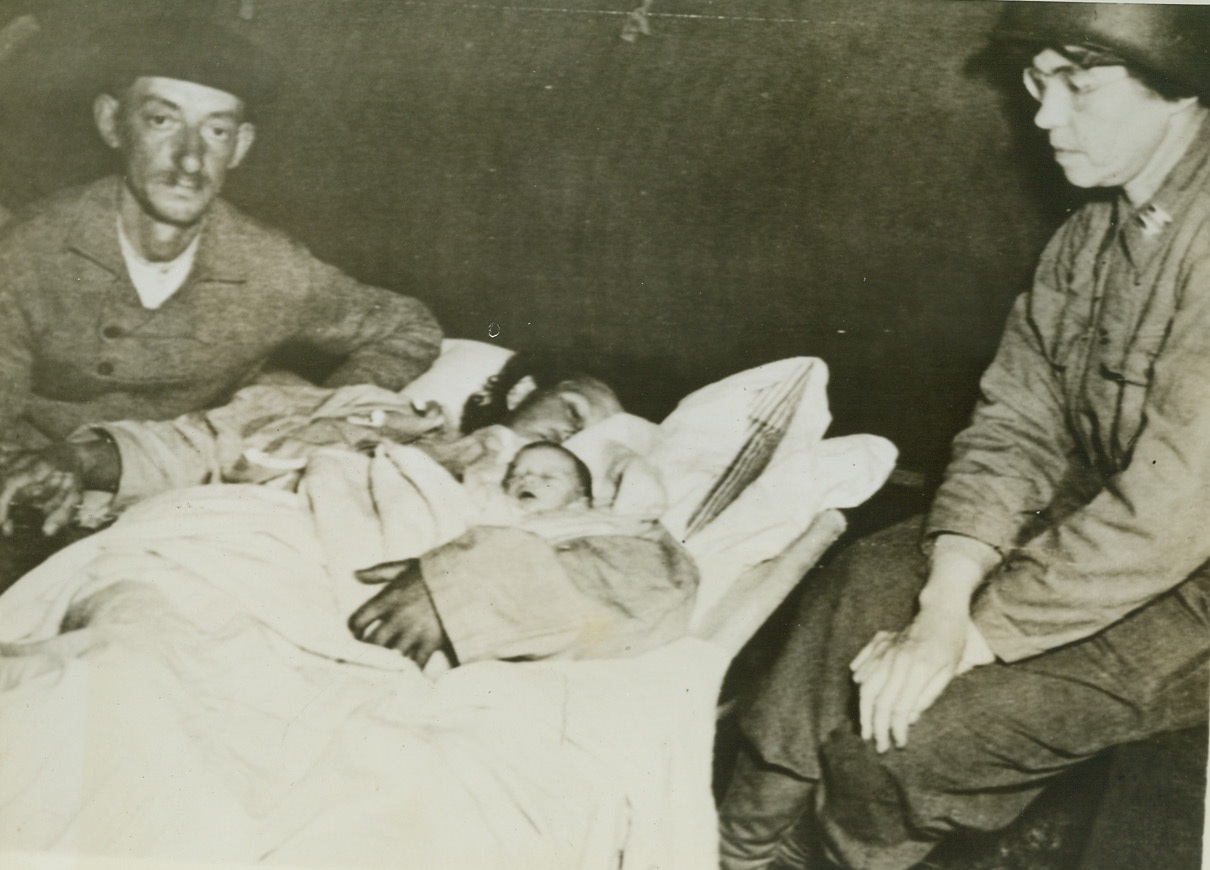
First Baby Born In U.S. Beachhead Hospital, 6/28/1944. France – Believed to be the first French baby to be born in a U.S. hospital in France, Bieni-Aime Cousnnfeory is shown here with its mother and father. At the right, is Capt. Kathryn Helm, of Cleveland, Ohio, Chief Nurse at the hospital on the Cherbourg Peninsula. Credit: Army Radiotelephoto from ACME;
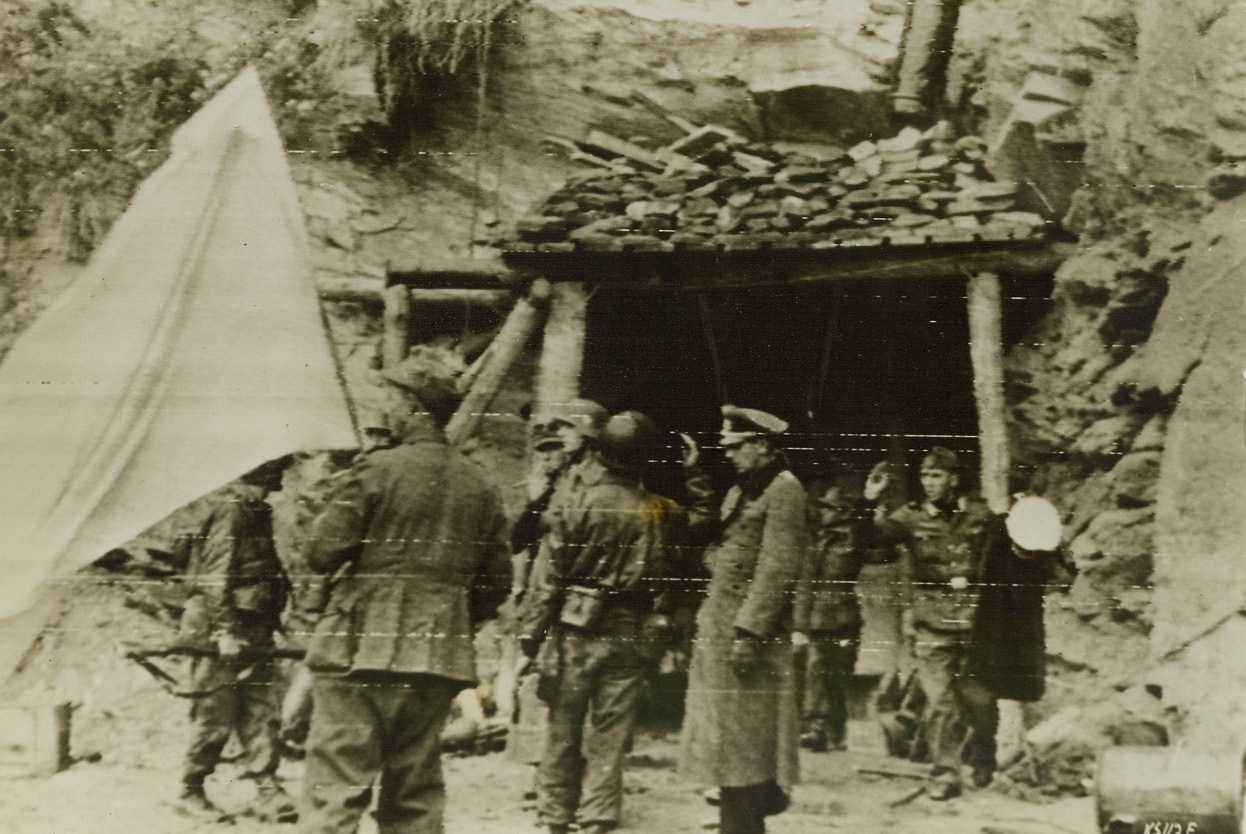
German Commanders Give Up, 6/28/1944. Cherbourg, France – A German soldier, (left, foreground) holds a white flag of truce, near the entrance to an underground fortress, as Lt. Gen. Von Schlieben, Commander of the Cherbourg Garrison, and Rear Admiral Walther Hennecke, Sea Defense Commander of Normandy, emerged with others of their command to surrender to the Americans. Credit: Army Radiotelephoto from ACME;
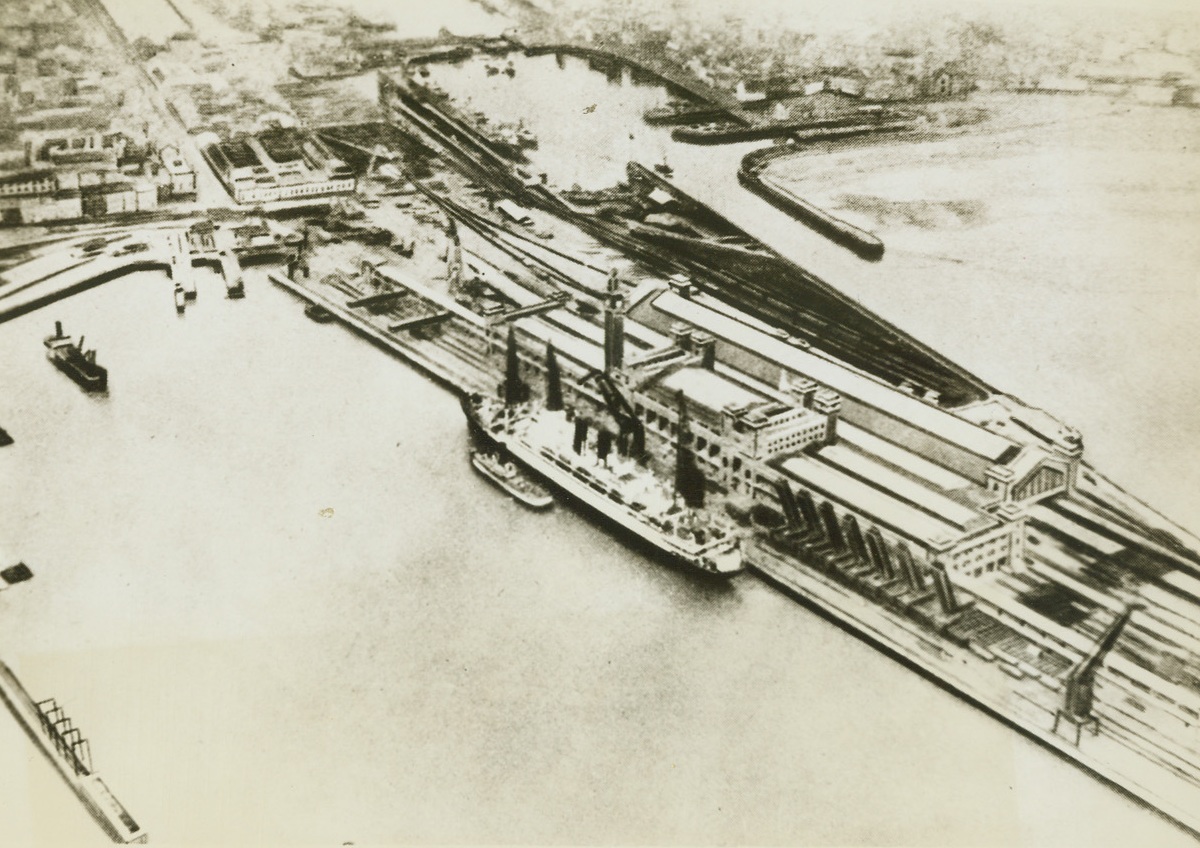
End of Invasion Coast, 6/6/1944. Cherbourg, France – Here is an air view of the important French Harbor of Cherbourg, which lies at the end of the long “invasion coastline” of Occupied France. Reports of the long-awaited Anglo-American landings in Western Europe indicate that the entire French coast between LeHavre and Cherbourg is involved in the military operation – probably the greatest in history. Credit: ACME;
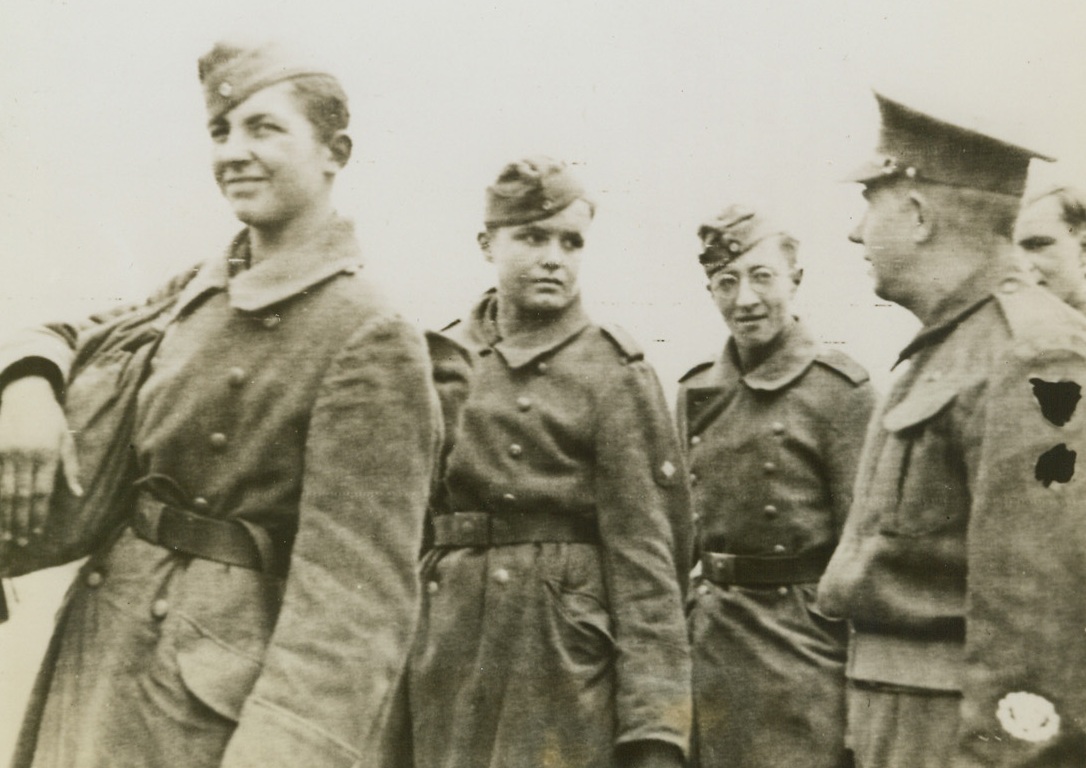
Youthful Nazis Captured In France, 6/9/1944. England – Regulars of Hitler’s West Wall Army, these youthful prisoners of war smile and seem rather happy that the war is over for them. They are lined up waiting entrance into prisoner of war compounds. Credit: Signal Corps Radiotelephoto from ACME;
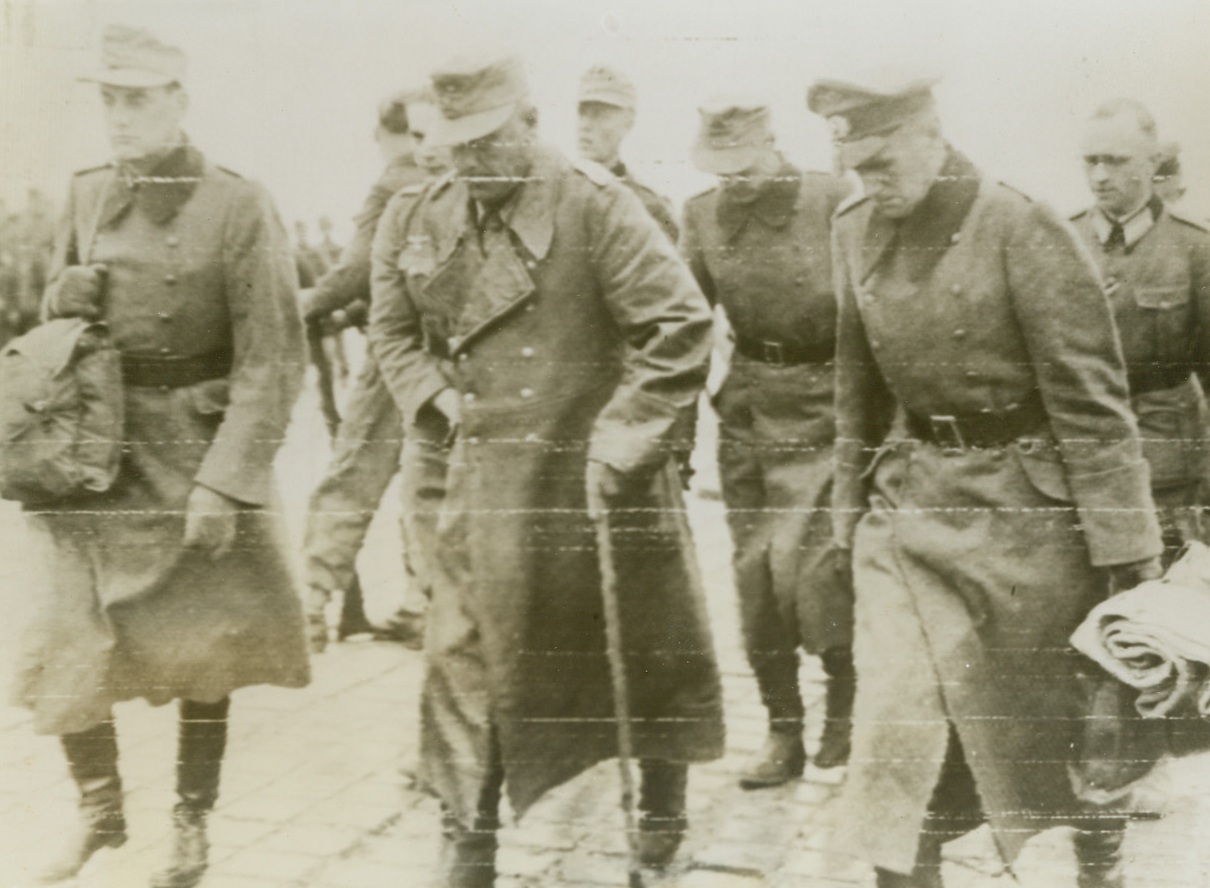
Nazi Officers Prisoners Of War, 6/10/1944. England – Their part in the struggle to impose the New Order on the peoples of the world over, these German officers march through England en route to a prisoner of war compound. They were captured by invasion troops in the battle for the Normandy beachheads. Credit: Signal Corps Radiotelephoto from ACME;
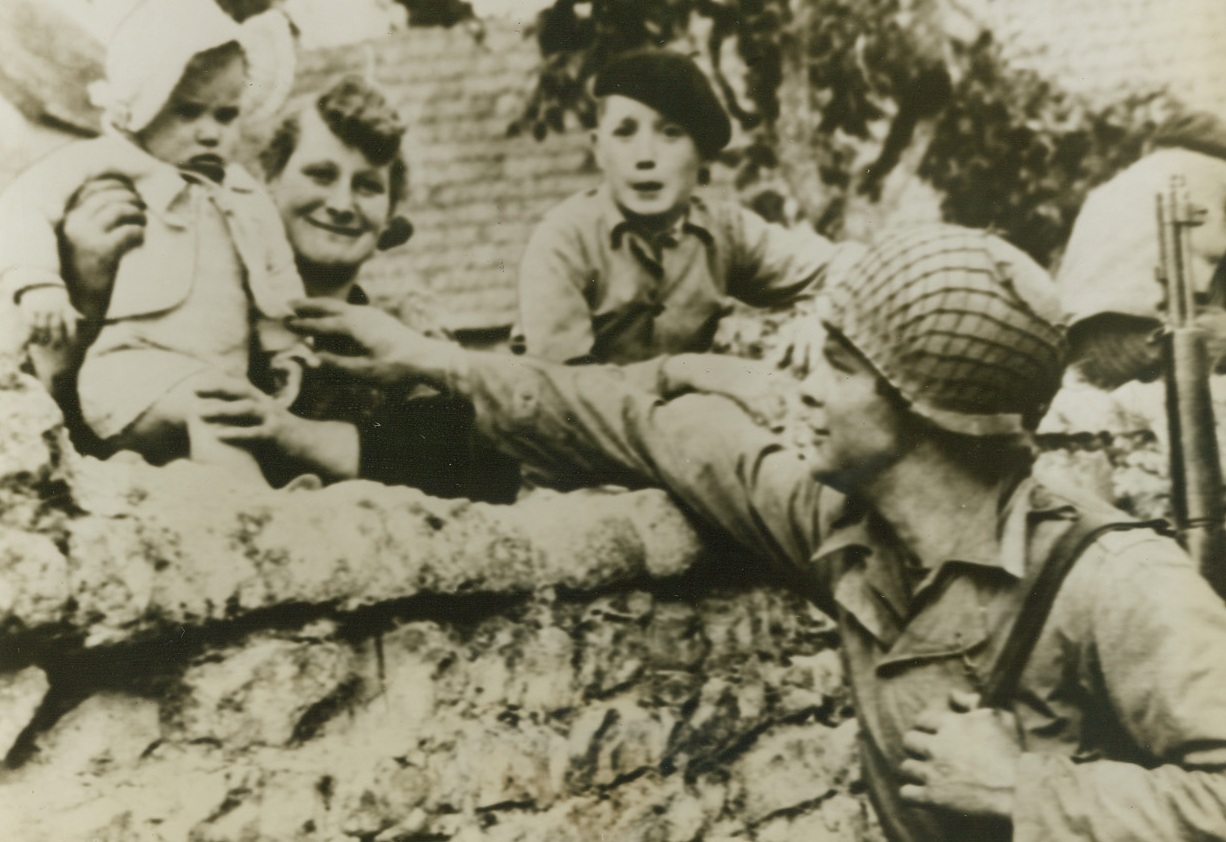
H’Ya Babe, What’s Cookin’?, 6/9/1944. France – With impulsive Yank friendliness, Sgt. Max Denton, of Biloxi, Miss., leans over this stone wall and playfully reaches for the hand of this French youngster while mamma stands by, grinning broadly. Sgt. Denton was with the American Troops advancing into Normandy. Credit: Signal Corps Radiotelephoto from ACME;
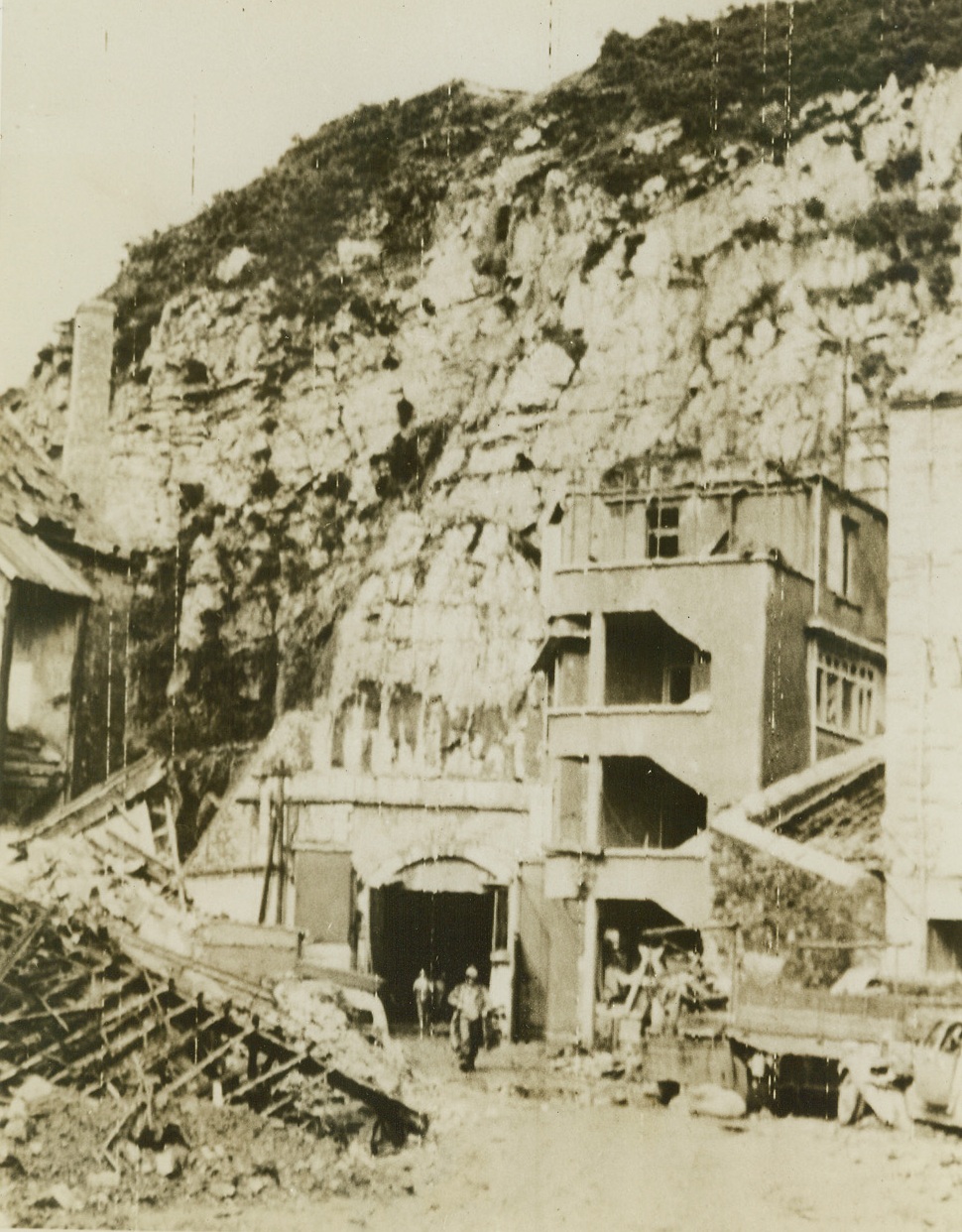
Invincible—So How Come?, 6/28/1944. France – Hitler proclaimed this fortress, part of the much-vaunted West Wall, invincible. Look at it now after Allied shell fire tested its worth. Before this photo was taken, several hundred Germans marched from the emplacement in surrender. Inside, victorious Allied soldiers found vast quantities of food and ammunition. Credit: Signal Corps Radiotelephoto from ACME;
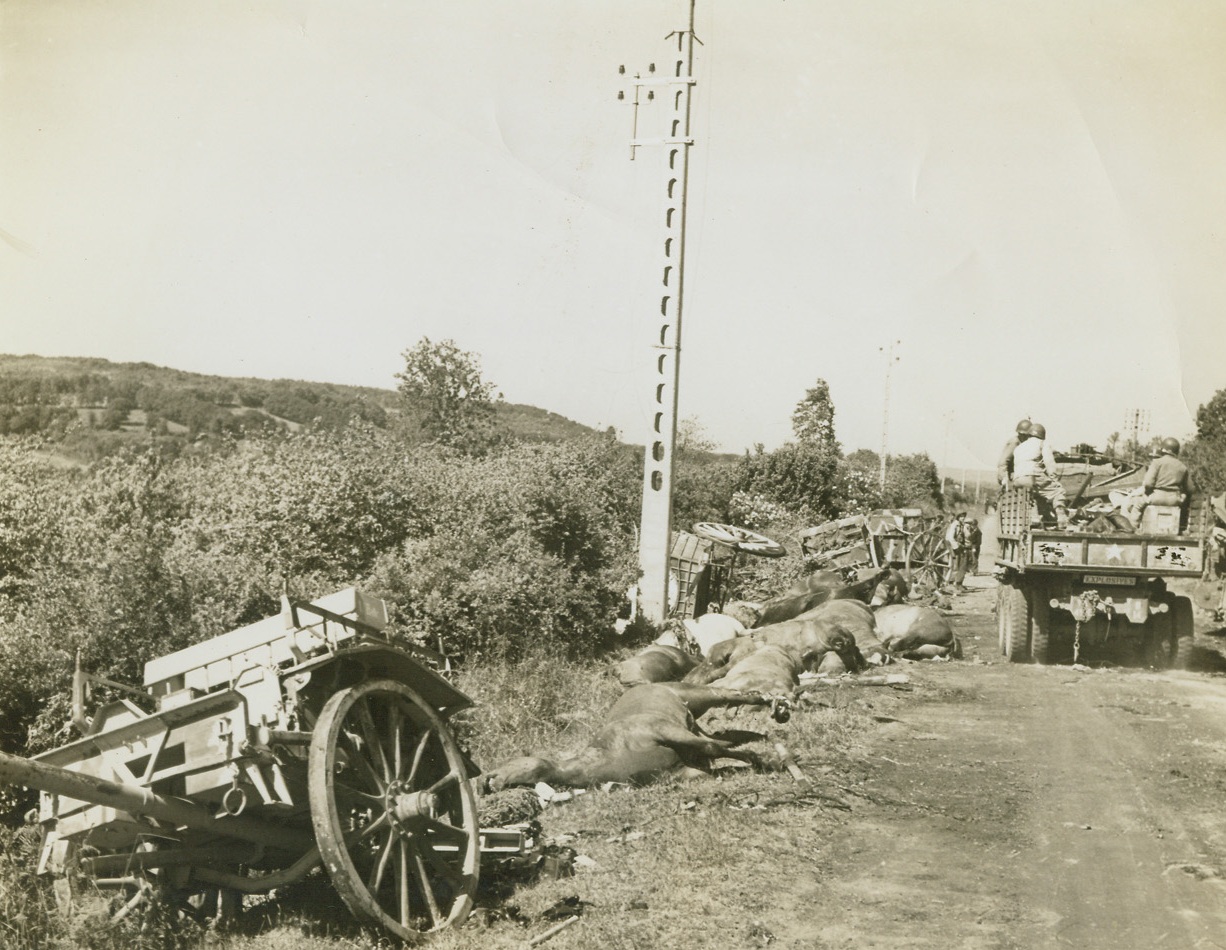
Horses, Too, Were Expendable, 6/27/1944. On the road to Barneville, Cherbourg Peninsula, wrecked German guns, dead horses and other equipment lie alongside the road after being pushed there by American bulldozers who cleared the road for the advance of the Allied troops that followed in the advance on Cherbourg. On the right, an American truck may be seen advancing down the road. Passed by censor. Credit: ACME photo by Bert Brandt for the War Picture Pool;
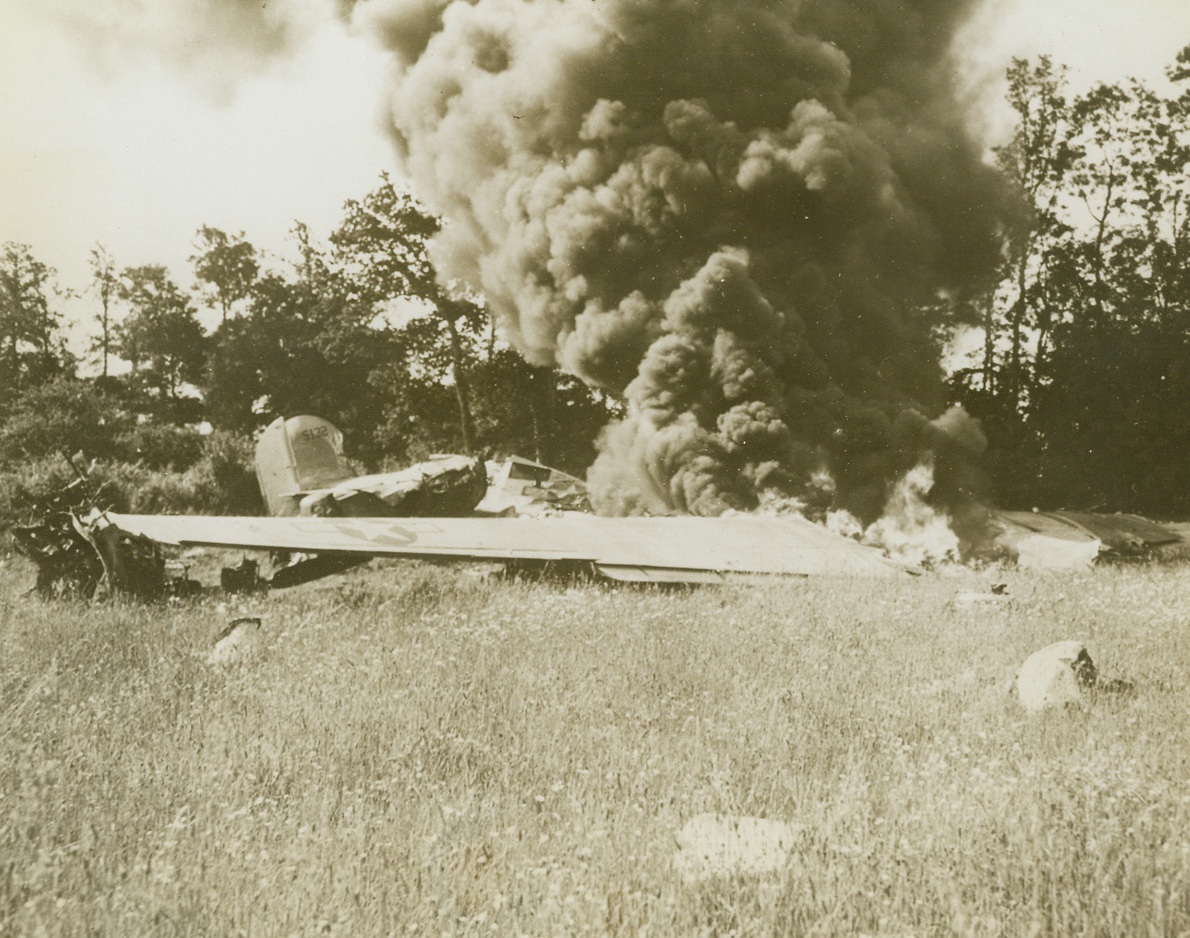
Downed Liberator, 6/23/1944. France – Smoke billows skyward from the wreckage of this Liberator which crashed in a field in France after being disabled while on a bombing mission. Thousands of planes have been forming an aerial umbrella for the Allied soldiers bitterly engaged in battle with the Nazis in France. Credit: US Army photo from ACME;
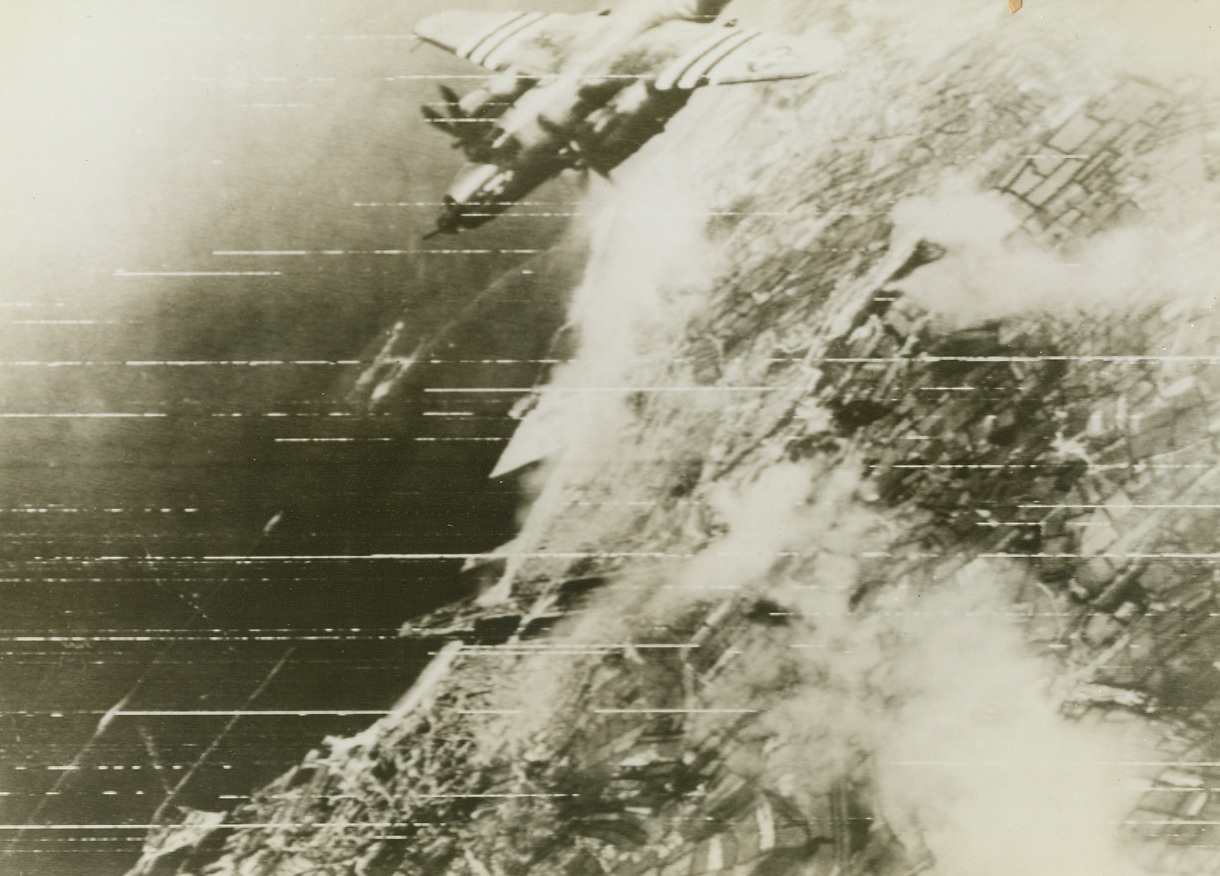
Flight Over Cherbourg, 6/23/1944. France – A Marauder Bomber from the 9th U.S. Air Force flies high over Cherbourg after loosing its message of destruction on the city. Dense clouds of smoke billow skyward from the Nazi Bastion – the result of successful bombing of German defense positions. Between 25,000 to 50,000 Nazis are trapped in the strategic port as the Allies get set to close the pincers around this important French town. Credit: Signal Corps Radiotelephoto from ACME;
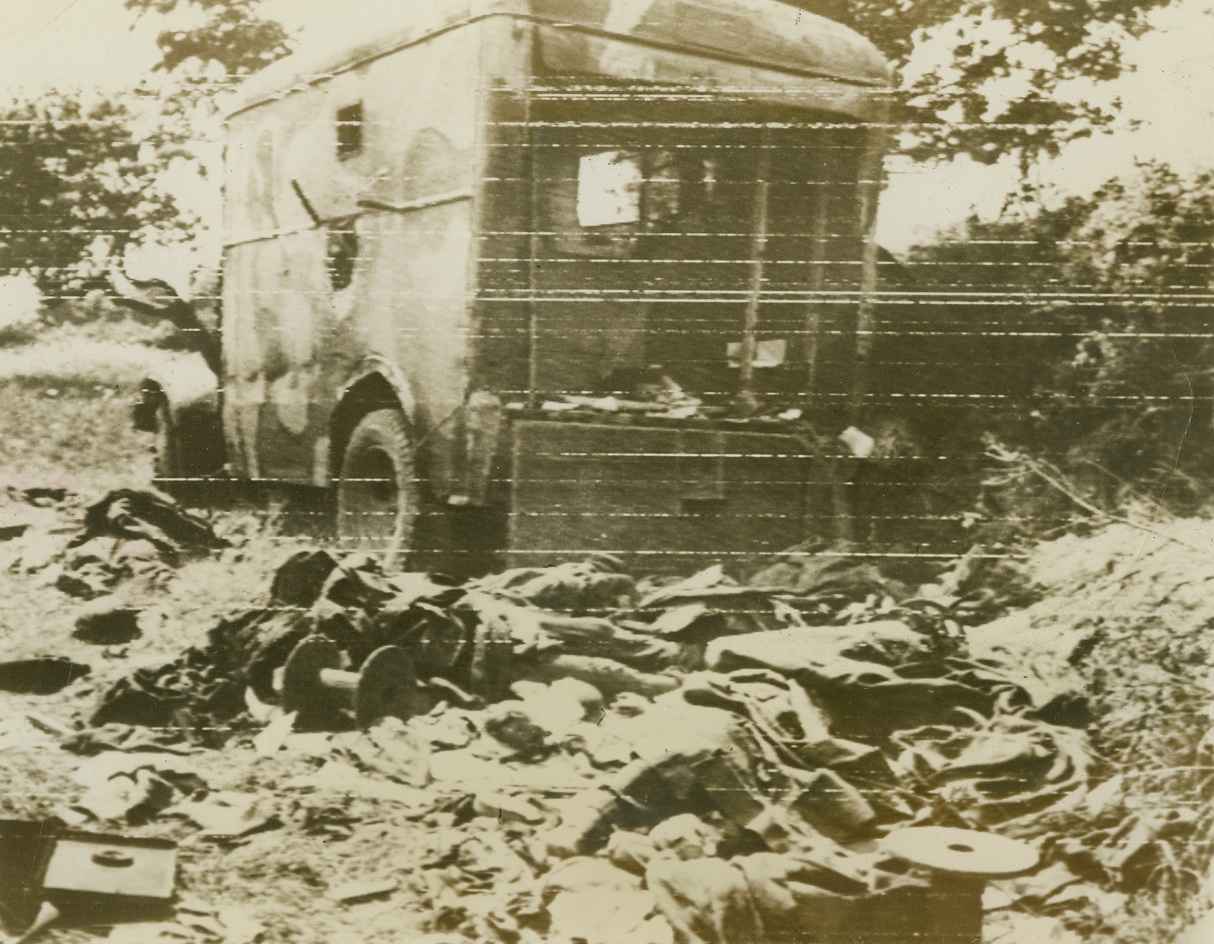
Allied Bazooka Knocks Out Nazi H.Q. Car, 6/20/1944. France – The bodies of the nine occupants and official papers lay strewn over the road after a Bazooka shell hit this German headquarters car enroute across the Cherbourg Peninsula. The American forces are now within six miles of Cherbourg, and their heavy artillery fire is bombarding the city. Credit: ACME photo by Bert Brandt, War Pool Correspondent, via Signal Corps Radiotelephoto;
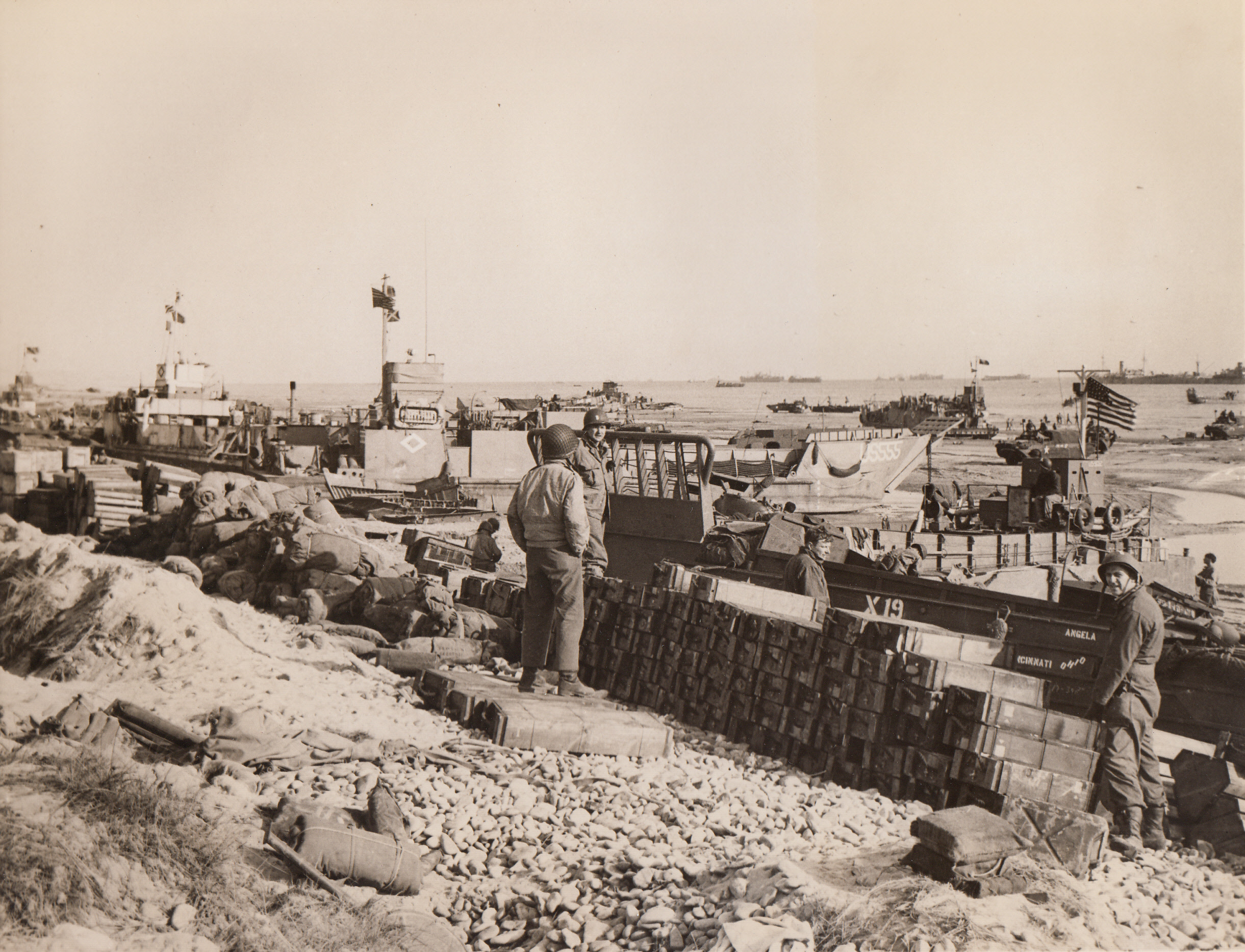
Supplies, Supplies, Supplies, 6/15/1944. France – There’s scarcely an inch of beachhead space that doesn’t hold some sort of equipment for fighting men, as the endless chain of supplies streams across the Channel to our soldiers in France. Fighting men check the vast amount of food and weapons dumped on this Normandy beach.;
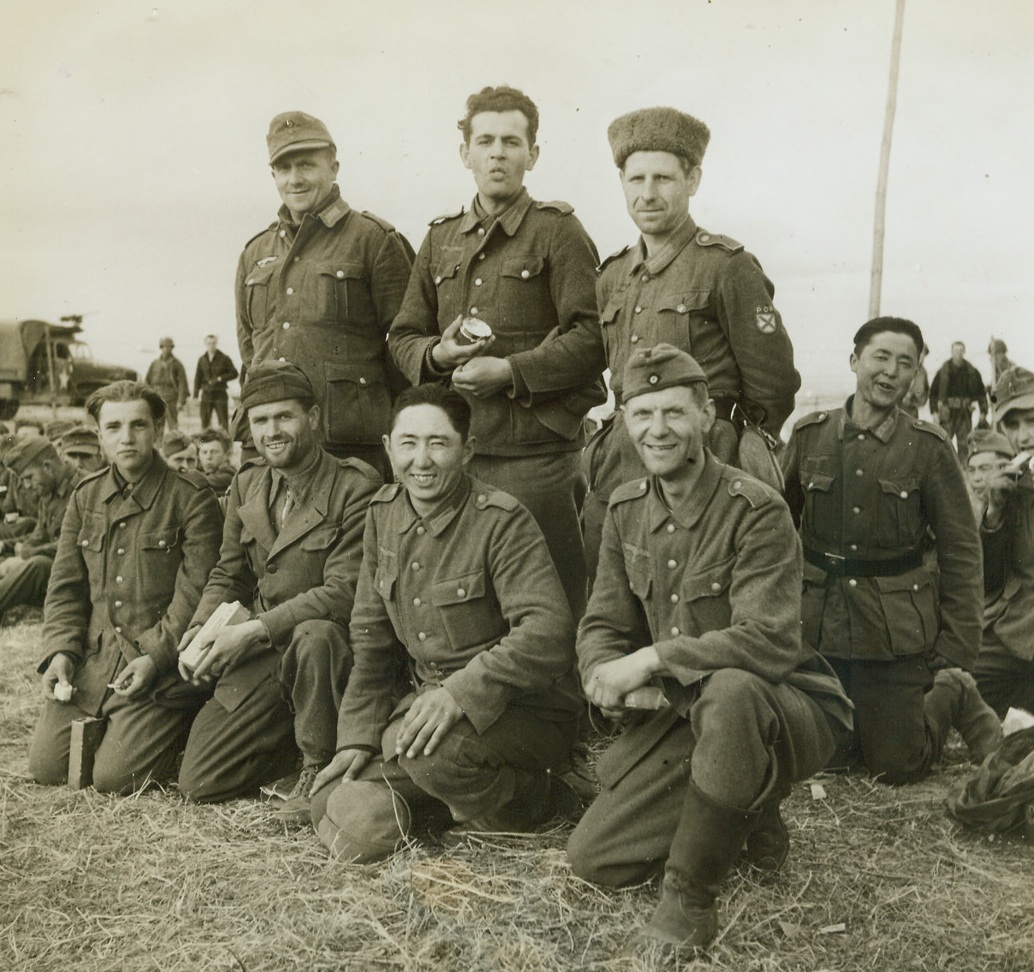
They Fought for Hitler, 6/15/1944. Somewhere in France – Not all of the German Army prisoners taken on the battlefields of France are stalwart, blonde Aryans who were born to rule the world. Not quite so exclusive these days, the “Herrenvolk” is hob-nobbing with men of all races—anyone, as a matter of fact, who can carry a gun for Adolf. Among the prisoners captured in France were: (left to right) front row: a Yugoslav; an Italian; a Turk; a Pole; (back row) a German; a Czech; a Russian who was forced into the army when the Nazis occupied his town; and a Mongol. Credit: Acme photo by Bert Brandt for the War Picture Pool;
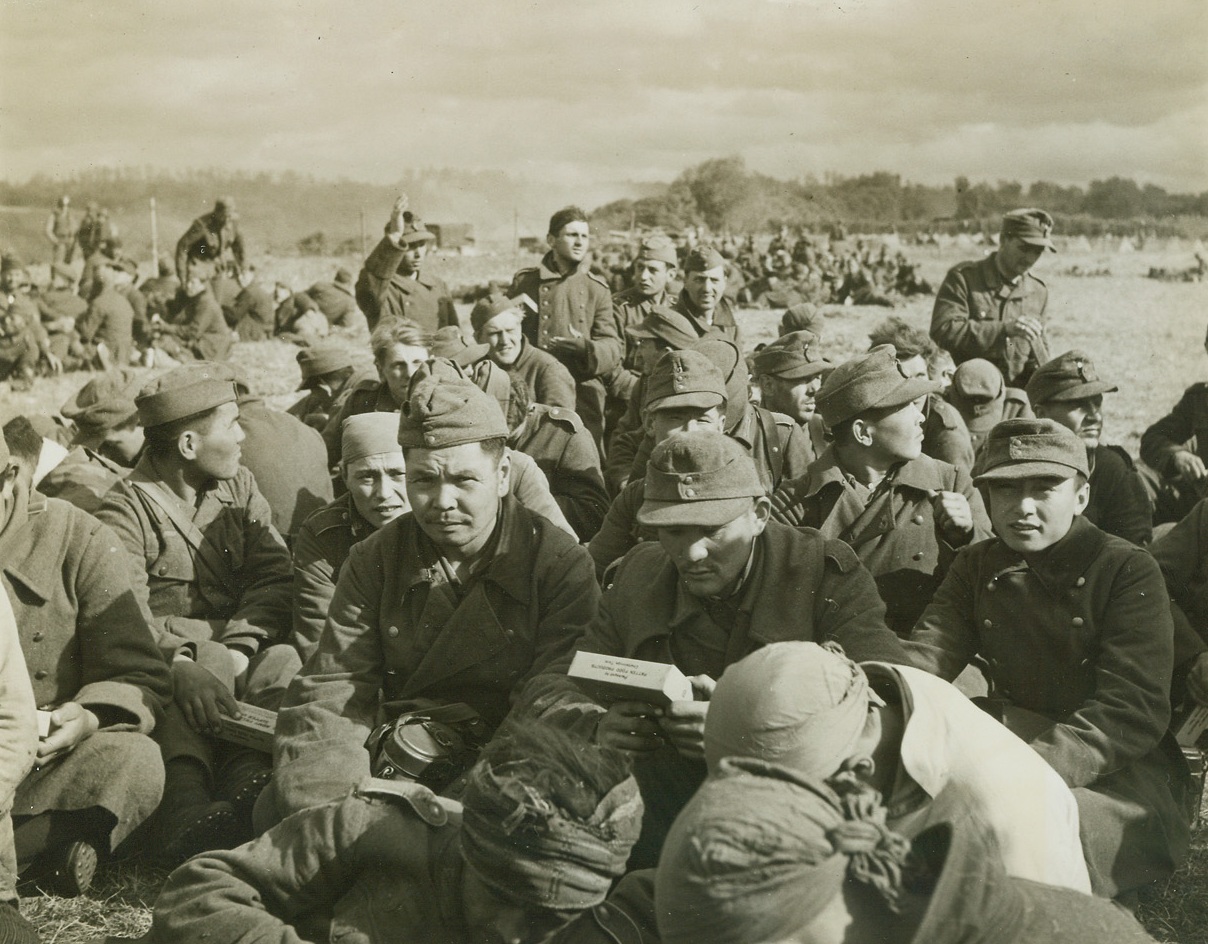
Captured with Nazis, 6/15/1944. France – Visible among the faces of these men, captured by the Allied liberation forces in Normandy, are Chinese and Mongolian types. Reports from Allied Headquarters indicate that Japanese also were among those fighting for the Nazis. At least, these men, (above), seem happy that they no longer have to fight for the German “Super Race.” Passed by censors. Credit: Acme photo by Bert Brandt for War Picture Pool;
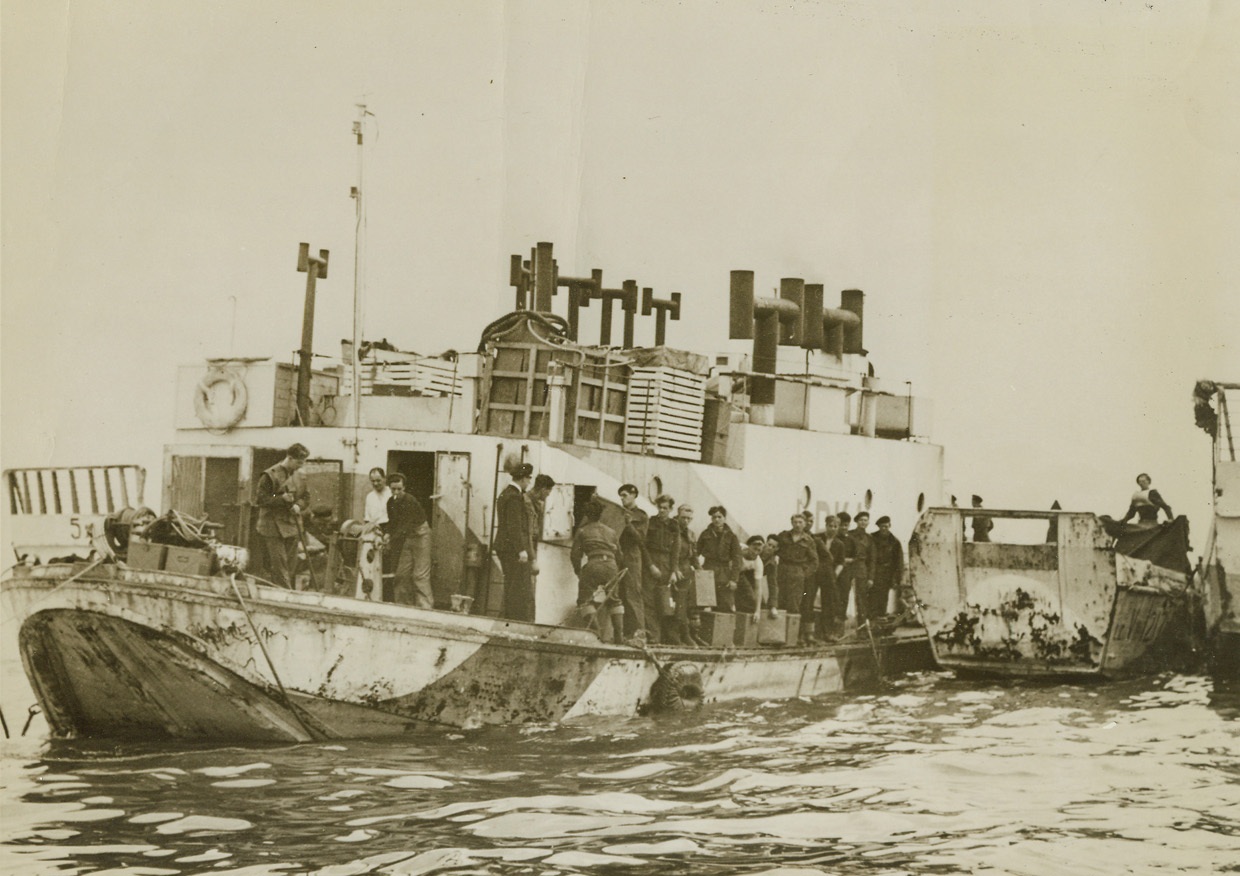
Floating Kitchen, 6/15/1944. France – A converted barge that once sailed up and down the Thames, this floating mess hall was the first Landing Barge Kitchen to reach the Normandy beachhead. Purpose of the vessel is to supply hot meals to the crews of small craft now doing their hundred-and-one jobs in the Channel, which range from ferrying men and supplies to laying smoke screens for air attacks. Here crews of the small craft line up for their noon meal. Credit: British official photo from Acme;
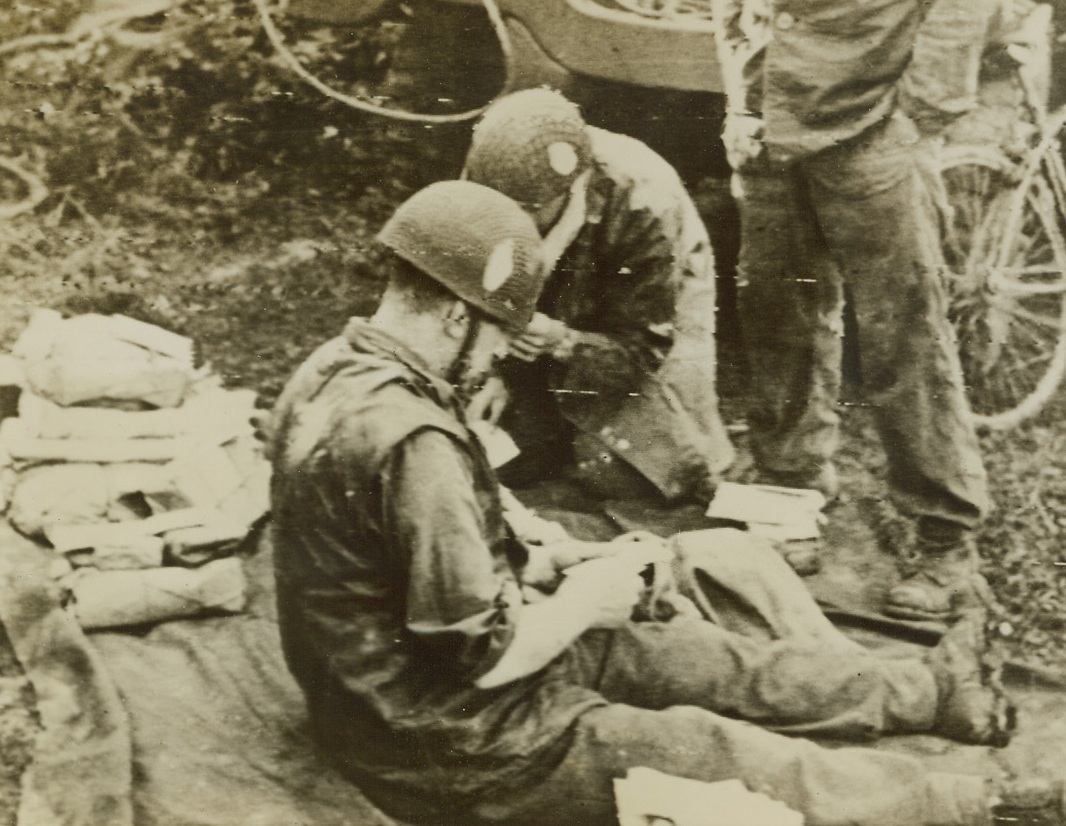
Fighter’s Reward, 6/15/1944. France – These Allied soldiers along the “liberation beachhead” receive their first mail from home since landing in France, which they read avidly during a moment’s lull in the fighting. Credit: British War Office photo via Army radiotelephoto from Acme;
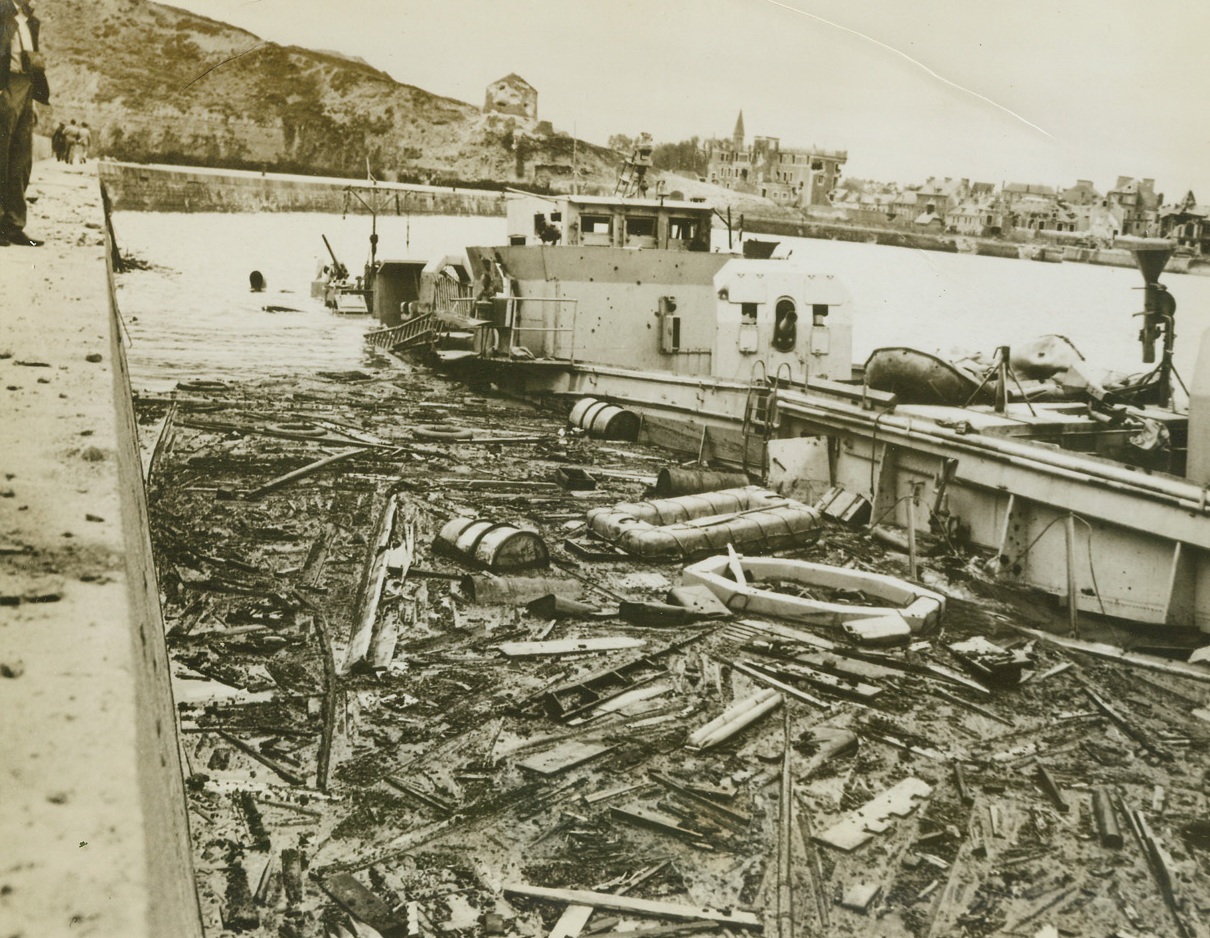
Remains of German Flak Boat, 6/15/1944. France – Amid the floating debris of war, a German flak boat lies where troops of the Armies of Liberation found her, in the harbor at Port-en-Ressin, France. Blasted buildings along the shore show evidence of the power of the naval barrages that supported the invasion troops. Credit: U.S. Navy photo from Acme;
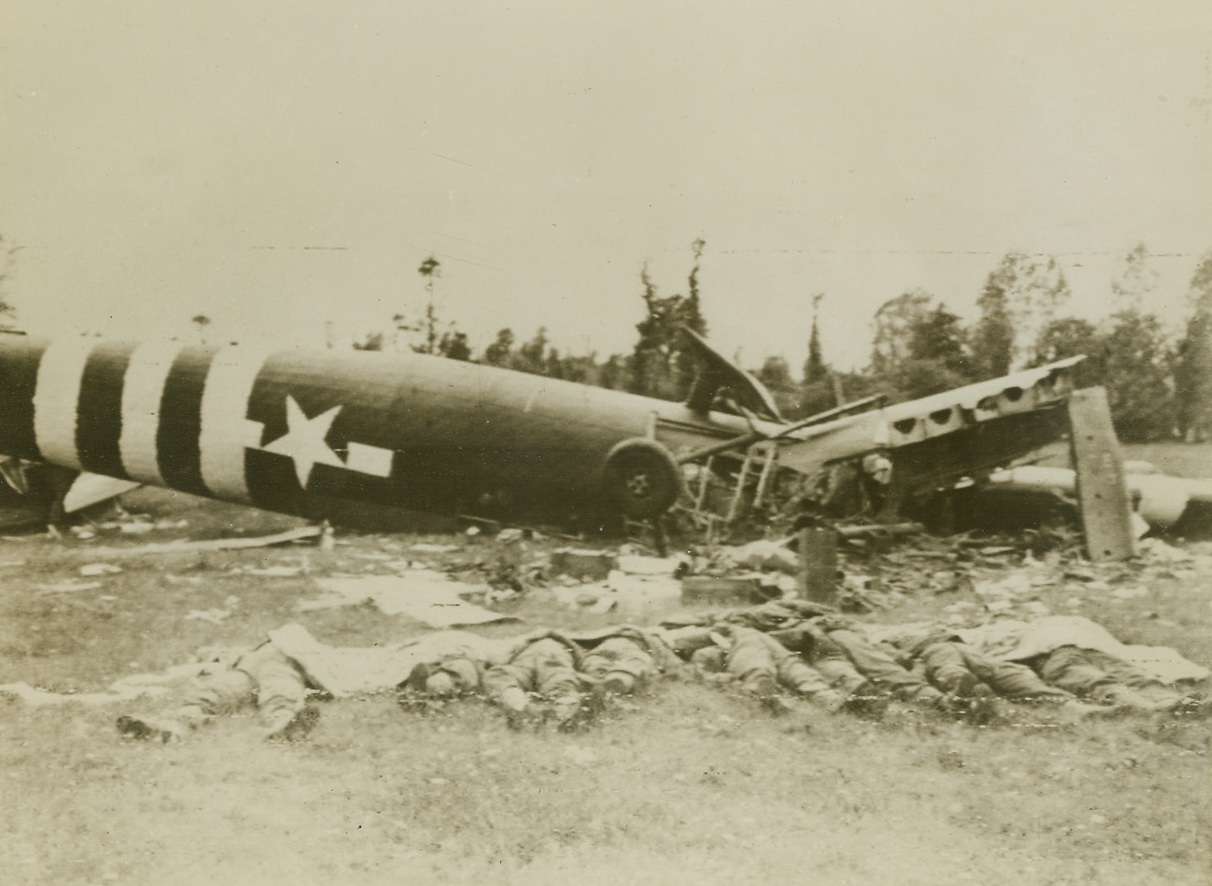
”We Are the Dead . . . .”, 6/15/1944. Somewhere in France – Parachute shrouds cover the faces of eight airborne infantrymen who lie beside the wreckage of their glider on French soil. The sky fighters were killed during landing operations in France. Credit: British official photo via U.S. Signal Corps Radiotelephoto from Acme;
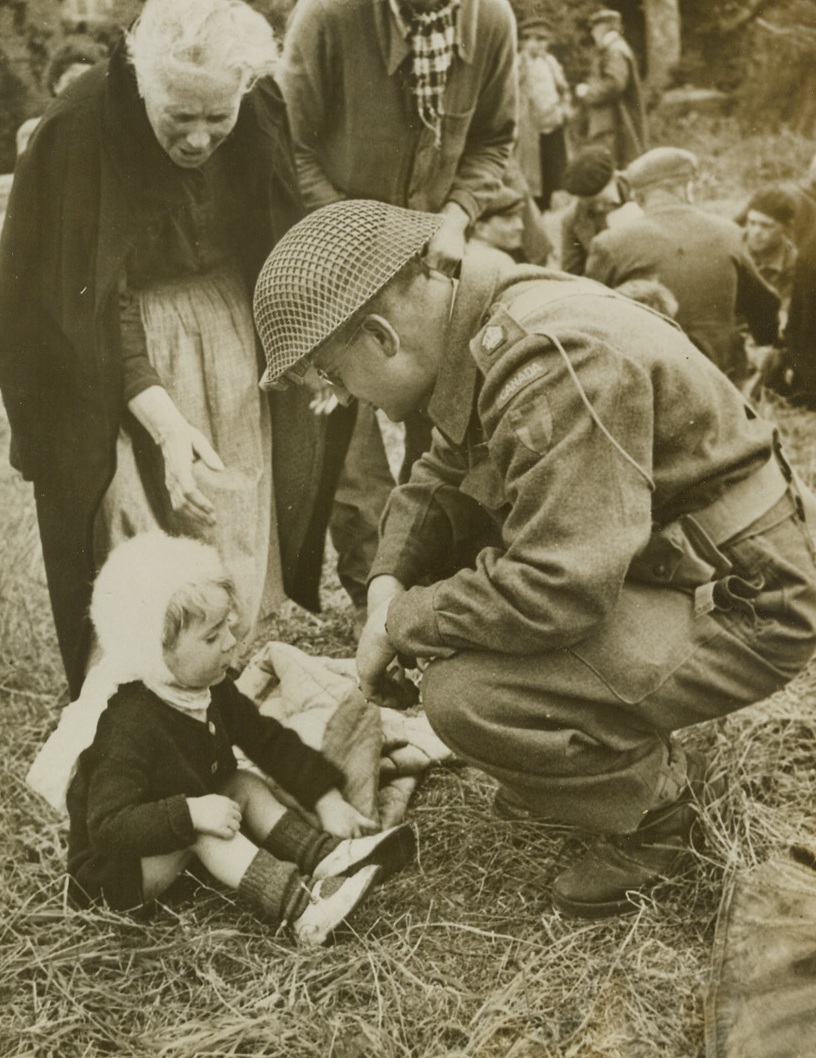
Young Frenchman Finds a Friend, 6/15/1944. Somewhere in France – A Canadian fighting man squats to chat with a young French refugee in the battle area of Normandy. The little boy and the old woman behind him were among many hungry refugees who had not eaten for three days before they were fed by the Civil Affairs Department of the Allied Forces. Credit: British official photo from ACME;
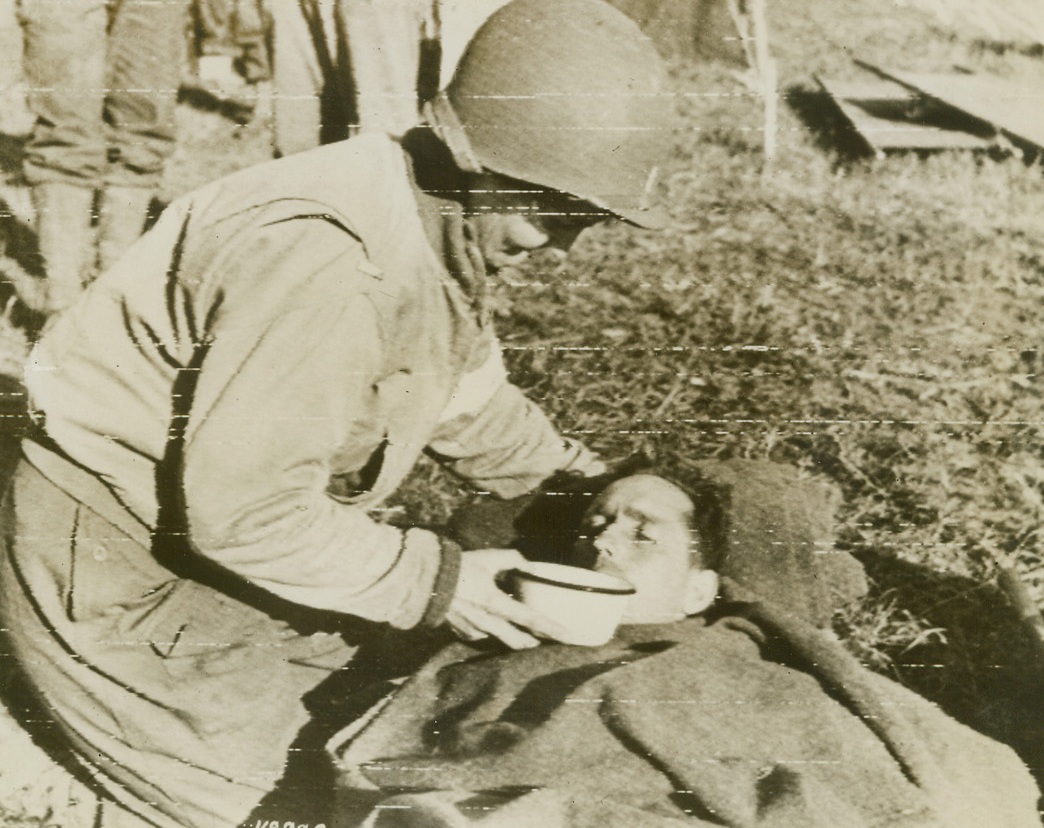
When Water Really Tastes Good, 6/13/1944. France – One of some hundreds of British and American fighting men, wounded in the first stage of the liberation of France, Hailand P. Braley learns how good water can taste at an advanced hospital. Army Nurse Margaret Ketchum, one of the U.S. women who are doing such a wonderful job bringing relief to the wounded, helps him to drink. Credit: Signal Corps Radiotelephoto from ACME;
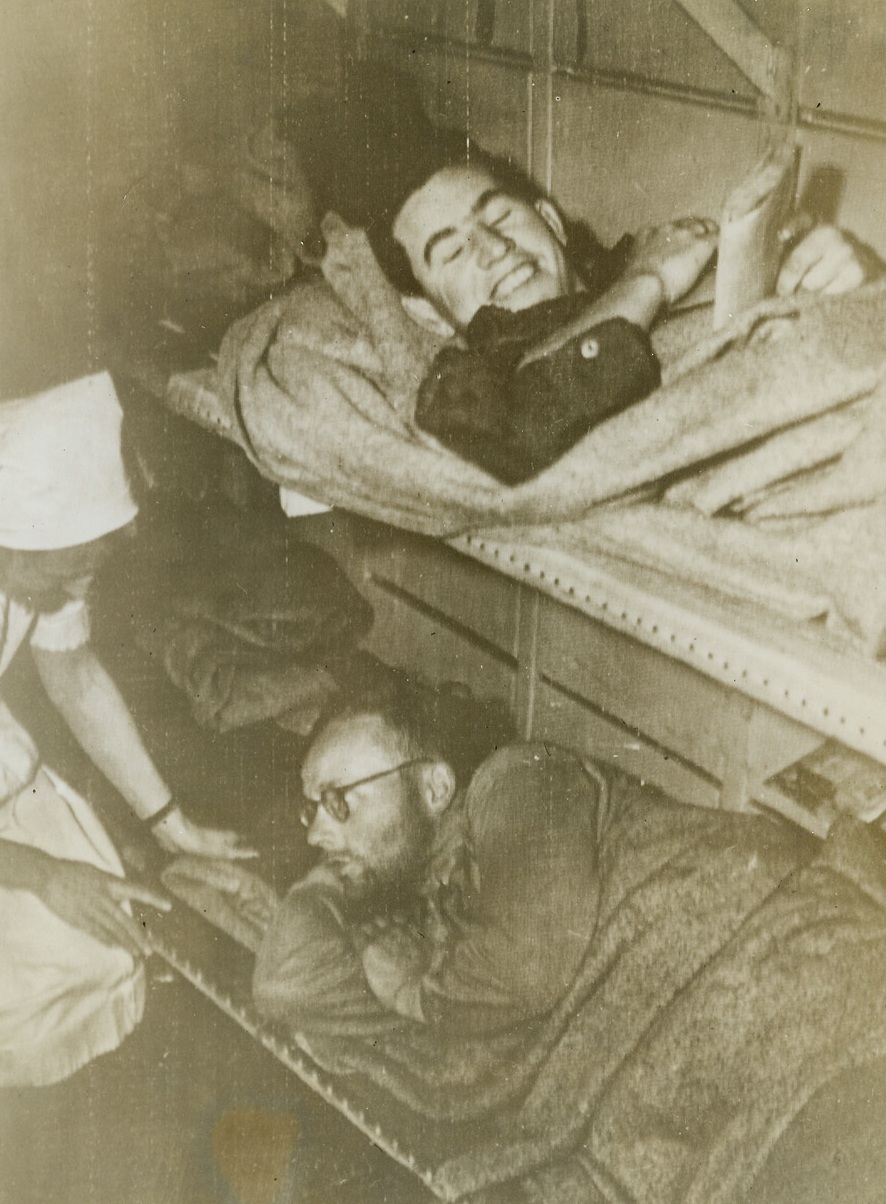
Best of Care—Friend and Foe Alike, 6/14/1944. England – For the personnel of the Medical Corps, there is no distinction between Allied and Axis fighting men—they are all human, and receive the best care that can be given a wounded man. Here, aboard a hospital train speeding through England, a British Tommy smiles from the top bunk while, below him, a wounded German receives a nurse’s attention. Credit: ACME photo via Army Radiotelephoto;
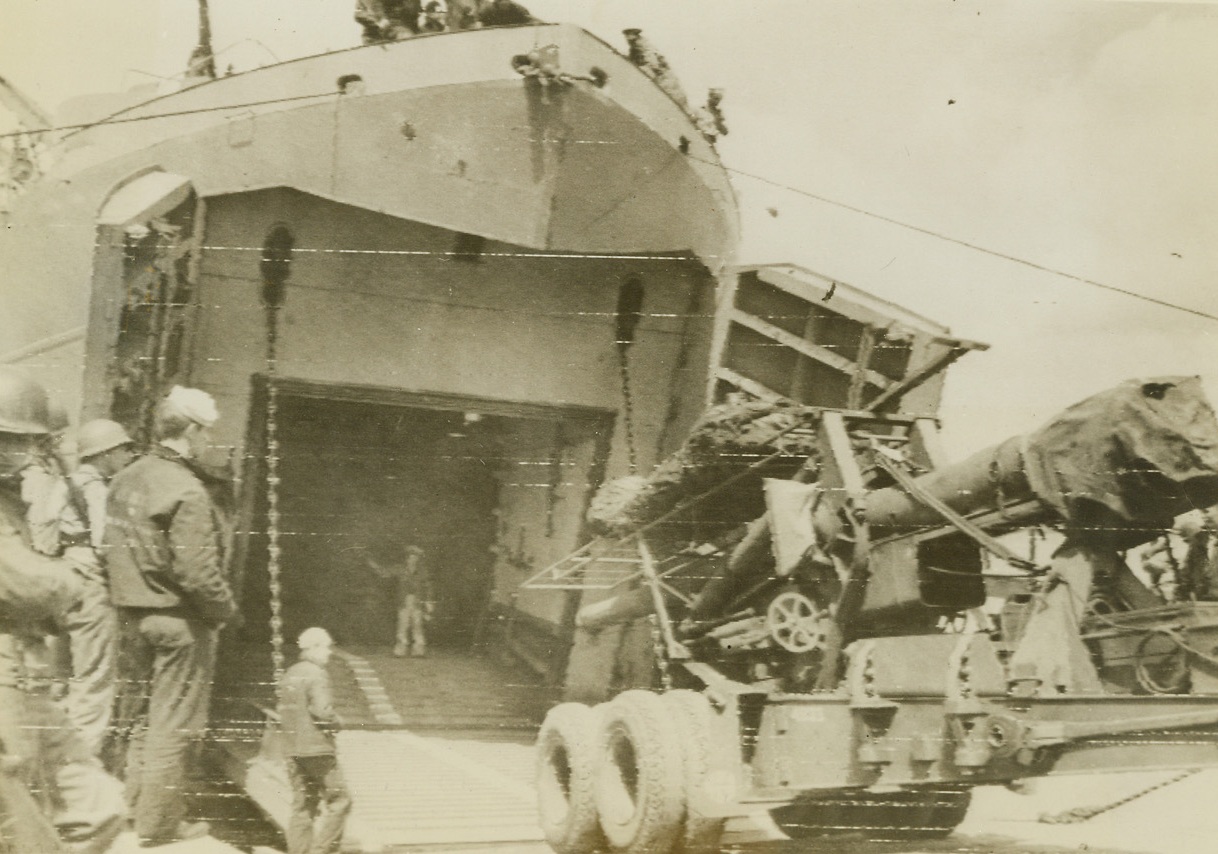
Heavy Stuff for Beachhead, 6/16/1944. England – A huge U.S. gun is backed up the landing ramp of an LST at “a British port”, headed for use on the Allies’ “liberation beachhead” in Normandy. At the top of the ramp a man directs the driver by hand signals. A hint that the Allies expect to capture a deep sea port—possibly Cherbourg—shortly, is indicated by this photo, flashed to the U.S. by radio today. Modern docking facilities would be needed to unload this “heavy stuff.” Credit: Army Radiotelephoto from ACME;

Suspected Quisling, 6/16/1944. This French woman, suspected of being a sniper against the Allied forces in France, arrives in England and is being evacuated to a Prisoner of War hospital. She was wounded in the hand and body. Credit: ACME photo via Army Radiotelephoto;
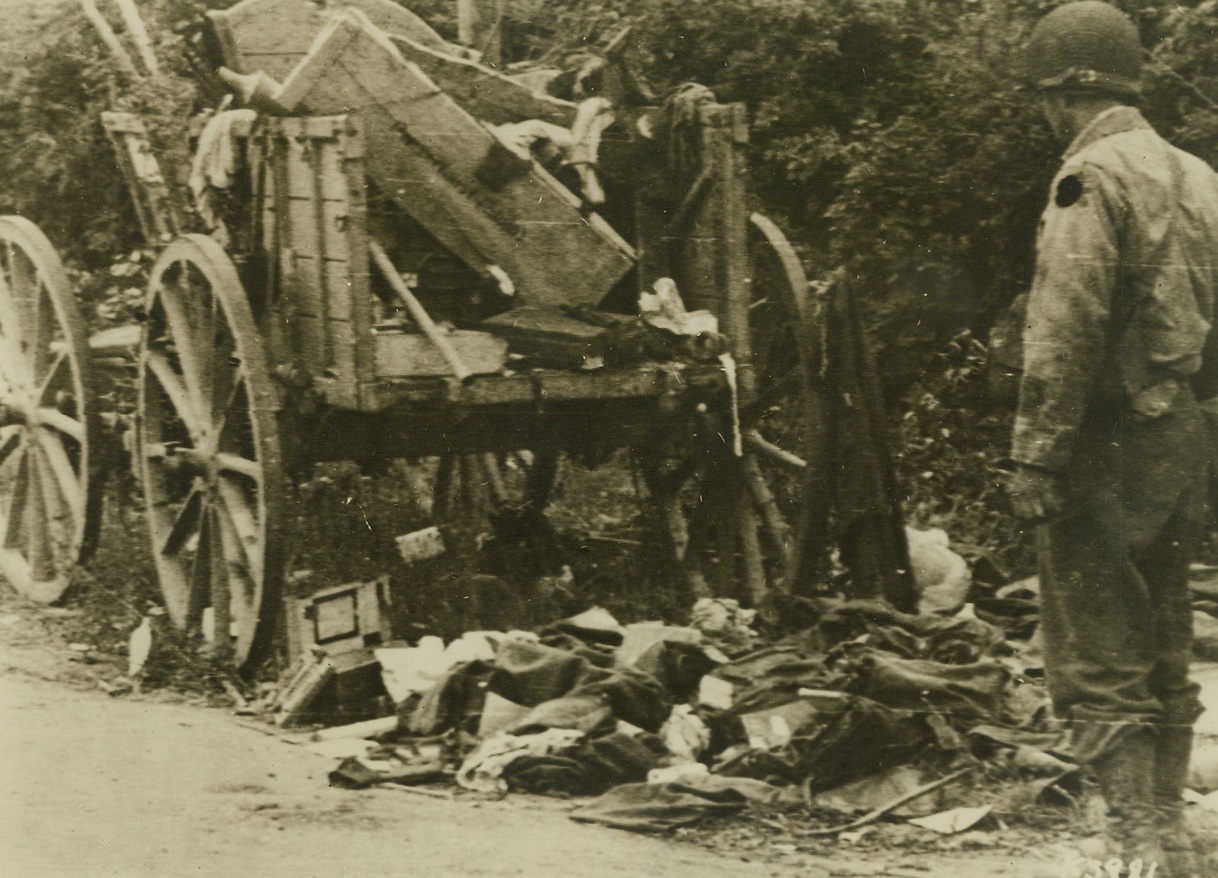
Supplies That Never Got There, 6/18/1944. France – Caught by an Allied fighter-bomber on the St. Mere Eglise-Montebourg road in Normandy, this wagonload of supplies never reached German lines on the Cherbourg peninsula. This is only a small example of how the Nazis, who are now using horse-drawn vehicles, are being thwarted in their attempts to get supplies to their troops. Credit: Signal Corps Radiotelephoto from ACME;
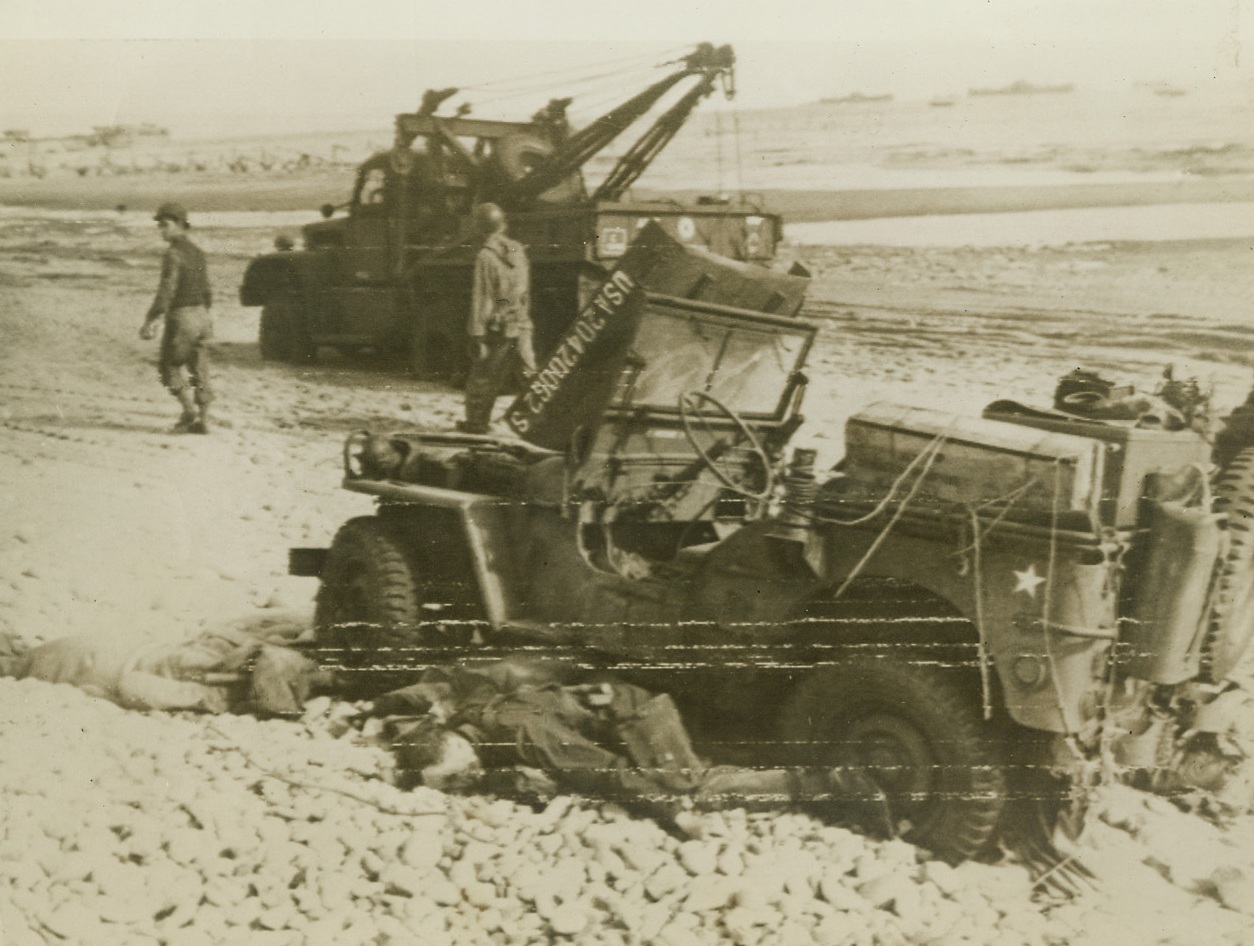
Death—Their Assignment, 6/6/1944. France – Two American soldiers lie dead beside their jeep. They were caught in a deadly German machine gun fire as they rolled down the ramp of their landing craft, and died as they left the tiny car to seek cover. In the background, a prime mover goes about its job of salvaging blasted equipment. Credit: U.S. Coast Guard photo via Army Radiotelephoto from ACME;

St. Sauveur After German Evacuation, 6/24/1944. St. Sauveur, France – Lying in a valley, this mass of destruction is all that remains of St. Sauveur, captured by the Allies on the road to Cherbourg. Driving a wedge across the Normandy Peninsula with amazing rapidity, the Yank troops have advanced to the outskirts of Cherbourg, and have an estimated 25,000 or 30,000 Germans trapped within the port city. Credit: ACME;
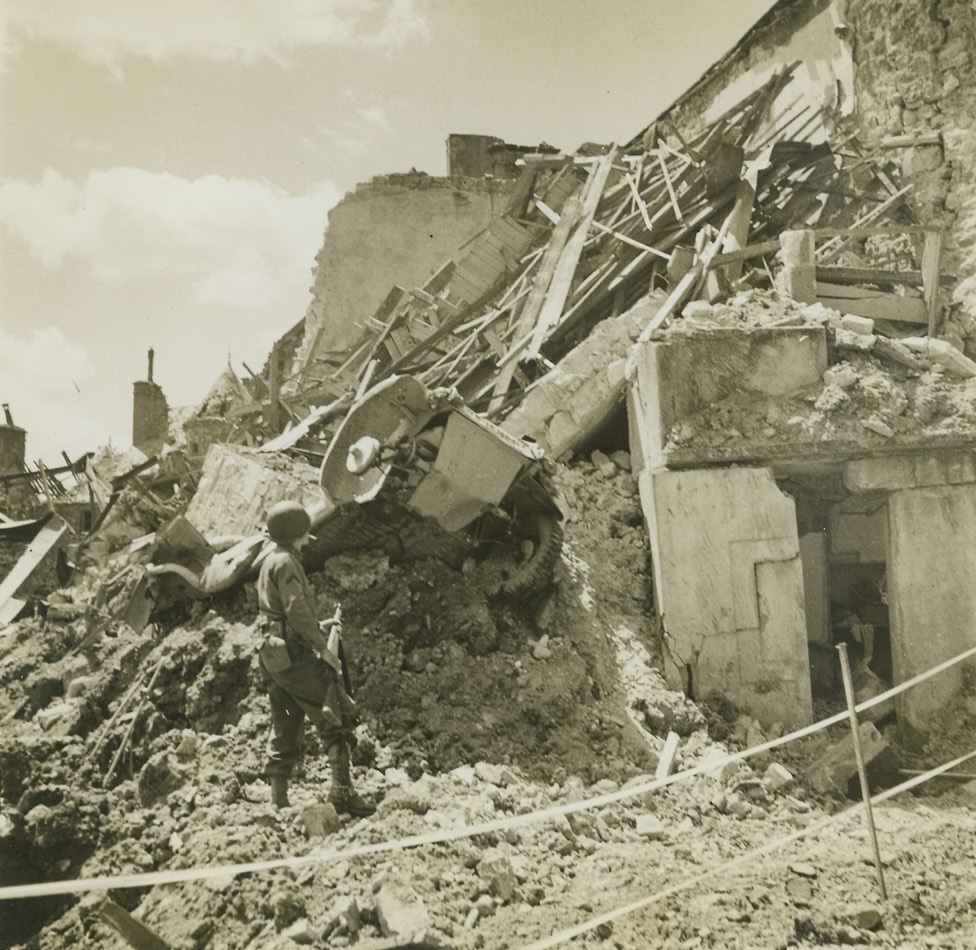
War Passed Here, 6/23/1944. St. Sauveur, France – Standing in an area marked off as “dangerous,” this American soldier looks at the shattered remains of a tank sitting on top of the wreckage of what was once a building in St. Sauveur. American forces have continued their march up the Normandy Peninsula, and are now surrounding Cherbourg, key port on the tip of the peninsula, and their ultimate goal. The capture of the port will give the Allies a good harbor in which to land equipment and troop reinforcements. Credit: ACME photo by Andrew Lopez, War Pool Correspondent;
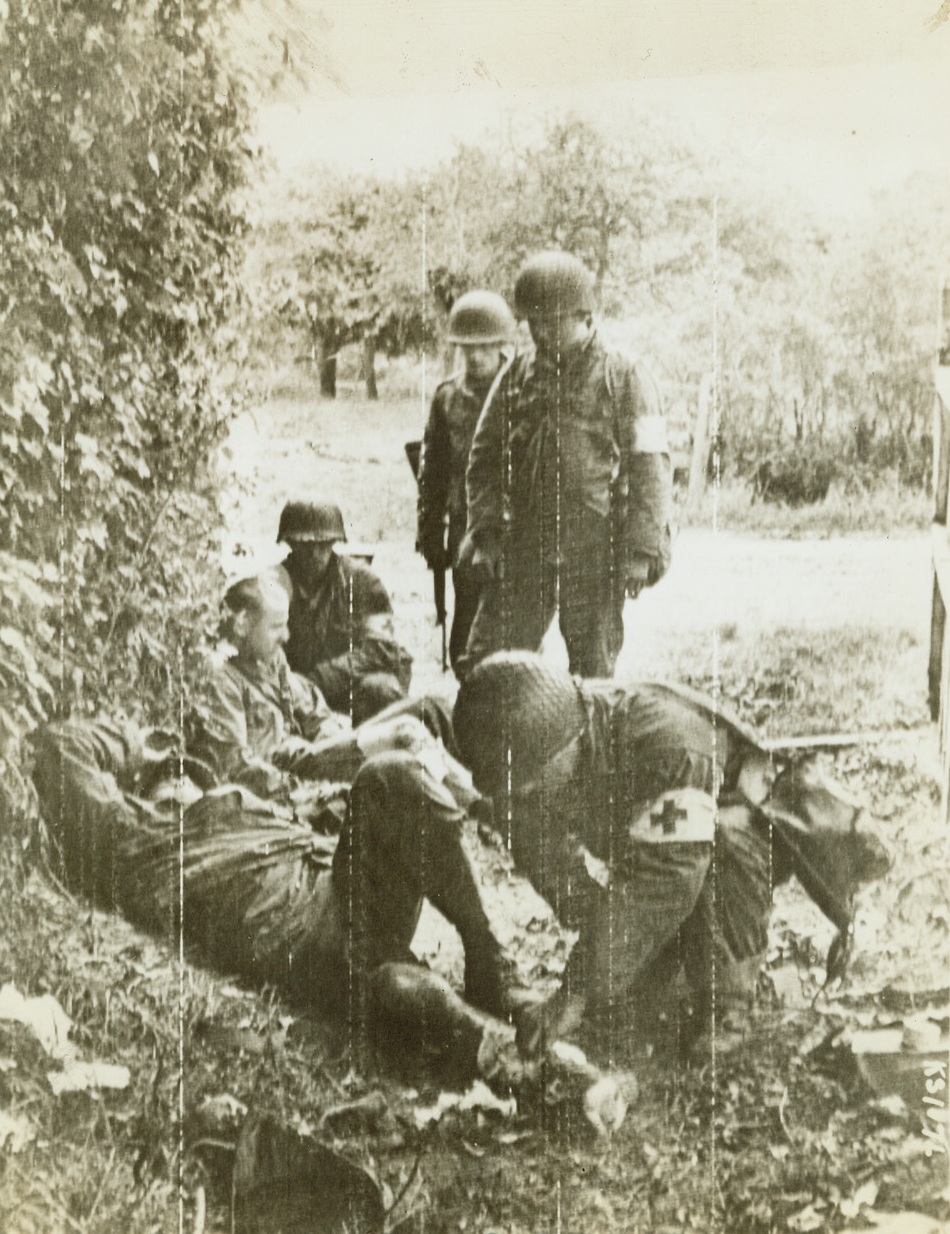
Snipers’ Victims, 6/25/1944. Cherbourg, France – Helmeted medical officers kneel to give first aid to a pair of American fighting men who were victims of snipers’ bullets on the outskirts of Cherbourg before the vital port fell to the Allies. Fighting still rages in Cherbourg although the German DNB agency says “It is to be assumed” that the key city has been captured by the Allies. Credit: Signal Corps Radiotelephoto from ACME;
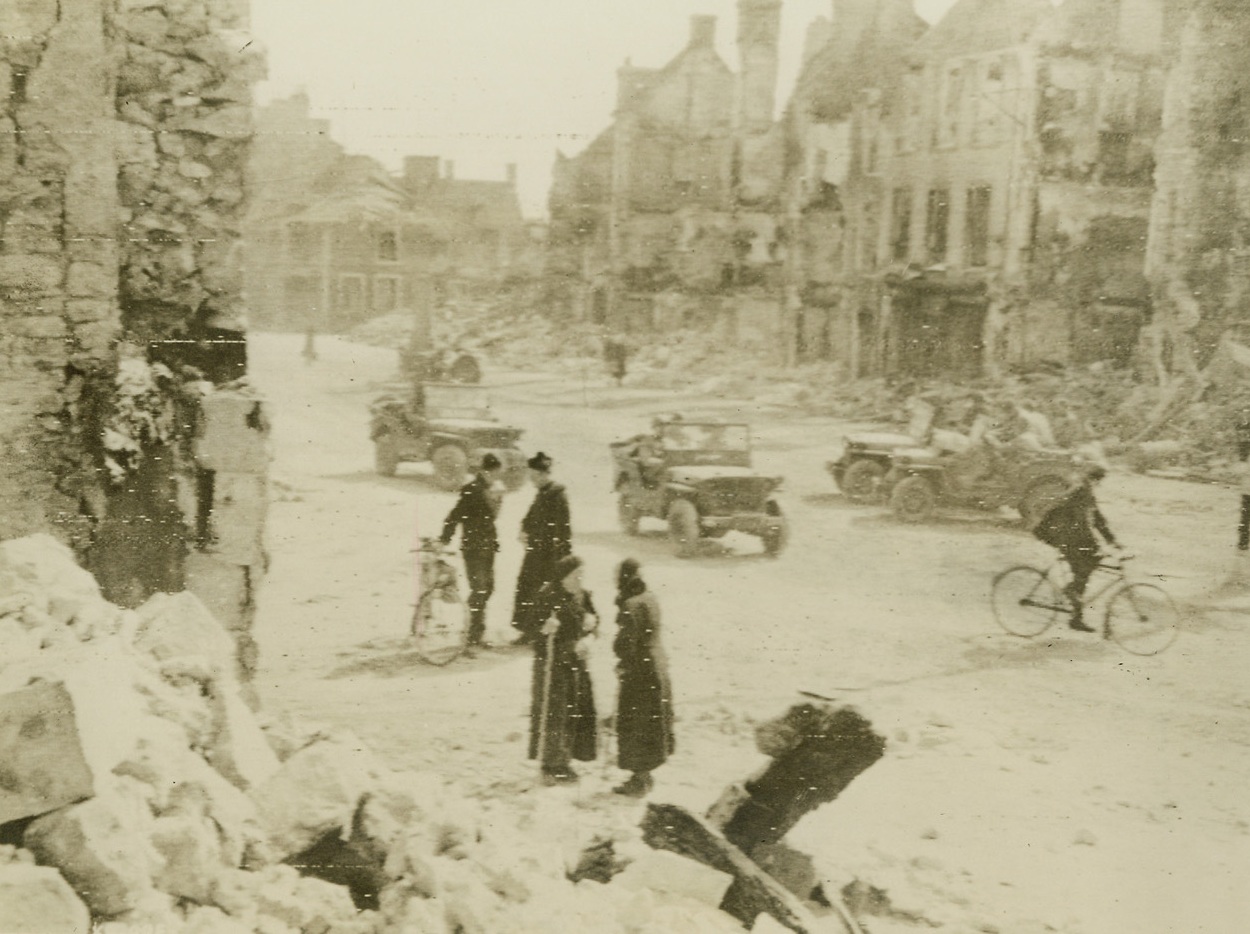
Home and Free, 6/19/1944. France – As the Allies push steadily inland, the peoples of the towns already occupied by British, American or Canadian troops start returning to their homes. This scene was taken in Insigny, France, as villagers returned to view their shell-shattered homes. Credit: Signal Corps Radiotelephoto from ACME;
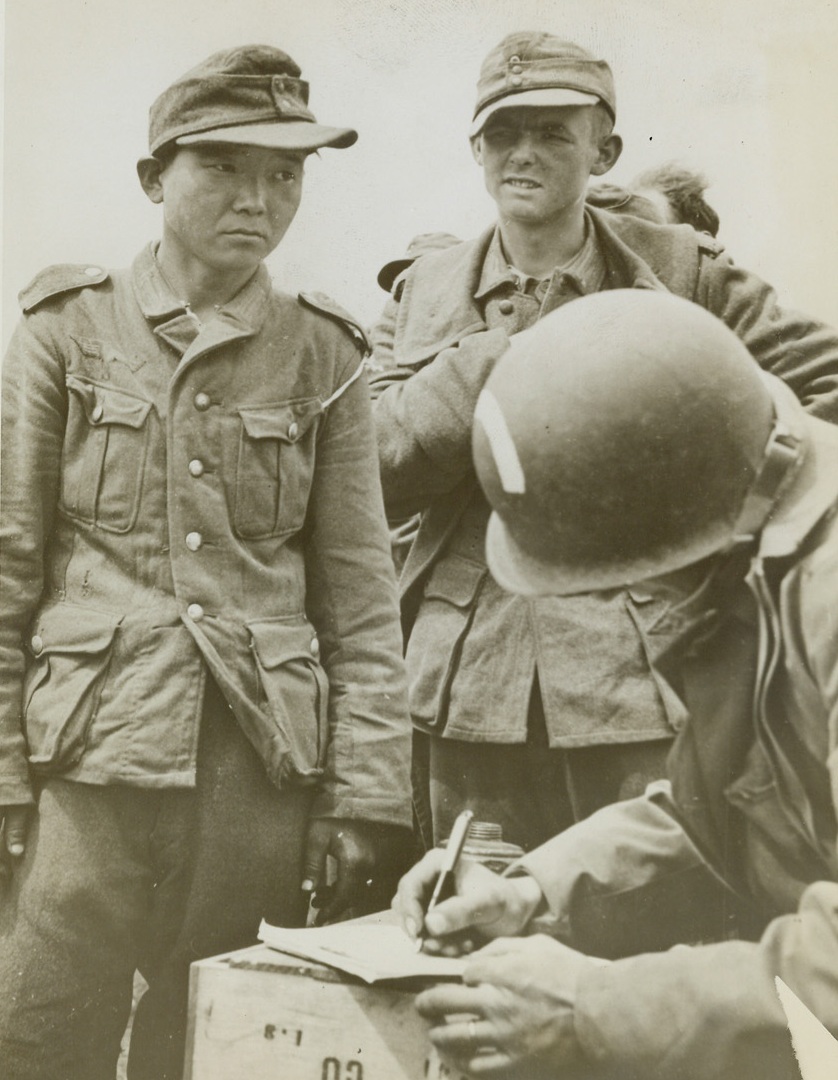
Captured Jap in Nazi Uniform, 6/21/1944. France – Fearful of his future, this young Jap, wearing a Nazi uniform, is checked off in a roundup of German prisoners on the beaches of France. An American Army Captain takes the Jap’s name and serial number. Credit: Coast Guard Photo from ACME;
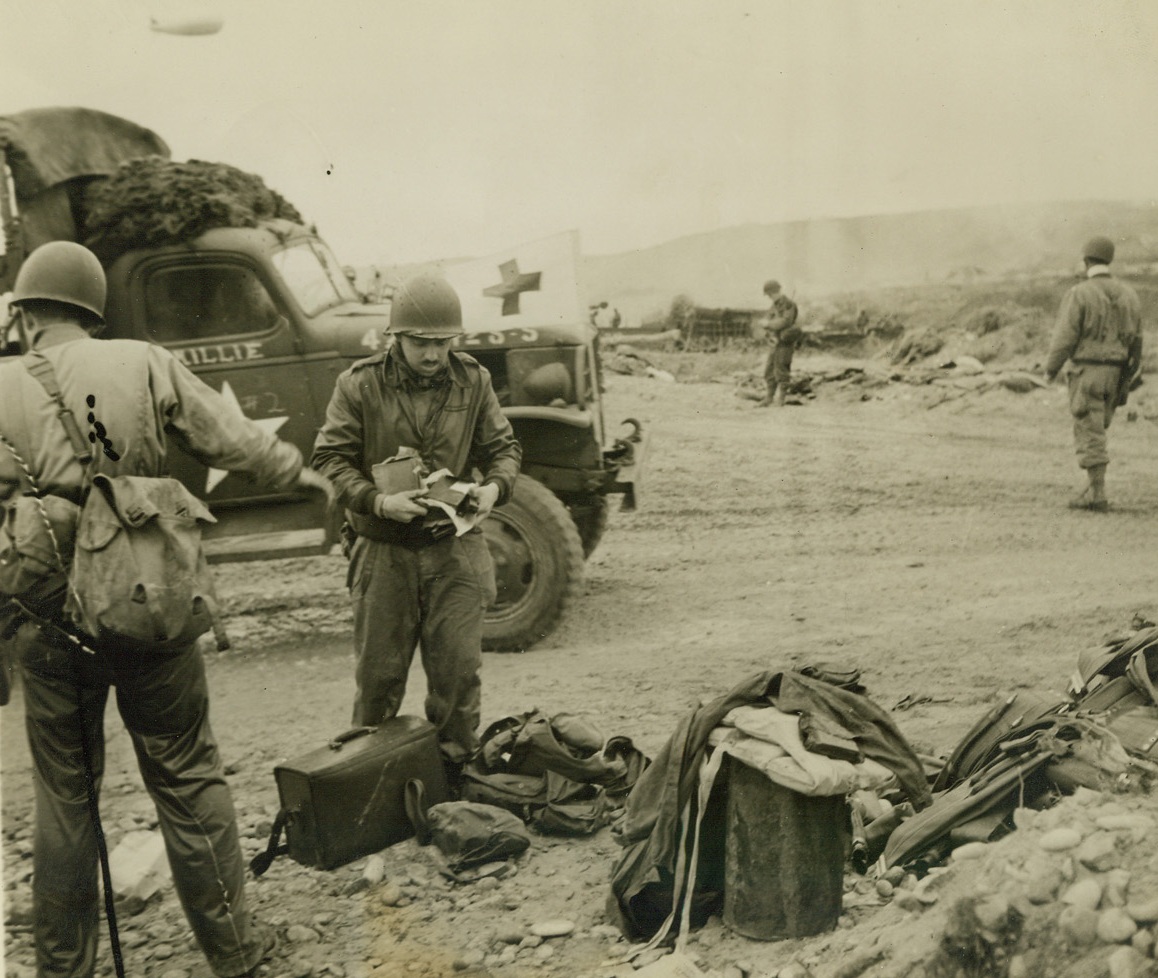
Why Photographers Get Gray!, 6/13/1944. France – Bert Brandt, ACME War Pool photographer, after swimming ashore on the Allied beachhead along the Norman Coast, carefully dries off his equipment. It was a tossup whether his stuff was ruined by the sea water, or not. But it was “not,” for he turned in an outstanding job of covering the invasion action and his photos were the first to reach London—and the U.S.—of any of the pool men. Passed by censors. Credit: ACME photo by Bert Brandt for War Picture Pool;
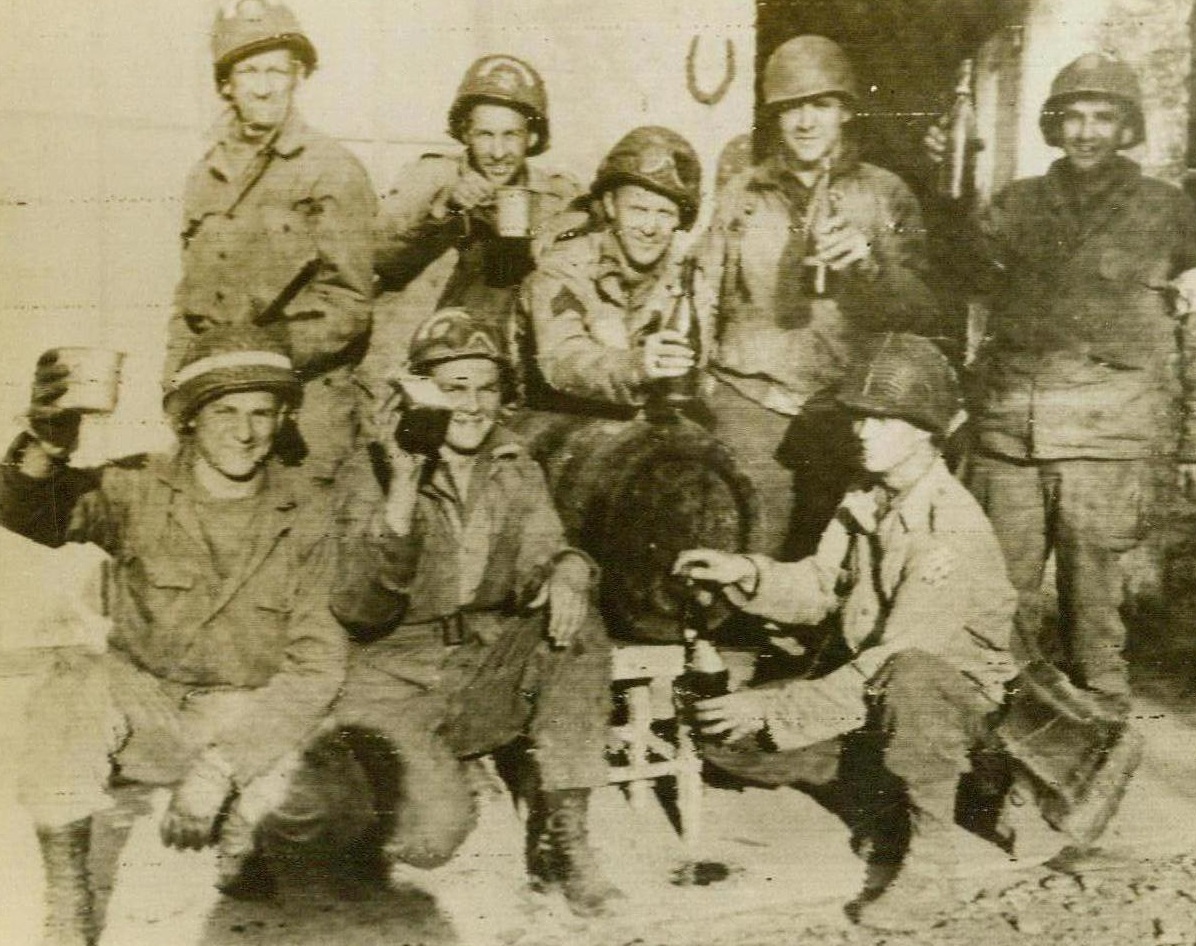
A Toast to Liberation, 6/14/1944. France—After they and their buddies had liberated this town along the coast of France, These U.S. soldiers received a barrel of wine from one of the thankful natives. Here, they drink a toast to the continued success of the Allied liberation of France 6/14/44 (RadioPhoto);
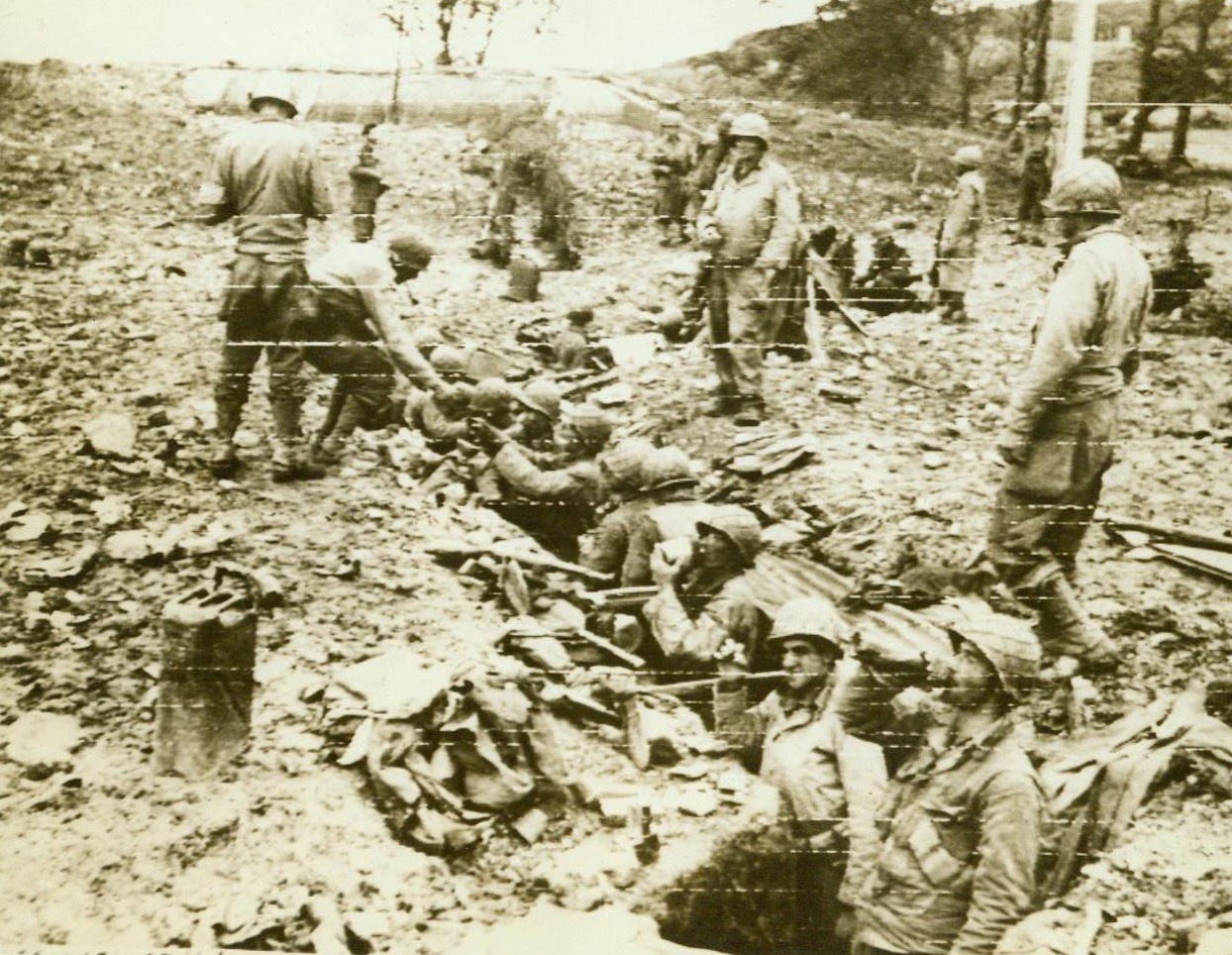
Wet Leatherneck, 6/28/1944. Saipan- This wet Leatherneck took a ducking when the landing craft in which he came was hit by Jap mortar fire before it reached Saipan beach. Here, he and other Marines, under enemy fire, crawl to their assigned positions. 6/28/44 ACME;

"Invincibles" Finally Reach England, 6/9/1944. England— A long line of once “invincible” German warriors march through an English coastal town on their way to internment camp after their capture on the French beachheads. Press reports state that more than 5,000 prisoners had been taken by the Allies in initial assaults on “Festung Europa.” 6/9/44 Acme RadioPhoto;
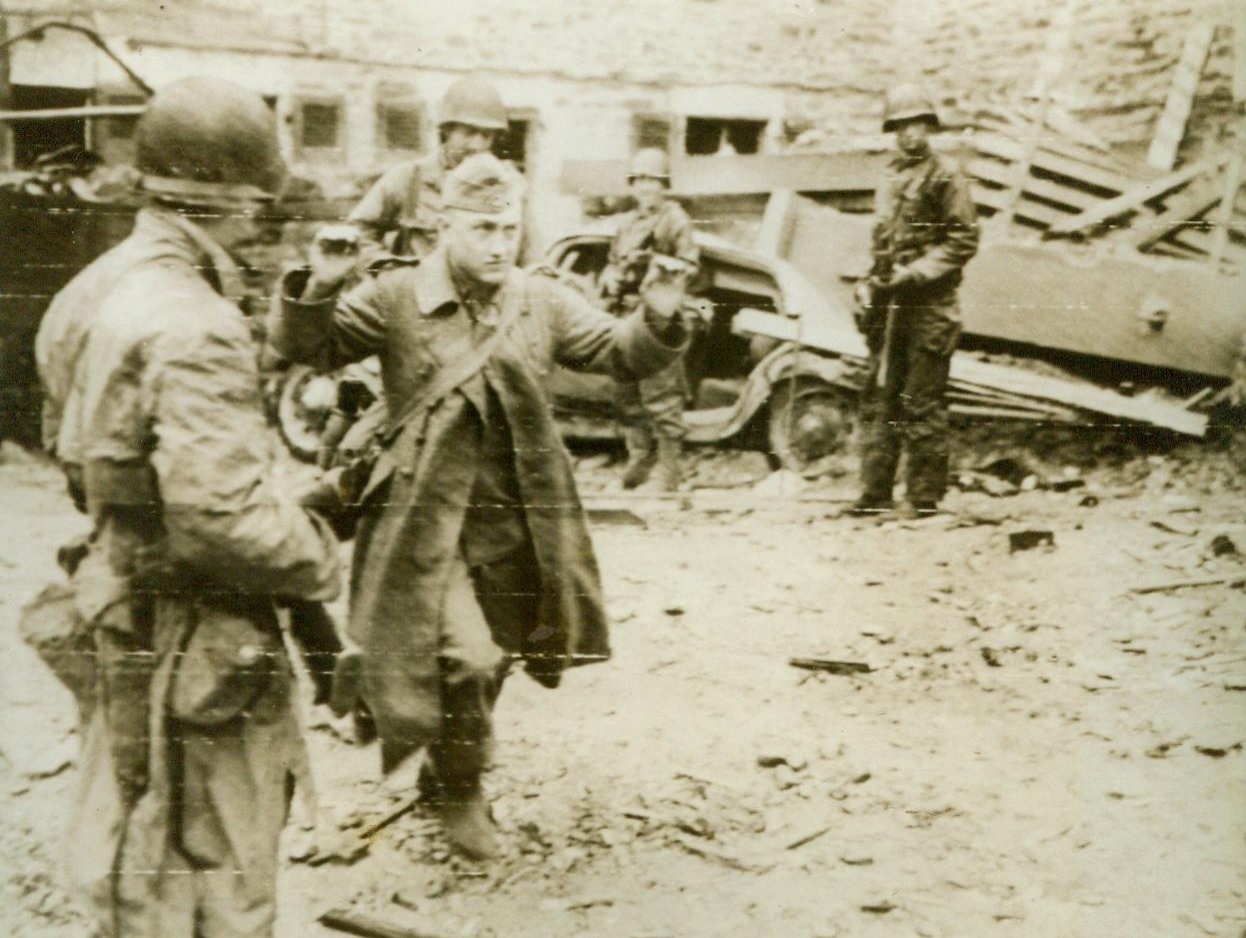
Vanquished Cherbourg Defender, 6/28/1944. Cherbourg - His hands upraised and a definitely unhappy look on his face, a German prisoner emerges from an underground fortress in Cherbourg. The enemy's resistance though stubborn could not last long in the key channel port once the Allies got started 6/28/44 (ACME);
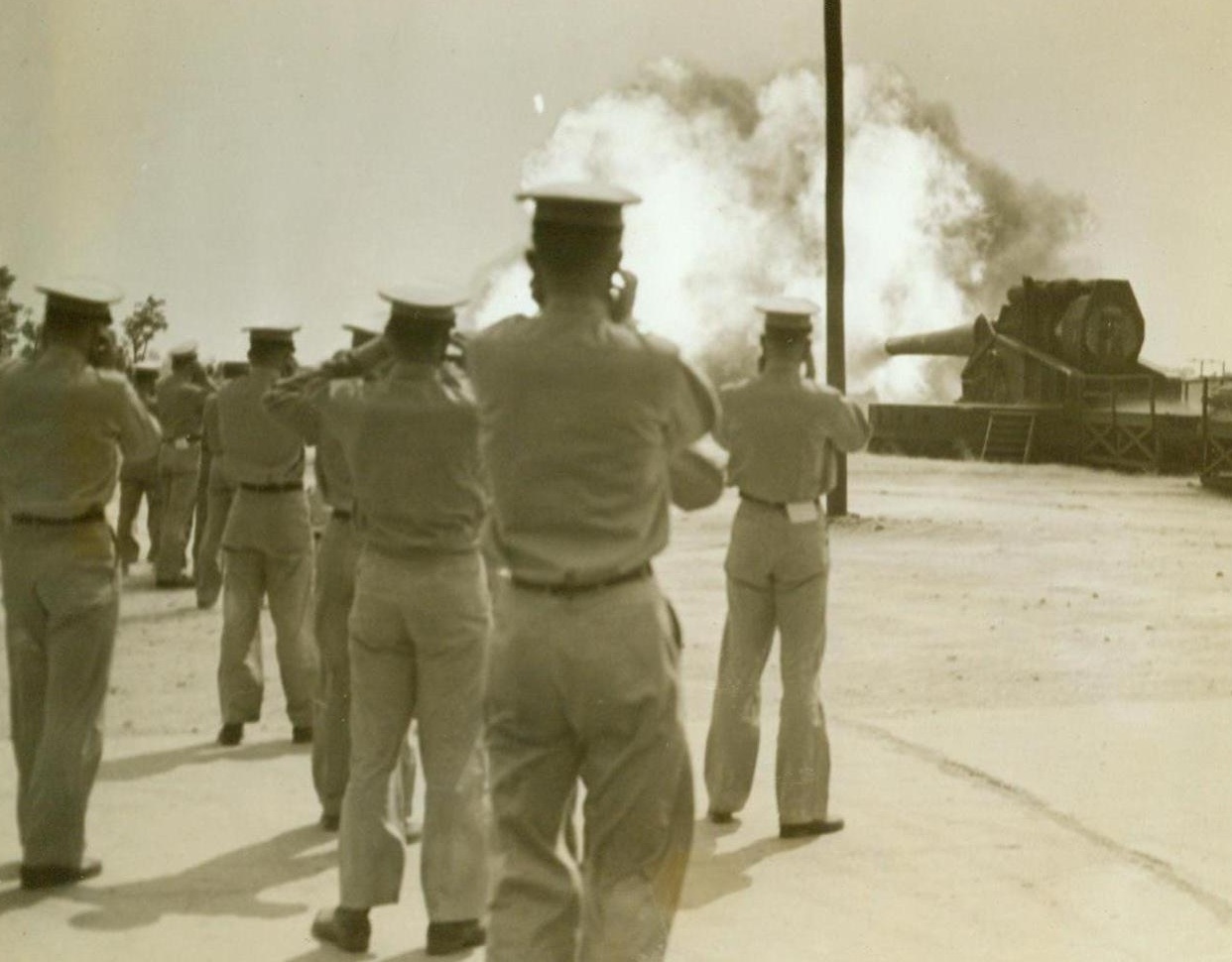
Cadets Get Ear Shattering Reception, 6/1/1944. Aberdeen, Md. – The might of American ordinance from the little carbine to the mighty 16-inch gun, was paraded before 303 members of the graduating class of the West Point Military Academy in the 21st annual training visit to the proving grounds at Aberdeen. Here they hold their ears as a 16-inch gun belches its charge. 6/1/44 (ACME);
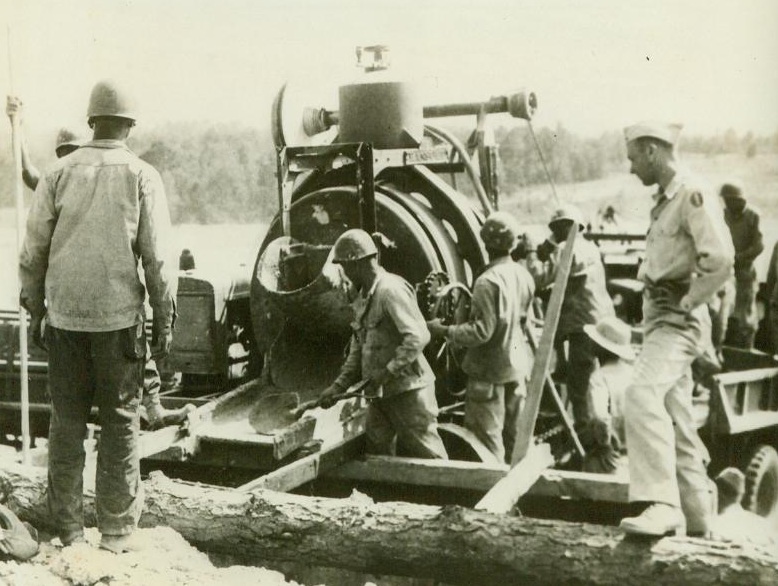
The Infantry Schools West Wall, 6/4/1944. Ft. Benning, Ga. – Newest assault course at Fort Benning is the infantry school’s authentic exterior replica of a section of Germany’s famed West Wall, a series of pillboxes and blockhouses, which extends along the coastline from France to Norway and which our invasion troops must reduce from beachheads before they can drive inland to strike at the heart of Nazidom. Constructed after study from Allied photographs, the course covers 1,000 square yards and is used by the infantry school in the training of officers and officer candidates. Infantry school demonstration troops, some of whom are shown in these photos, carry out “assaults” for the benefit of each new class. Live ammunition is used and every three weeks the concrete pillboxes and blockhouses must be largely rebuilt and barbed wire torn by bangalore torpedoes must be restrung by engineer troops assigned to the school. Photo No.5: Since live ammunition is used in the "attacks" on the infantry school's authentic replica of the German's "West Wall", every three weeks the concrete pillboxes and blockhouses must be largely rebuilt and barbed wire torn by bangalore torpedoes must be restrung by engineer troops assigned to the school. Here a force of Engineers rebuild a pillbox in preparation for the next demonstration. 6/4/44 (ACME);

The Infantry School's "West Wall", 6/4/1944. FT. BENNING, GA. -- Newest assault course at Fort Benning is the Infantry School's authentic exterior replica of a section of Germany's famed West Wall, a series of pillboxes and blockhouses, which extends along the coastline from France to Norway and which our invasion troops must reduce from beachheads before they can drive inland to strike at the heart of Nazi-dom. Constructed after study from Allied photographs the course covers 1,000 square yards and is used by the Infantry School in the training of officers and officer candidates. Infantry school demonstration troops, some of whom are shown in these photos, carry out "assaults" for the benefit of each new class. Live ammunition is used and every three weeks the concrete pillboxes and blockhouses must be largely rebuilt and barbed wire torn by bangalore torpedoes must be restrung by engineer troops assigned to the school. PHOTO NO. 4: Maj. H.A. Cornell, Portland, Ore., engineering officer who is an instructor at the Infantry School, inspects a destroyed pillbox on the "West Wall" course. Credit Exclusive ACME Photo;
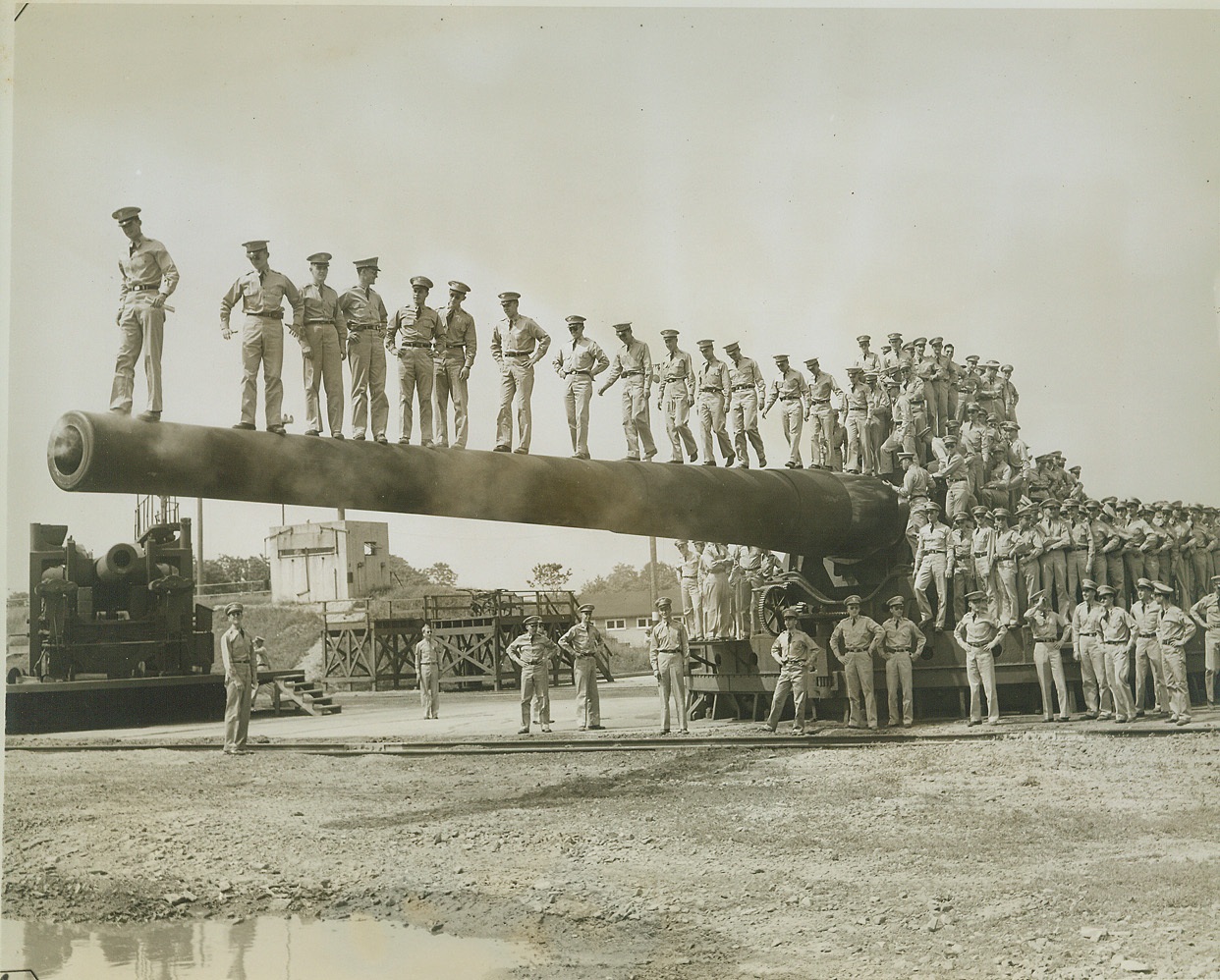
Mighty Diving Board, 6/1/1944. ABERDEEN, MD. – In the 21st annual training visit to the Aberdeen, Md., Proving Grounds, 303 members of the graduating class of the West Point Military Academy were introduced to the might of American ordnance. They saw everything from the little carbine to the powerful 16-inch gun. Here they pose with one of the 16-inchers which they later saw in action. Credit: (ACME);
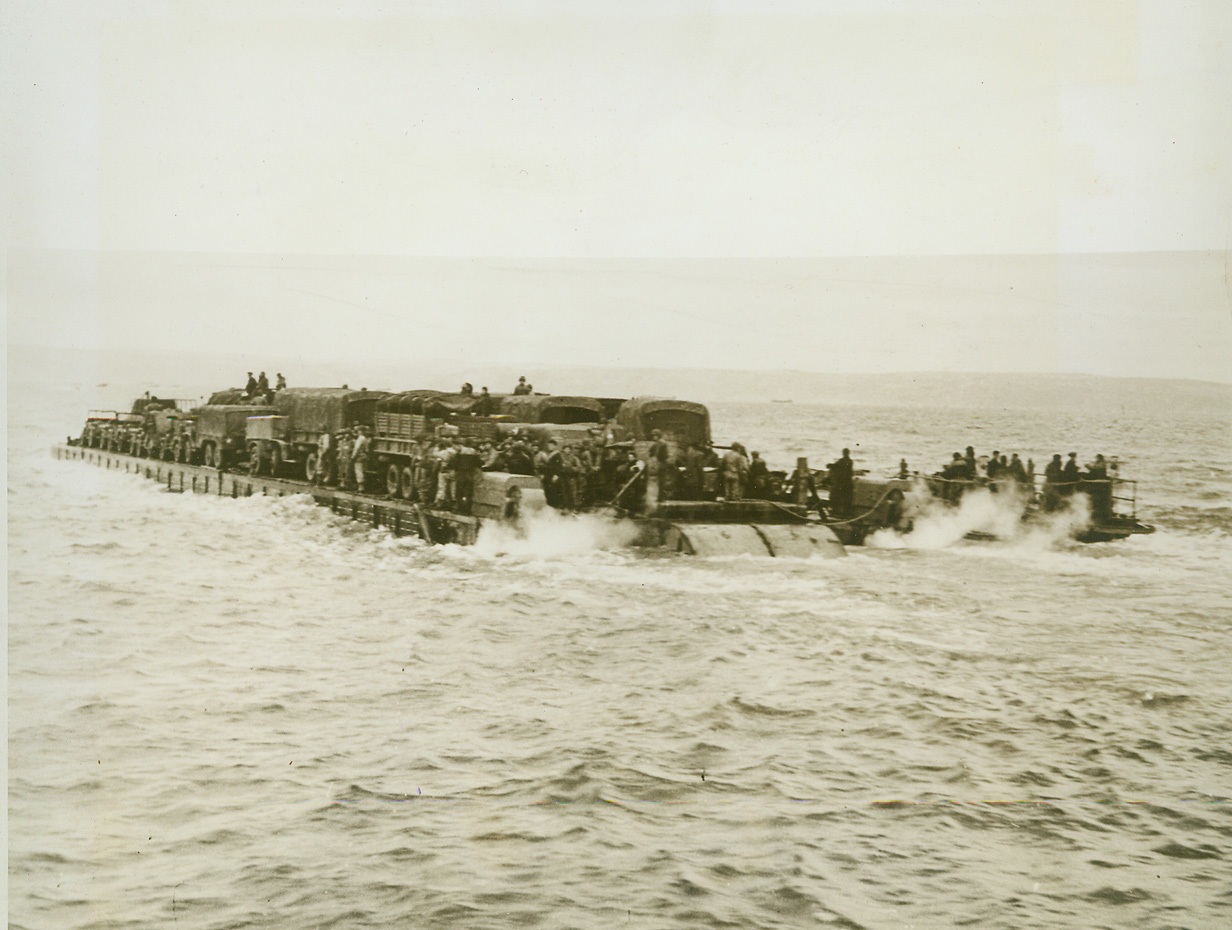
Calling all Engines, 6/6/1944. CHICAGO, ILL. – The familiar phrase, “Calling all cars”, used in police radio, may soon have its counterpart in railroading for two-way communication in high frequencies is now in use for the first time on engines of the Rock Island, Ill., lines. Their present installation of transmitters and receivers, operating at 10 watts in the 40 megacycle band of frequencies, is in use only in the Burr Oak freight yards near Chicago. Now the freight yard master can talk with engineers in switch engines, relaying orders and getting information on the whereabouts of engines. Called WXIOTL, the station has an operating radius of 25 miles. The railroad has FCC permission to install high frequency systems for communication between train engines and cabooses, yard and yard dispatcher and trains. New York Bureau Here, the twin 143-HP, Chrysler marine outboards at either end of the stern churning up the sea, the “rhino ferry” heads for shore loaded with motor vehicles and supplies, after loading from a transport. Credit: (U.S. Navy Photo from ACME);
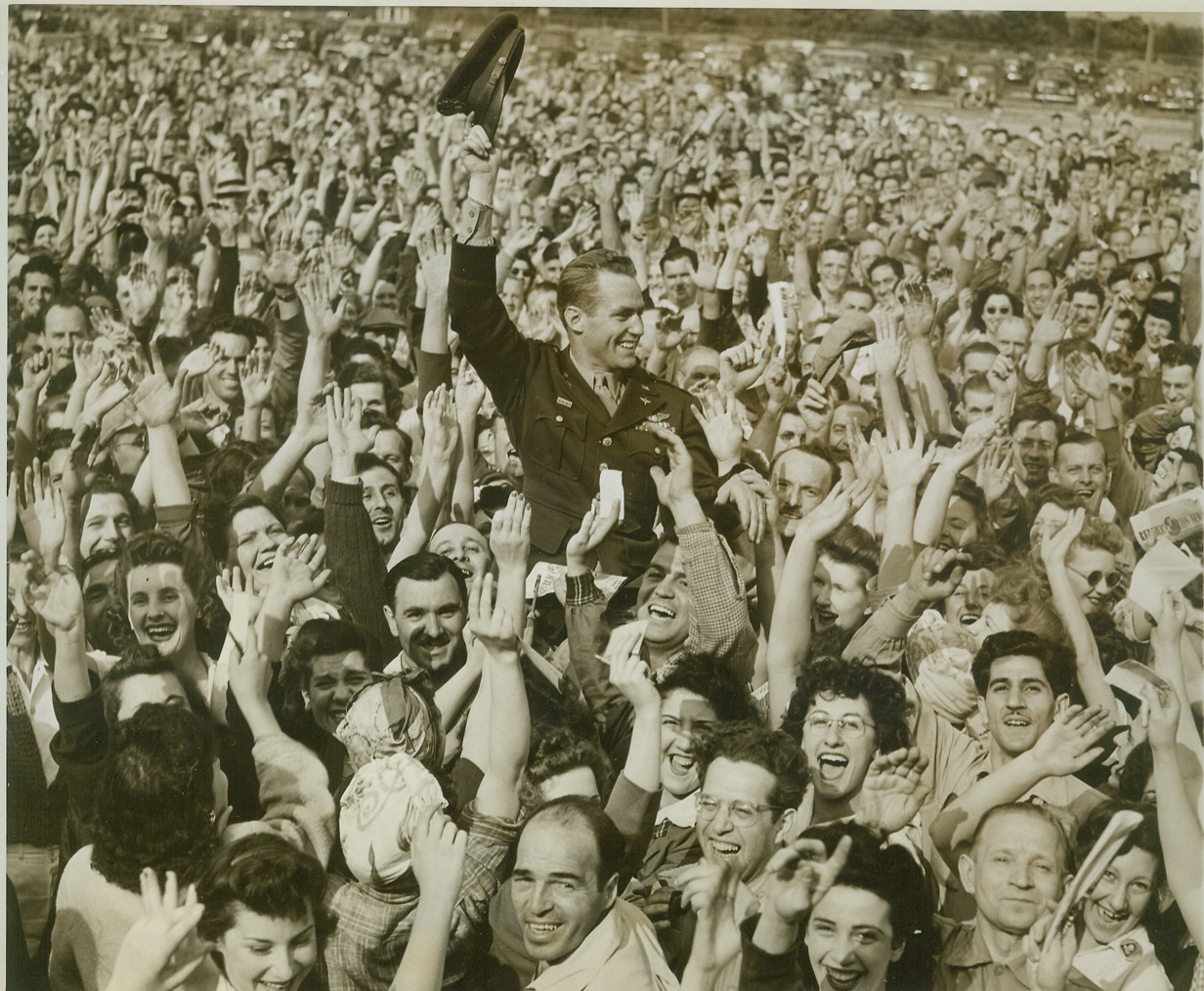
Aircraft Workers Cheer Air Ace, 6/9/1944. FARMINGDALE, L.I. – Clapping and cheering loudly, workers at the Long Island plant of Republic Aviation Corp. lift Maj. Robert S. Johnson to their shoulders in a triumphant parade in recognition of the air ace’s record of 27 planes downed in the ETO. Maj. Johnson was a guest at the Republic plant, makers of the famous Thunderbolt fighter plane, which he flew in combat. Upon his return to the U.S. the air ace was received at the White House by the President and Mrs. Roosevelt, and was recognized on the floor of the U.S. House and Senate. Credit (ACME);

Hamburg Gets It Again, 6/25/1944. HAMBURG, GERMANY – Great clouds of oily black smoke drift skyward from the burning oil refineries at Hamburg. Three attacking Flying Fortresses of the 8th Air Force, which staged the raid, wing over the flaming plant. Credit: (Signal Corps Radiotelephoto-ACME);

What Invasion Troops Must Still Face, 6/8/1944. This photograph which arrived in the United States from a neutral source, shows lines of reinforced concrete anti-tank obstacles on the Atlantic Wall. Although spearhead invasion troops have established beachheads on the French coast and are now fighting inland, they will not face the obstacles created by the Atlantic wall until they have penetrated one hundred miles inland. At that point, according to the Nazis, the real invasion defenses start. 6/8/44 (ACME);
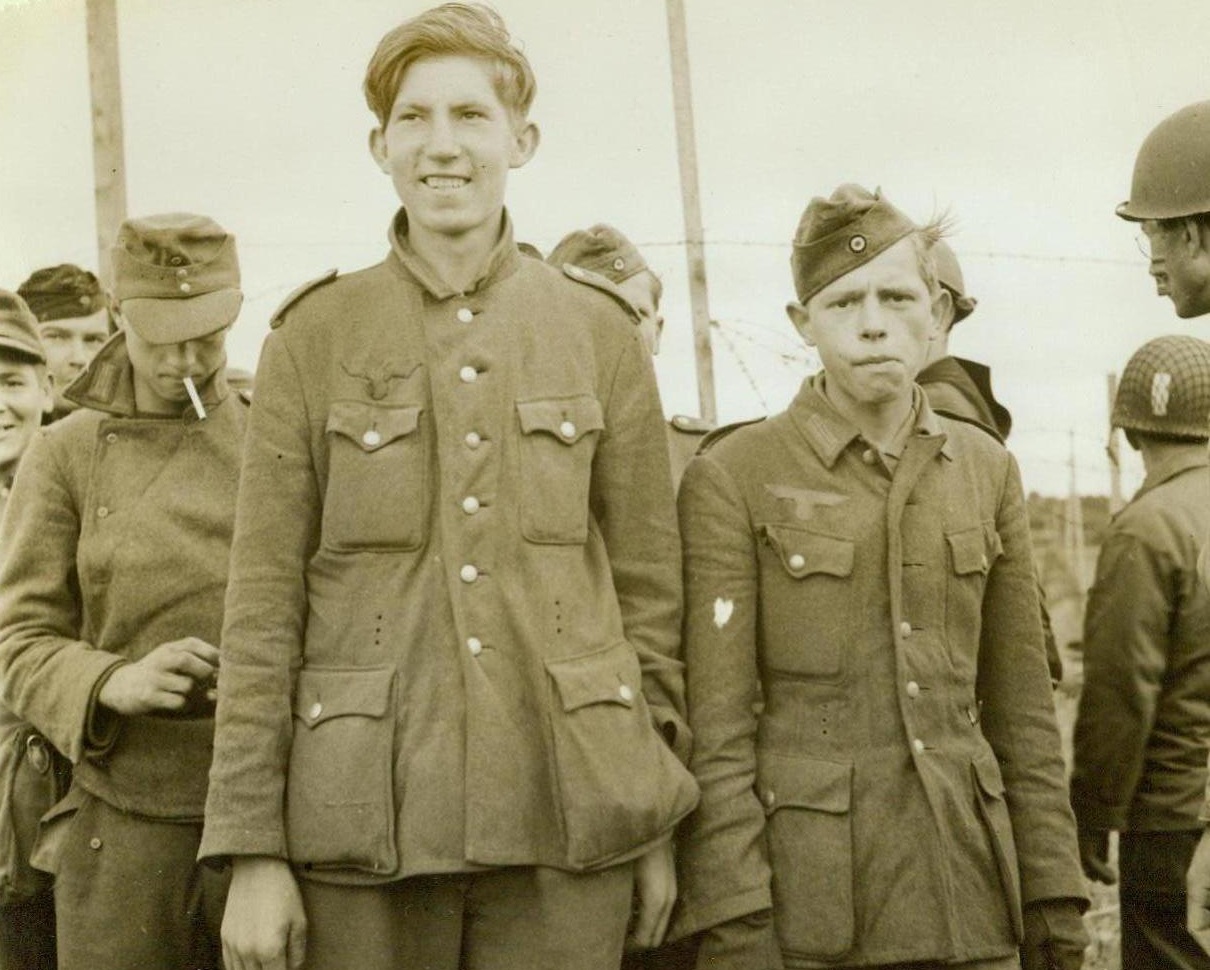
End Of A Short "Career", 6/13/1944. France – These teen-aged German “Super Men” do not seem particularly put out by having their brief military “careers” terminated so suddenly by the Allied liberators of France. They were among the first prisoners taken by American, English, and Canadian troops landing along the Norman coast. 6/13/44 (ACME photo by Bert Brandt For War Department Picture Pool);
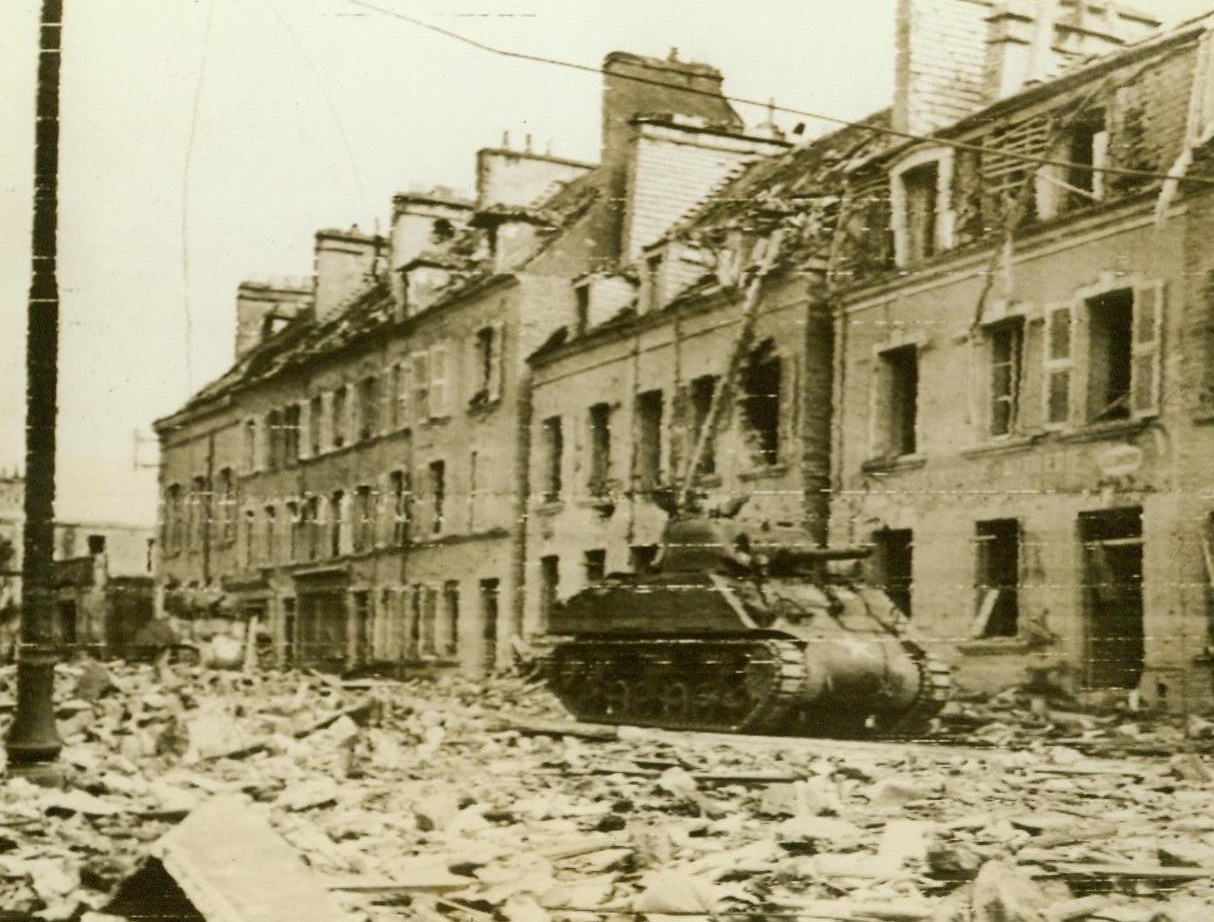
New Meaning For Word "Devastation", 6/28/1944. Cherbourg, France – Subjected to one of the most concentrated land, sea and air bombardments since the battle of Cassino, Italy, Cherbourg today lies in ruins. Its port facilities, however, were of such permanent construction that Army engineers should have them in good shape within a few weeks – with limited usage possible within a few days. Here, (above), an American tank rumbles through a rubble-strewn street as it enters Cherbourg on a “mopping-up” patrol. 6/28/44 (Army Radiotelephoto From ACME);

Why War Bonds Are A Must, 6/14/1944. France – In graphic detail these wrecked armored vehicles tell the story of the fierceness of the battle to establish beachheads in France. No plea is necessary for the sale of war bonds. The need to keep the Allied Armies fighting for the liberation of Nazi-enslaved Europe are reinforced is ever present. American soldiers, joined in this historic battle, must be given the best possible equipment. The way to get it to them is to buy more war bonds 6/14/44 (ACME Photo By Bert Brandt, War Pool Correspondent);
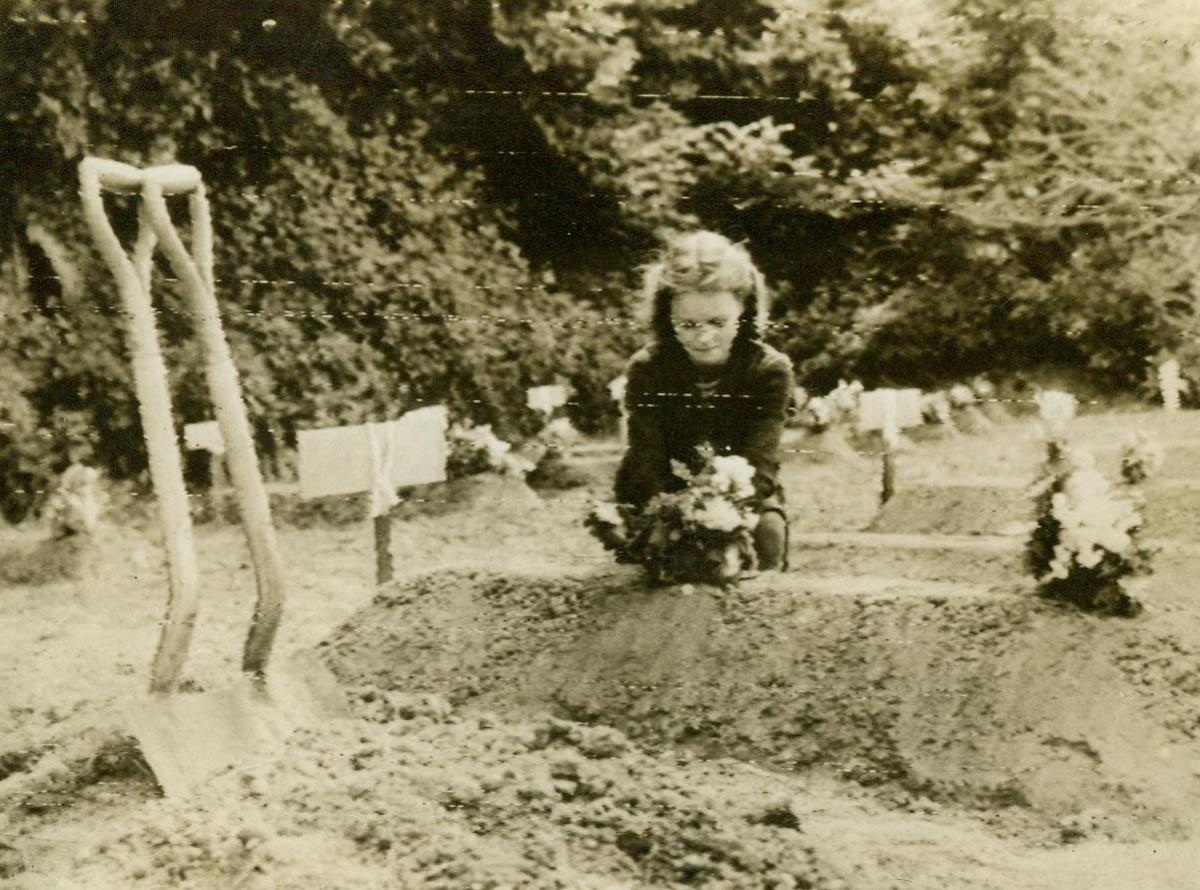
To The Memory Of A Hero, 6/12/1944. Killed far away from home, an American Airborne soldier was buried in the famous poppy fields of France, and a little French girl places flowers on his freshly-dug grave. The French look upon the Americans and their brother Allies as heroes who brought liberation to France when they landed on its shores 6/12/44 (Army Radiotelephoto From ACME);
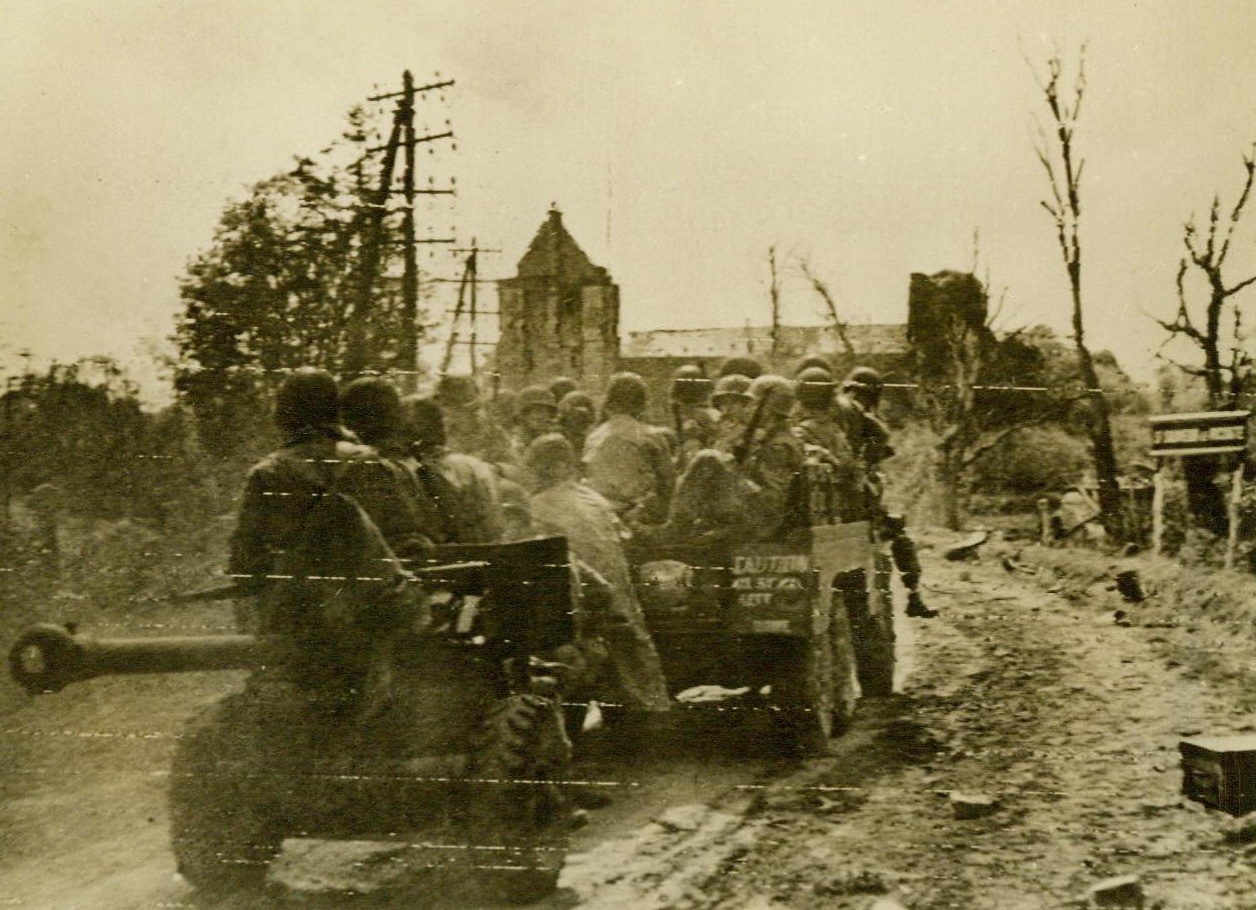
Cherbourg Bound, 6/19/1944. St. Saveur Vicouter, France – Heading for the prize port of Cherbourg, American troops ride through St. Saveur Vicouter, which is in the center of the embattled peninsula. Late reports from the area indicate that the Yanks are within seven miles of Cherbourg. 6/19/44 (Signal Corps Radiotelephoto From ACME);
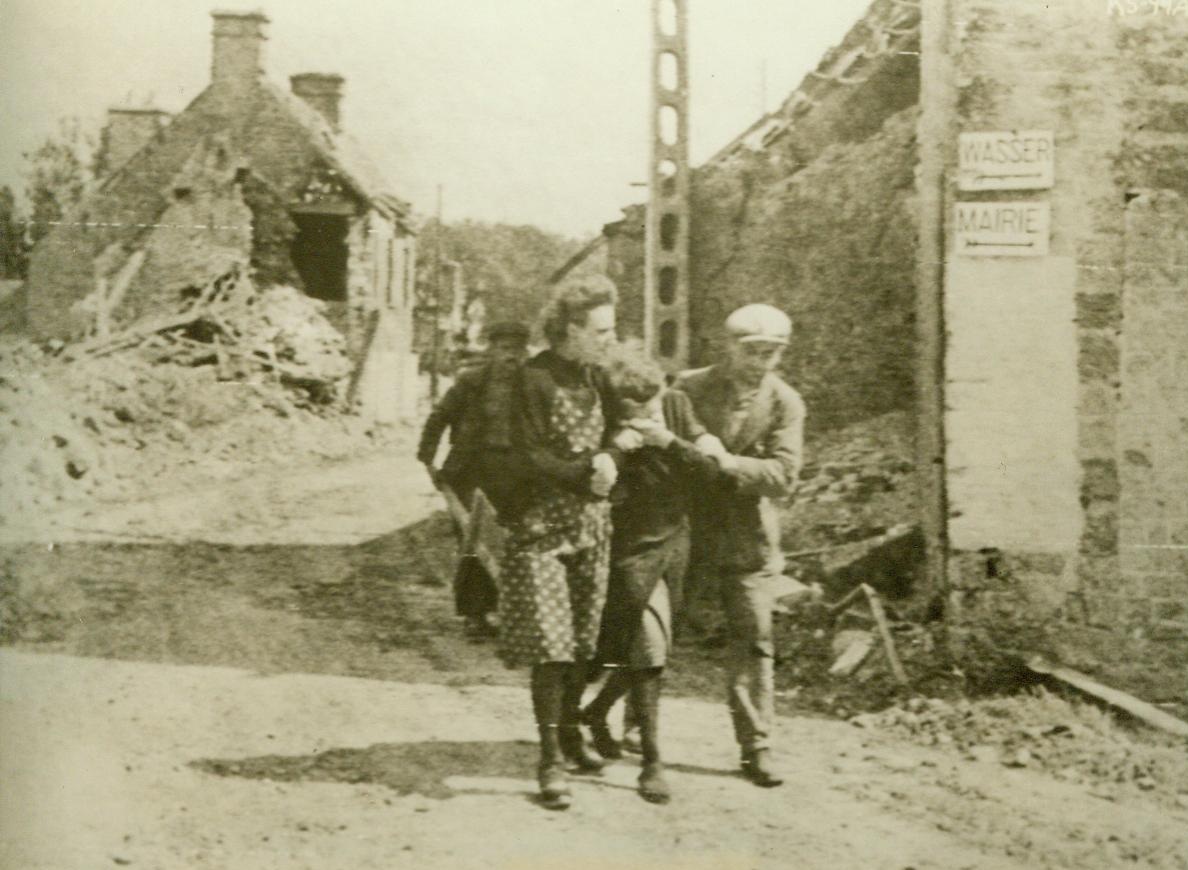
Mourns For Dead Husband, 6/19/1944. France – Weeping hysterically, a village woman of Ste. Marcouf is led away by friends after she discovered that her husband had been killed ruing the German shelling of the little town. She found her husband’s body in a little store to the right, where signs “Wasser” and “Mairie” were nailed up by the Nazis 6/19/44 (Signal Corps Radiotelephoto From ACME);
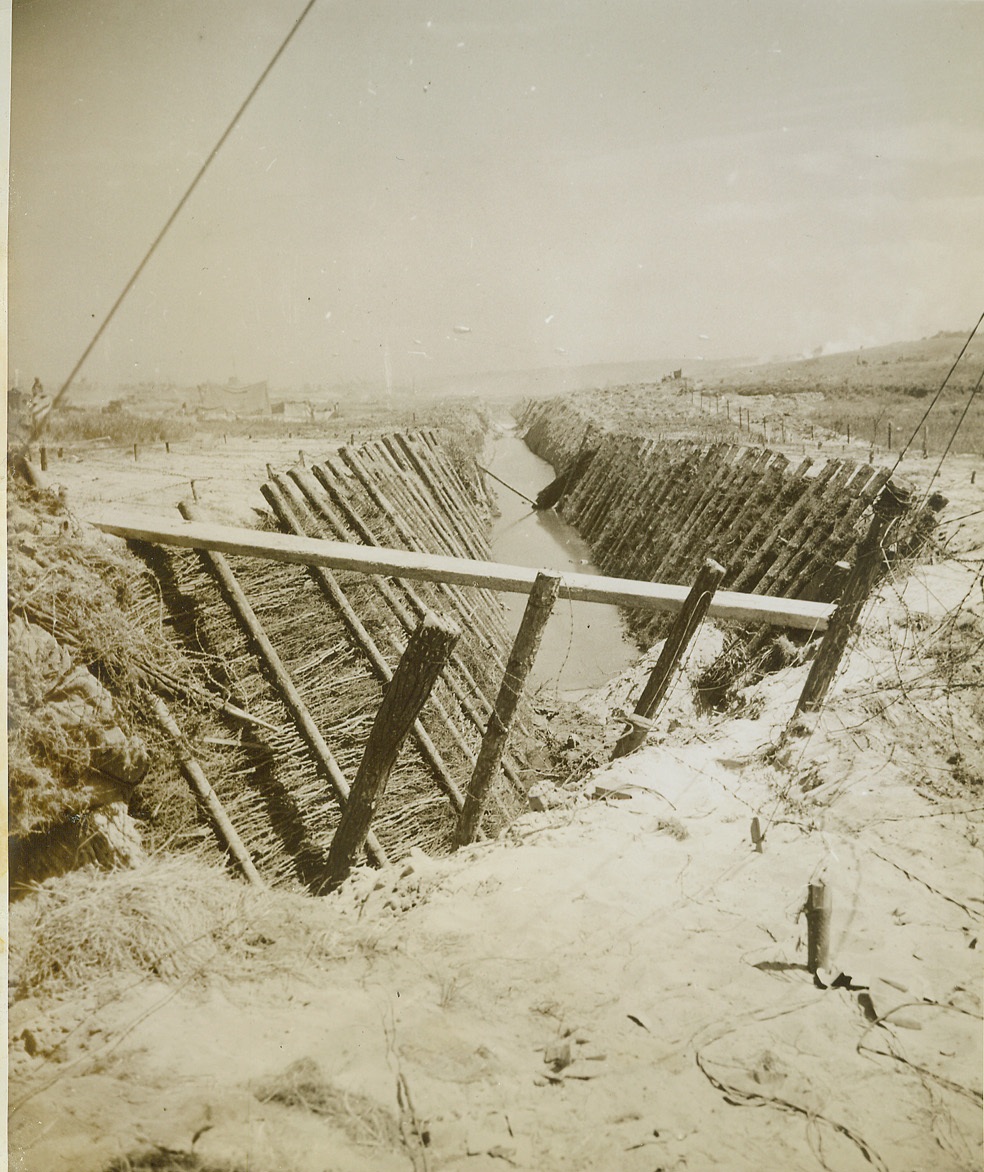
Fifteen Feet Deep and Useless, 6/19/1944. SOMEWHERE IN FRANCE -- Fifteen feet deep, reinforced with timbers, and flooded as a final precaution, this Nazi tank trap was one of the reasons why Hitler's horde thought they could sit back and take life easy -- for the Allies would never pass. But the big ditch, dug about 150 yards from the beach, failed to halt the Allied armies who were soon way past the trap and taking German strongholds inland by storm. Credit: -WP- (ACME Photo by Bert Brandt for the War Picture Pool);
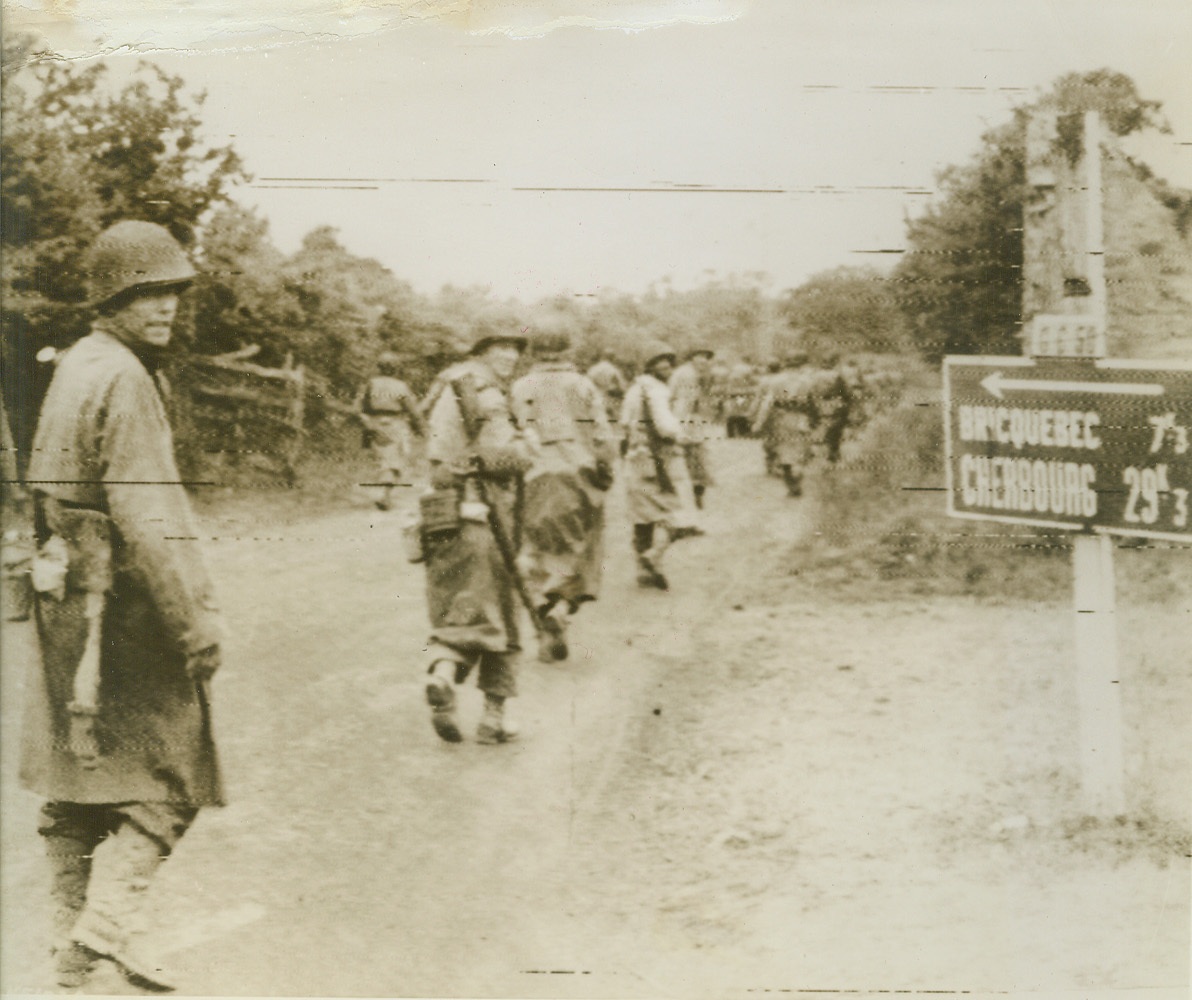
They’re Closer, Now!, 6/20/1944. France—U.S. Infantrymen head for action below Cherbourg, passing a sign giving the distance to the important city, as 29 kilometers (about 18 miles). Photo was flashed to the U.S. today, when it was announced that U.S. forces are only three and a half miles from the important channel port, and closing in fast. Credit: Army radiotelephoto from ACME;
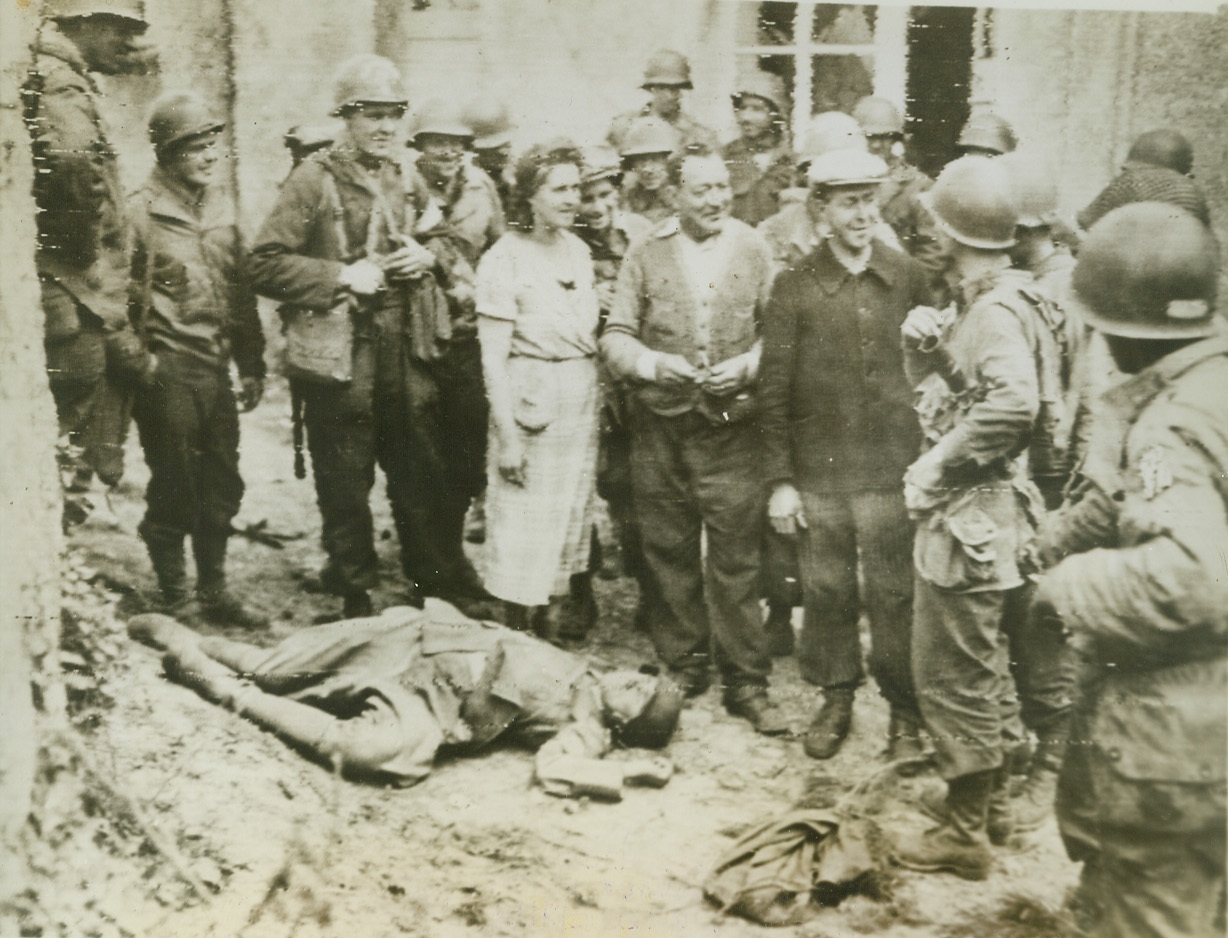
French Strike For Allied Cause, 6/14/1944. France—As the Allies advance through France, the French people, under direct orders from Gen. Eisenhower, are committing acts of sabotage and doing what they can to hinder the Nazi troops trying to stop the Allied armies. A group of French people tell American soldiers about the dead German in foreground who was killed by the Frenchman at right after he was forced to work for the Nazi at $2 a week. Credit: Signal Corps radiotelephoto from ACME;

First Normandy Port Captured, 6/14/1944. France—British soldiers stand at the quayside at Port en Bessin, the first port captured by the Allies in Normandy, looking at a German flak ship which was sunk in the harbor. Credit: British war office photo transmitted from London by Signal Corps radiotelephoto from ACME;
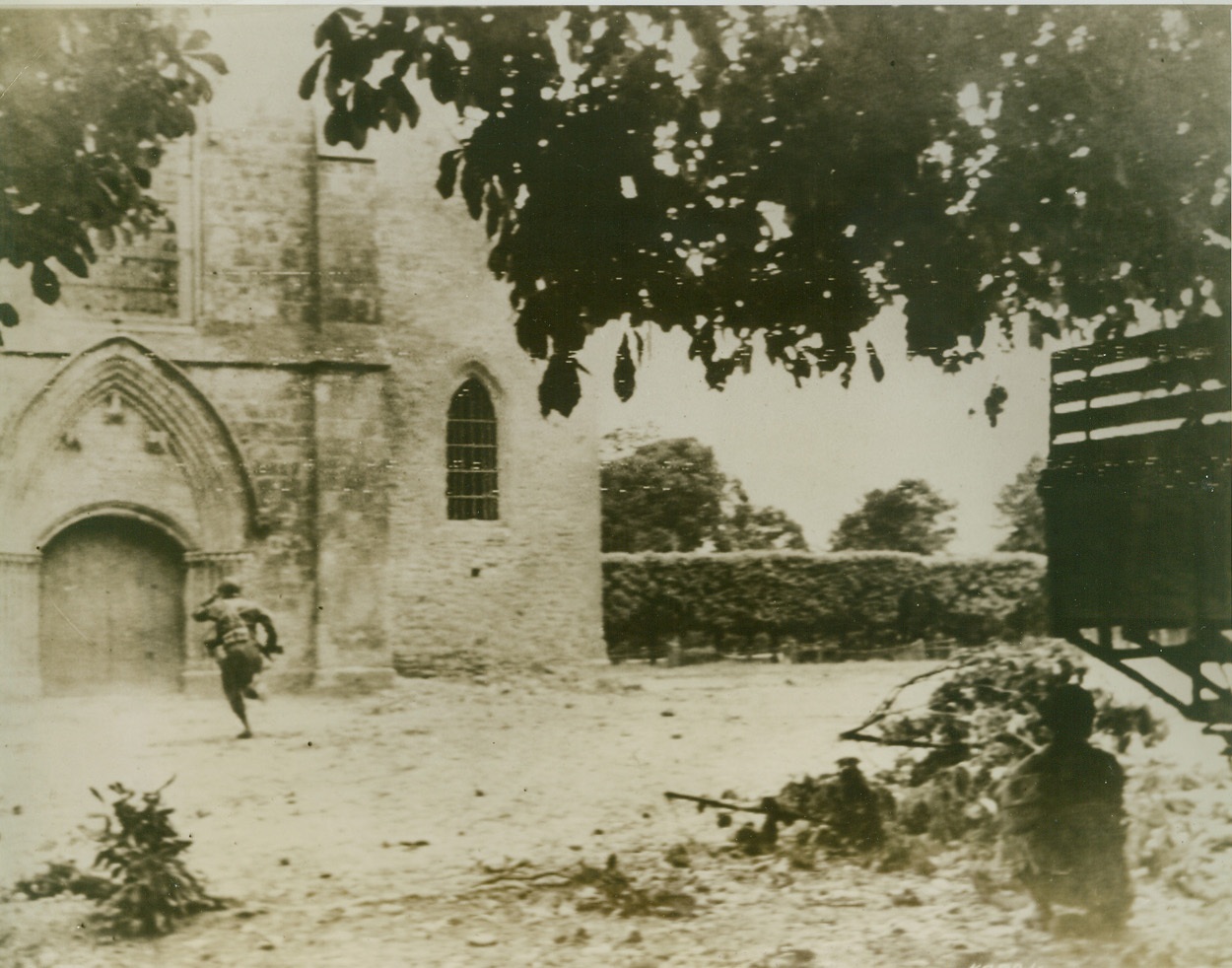
Routing Nazi Sniper, 6/12/1944. France—This dramatic picture tells the story of the courage of the Allied fighters in France and their determination to wipe out Nazi troops where ever they may find a hole occupied by an enemy rat. Here, in a desperate attempt to get a German sniper hidden in a church in the center of St. Mere Eglise, an infantryman dashes towards the sniper’s next while another Allied fighter, right, covers him. Credit: Army radiotelephoto from ACME;
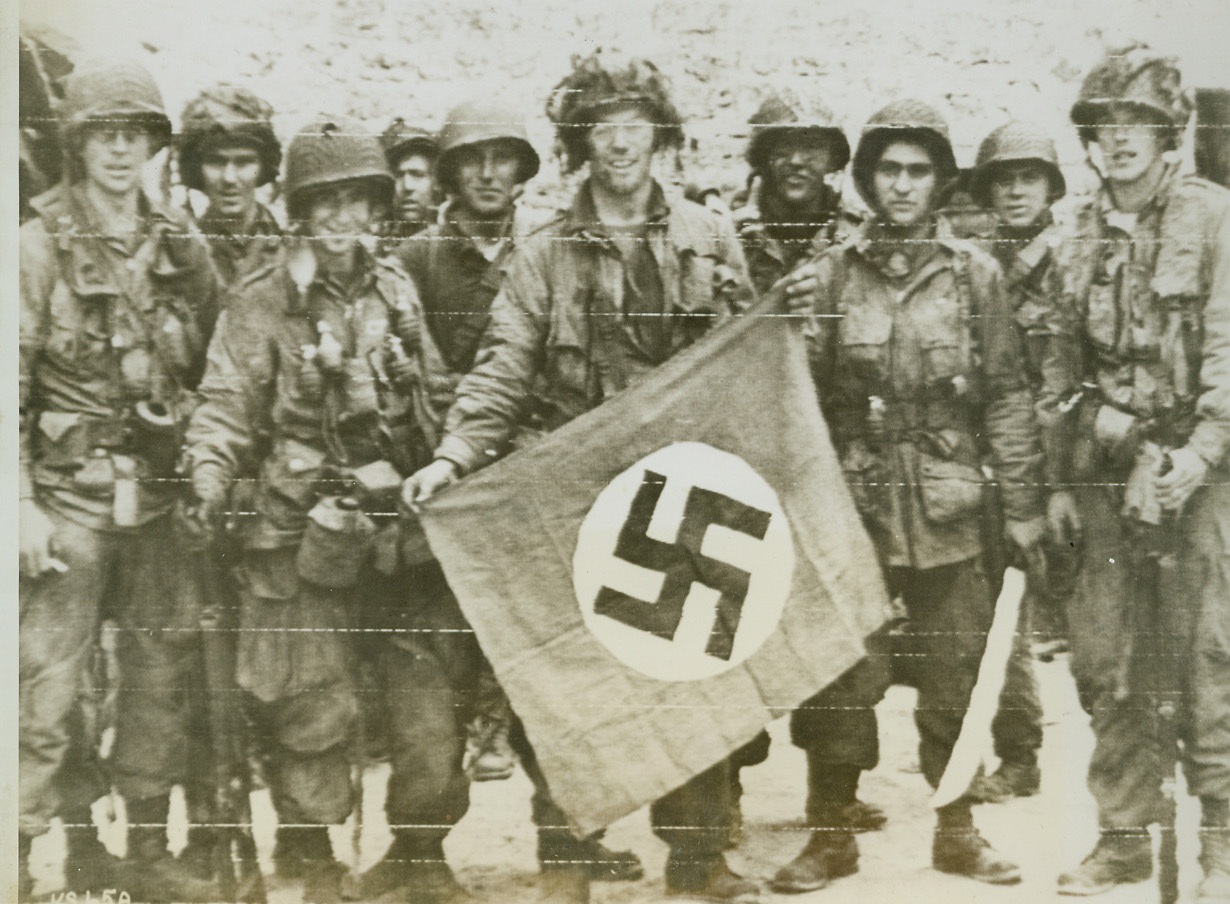
First Booty Brings Cheer, 6/9/1944. France—American paratroopers smile happily as they display a captured Nazi flag taken in assault on a French village. These soldiers were among the first Allies to return to France since the retreat from Dunkirk. Credit: Signal Corps radiotelephoto from ACME;
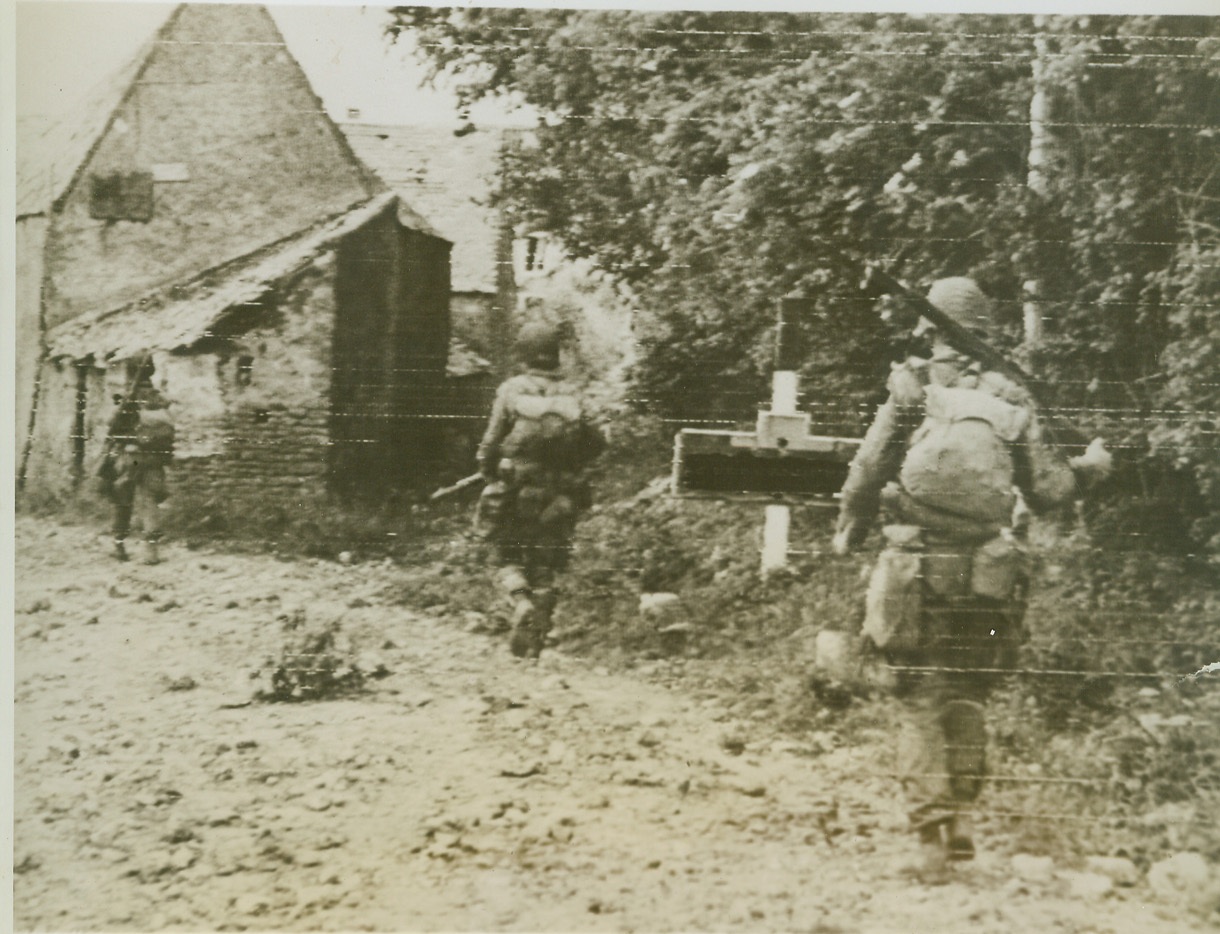
First Stop On The Road to Berlin, 6/9/1944. France—Using the countryside foliage and buildings for cover, American paratroopers move cautiously into a small village in northwestern France. Allied advances now face their first major land tests against rapidly stiffening resistance from Nazi reserves flung into the acknowledged 70-mile battleline. Credit: Signal Corps radiotelephoto from ACME;
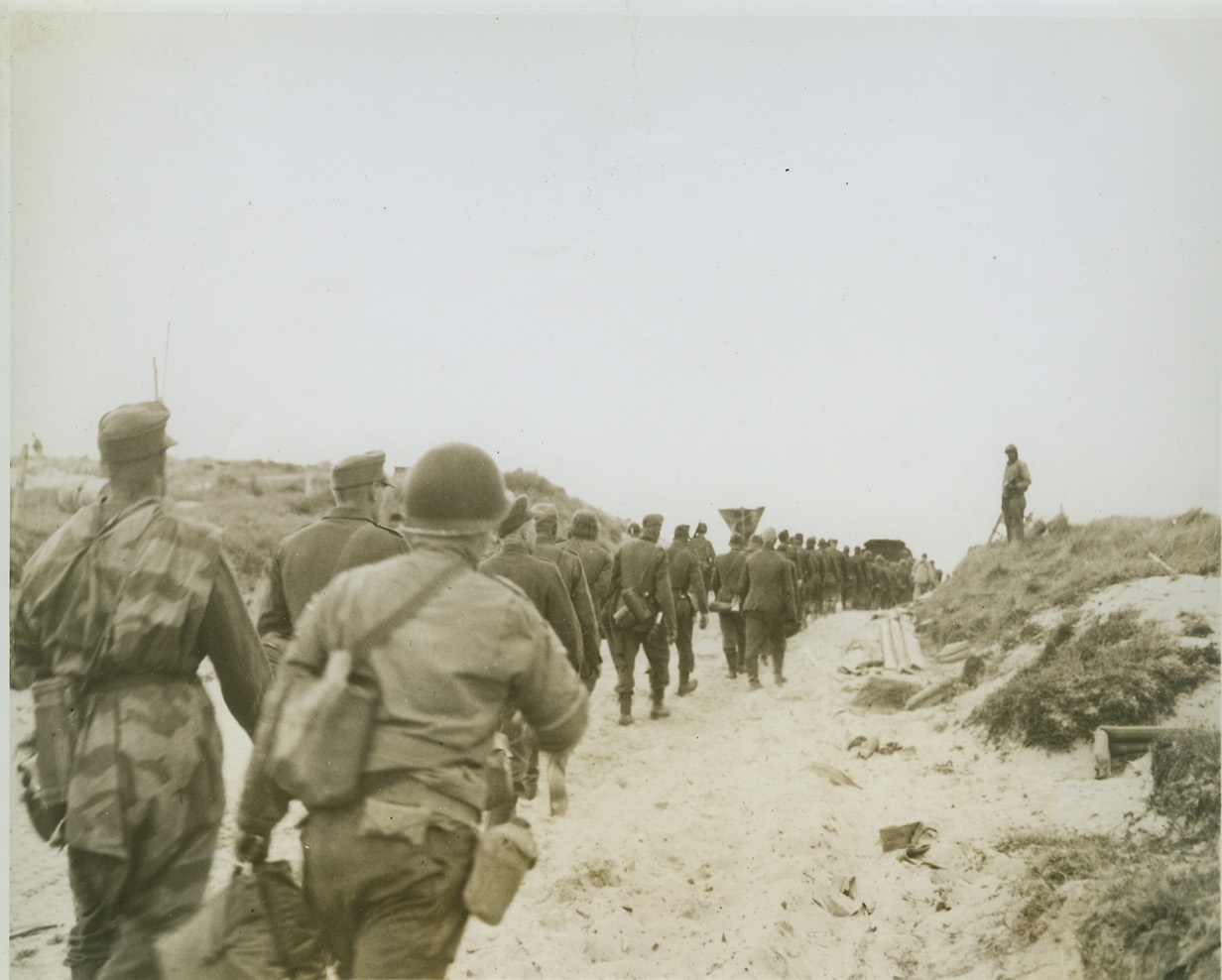
Nazis—A Motley Crew, 6/12/1944. France—Sorry about the whole thing, these German prisoners march through the sands of a Normandy beach towards the sea and transportation to England where they will be placed in prisoner of war compounds. Allied soldiers guard the column of Nazis—on the alert for any escape attempts. Credit: ACME;
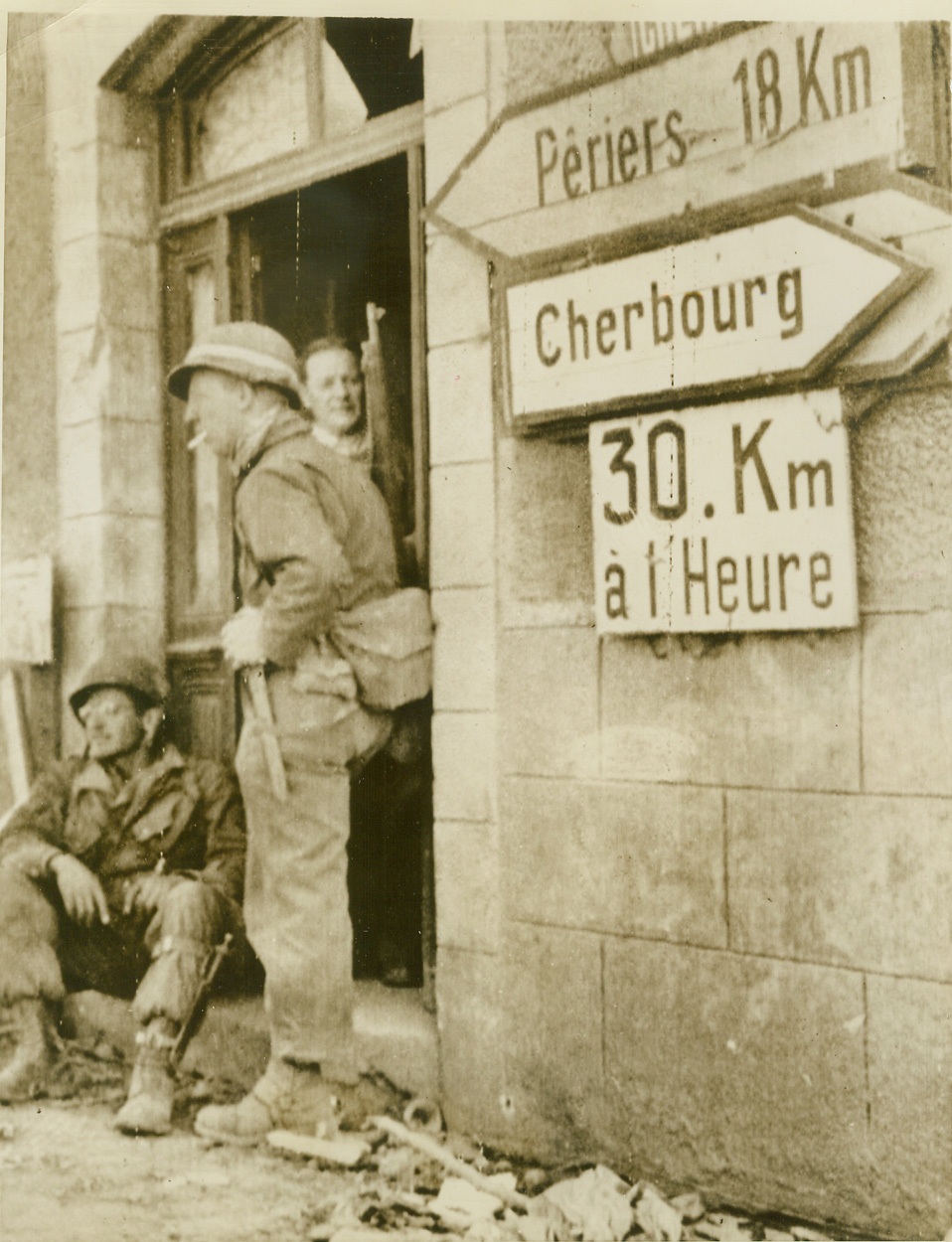
Speed Limit-Unlimited, 6/19/1944. France—Yank troops pushing steadily toward Cherbourg rest beside a sign pointing to that important port. Speed limit is posted at 30 kilometers an hour (approximately 18 miles) but that doesn’t apply to Allied soldiers who have now isolated an estimated 30,000 enemy troops in Cherbourg. Credit: Signal Corps radiotelephoto from ACME;

Home Is Where The Nazis Aren’t, 6/19/1944. France—Hardened by the war, a French family gives no notice to the dead German and smashed equipment as they trudge toward their home in Pont L’Abbe. In particular notice the small children who seemingly find nothing unusual in the fact that a dead Nazi lies in the street. Pont L’Abbe was one of the last towns taken by the Allies before isolating the Port of Cherbourg. Credit: Signal Corps radiotelephoto from ACME;
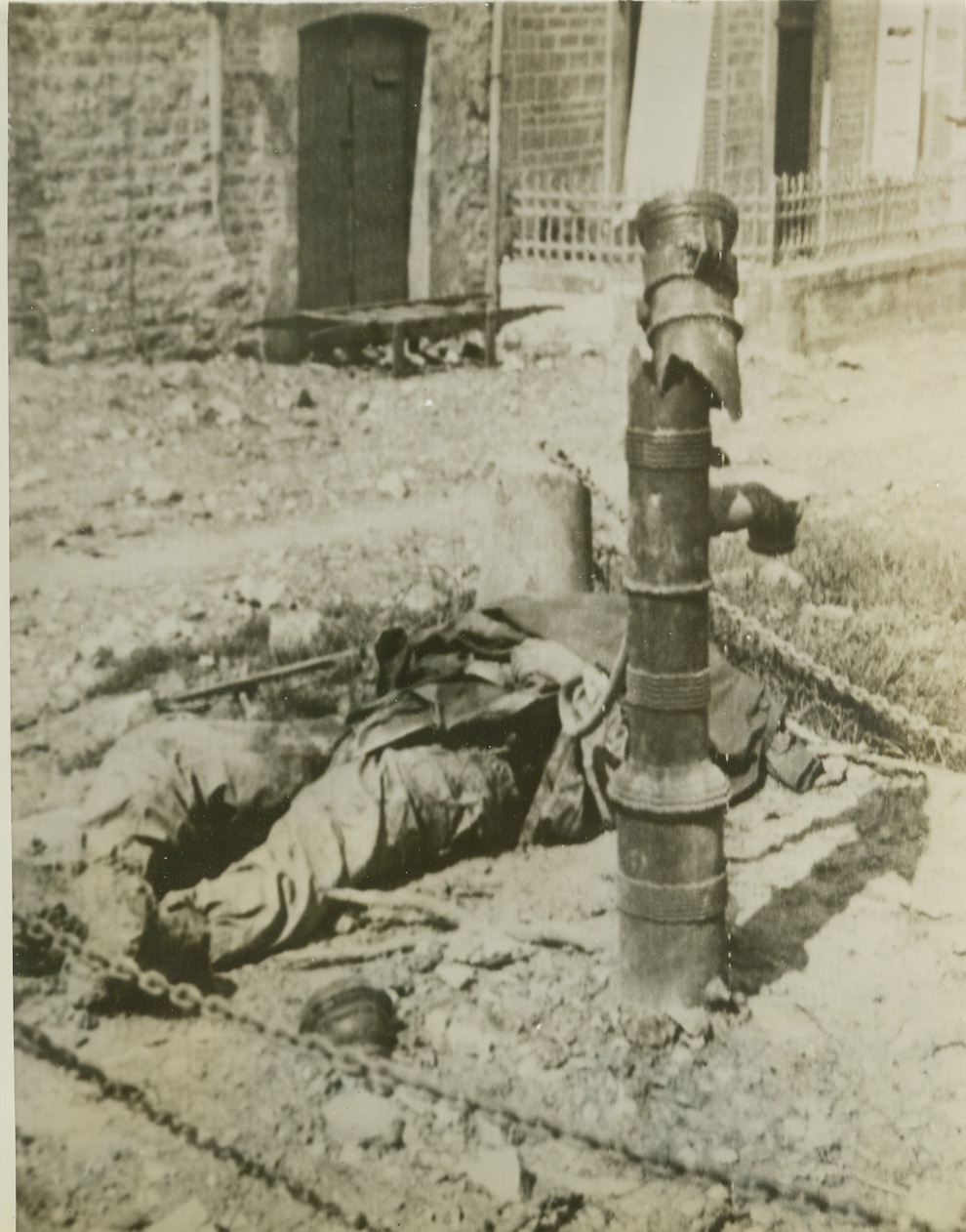
Victim of Nazi Trick, 6/18/1944. France—Treacherous Germans planted a booby trap in the water pump of a small German village on the Cherbourg peninsula—a trick that spelled death for this unsuspecting Yank. The ill-fated American lies beside the wreckage of the pump at which he met violent death. Credit: ACME photo via Signal Corps radiotelephoto;

"France Thanks You, My Boy!”, 6/14/1944. Colleville-Sur-Mer, France—With an embrace that seems to express the joyous gratitude of Frenchmen everywhere, the mayor of this tiny hamlet, greets the first American soldier of the forces of liberation entering the village. Credit: ACME photo by Bert Brandt for War Picture Pool;
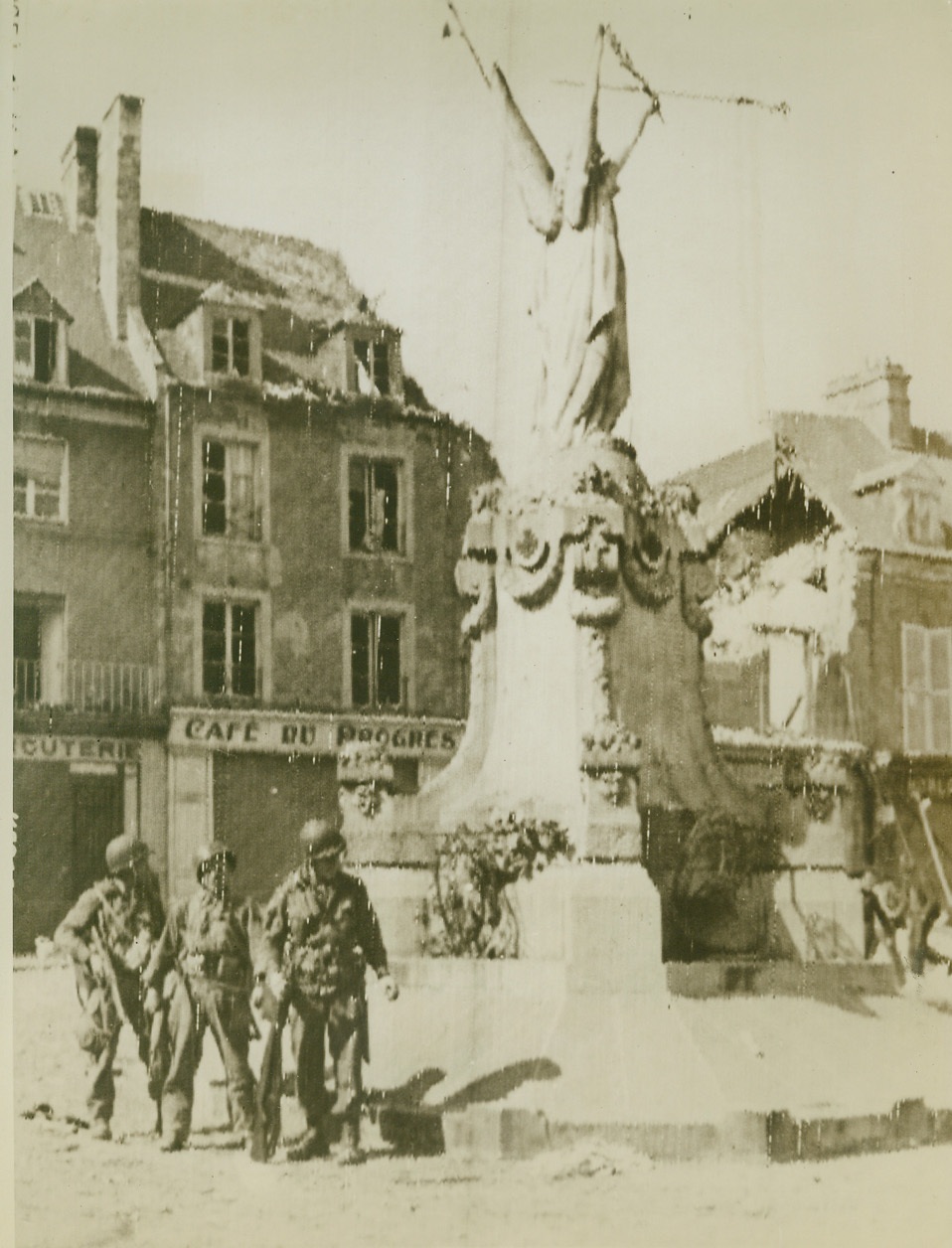
Yank Paratroops in Carentan, 6/15/1944. Carentan, France—A trio of American paratroopers is shown in the streets of battered Carentan, after the French city fell to triumphant Allied liberation forces. Latest protests from Carentan indicate that our troops are holding firm in spite of enemy counterattacks in their sector. Credit: Signal Corps radiotelephoto from ACME;
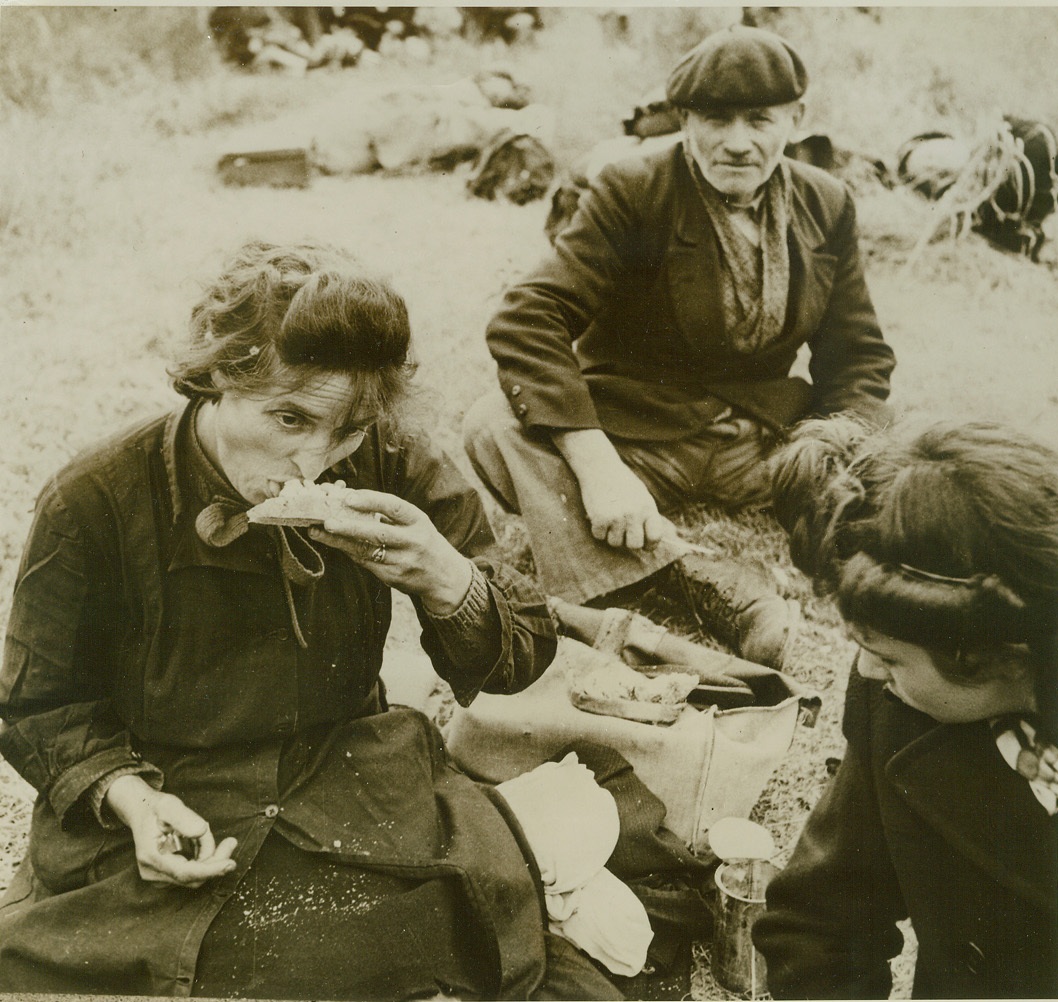
They Eat in Peace, Now, 6/15/1944. France—Eating for the first time in many days, these French refugees sample U.S. Army food supplied through the civil affairs department. The fact that they are free from the Nazi yoke makes their meal double tasty. Credit: British official photo from ACME;
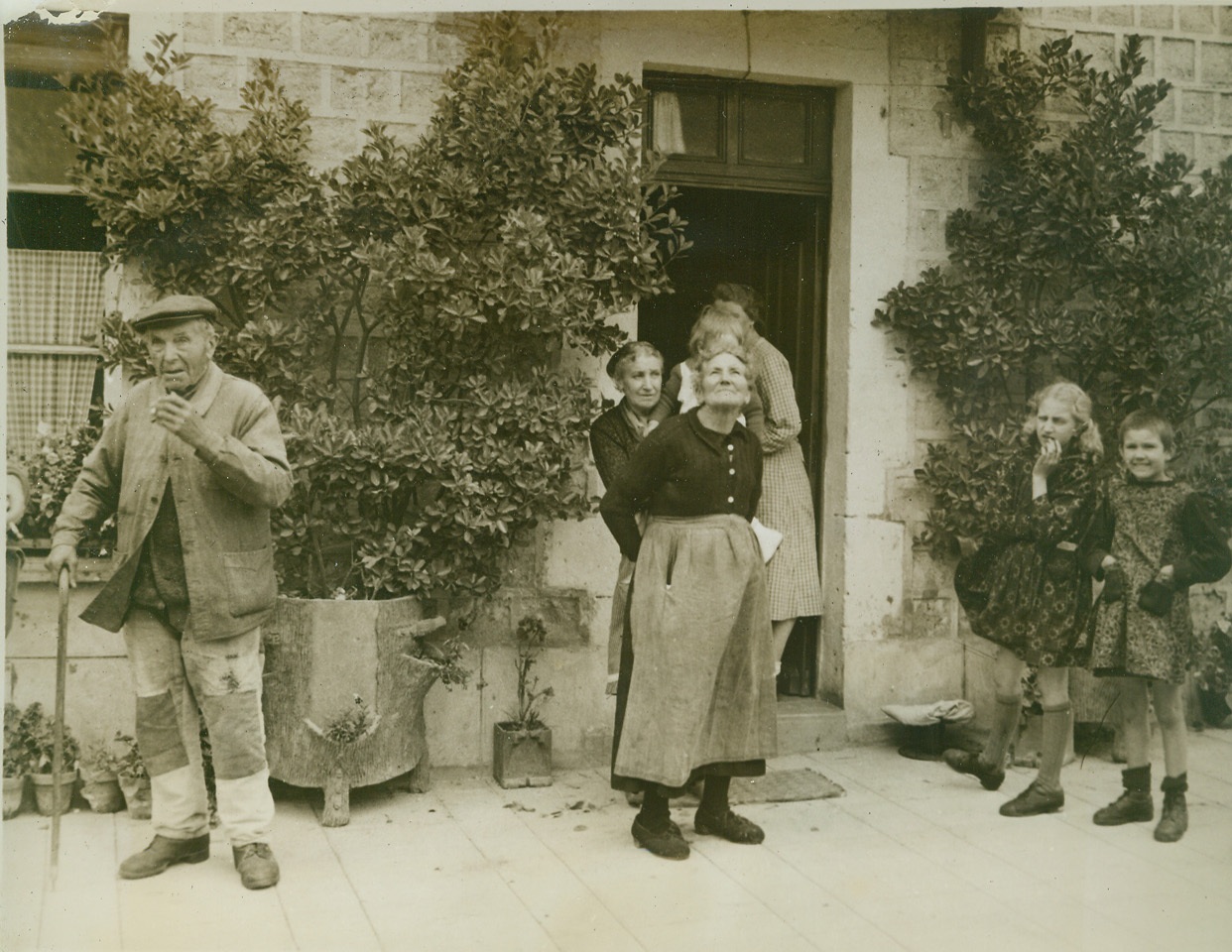
Watching Friendly Warbirds, 6/15/1944. France—French people in the tiny town of Come Du Mont, watch American medium bombers roar overhead on their return from a mission. This town, one of those now liberated by Allied forces, now rests under the protection of the U.S. and British air umbrella. Credit: ACME;
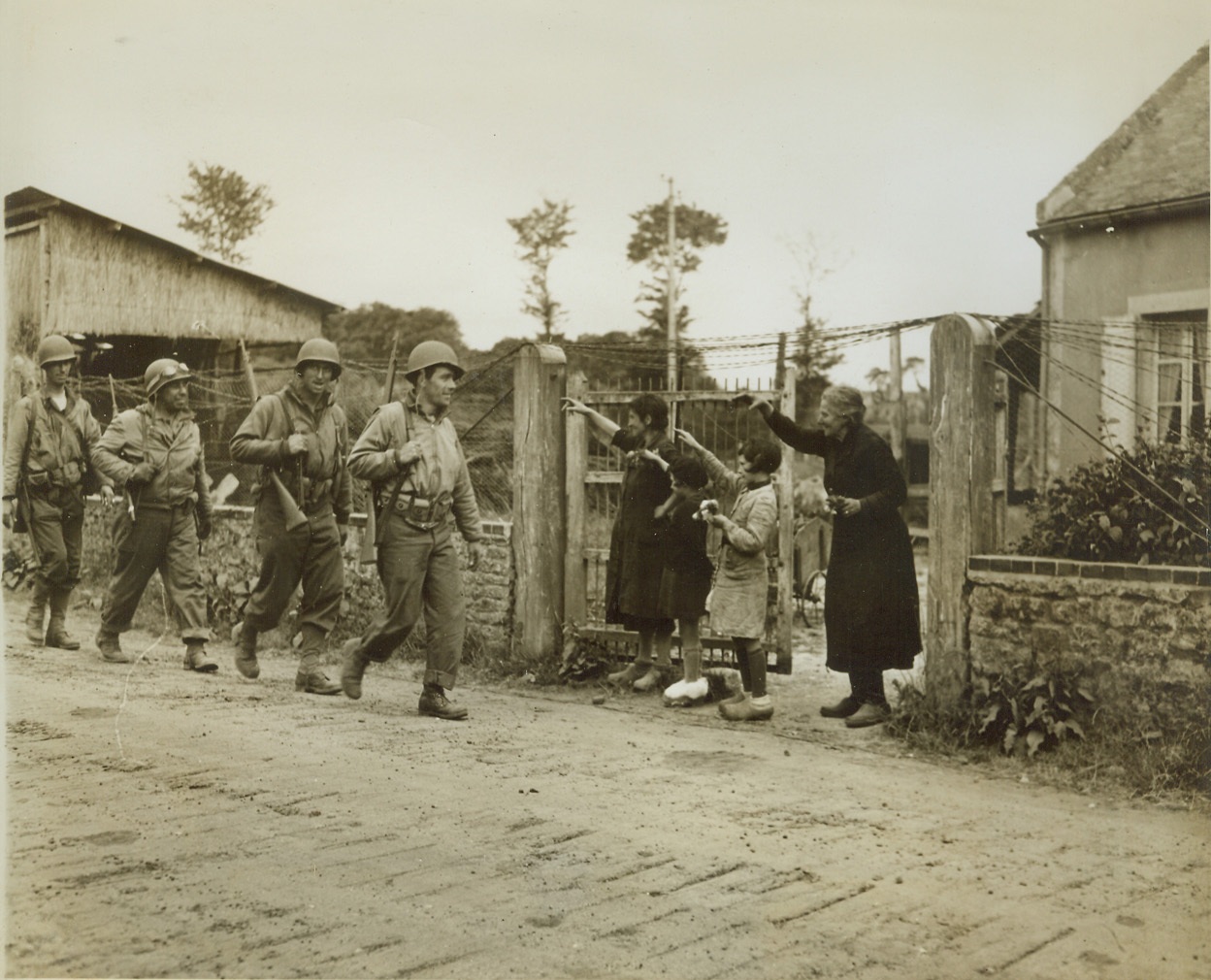
Liberators Are Welcome, 6/13/1944. France—Four female members of a French family stand by the gate of their modest farmhouse to offer a cheerful welcome to American infantrymen passing through the liberated village. The two little girls hold gifts of flowers for the liberators. Credit: ACME photo by Bert Brandt for war pool correspondents;





 Trash & Recycling
Trash & Recycling
 Online Payments
Online Payments
 City Documents
City Documents
 Parks
Parks
 Traffic Court
Traffic Court
 CITY PARKS
CITY PARKS
 RECREATION
RECREATION
 Volunteer
Volunteer
 Home
Home TRANSLATE
TRANSLATE
